|
Meinem Lehrer und Freund Prof. Dr. Heinrich von Stietencron in Dankbarkeit gewidmet. |
Zitierweise | cite as: Amarasiṃha <6./8. Jhdt. n. Chr.>: Nāmaliṅgānuśāsana (Amarakośa) / übersetzt von Alois Payer <1944 - >. -- 2. Dvitīyaṃ kāṇḍam. -- 8. vanauṣadhivargaḥ V. -- 1. Vers 1 - 18. -- Fassung vom 2011-01-12. -- URL: http://www.payer.de/amarakosa/amara208a.htm
Erstmals hier publiziert: 2011-01-12 [am 69. Geburtstag meiner lieben Ehefrau]
Überarbeitungen:
©opyright: Creative Commons Lizenz (Namensnennung, keine kommerzielle Nutzung, share alike)
Dieser Text ist Teil der Abteilung Sanskrit von Tüpfli's Global Village Library
|
Meinem Lehrer und Freund Prof. Dr. Heinrich von Stietencron in Dankbarkeit gewidmet. |
Falls Sie die diakritischen Zeichen nicht dargestellt bekommen, installieren Sie eine Schrift mit Diakritika wie z.B. Tahoma.
Die Devanāgarī-Zeichen sind in Unicode kodiert. Sie benötigen also eine Unicode-Devanāgarī-Schrift.
"Those who have never considered the subject are little aware how much the appearance and habit of a plant become altered by the influence of its position. It requires much observation to speak authoritatively on the distinction in point of stature between many trees and shrubs. Shrubs in the low country, small and stunted in growth, become handsome and goodly trees on higher lands, and to an inexperienced eye they appear to be different plants. The Jatropha curcas grows to a tree some 15 or 20 feet on the Neilgherries, while the Datura alba is three or four times the size in>n the hills that it is on the plains. It is therefore with much diffidence that I have occasionally presumed to insert the height of a tree or shrub. The same remark may be applied to flowers and the flowering seasons, especially the latter. I have seen the Lagerstroemia Reginae, whose proper time of flowering is March and April, previous to the commencement of the rains, in blossom more or less all the year in gardens in Travancore. I have endeavoured to give the real or natural flowering seasons, in contradistinction to the chance ones, but, I am afraid, with little success; and it should be recollected that to aim at precision in such a part of the description of plants is almost hopeless, without that prolonged study of their local habits for which a lifetime would scarcely suffice."
[Quelle: Drury, Heber <1819 - 1872>: The useful plants of India : with notices of their chief value in commerce, medicine, and the arts. -- 2d ed. with additions and corrections. London : Allen, 1873. -- xvi, 512 p. ; 22 cm. -- S. VIII f.]
Bei der Identifikation der lateinischen Pflanzennamen folge ich, wenn immer es möglich ist:
Bhāvamiśra <16. Jhdt.>: Bhāvaprakāśa of Bhāvamiśra : (text, English translation, notes, appendences and index) / translated by K. R. (Kalale Rangaswamaiah) Srikantha Murthy. -- Chowkhamba Varanasi : Krishnadas Academy, 1998 - 2000. -- (Krishnadas ayurveda series ; 45). -- 2 Bde. -- Enthält in Bd. 1 das SEHR nützliche Lexikon (nigaṇṭhu) Bhāvamiśras.
Pandey, Gyanendra: Dravyaguṇa vijñāna : materia medica-vegetable drugs : English-Sanskrit. -- 3. ed. -- Varanasi : Chowkhamba Krishnadas Academy, 2005. -- 3 Bde. ; 23 cm. -- ISBN: 81-218-0088-9 (set)
Wo möglich, erfolgt die aktuelle Benennung von Pflanzen nach:
Zander, Robert <1892 - 1969> [Begründer]: Der große Zander : Enzyklopädie der Pflanzennamen / Walter Erhardt ... -- Stuttgart : Ulmer, ©2008. -- 2 Bde ; 2103 S. -- ISBN 978-3-8001-5406-7.
 WARNUNG: dies ist der Versuch einer
Übersetzung und Interpretation eines altindischen Textes. Es ist keine
medizinische Anleitung. Vor dem Gebrauch aller hier genannten Heilmittel wird
darum ausdrücklich gewarnt. Nur ein erfahrener, gut ausgebildeter ayurvedischer
Arzt kann Verschreibungen und Behandlungen machen! Die
Bestimmung der Pflanzennamen beruht weitgehend auf Vermutungen kompetenter Āyurvedaspezialisten.
WARNUNG: dies ist der Versuch einer
Übersetzung und Interpretation eines altindischen Textes. Es ist keine
medizinische Anleitung. Vor dem Gebrauch aller hier genannten Heilmittel wird
darum ausdrücklich gewarnt. Nur ein erfahrener, gut ausgebildeter ayurvedischer
Arzt kann Verschreibungen und Behandlungen machen! Die
Bestimmung der Pflanzennamen beruht weitgehend auf Vermutungen kompetenter Āyurvedaspezialisten.
Hortus malabaricus
Hortus Indicus Malabaricus : continens regni Malabarici apud Indos cereberrimi onmis generis plantas rariores, Latinas, Malabaricis, Arabicis, Brachmanum charactareibus hominibusque expressas ... / adornatus per Henricum van Rheede, van Draakenstein, ... et Johannem Casearium ... ; notis adauxit, & commentariis illustravit Arnoldus Syen ... -- 11 Bde. -- Amstelaedami : sumptibus Johannis van Someren, et Joannis van Dyck, 1678-1703. -- Online: http://www.biodiversitylibrary.org/bibliography/b11939795. -- Zugriff am 2010-01-01
Zu den Identifikationen siehe:
Dillwyn, L. W. (Lewis Weston) <1778-1855>: A review of the references to the Hortus malabaricus of Henry Van Rheede Van Draakenstein [sic]. -- Swansea : Printed at the Cambrian-Office, by Murray and Rees, 1839.
Roxburgh
Roxburgh, William <1751-1815>: Plants of the coast of Coromandel, selected from drawings and descriptions presented to the hon. court of directors of the East India company / by William Roxburgh. Published by their order under the direction of Sir Joseph Banks <1743 - 1820> ... -- London : Printed by W. Bulmer for G. Nicol, 1795-1819. -- 3 Bde. : 300 kolorierte Tafeln ; 59 cm. -- Online: http://www.botanicus.org/title/b12006488 usw. -- Zugriff am 2009-09-19
Wight Icones
Wight, Robert <1796 - 1872>: Icones plantarum Indiae Orientalis :or figures of Indian plants. -- 6 Bde. -- Madras : published by J.B. Pharoah for the author, 1840-1853. -- Online: http://www.biodiversitylibrary.org/bibliography/92. -- Zugriff am 2010-01-01
Wight Illustrations
Wight, Robert <1796 - 1872>: Illustrations of Indian botany :or figures illustrative of each of the natural orders of Indian plants, described in the author's prodromus florae peninsulae Indiae orientalis. -- 2 Bde. + Suppl. -- Madras : published by J. B. Pharoah for the author, 1840-1850. -- Online: http://www.biodiversitylibrary.org/bibliography/9603. -- Zugriff am 2010-01-01
Kirtikar-Basu
Kirtikar, K. R. ; Basu, B. D.: Indian medical plants with illustrations. Ed., revised, enlarged and mostly rewritten by E. Blatter, J. F. Caius and K. S. Mhaskar. -- 2. ed. -- Dehra Dun : Oriental Enterprises. -- 2003. -- 11 Bde : 3846 S. : Ill. ; 26 cm. -- Unentbehrlich! -- Reprint der Ausgabe von 1933, die Abbildungen stammen aus der Ausgabe von 1918
| 1. oṣadhyo jātimātre syur ajātau sarvam auṣadham śākākhyaṃ patrapuṣpādi taṇḍulīyo 'lpamāriṣaḥ
ओषध्यो जातिमात्रे स्युर् अजातौ सर्वम् औषधम् । Nur als Bezeichnung der Gattung verwendet man ओषधि / ओषधी - oṣadhi f. / oṣadhī f.: "Kraut". Wenn es nicht die Gattung bezeichnet, nennt man all das औषध - auṣadha n.: "Kraut, Arznei" Basilikum (patrapuṣpā) usw. heißt शाख - śākha n.: "Zweig, essbare Pflanze, Gemüse" |
Colebrooke (1807):
[1.a.:] "A herb or deciduous plant."
[1.b.:] "A drug, or simple."
[1.c.:] "Any esculent plant."
Amaranthaceae (Fuchsschwanzgewächse)
| 1. c./d. śākākhyaṃ patrapuṣpādi taṇḍulīyo 'lpamāriṣaḥ शाखाख्यं पत्रपुष्पादि तण्डुलीयो ऽल्पमारिषः ॥१ ख॥ [Bezeichnungen für Amaranthus spinosus L. - Thorny Amaranth:]
|
Colebrooke (1807): "Amaranth. Amaranthus polygamus [L. 1759 = Amaranthus tricolor L. 1753 - Surinamesischer Fuchsschwanz - Chinese Spinach]."
Amaranthus spinosus L. - Thorny Amaranth
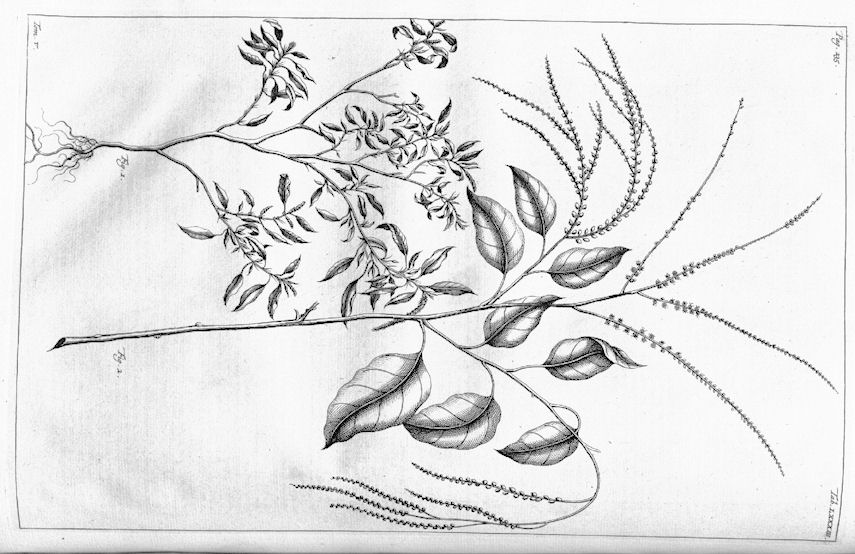
Abb.: Amaranthus spinosus L. - Thorny Amaranth
[Bildquelle: Herbarium amboinense / Georg. Everhard Rumphius. -- Amsterdam, 1741
- 1750. -- Vol 5, Tab. 83.]
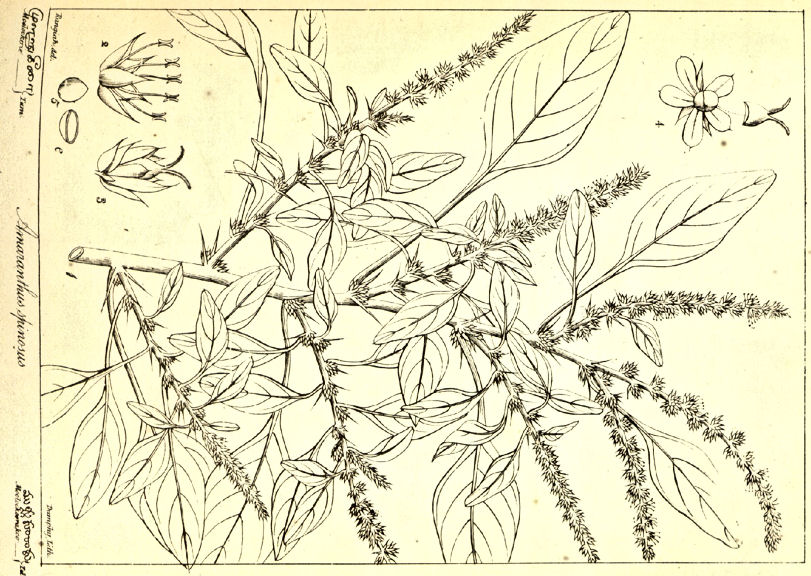
Abb.: Amaranthus spinosus L. - Thorny Amaranth
[Bildquelle: Wight Icones II, Tab. 513, 1843]
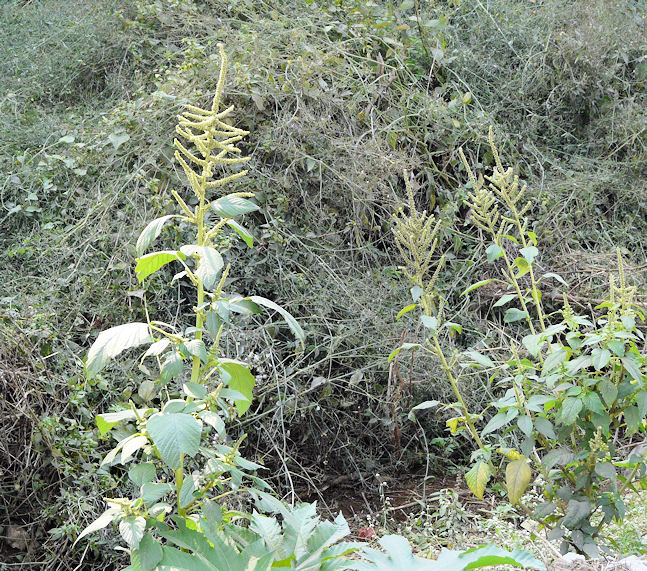
Abb.:
तण्डुलीयः
। Amaranthus spinosus L. - Thorny Amaranth,
Maharashtra
[Bildquelle: dinesh_valke. --
http://www.flickr.com/photos/dinesh_valke/3166491390/. -- Zugriff am
2010-10-23. --
Creative
Commons Lizenz (Namensnennung, keine kommerzielle Nutzung, share alike)]
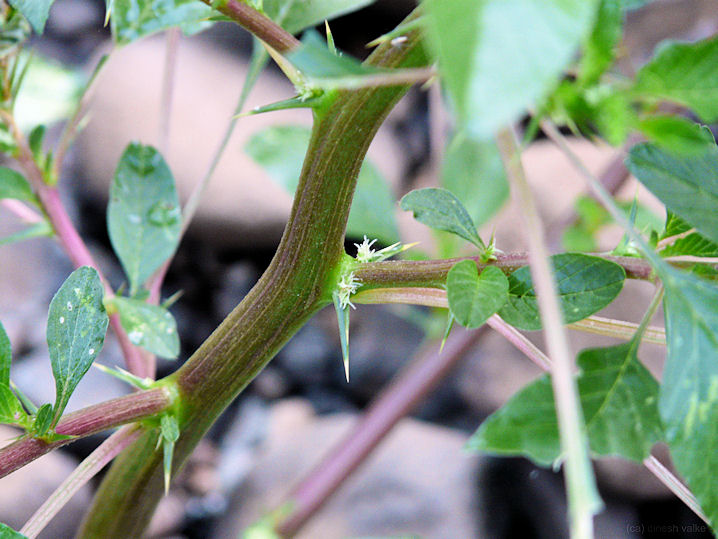
Abb.: Amaranthus spinosus L. - Thorny Amaranth,
Maharashtra
[Bildquelle: dinesh_valke. --
http://www.flickr.com/photos/dinesh_valke/3166491390/. -- Zugriff am
2010-10-23. --
Creative
Commons Lizenz (Namensnennung, keine kommerzielle Nutzung, share alike)]

Abb.:
तण्डुलीयः
। Amaranthus spinosus L. - Thorny Amaranth,
Maharashtra
[Bildquelle: dinesh_valke. --
http://www.flickr.com/photos/dinesh_valke/3166491390/. -- Zugriff am
2010-10-23. --
Creative
Commons Lizenz (Namensnennung, keine kommerzielle Nutzung, share alike)]
"Amarantus spinosus (Linn.) [...]
Description.—Erect, 1-3 feet, somewhat striated, glabrous, reddish; [...]
Dec. Prod. xiii. s. 2, p. 260,—Roxb. Flor. Ind. iii. 611 .— Wight Icon. t. 513.— Rumph. Amb. v. t. 83, fig. 1.
Peninsula. BengaL Malabar.
Medical Uses.—Emollient poultices are made of the bruised leaves. In the Mauritius a decoction of the leaves and root is administered internally as diuretic.—(Bouton, Med. Pl. of the Mauritius.) The A. campestris (Willd.) is considered demulcent, and is given in decoction in cases of strangury—(Ainslie). The A. polygamus (Linn.) is used in bilious disorders, and as an aperient.—Long, Indig. Plants of Bengal."
[Quelle: Drury, Heber <1819 - 1872>: The useful plants of India : with notices of their chief value in commerce, medicine, and the arts. -- 2d ed. with additions and corrections. London : Allen, 1873. -- xvi, 512 p. ; 22 cm. -- s.v.]
"Amarantus Spinosus, Linn., Willd. Amar. 38, t. 4, f. 8;
Vern.—Tanduliya (Sans.) [...]
possesses mucilaginous properties. The Hindu physicians prescribe the root in combination with other drugs in menorrhagia. It is considered to be a specific for colic. A poultice of the leaves was officinal in the Bengal Pharmacopoeia.
The authors of the Pharmacopoeia of India regard the plant as a simple emollient, and inferior to many others, but recently the root has been found to be of great service in the treatment of gonorrhoea and eczema. In gonorrhoea it is said to stop the muco-purulent discharge, and all the concomitant symptoms, such as heat, scalding and general irritation."
[Quelle: Pharmacographia indica : a history of the principal drugs of vegetable origin met with in British India / by William Dymock [1834-1892], C. J. H. Warden and David Hooper [1858-1947]. -- Bd. 3. -- London, 1893. -- S. 138.]
Amaranthus polygamus L. 1759 = Amaranthus tricolor L. 1753 - Surinamesischer Fuchsschwanz - Chinese Spinach
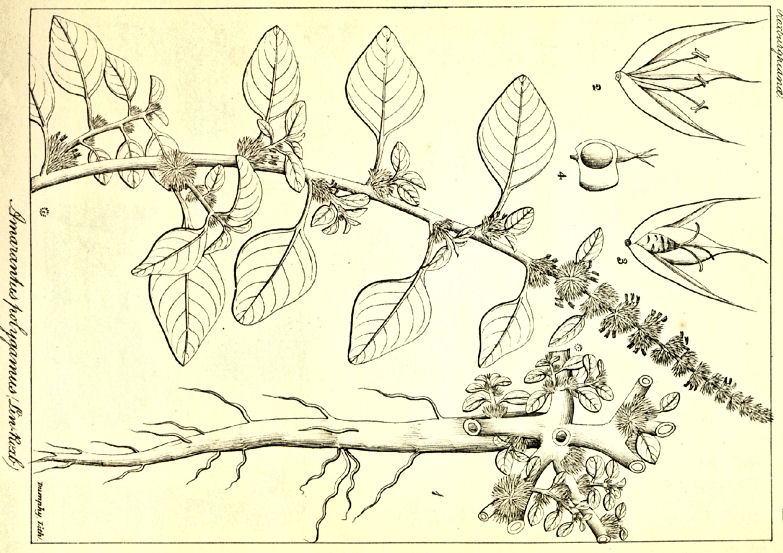
Abb.: Amaranthus
polygamus L. 1759 = Amaranthus tricolor L. 1753 - Surinamesischer
Fuchsschwanz - Chinese Spinach
[Bildquelle: Wight Icones II, Tab. 714, 1843]
Colchicaceae (Zeitlosengewächse)
| 2. a./b. viśalyāgniśikhānantā phalinī
śakrapuṣpikā विशल्याग्निशिखानन्ता फलिनी शक्रपुष्पिकाa ।२ क। a var. lect. śukrapuṣpikā - शुक्रपुष्पिका [Bezeichnungen für Gloriosa superba L. 1753 - Ruhmeskrone - Climbing Lily:]
|
Siehe auch 2.IV.6.c./d.!
Colebrooke (1807): "A sort of potherb. Not ascertained."
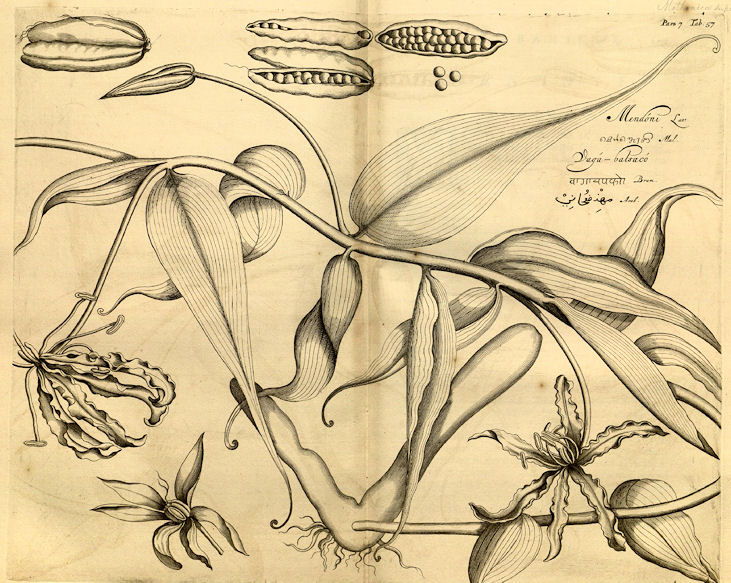
Abb.: Gloriosa superba L. 1753 - Ruhmeskrone -
Climbing Lily
[Bildquelle: Hortus malabaricus VII. Fig. 57,
1686]
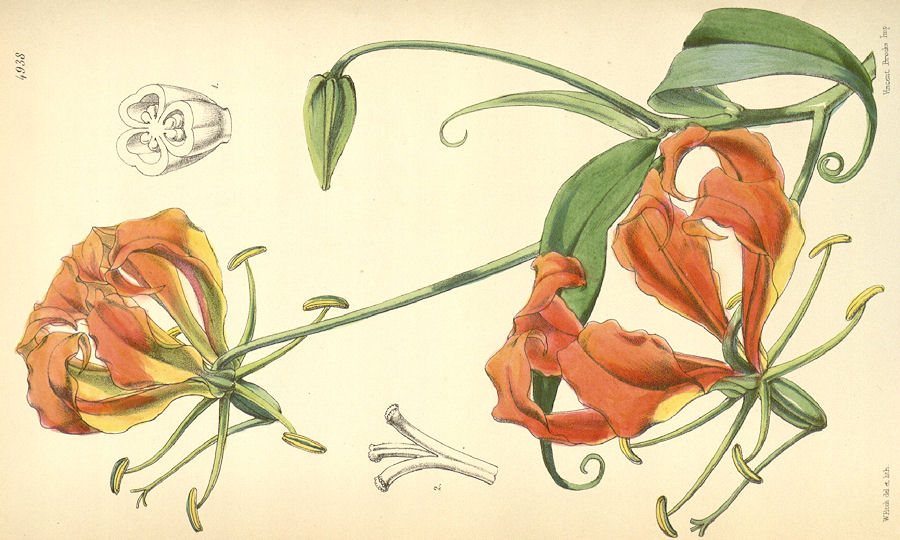
Abb.: शुक्रपुष्पिका । Gloriosa superba L. 1753 - Ruhmeskrone -
Climbing Lily
[Bildquelle: Curtis's Botanical Magazine, v. 82 (1856), Tab. 4938]
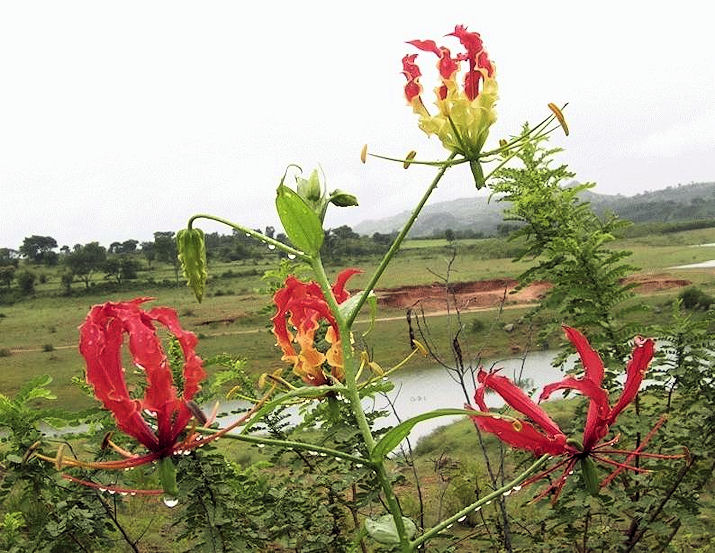
Abb.: अग्निशिखा
। Gloriosa
superba L. 1753 - Ruhmeskrone - Climbing Lily, bei Bangalore -
ಬೆಂಗಳೂರು,
Karnataka
[Bildquelle: L. Shyamal / Wikimedia. -- Public domain]
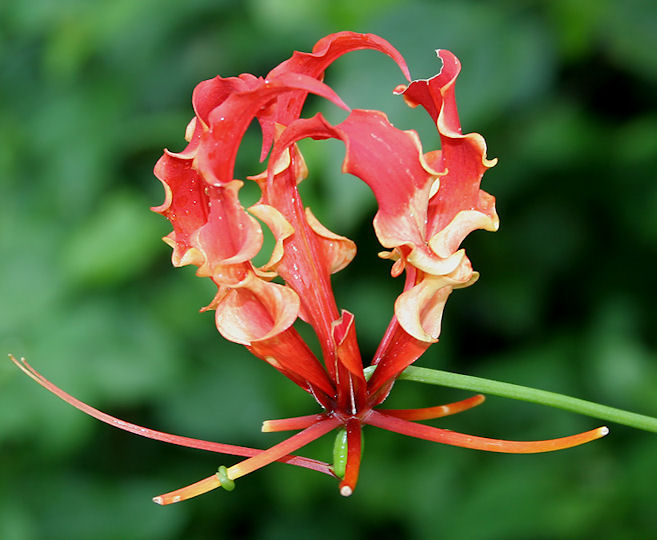
Abb.: अग्निशिखा
। Gloriosa
superba L. 1753 - Ruhmeskrone - Climbing Lily, Hyderabad -
హైదరాబాద్ -
حیدرآباد, Andhra Pradesh
[Bildquelle: J. M. Garg / Wikimedia.
-- GNU FDLicense]
"Gloriosa superba. Willd. 2. 95.
Root bulbous, biennial.
[...]
Mendoni. Rheed. Mal. 7. t. 57.
[...]
Native of forests of India ; it appears during the rainy season in Bengal, and is one of the most ornamental plants any country can boast of; the root is said to be a violent poison."
[Quelle: Roxburgh, William <1751-1815>: Flora indica, or, Descriptions of Indian plants / by the late William Roxburgh. -- Serampore : Printed for W. Thacker, 1832. -- Vol. 2, S. 143.]
"Gloriosa superba (Linn.) N. O. Liliaceae. [...]
Description. — Climbing, with herbaceous stem; [...]
Fl. Aug.—Oct.
Wight Icon. vi. t. 2047.—Roxb. Fl. Ind. ii. 143.
Methonica superba, Lam.—Rheede, vii. t. 57.
CoromandeL Malabar. Concans. Bengal.
Medical Uses.—This splendid creeper, designated by Linnaeus as "vere gloriosus flos," is commonly to be met with in the Travancore forests. Roxburgh says it is one of the most ornamental plants any country can boast of. The root of the plant is reckoned poisonous. The natives apply it in paste to the hands and feet of women in difficult parturition. A salt is procured from the root by repeated washing and grinding, throwing away the liquor, and washing the residuum carefully. The white powder so found is bitter to the taste. Mixed with honey it is given in gonorrhoea.—(Lindley. Roxb.) The native practitioners say it possesses nearly the same properties as the root of Aconitum ferox, hence its name of Country or Wild Aconite. Its taste is faintly bitter and acrid. It is farinaceous in structure. It is not poisonous in 12-grain doses, but, on the contrary, is alterative, tonic, and anti-periodic. It might be poisonous in larger quantities.—Modeen Sheriff in Suppl. to Pharm. of India."
[Quelle: Drury, Heber <1819 - 1872>: The useful plants of India : with notices of their chief value in commerce, medicine, and the arts. -- 2d ed. with additions and corrections. London : Allen, 1873. -- xvi, 512 p. ; 22 cm. -- s.v.]
"GLORIOSA SUPERBA, Linn.
Fig. Bot. Reg., t. 77 ; Wight Ic. t. 2047 ; Rheede, Hort. Mal. vii., t. 57.
Superb Lily
Hab. Throughout India.
[...]
History, Uses, &c.—This very ornamental creeper is common on hedges during the rainy season, and its flowers are used by the Hindus in the Worship of Siva and the Lingam. It is one of the seven minor poisons of Sanskrit writers, and is described in the Raja Nirghanta under the name of Kalikāri. The synonyms are numerous; amongst those which are descriptive we may mention Chihna-mukhi "having a spotted mouth," Sukra-pushpika "having splendid flowers," Agni-sikha "having a crest of fire," and Langalika "plough-like," in allusion to the shape of the root.
Other synonyms, such as Garbha-ghātini, Garbha-pātani, Garbha-nud, allude to the use of a paste of the root as an application to the lower part of the abdomen for the purpose of promoting labour pains. In retained placenta a paste of the root is applied to the palms of the hands and soles of the feet, whilst powdered Nigella seeds and long popper are given internally with wine. According to the Nighantas, the root is purgative, hot, light, and pungent; it increases the secretion of bile, and is useful in leprosy, piles, colic, boils, and to expel intestinal worms. The starch obtained from the root by washing is given internally in gonorrhoea.
Moodeen Sheriff, who has experimented with the root, states that it is not so poisonous as is generally supposed; he has taken it in small quantities, gradually increasing the dose to 15 grains. There were no bad effects, but on the contrary he found his appetite improved and felt more active and stronger. He has also used it in his practice for many years, and considers it to be a tonic and stomachic in doses of from 5 to 12 grains given three times a day. In the Concan it is given to cattle to expel worms, and in Madras it is believed to be a specific against the bites of poisonous snakes, and the stings of scorpions, and is also used as an external application in parasitical skin affections. Surgeon-Major Thomson states that before being used for these purposes it is cut up into thin slices and soaked in butter-milk and salt for four or five days, and then dried, by which process its poisonous properties are supposed to be removed. He also says that the natives select those roots which are dichotomous and which they suppose to be those of the male plant, whilst single roots, which they suppose to be those of the female plant, are rejected. (Dict. Econ. Prod. India, iii., p. 507.)
Description.—Root tuberous, cylindrical or flattened, often 7 to 8 inches in length, and about one inch in diameter; when fully grown it consists of two tubers which unite at a right angle, one being much shorter than the other."
[Quelle: Pharmacographia indica : a history of the principal drugs of vegetable origin met with in British India / by William Dymock [1834-1892], C. J. H. Warden and David Hooper [1858-1947]. -- Bd. 3. -- London, 1893. -- S. 480ff.]
Convolvulaceae (Windengewächse)
| 2. c./d. syād dakṣagandhā chagalāntry-āvegī
vṛddhadārakaḥ 3. a./b. juṅgo brāhmī tu matsyākṣī vayaḥsthā somavallarī
स्याद् दक्षगन्धा
छगलान्त्र्य्-आवेगी वृद्धदारकः ॥२ ख॥ [Bezeichnungen für Ipomoea pes-caprae (L.) R. Br. 1818 - Ziegenfuß-Prunkwinde - Beach Morning Glory / Goat's Foot:]
|
Colebrooke (1807): [2.c./d.:] "Another sort [of ptherb]. Perhaps Convolvulus Argenteus [Wall.]."
1 दक्षगन्धा - dakṣagandhā f.: Geruch Dakṣas (= Geruch eines Ziegenbocks)
Dakṣa hat den Kopf eines Ziegenbocks bzw. Schafbocks
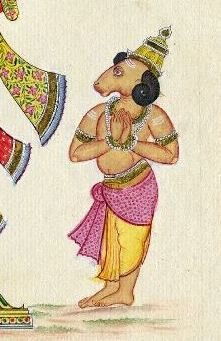
Abb.: Dakṣa, ca. 1820
[Bildquelle: Wikipedia. -- Public domain]
"DAKSHA. Able, competent, intelligent. This name generally carries with it the idea of a creative power. Daksha is a son of Brahmā; he is one of the Prajāpatis, and is some times regarded as their chief. There is a great deal of doubt and confusion about him, which of old the sage Parāsara could only account for by saying that "in every age Daksha and the rest are born and are again destroyed." In the Rig-veda it is said that "Daksha sprang from Aditi, and Aditi from Daksha." Upon this marvellous mutual generation Yaska in the Nirukta remarks, "How can this be possible ? They may have had the same origin ; or, according to the nature of the gods, they may have been born from each other, and have derived their substance from each other." Roth's view is that Aditi is eternity, and that Daksha (spiritual power) is the male energy which generates the gods in eternity. In the Śatapatha Brāhmaṇa, Daksha is identified with Prajāpati, the creator. As son of Aditi, he is one of the Ādityas, and he is also reckoned among the Viśwadevas.
According to the Mahā-bhārata, Daksha sprang from the right thumb of Brahma, and his wife from that deity's left thumb. The Purāṇas adopt this view of his origin, but state that he married Prasūti, daughter of Priya-vrata, and grand-daughter of Manu. By her he had, according to various statements, twenty-four, fifty, or sixty daughters. The Rāmāyaṇa and Mahābhārata agree in the larger number ; and according to Manu and the Mahā-bhārata he gave ten of his daughters to Dharma and thirteen to Kasśapa, who became the mothers of gods and demons, men, birds, serpents, and all living things. Twenty-seven were given in marriage to Soma, the moon, and these became the twenty-seven Nakshatras or lunar mansions. One of the daughters, named Satī, married Śiva, and killed herself in consequence of a quarrel between her husband and father. The Kāśī Khaṇḍa represents that she became a satī and burnt herself.
Another legend of the Mahā-bhārata and Purāṇas represents Daksha as being born a second time, in another Manwantara, as son of the Prachetasas and Mārishā, and that he had seven sons, "the allegorical persons Krodha, Tamas, Dama, Vikṛta, Angiras, Kardama, and Aśwa." This second birth is said to have happened through his having been cursed to it by his son-in-law Śiva. Daksha was in a certain way, by his mother Mārishā, an emanation of Soma, the moon ; and as twenty-seven of his daughters were married to that luminary, Daksha is sometimes referred to as being both the father and the offspring of the moon, thus reiterating the duality of his nature.
In the Hari-vanśa Daksha appears in another variety of his character. According to this authority, Vishnu himself became Daksha, and formed numerous creatures, or, in other words, he became the creator. Daksha, the first of males, by virtue of yoga, himself took the form of a beautiful woman, by whom he had many fair daughters, whom he disposed of in marriage in the manner related by Manu and above stated.
An important event in the life of Dakṣa, and very frequently referred to, is " Dakṣa s sacrifice," which was violently interrupted and broken up by Śiva, The germ of this story is found in the Taittirīya Saṃhitā, where it is related that the gods, having excluded Rudra from a sacrifice, he pierced the sacrifice with an arrow, and that Pūṣan, attempting to eat a portion of the oblation, broke his teeth. The story is found both in the Rāmāyaṇa and Mahā-bhārata. According to the latter, Dakṣa was engaged in sacrifice, when Śiva in a rage, and shouting loudly, pierced the offering with an arrow. The gods and Asuras were alarmed and the whole universe quaked. The Ṛṣis endeavoured to appease the angry god, but in vain. "He ran up to the gods, and in his rage knocked out the eyes of Bhaga with a blow, and, incensed, assaulted Pūṣan with his foot and knocked out his teeth as he was eating the offering." The gods and Ṛṣis humbly propitiated him, and when he was appeased" they apportioned to him a distinguished share in the sacrifice, and through fear resorted to him as their refuge."
In another part of the same work the story is again told with considerable variation. Dakṣa instituted a sacrifice and apportioned no share to Rudra (śiva). Instigated by the sage Dadhīci, the god hurled his blazing trident, which destroyed the sacrifice of Dakṣa and fell with great violence on the breast of Nārāyaṇa (Viṣṇu). It was hurled back with violence to its owner, and a furious battle ensued between the two gods, which was not intermitted till Brahmā prevailed upon Rudra to propitiate Nārāyaṇa. That god was gratified, and said to Rudra, "He who knows thee knows me ; he who loves thee loves me."
The story is reproduced in the Purāṇas with many embellishments. Dakṣa instituted a sacrifice to Viṣṇu, and many of the gods repaired to it, but Śiva was not invited, because the gods had conspired to deprive him of sacrificial offerings. The wife of Śiva, the mountain goddess Umā, perceived what was going on. Umā was a second birth of Satī, daughter of Dakṣa, who had deprived herself of life in consequence of her father's quarrel with herself and her husband, Śiva. Umā urged her husband to display his power and assert his rights. So he created Vīra-bhadra, "a being like the fire of fate," and of most terrific appearance and powers. He also sent with him hundreds and thousands of powerful demigods whom he called into existence. A terrible catastrophe followed ; "the mountains tottered, the earth shook, the winds roared, and the depths of the sea were disturbed." The sacrifice is broken up, and, in the words of Wilson, "Indra is knocked down and trampled on, Yama has his staff broken, Sarasvatī and the Mātṛs have their noses cut off, Mitra or Bhaga has his eyes pulled out, Pūṣan has his teeth knocked down his throat, Candra (the moon) is pummelled, Vahni's (fire's) hands are cut off, Bhṛgu loses his beard, the Brāhmaṇs are pelted with stones, the Prajāpatis are beaten, and the gods and demigods are run through with swords or stuck with arrows." Dakṣa then, in great terror, propitiated the wrathful deity and acknowledged his supremacy. According to some versions, Dakṣa himself was decapitated and his head thrown into the fire. Śiva subsequently restored him and the other dead to life, and as Dakṣa's head could not be found, it was replaced by that of a goat or ram. The Hari-vaṃśa, in its glorification of Viṣṇu, gives a different finish to the story. The sacrifice was destroyed and the gods fled in dismay, till Viṣṇu intervened, and seizing Śiva by the throat, compelled him to desist and acknowledge his master."
This," says Wilson, " is a legend of some interest, as it is obviously intended to intimate a struggle between the worshippers of Śiva and Viṣṇu, in which at first the latter, but finally the former, acquired the ascendancy."
Daksha was a lawgiver, and is reckoned among the eighteen writers of Dharma-śāstras.
The name Daksha was borne by several other persons."
[Quelle: Dowson, John <1820-1881>: A classical dictionary of Hindu mythology and religion, geography, history, and literature. -- London, Trübner, 1879. -- s.v. ]
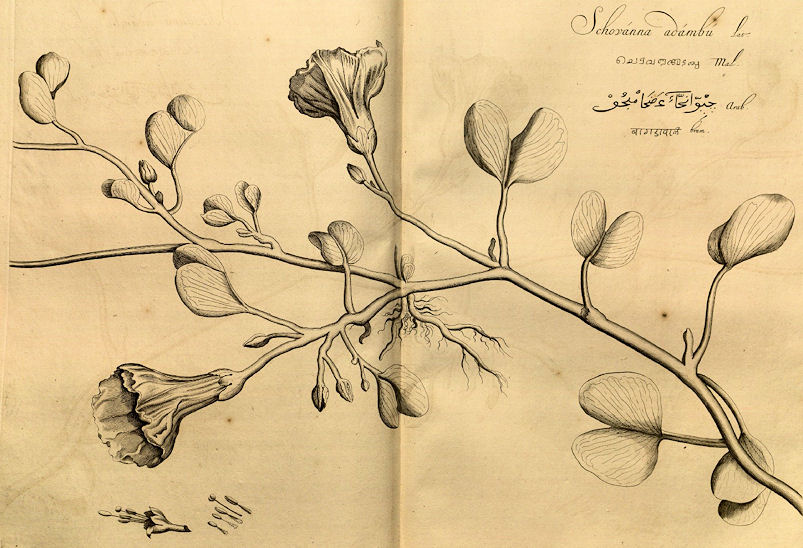
Abb.: दक्षगन्धा । Ipomoea pes-caprae (L.)
R. Br. 1818 - Ziegenfuß-Prunkwinde - Beach Morning Glory / Goat's Foot
[Bildquelle: Hortus malabaricus XI. Fig. 57,
1692]
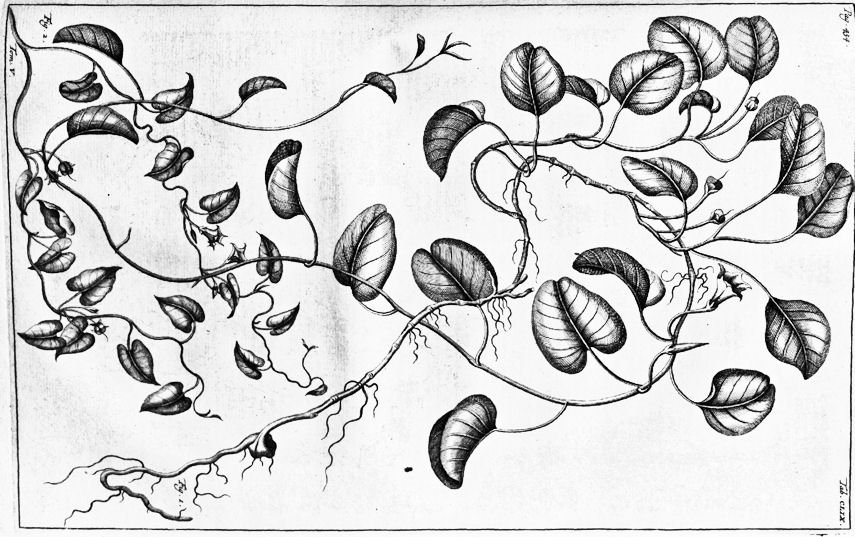
Abb.: छगलान्त्री । Ipomoea pes-caprae (L.)
R. Br. 1818 - Ziegenfuß-Prunkwinde - Beach Morning Glory / Goat's Foot
[Bildquelle: Herbarium amboinense / Georg.
Everhard Rumphius. -- Amsterdam, 1741 - 1750. -- Vol 5, Tab. 159.]
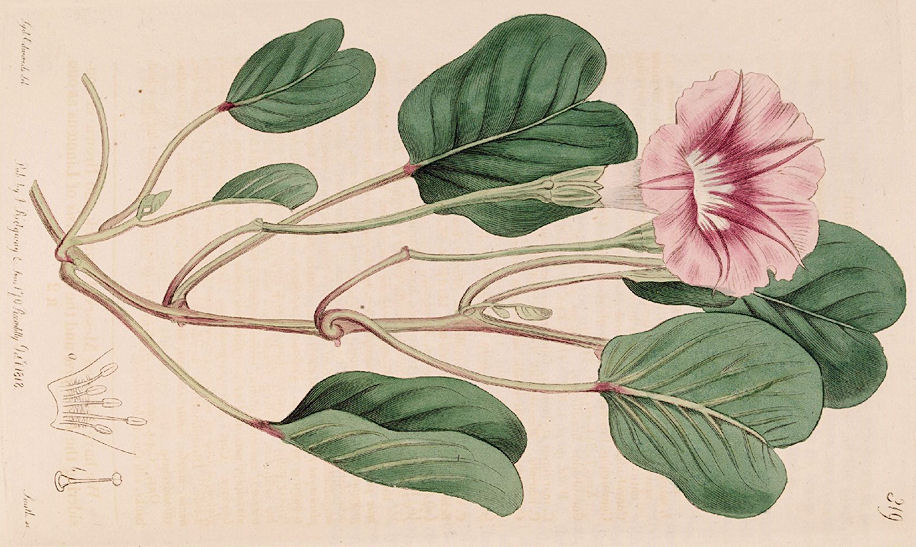
Abb.:
जुङ्गः । Ipomoea pes-caprae (L.)
R. Br. 1818 - Ziegenfuß-Prunkwinde - Beach Morning Glory / Goat's Foot
[Bildquelle: The Botanical register, v. 4 (1818), Pl. 319.]
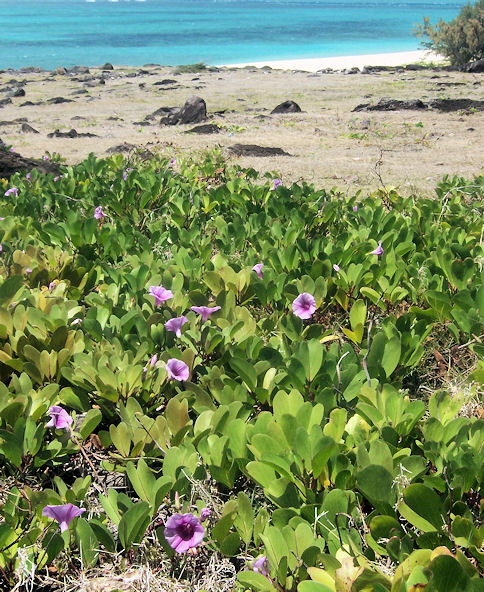
Abb.: छगलान्त्री । Ipomoea pes-caprae (L.)
R. Br. 1818 - Ziegenfuß-Prunkwinde - Beach Morning Glory / Goat's Foot,
Rodrigues Island, Mauritius
[Bildquelle: B.navez / Wikimedia. -- GNU FDLicense]
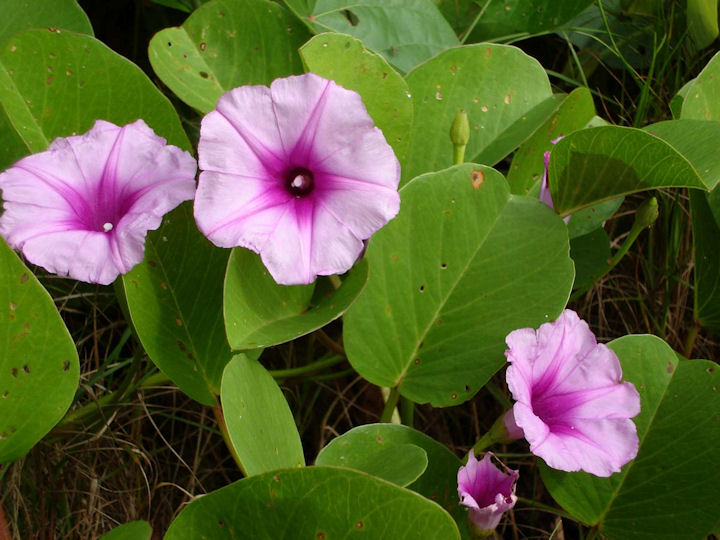
Abb.: Ipomoea pes-caprae (L.)
R. Br. 1818 - Ziegenfuß-Prunkwinde - Beach Morning Glory / Goat's Foot, Tonga
[Bildquelle: Tauʻolunga / Wikimedia.
-- GNU FDLicense]
"Ipomoea pes-caprae (Sweet) N. O. Convolvulaceae Goat's-foot Creeper [...]
Description.--Perennial ; creeping but never twinning [...] flowers large, reddish purple.
Fl. Nearly all the year.—Convolvulus pes-caprae, Linn.—Roxb. Fl. Ind. i. 486.—C. bilobatus, Roxb.—C. Brasiliensis, Linn.—Rheede, xi. t. 57.
Peninsula. Common on sea-shores.
Medical Uses.—This plant is found on sandy beaches, where it is of great use in helping to bind the loose soil, and in time rendering it sufficiently stable to bear grass. Goats, horses, and rabbits eat it. The natives boil the leaves and apply them externally as an anodyne in cases of colic, and in decoction they use them in rheumatism. Another species, according to Ainslie (the I. gemella), has its leaves, which are mucilaginous to the taste, toasted and boiled with clarified butter, and thus reckoned of value in aphthae."
[Quelle: Drury, Heber <1819 - 1872>: The useful plants of India : with notices of their chief value in commerce, medicine, and the arts. -- 2d ed. with additions and corrections. London : Allen, 1873. -- xvi, 512 p. ; 22 cm. -- s.v.]
"IPOMOEA BILOBA, Forsh
Fig.— Rheede Hort. Mal. xi. t. 57; Bot. Reg., 319.
Syn.—I. pes-caprae.
Goat's-foot Convolvulus
Hab.—Coasts of India and Ceylon.
[...]
History, Uses, &C.—Vriddhadāraka is the name of a drug in use throughout India; it is a twisted root about half an inch in diameter, upon the broken or cut ends of which may be observed a black, concreted juice. It is supposed to strengthen the body and prevent the effects of age (Vriddhadāraka). Dutt states that in Bengal the root of Argyreia speciosa is used, but the drug sold as Vardhāra in Western India is not the root of this plant; it appears, however, to be obtained from a plant of the same order, but, as is usually the case in India, the herbalists will not indicate the source from which they obtain it. If we turn to the Nighantas we find the following synonyms for Vriddhadāraka:—Chhagala, Chhagalānghri, "goat's foot"; Chhagalāndi, "goat's testicles;" Chhaggalāntri, "goat's guts;" Antri, Raksho-ghna, Dirgha-mulaka, Anda-kotarapushpi, Durga and Mahasyama. From these names it would appear that the "goat's foot convolvulus" is the plant which ought to be used. Vriddhadaraka is described as astringent, hot, pungent, alterative, tonic; a remover of rheumatism, dropsy, gonorrhoea and phlegm. These properties agree very nearly with those ascribed to I. biloba, the leaves of which boiled are applied externally in rheumatism and colic; whilst the juice is given as a diuretic in dropsy, and at the same time the bruised leaves are applied to the dropsical part. Rheede, speaking of I. biloba, which he calls Schovanna Adambu, states:—"In aqua decocta fomentum exhibet quo dolores arthritici mitigantur. Folia cum lacte caprarum in potionem praeparata, pro haemorrhoidibus propinantur."
According to P. S. Mootooswamy, the leaves are used as a cataplasm in phlegmon, &c. Plumier states that the dried juice of the root is used as a purgative in the Brazils in doses of 12 to 14 grains, and that it should be given like jalap resin with ginger and bitartrate of potash.
I. biloba is sacred to Durga, and the Kolis on the Western Coast, on the sixth day after a child is born, decorate its cradle with the flowers to propitiate that goddess, who, under the name of Shashti, is supposed to destroy newborn children. In this respect it also agrees with the description of Vriddhadāraka.
The Brahminical name for the plant given by Rheede is वांगडीवली - vāṃgaḍīvalī, a combination of the Marathi word Bāngadi, "a coil of rope or tangle," and the Sanskrit Valli, "a creeper."
Description.—A perennial plant with a tough woody root of great length; it abounds in sandy ground near the seashore ;"
[Quelle: Pharmacographia indica : a history of the principal drugs of vegetable origin met with in British India / by William Dymock [1834-1892], C. J. H. Warden and David Hooper [1858-1947]. -- Bd. 2. -- London, 1891. -- S. 536f.]
Asteraceae (Korbblütler)
| 3. a./b. juṅgo brāhmī tu matsyākṣī vayaḥsthā
somavallarī जुङ्गो ब्राह्मी तु मत्स्याक्षी वयःस्था सोमवल्लरी ।३ क। [Bezeichnungen für Enhydra fluctuans Lour.:]
|
Colebrooke (1807): "The moonplant. Asclepias acida (Roxb.) [= Sarcostemma brevistigma W. & A. 1834] or Cynanchum Viminale [L. = Sarcostemma viminale (L.) R. Br. 1810 - Causticbush / Sacred Soma]. But some distinguish this Brāhmī from the Soma lātā."
1 मत्स्याक्षी - matsyākṣī f.: Fischäugige (auch = mīnākṣī = Pārvatī)
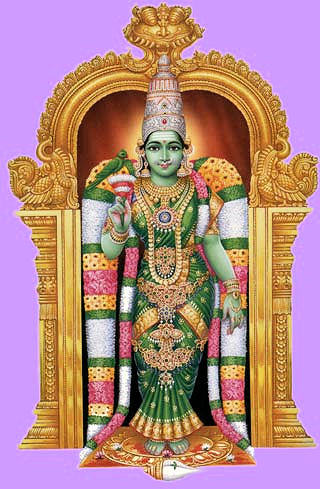
Abb.:
Mīnākṣī
[Bildquelle: Wikipedia. -- Public domain]
Enhydra fluctuans Lour.
"Enhydra fluctans, Lour.,
Hilamochika or Hilamochi, (Sans.), [...]
a glabrous or pubescent marsh plant of Eastern Bengal and Silhet, with sessile, linear-oblong, acute or obtuse, entire or subcrenate leaves, from one to three inches in length, and with axillary or terminal, sessile flower heads ; is used as a bitter vegetable in Bengal; and is considered to be laxative and useful in diseases of the skin and nervous system. The juice of the leaves in doses of about one tola (180 grains) is also prescribed. This plant is unknown in Western and Southern India."
[Quelle: Pharmacographia indica : a history of the principal drugs of vegetable origin met with in British India / by William Dymock [1834-1892], C. J. H. Warden and David Hooper [1858-1947]. -- Bd. 2. -- London, 1891. -- S. 266.]
Sarcostemma brevistigma W. & A. 1834
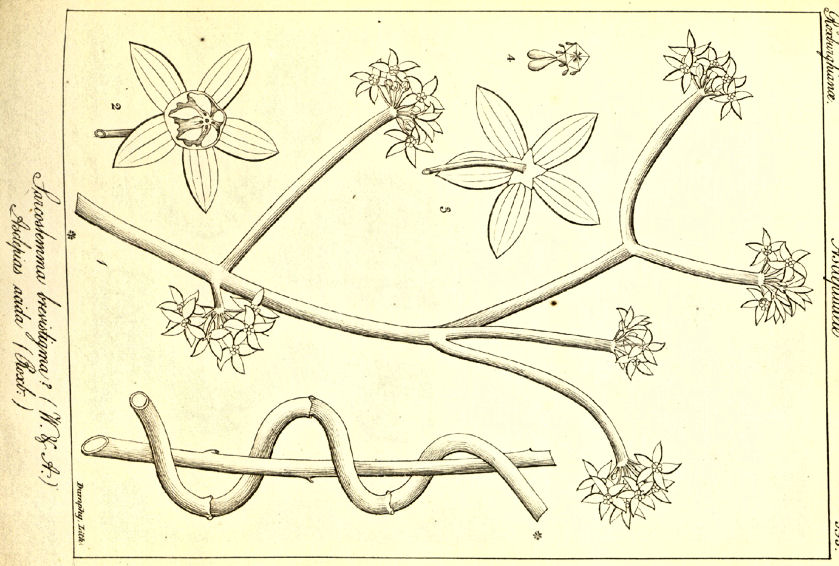
Abb.:
Sarcostemma brevistigma W. & A. 1834
[Bildquelle: Wight Icones II, Tab. 595, 1843]
"Sarcostemma brevistigma (R. W.) N. O. Asclepiaceae [...]
Description.--Twinning ; leafless [...] flowers small, white.
Fl. June—Aug.
W. & A. Contrib. p. 59.— Wight Icon. t. 595.—Asclepias acida, Roxb. Fl. Ind. ii. 31.
Coromandel.
Economic Uses.—Bundles of this plant put into the trough of the well from which a sugar-cane field is watered, together with a bag of common salt, will extirpate white ants ; and the water so impregnated will destroy the ants without injuring the sugar-cane. The plant yields a quantity of milky juice, but of such a mild nature that travellers will often suck the tender shoots to allay thirst.—Roxb. Gibson."
[Quelle: Drury, Heber <1819 - 1872>: The useful plants of India : with notices of their chief value in commerce, medicine, and the arts. -- 2d ed. with additions and corrections. London : Allen, 1873. -- xvi, 512 p. ; 22 cm. -- s.v.]
"Sarcostemma brevistigma yields an abundant bland milky juice ; this plant and Periploca aphylla are used as substitutes for the Soma of the Vedas, which from recent investigations appears to have been a species of Ephedra, and the same plant which is still brought from Persia to India as the Soma of the Parsis." [Quelle: Pharmacographia indica : a history of the principal drugs of vegetable origin met with in British India / by William Dymock [1834-1892], C. J. H. Warden and David Hooper [1858-1947]. -- Bd. 2. -- London, 1891. -- S. 458.]
Sarcostemma viminale (L.) R. Br. 1810 - Causticbush / Sacred Soma
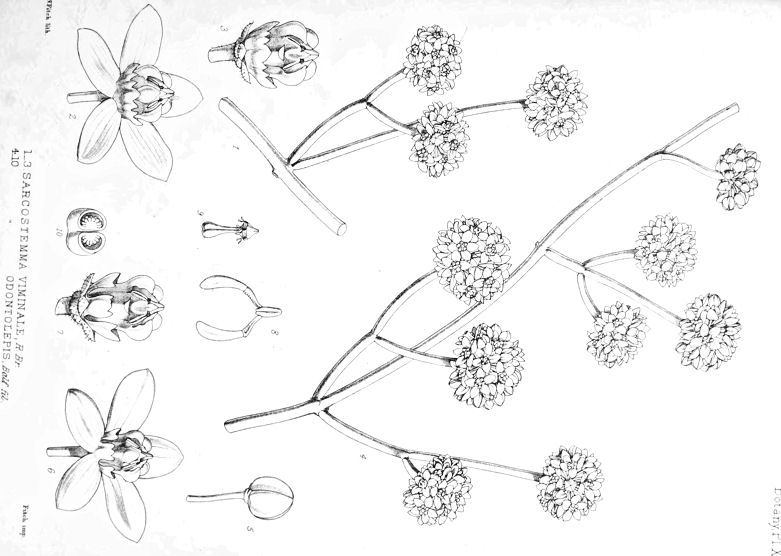
Abb.: Sarcostemma viminale
(L.) R. Br. 1810 - Causticbush / Sacred Soma
[Bildquelle: An Account of the Petrological, Botanical, and Zoological
Collections Made in Kerguelen's Land and Rodriguez During the Transit of Venus
Expedition Carried Out by Order of Her Majesty's Government in the Years
1871-1875 (Plate XXIX) / Wikimedia. -- Public domain]
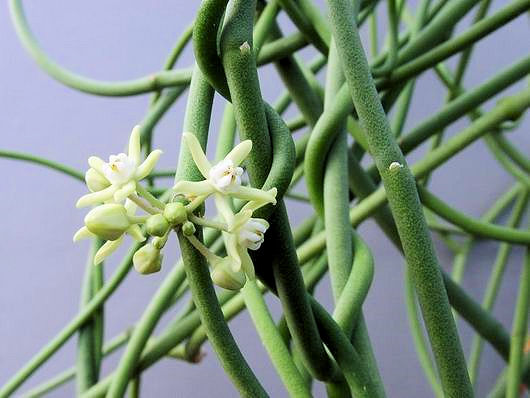
Abb.: Sarcostemma viminale
(L.) R. Br. 1810 - Causticbush / Sacred Soma
[Bildquelle: Участник:Финитор / Wikimedia. -- GNU FDLicense]
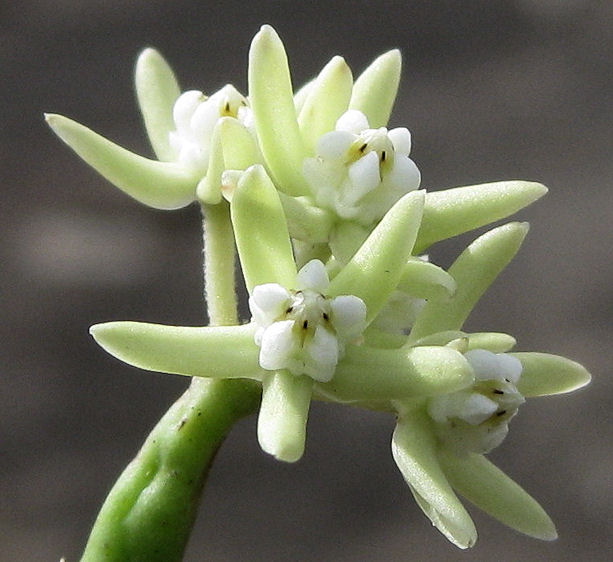
Abb.: Sarcostemma viminale
(Linn.) R. Br. 1810 - Causticbush / Sacred Soma, Mozambique
[Bildquelle: Ton Rulkens. --
http://www.flickr.com/photos/47108884@N07/4496673377/. -- Zugriff am
2010-11-30. -- Creative
Commons Lizenz (Namensnennung, share alike)]
"Sarcostemma viminale, also known as the Rapunzel plant, is a climbing milkweed native to Africa." [Quelle: http://en.wikipedia.org/wiki/Sarcostemma_viminale. -- Zugriff am 2011-01-11]
Menispermaceae (Mondsamengewächse)
| 3. a./b.
juṅgo brāhmī tu matsyākṣī vayaḥsthā
somavallarī जुङ्गो ब्राह्मी तु मत्स्याक्षी वयःस्था सोमवल्लरी ।३ क। [Bezeichnungen für Tinospora cordifolia (Willd.) Miers - Guduchi:]
|
Siehe auch 2.III.1!
Colebrooke (1807): rechnet das zum Vorherigen.
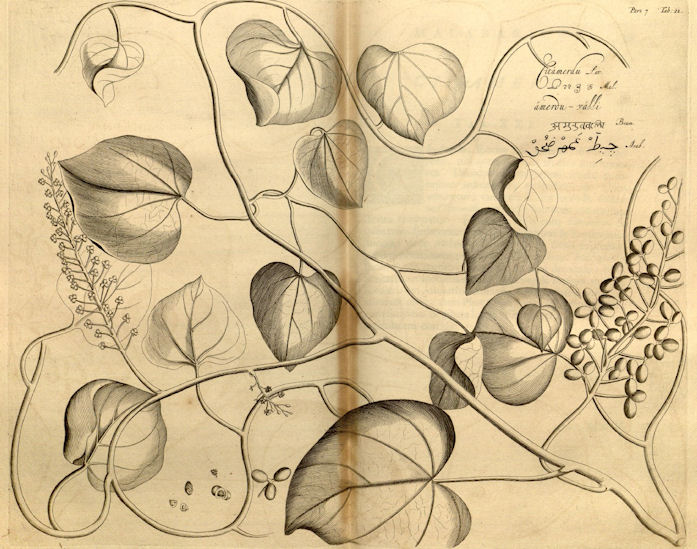
Abb.: सोमवल्लरी । Tinospora cordifolia (Willd.) Miers - Guduchi
[Bildquelle: Hortus malabaricus VII. Fig. 21, 1686]
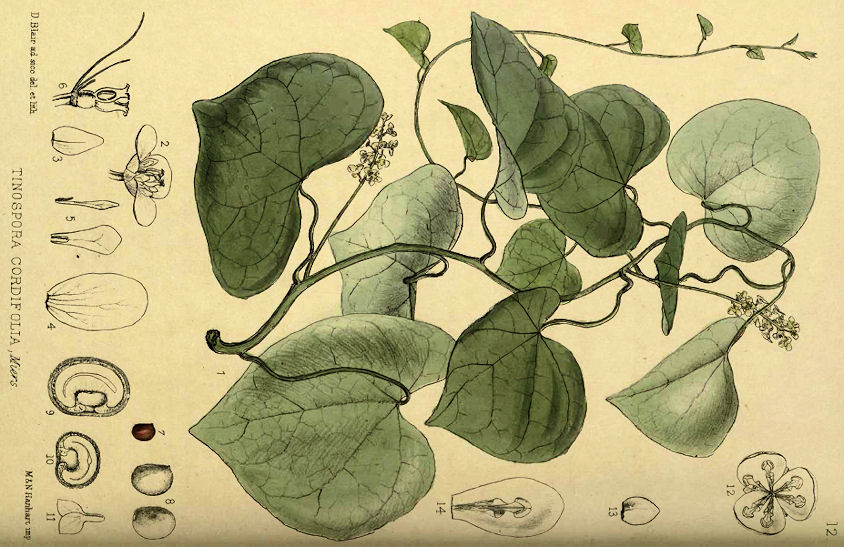
Abb.: सोमवल्लरी । Tinospora cordifolia (Willd.) Miers - Guduchi
[Bildquelle: Medicinal plants. Being descriptions with original figures of the
principal plants employed in medicine and an account of the characters,
properties, and uses of their parts and products of medicinal value. / by Robert
Bentley and Henry Trimen. Plates by David Blair. In four volumes., 1880. -- vol.
1, pl. 12]
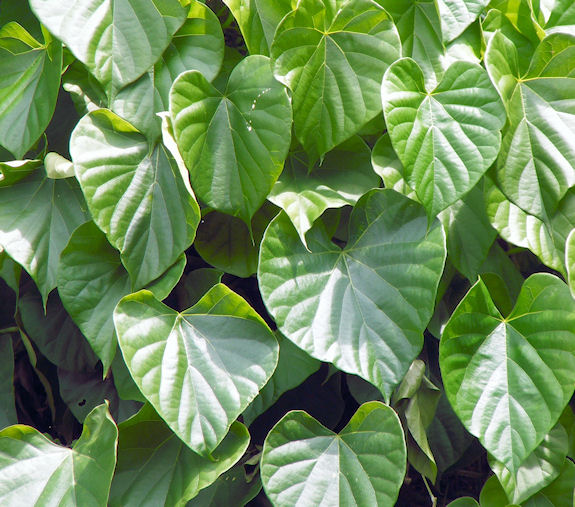
Abb.: सोमवल्लरी । Tinospora cordifolia (Willd.) Miers - Guduchi
[Bildquelle: Trnd / Wikimedia. -- Public domain]
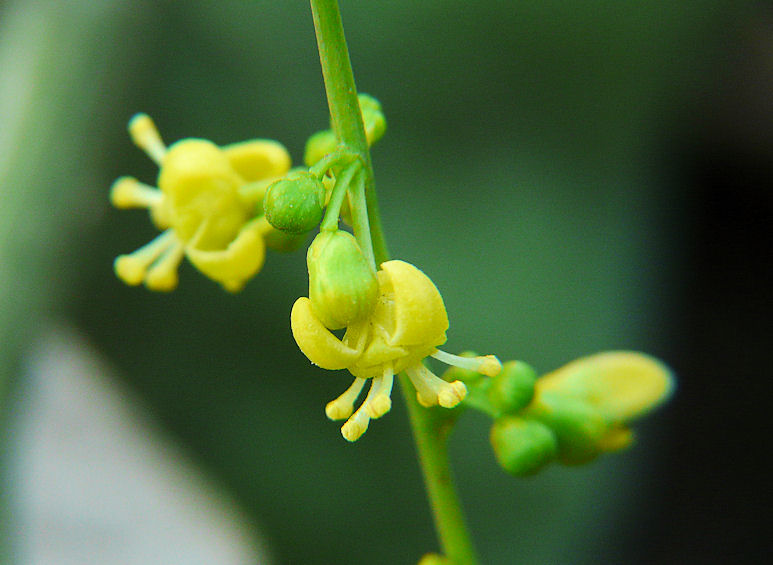
Abb.: Tinospora cordifolia (Willd.) Miers - Guduchi
[Bildquelle: dinesh_valke. --
http://www.flickr.com/photos/dinesh_valke/3052473798/. -- Zugriff am
2010-10-18. --
Creative
Commons Lizenz (Namensnennung, keine kommerzielle Nutzung, share alike)]
"Tinospora cordifolia (Miers). [...]
Description.—Twining shrub; [...]
Fl. April—July.
Hook. & Thoms. Fl. Ind. i 184. — W. & A. Prod. i. 12. — Wight Icon. ii t. 485.
Cocculus cordifolius, Dec.
Menispermum cordifolium, Willd.—Rheede, vii. t. 21.
Peninsula. Bengal. Assam.
Medical Uses.—What is known as Guluncha extract is procured from the stems of this plant It is a well-known specific in the bites of poisonous insects, as well as in fevers and rheumatism. The leaves beaten up and mixed with honey are applied externally to ulcers, and with oil to the head as a remedy in colds. In decoction they are given as a tonic in gout. The native practitioners use this plant extensively in a great variety of diseases, especially in fevers, jaundice, and visceral obstructions. The parts chiefly used are the roots, stem, and leaves, from which a decoction called Pachuna is prepared. The extract called Paho is procured also from the stem, and is reputed of much value in urinary affections.
Dr Wight states that from 15 to 20 grains of the powdered root constitute a good emetic, a fact also recorded by Ainslie, who especially remarks that it is a successful remedy in snake-bites, administered in the above dose about three times a-day, at an interval of twenty minutes between each dose. The bitterness of the extract varies according to the season when the plant is gathered, which should be during the hot weather. The young leaves bruised and mixed with milk are used as a liniment in erysipelas. It is stated in the ' Bengal Dispensatory' that in experiments made at the college hospital, the Guluncha was found to be a very useful tonic. The decoction or cold infusion was of great utility in chronic rheumatism and secondary venereal affections. Its action is decidedly diuretic and tonic in a high degree.—(Bengal Disp. Roxb. Trans. Med. and Phys. Soc., Calcutta. Ainslie.) The T. crispa (Miers), and some other allied species inhabiting various parts of India, possess the bitterness, and probably the tonic properties, of Guluncha.—Pharm. of India."
[Quelle: Drury, Heber <1819 - 1872>: The useful plants of India : with notices of their chief value in commerce, medicine, and the arts. -- 2d ed. with additions and corrections. London : Allen, 1873. -- xvi, 512 p. ; 22 cm. -- s.v.]
"TINOSPORA CORDIFOLIA, Miers. Fig.—Rheede, Hort. Mal. vii., 21 ; Bentl. and Trim., t. 12.
Hab.—Tropical India.
[...]
History, Uses, &c.—A well-known medicinal plant, long in use in Hindu medicine, and called in Sanskrit Guduchi, Pittaghni (bile-destroying), Bhishakpriya (dear to physicians), Nirjara (not perishing), &c. It is considered to be cold and dry, or according to Arabic and Persian writers, hot and dry in the first degree. In native practice it is much valued as an antiperiodic in fevers, and as a tonic and alterative; it is also credited with aphrodisiac properties.* The fresh plant is said to be more efficient than the dry; it is taken with milk in rheumatism, acidity of the urine and dyspepsia. The juice with Pakhanbed and honey is given in Gonorrhoea, and is an ingredient in Paushtiks given in Phthisis. In Guzerat, a necklace called Kamala-ni-mala (jaundice necklace) is made of small pieces of the stem, and is supposed to cure that disease. The stem, if placed upon a bush in the open air, will retain its vitality through the hot season, and when the rains commence, put forth leaves and long whipcord-like roots, which soon reach the ground, whence the Sanskrit synonym Chinnaruha, or, growing when cut. The plant is very common in many parts of India, and may always be obtained in the green state. Elephants are very fond of the stems, and the hill tribes in Sikkim give it to their cattle to cure pains in the stomach. The dry stem is to be seen in every drag shop ; from it is prepared a kind of starch known-in Hindustani as Giloe-ka-sat, and in some parts of India as Palo. It is prepared by powdering the stem and washing out the starch with water ; the latter retains a little of the bitterness of the drug. T. cordifolia appears first to have attracted the notice of Europeans in India at the early part of the present century, and to have been favourably spoken of by those who have tried it as a tonic, antiperiodic and diuretic, but it has never come into general use in European practice. It is now official in the Pharmacopoeia of India, and has lately (1884) been re-introduced to the notice of the profession in Europe as a specific tonic, antiperiodic and diuretic. (Zeitschrift des Oesterr. Apoth. Ver., J884, 312.)
* For original Sanskrit prescriptions, see Dutt's Hindu Materia Medica, p. 105; most of them contain several other equally active remedies."
[Quelle: Pharmacographia indica : a history of the principal drugs of vegetable origin met with in British India / by William Dymock [1834-1892], C. J. H. Warden and David Hooper [1858-1947]. -- Bd. 1. -- London, 1890. -- S. 54f.]
Garcinia: Clusiaceae
Euphorbia:
Euphorbiaceae (Wolfsmilchgewächse)
Argemone: Papaveraceae (Mohngewächse)
|
3. c./d. paṭuparṇī haimavatī svarṇakṣīrī himāvatī पटुपर्णी हैमवती स्वर्णक्षीरी हिमावती ॥३ ख॥ [Bezeichnungen für Garcinia morella Desr. 1792 oder Euphorbia thomsoniana Boiss. 1862 oder Argemone mexicana L. 1753 - Mexikanischer Stachelmohn - Devil`s Fig:]
|
Colebrooke (1807): "A medicinal sort. Stated to be the produce of the snowy mountains."
"Modern āyurvedic scholars differ widely about the identification of the plant named Hemakṣīrī / hemadugdha / svarṇakṣīrī taking the literal meaning of this term as that having gold coloured sap or yellow latex and suggest three plants of this quality.
Garcinia morella Desr. - the yellow latex of this plant dried and solidified is being sold in the market by the name "Kolum" also called "Gamboge".
Euphorbia thomsoniana Boiss. - this is variety of snuhī, this is a drastic purgative.
Argemone mexicana L. - known popularly as pītā dhattura, satyānāsī, Mexican poppy / prickly poppy
[...] Argemona mexicana ... came to India only after medieval period (9.-10. cent. A.D.)"
(Bhāvaprakāśa I, S. 187).
Garcinia morella Desr. 1792
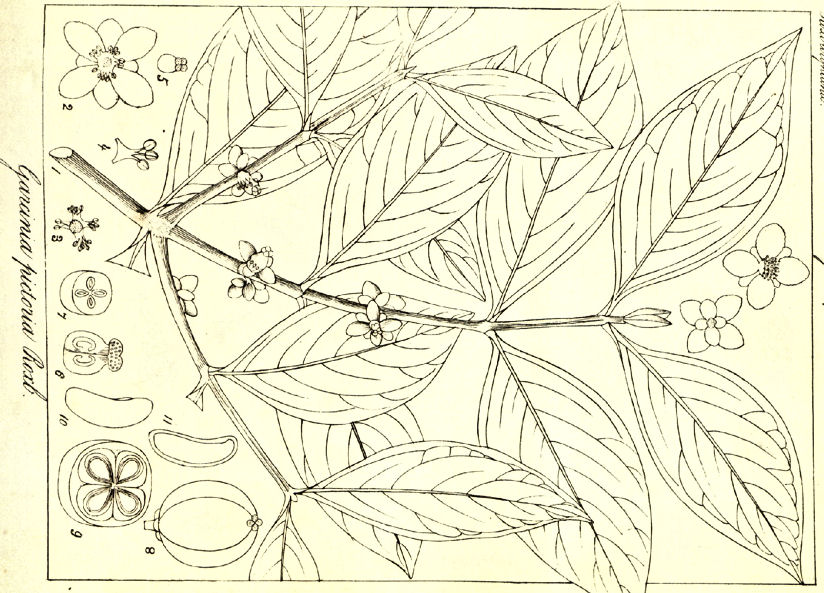
Abb.: Garcinia morella Desr.
1792
[Bildquelle: Wight Icones I, Tab. 102, 1840]
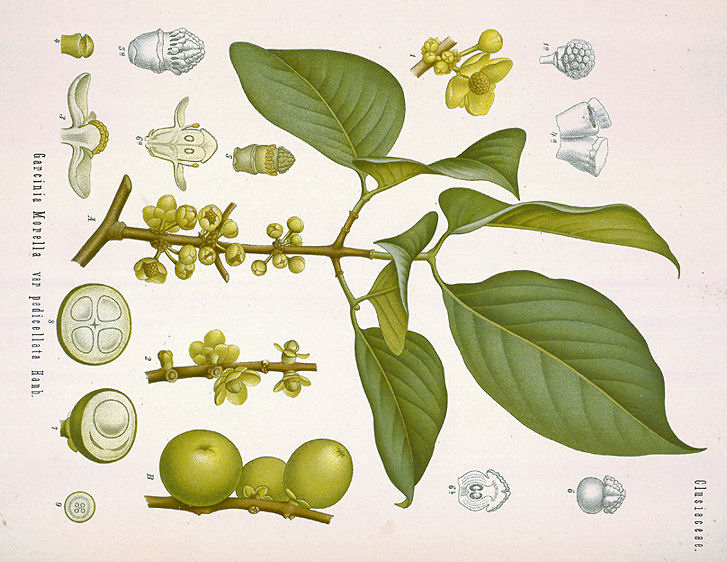
Abb.: Garcinia morella Desr.
1792
[Bildquelle: Köhler, 1887. -- Public domain]
"GARCINIA MORELLA, Desrouss.
Fig.—Bentl. and Trim., t. 33; Wight Ic., t. 102.
Gamboge tree (Eng.)
Hab.—Eastern Bengal, Western Peninsula, Eastern Peninsula, Ceylon.
[...]
History, Uses, &c.—The Gamboge tree of Malabar and Canara, which is also found in other parts of India, is by Beddome called G. pictoria and kept distinct from G. Morella. Hooker considers them both to be the same species. There would seem to be no doubt that Gamboge has never been collected in India as an article of commerce; and that it is only from a comparatively recent date that the drug has been known in this country; but the Hindus of Canara and Mysore, and probably of other parts of India, have for a long time used the juice of this tree under the Sanskrit name of Tamala as a pigment for making sectarial marks on the forehead, and this name is still current in Hindi, Bengali and Marathi. Other Sanscrit names for the tree are Tāpiccha and Tāpinja. The Ussārah-i-Rewand of Arabic and Persian books is, properly speaking, an extract of Rhubarb as the name implies, but owing to a similarity in properties and also in colour, the same name was applied to Gamboge upon its becoming known as an article of commerce. Siam Gamboge is the only kind obtained in the drug markets. An interesting account of the history of commercial Gamboge will be found in the Pharmacographia from which it appears that it only became known to the Chinese about A.D. 1300, and was not introduced into Europe before 1603. Reudenius (1611—1625) described its medicinal properties and recommended its use as a purgative in arthritis (gout)."
[Quelle: Pharmacographia indica : a history of the principal drugs of vegetable origin met with in British India / by William Dymock [1834-1892], C. J. H. Warden and David Hooper [1858-1947]. -- Bd. 1. -- London, 1890. -- S. 168f.]
Argemone mexicana L. 1753 - Mexikanischer Stachelmohn - Devil`s Fig
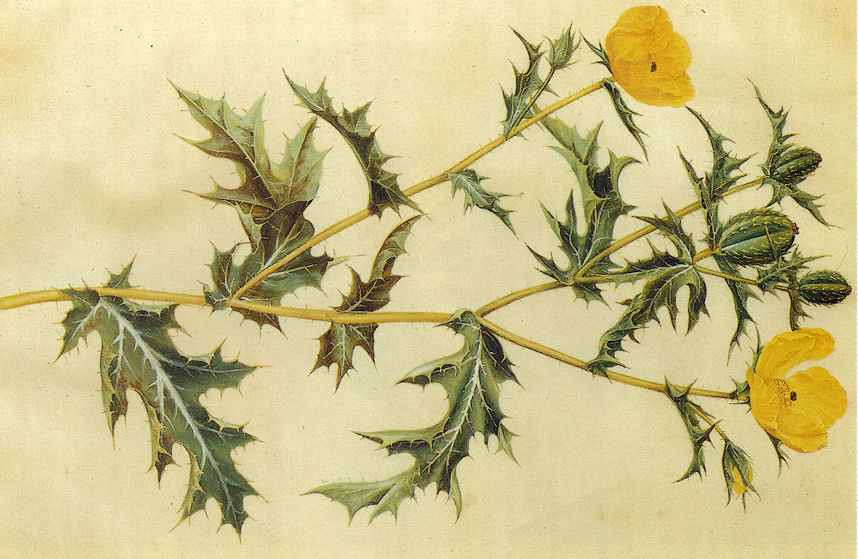
Abb.: Argemone mexicana L.
1753 - Mexikanischer Stachelmohn - Devil`s Fig
[Bildquelle: Hans-Simon Holtzbecker
1649 / Wikimedia. -- Public domain]
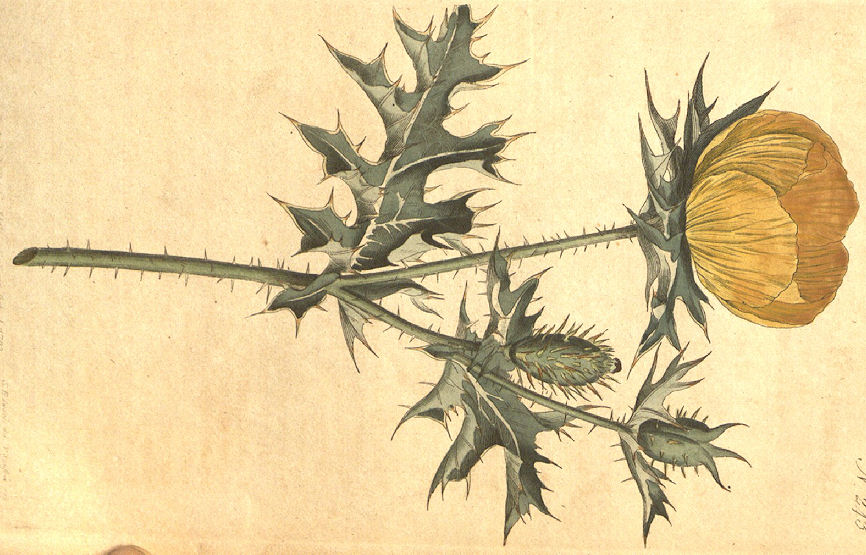
Abb.: Argemone mexicana L.
1753 - Mexikanischer Stachelmohn - Devil`s Fig
[Bildquelle: Curtis's Botanical Magazine, v. 7 (1794), Tab. 243.]
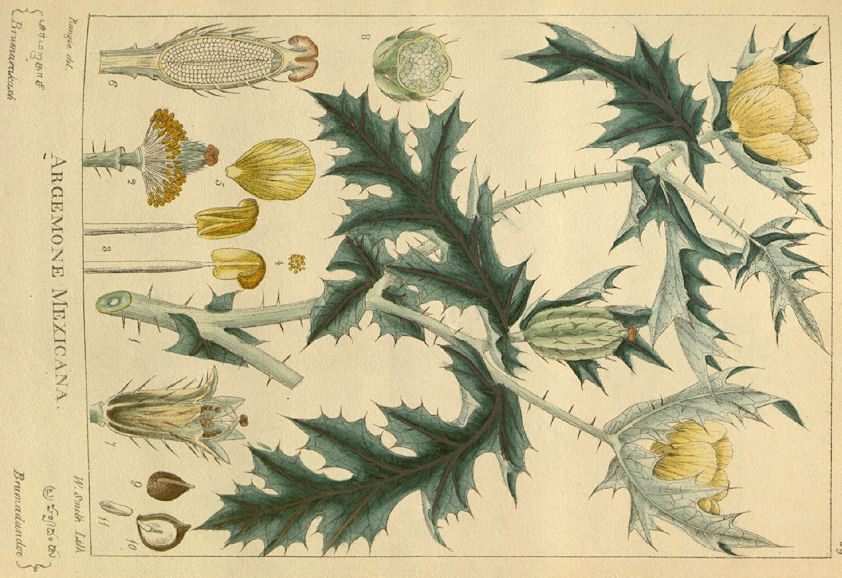
Abb.: Argemone mexicana L.
1753 - Mexikanischer Stachelmohn - Devil`s Fig
[Bildquelle: Wight: Illustrations I, Tab. 11,
1840]
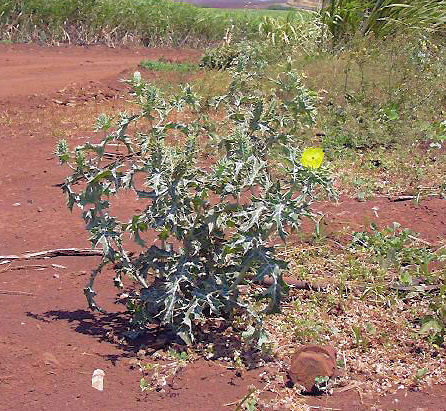
Abb.: Argemone mexicana L.
1753 - Mexikanischer Stachelmohn - Devil`s Fig
[Bildquelle: USGS / Wikimedia. -- Public domain]
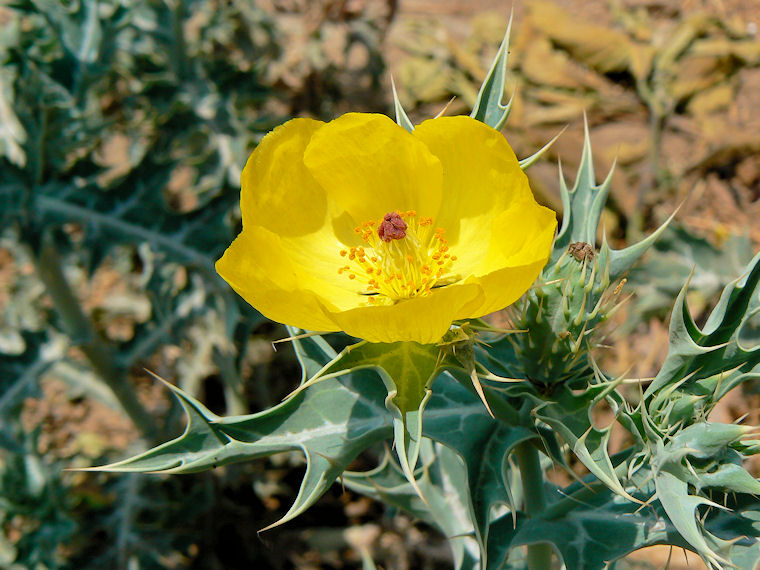
Abb.: Argemone mexicana L.
1753 - Mexikanischer Stachelmohn - Devil`s Fig, Maharashtra
[Bildquelle: dinesh_valke. --
http://www.flickr.com/photos/dinesh_valke/457998175/. -- Zugriff am
2010-10-23. --
Creative
Commons Lizenz (Namensnennung, keine kommerzielle Nutzung, keine
Bearbeitung)]
"Argemone Mexicana (Linn.) N. O. Papaveraceae. Yellow thirtle or Mexican poppy. [...]
Description.—Annual, herbaceous; [...] flowers yellow.
Fl. Oct—Nov.
W. & A. Prod. i. 18.
Coromandel. Malabar in waste places.
Medical Uses.—This plant is a native of Mexico, but is now found abundantly in Asia and Africa over a very extended area. The stalks and leaves abound with a bitter yellow juice like Gamboge, which is used in chronic ophthalmia. The seeds are used in the West Indies as a substitute for Ipecacuanha. An oil is also expressed from them, which in South America is much used by painters, and for giving a shining appearance to wood. It has also been employed as a substitute for castor-oil, and is applied externally in headache by the native practitioners. The juice of the plant in infusion is diuretic, relieves strangury from blisters, and heals excoriations. The seeds are very narcotic, and said to be stronger than opium. Simmonds says, "The seeds possess an emetic quality. In stomach complaints the usual dose of the oil is thirty drops on a lump of sugar, and its effect is perfectly magical, relieving the pain instantaneously, throwing the patient into a profound refreshing sleep, and relieving the bowels." This valuable, but neglected plant has been strongly recommended as an aperient, anodyne, and hypnotic, by Dr Hamilton and other experienced practitioners in the West Indies.—(Vide Pharm. Journal, iv., v., and xii.) Samples of the oil were produced at the Madras Exhibition. It is cheap, and procurable in the bazaars, being used chiefly for lamps.—(Ainslie. Lindley. Simmonds.) Age apparently affects its activity, the freshly-prepared oil proving more energetic and uniform in its operation than that which has been kept some time. It has a soothing influence on all herpetic eruptions; and as a local application to indolent ulcers the expressed juice is much esteemed by the natives. The native practice of applying the juice to the eye in ophthalmia is dangerous. The plant was introduced into India from Mexico some three centuries ago. It is covered with strong prickles, whence the Spaniards called it Figo del Inferno—the Fig of Hell. The fresh root, bruised and applied to the part stung by scorpions, is said to give relief.—Pharm. of India. Agric. Journ. of India, ix. 403."
[Quelle: Drury, Heber <1819 - 1872>: The useful plants of India : with notices of their chief value in commerce, medicine, and the arts. -- 2d ed. with additions and corrections. London : Allen, 1873. -- xvi, 512 p. ; 22 cm. -- s.v.]
"ARGEMONE MEXICANA, Linn,
Fig.—Bot.Mag., t. 243; Wight, Ill, i. t. 11.
Gamboge Thistle, Mexican Poppy
Hab.—America. Naturalized in India.
[...]
History, Uses, &c.—This is an American plant which has now run wild all over India; it may easily be known by its glaucous prickly thistle-like leaves, bright yellow flowers and yellow milky juice. The latter is used by the natives as an application to ulcers, and in combination with the juice of Aristolochia bracteata is given internally in syphilis and gonorrhoea. (Hové, Tours in 1787-88 ; Bomb. Govt. Records No 16, New Series.) In the Concan the juice with milk is given in leprosy. The seeds and seed oil have been used by European physicians in India, and there has been much difference of opinion regarding their properties, some considering them inert, and others asserting that the oil in doses of from 30 to 60 minims is a valuable remedy in dysentery and other affections of the intestinal canal. The evidence collected in India for the preparation of the Indian Pharmacopoeia strongly supports the latter opinion ; our experience is also in favour of it ; and Charbonnier, who examined the oil in 1868, found it aperient in small doses ; possibly those who have used the oil unsuccessfully purchased it in the bazaar, and were supplied with a mixed article; no bazaar-made oils can be relied upon. Further experiments with the oil fully-confirm this opinion. Flückiger found 4 to 5 grammes to have a mild purgative effect. The smallness of the dose required to produce an aperient action, and the absence of any disagreeable taste, will probably lead to a more extended use of it as a substitute for castor-oil. An extract made from the whole plant has been found to have an aperient action, and the milky juice to promote the healing of indolent ulcers. We. have not noticed any bad effects from its application to the eyes. Its use as an external application for the eyelids in conjunctivitis was probably introduced into this country with the plant by the Portuguese, who appear to have adopted it in Brazil as a substitute for the Argemone of the Greeks and Romans (Papaver Argemone) which was used for that purpose.
For a similar account of the properties of this plant, as observed in the West Indies by Hamilton, see Pharmaceutical Journal [i.], Vol. IV., p. 167.
Pouppé Desportes of St. Domingo describes the fresh seeds as emetic and slightly narcotic; he states that the oil obtained from them is used to relieve pain in dry colic."
[Quelle: Pharmacographia indica : a history of the principal drugs of vegetable origin met with in British India / by William Dymock [1834-1892], C. J. H. Warden and David Hooper [1858-1947]. -- Bd. 1. -- London, 1890. -- S. 109ff.]
Garcinia cambogia Desr.
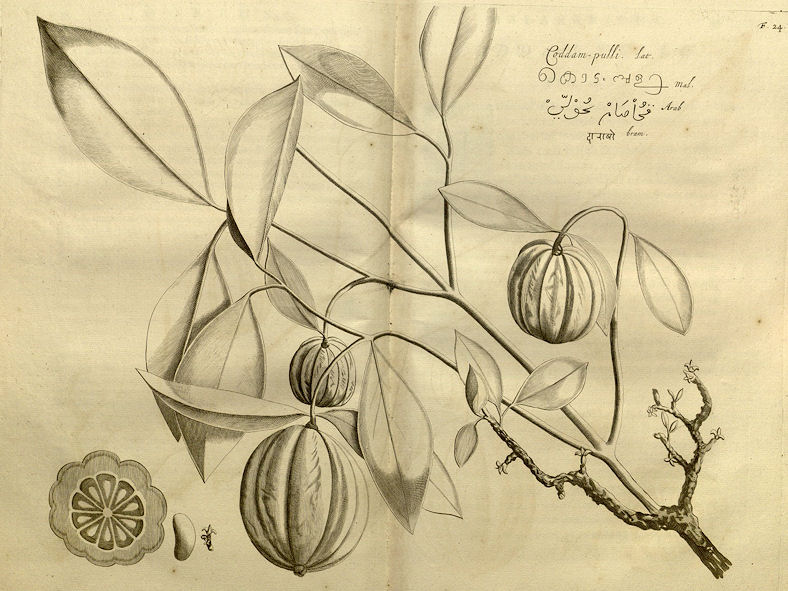
Abb.: Garcinia cambogia
Desr.
[Bildquelle: Hortus malabaricus I. Fig. 24,
1678]
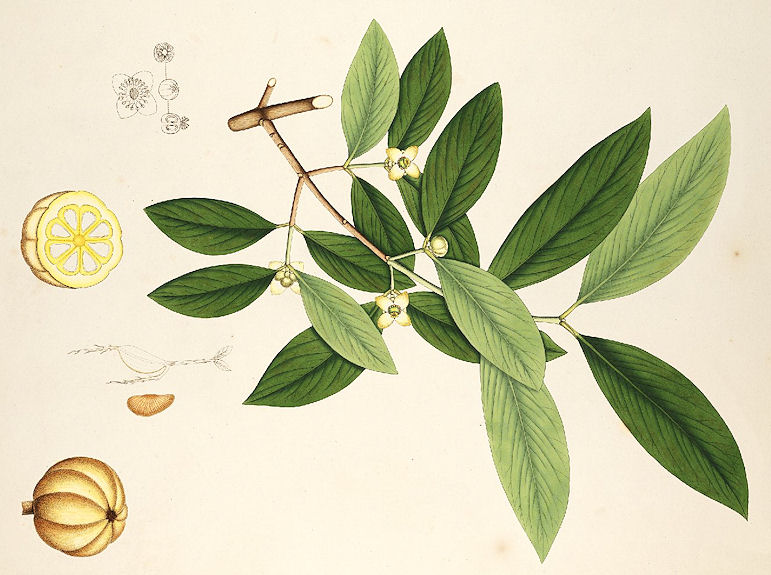
Abb.: Garcinia cambogia
Roxb.
[Bildquelle: Roxburgh. -- Vol III. -- 1819. --
Tab. 298. -- Image courtesy Missouri Botanical
Garden. http://www.botanicus.org. --
Creative Commons Lizenz
(Namensnennung, keine kommerzielle Nutzung)]
"Garcinia gambogia (Desrous). N. O. Clusiaceae. Description.—Tree; [...]
Dec. Prod. L 561.— W. & A. Prod. i. 100.
G. Kydia, W. & A. l. c.
Gambogia gutta, Linn.
G. papilla, Wight Icon. t. 960.—Bedd. Fl. Sylv. t. 85.Forests of the western coast.
Economic Uses.—The pigment which exudes from the trunk is semi-transparent, very adhesive, and unsuitable as a paint. The acid rinds of the ripe fruit are eaten, and in Ceylon are dried, and eaten as a condiment in curries. The tree is called Heela on the Neilgherries. It yields an excellent, straight-grained, lemon-coloured, slightly elastic wood, and would answer for common furniture.— (Beddome.) The following report upon the gum-resin of this tree is given by Mr Broughton: "This Gamboge, though produced by a different tree to those which yield the Siam and Ceylon Gamboge, appears, nevertheless, exceedingly similar, and to be of fine quality. An estimation of the amount of colouring resin, which is the essential constituent, gave a yield of 76 per cent, the remainder consisting of gum and starch. The specimen I received was in small lumps, and differed thus in external appearance to the commercial specimens I have seen; but in quality it can well compare with them. The yield of ordinary Gamboge in colouring resin varies from 40 to 75 per cent. Gamboge is used as a pigment in the manufacture of lacquer and in medicine. The price of the Canara gum is 1 rupee per lb. I believe the English wholesale price is £38 per cwt. As a commercial product, this Gamboge appears to promise well. I believe, some time ago, Dr Cleghorn was led to pay much attention to this substance."
[Quelle: Drury, Heber <1819 - 1872>: The useful plants of India : with notices of their chief value in commerce, medicine, and the arts. -- 2d ed. with additions and corrections. London : Allen, 1873. -- xvi, 512 p. ; 22 cm. -- s.v.]
Fabaceae (Hülsenfrüchtler)
| 4. a./b. hayapucchī tu kāmbojī
māṣaparṇī mahāsahā हयपुच्छी तु काम्बोजी माषपर्णी महासहा ।४ क। [Bezeichnungen für Teramnus labialis (L. f.) Spreng 1826:]
|
Colebrooke (1807): "Māshānī."
1 काम्बोजी - kāmbojī f.: Kambojerin
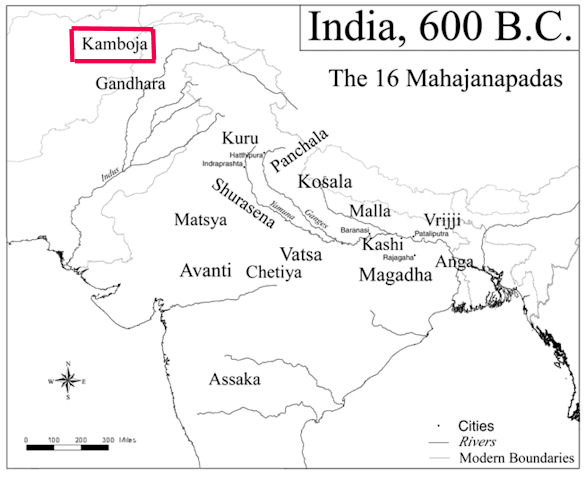
Abb.: Lage von Kamboja
[Bildquelle: Kmusser / Wikipedia. -- GNU
FDLicense]
2 माषपर्णी - māṣaparṇī f.: Bohnenblatt
māṣa m. = Vigna mungo [L.] Hepper 1956 = Urd Bean = Urd-Bohne
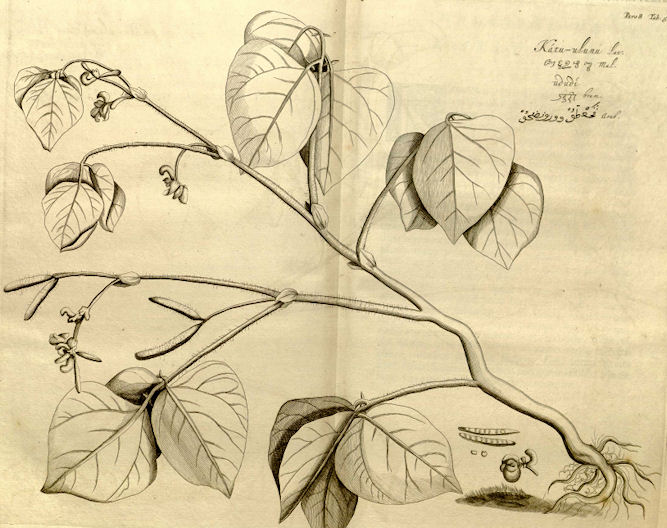
Abb.: माषः । Vigna mungo
[L.] Hepper 1956 = Urd Bean = Urd-Bohne
[Bildquelle: Hortus malabaricus VIII. Fig.
50,
1688]
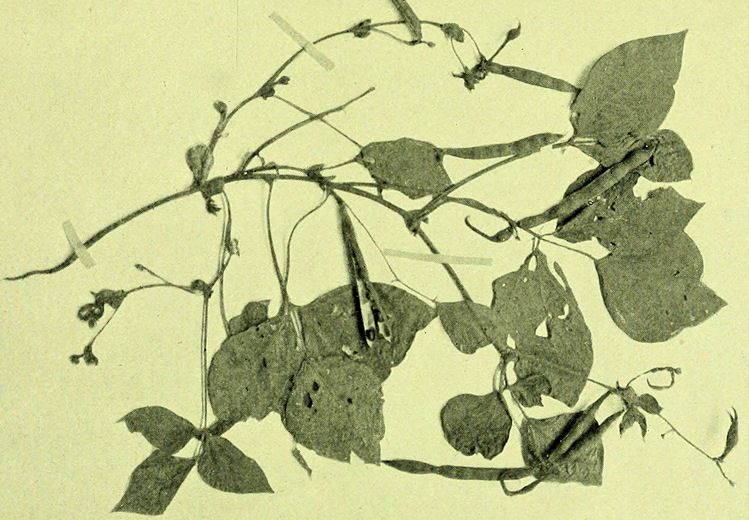
Abb.: माषः । Vigna mungo
[L.] Hepper 1956 = Urd Bean = Urd-Bohne
[Bildquelle: Blasdale, Walter Charles <1871 - >: A
description of some Chinese vegetable food materials and their nutritive
and economic value. -- Washington, DC, 1899. -- Nach S. 36]
Teramnus labialis (L. f.) Spreng 1826
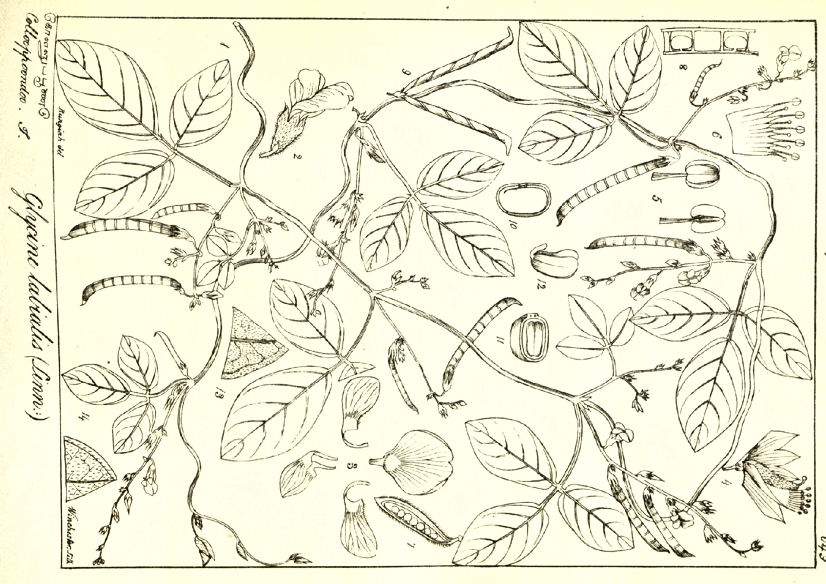
Abb.: माषपर्णी
। Teramnus labialis (L. f.) Spreng 1826
[Bildquelle: Wight Icones I, Tab. 168, 1840]
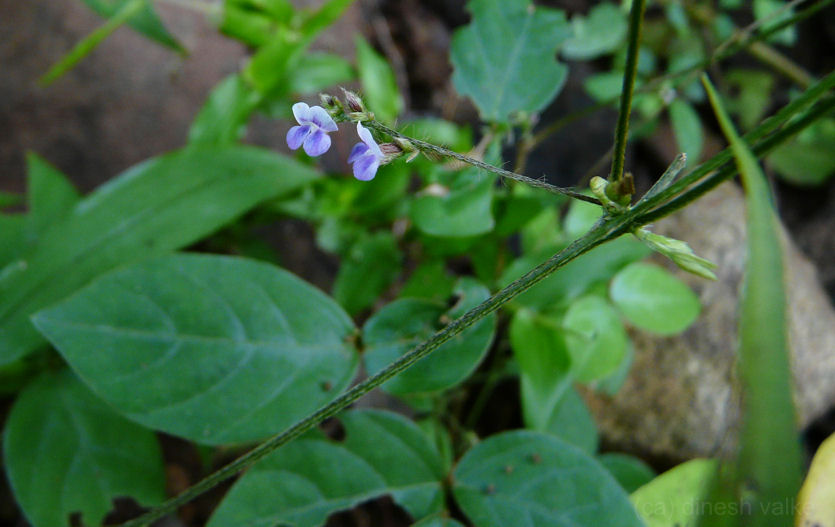
Abb.: Teramnus labialis (L. f.)
Spreng 1826, Maharashtra
[Bildquelle: dinesh_valke. --
http://www.flickr.com/photos/dinesh_valke/2933366763/. -- Zugriff am
2010-10-23. --
Creative
Commons Lizenz (Namensnennung, keine kommerzielle Nutzung, share alike)]
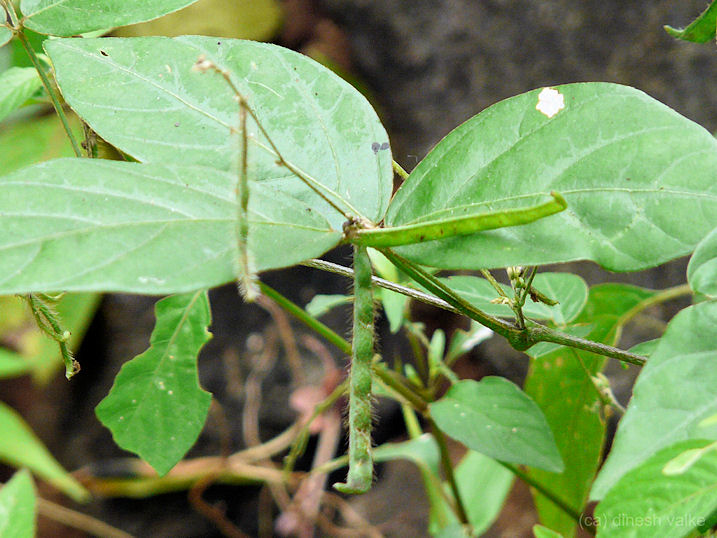
Abb.: माषपर्णी
। Teramnus labialis (L. f.)
Spreng 1826, Maharashtra
[Bildquelle: dinesh_valke. --
http://www.flickr.com/photos/dinesh_valke/2933366763/. -- Zugriff am
2010-10-23. --
Creative
Commons Lizenz (Namensnennung, keine kommerzielle Nutzung, share alike)]
"Teramnus labialis.—Spreng.
Wight, Ic. t. 168.
This wild pulse is called in Sanskrit Māsha-parni, "having leaves like Māsha" (Phaseolus Roxburghii), Haya-puchchha "horse's tail," and Svayambhu, "self-existing." It is described in the Nighantas as cooling, pungent, dry, strengthening, sweet, astringent, digestive and febrifuge. [...] Like Māsha it is much used in medicine both internally and externally in paralysis, rheumatism and affections of the nervous system. (See Māsha.)"
[Quelle: Pharmacographia indica : a history of the principal drugs of vegetable origin met with in British India / by William Dymock [1834-1892], C. J. H. Warden and David Hooper [1858-1947]. -- Bd. 1. -- London, 1890. -- S. 491.]
Cucurbitaceae (Kürbisgewächse)
|
4. c./d. tuṇḍikerī raktaphalā bimbikā pīluparṇy api तुण्डिकेरी रक्तफला बिम्बिका पीलुपर्ण्य् अपि ॥४ ख॥ [Bezeichnungen für Coccinia grandis (L.) Voigt 1845 - Große Scharlachranke - Ivy Gourd:]
|
Colebrooke (1807): "Telācuchā. Momordica monadelpha [Roxb. = Coccinia grandis (L.) Voigt 1845] or Bryonia grandis [L. = Coccinia grandis (L.) Voigt 1845]."
1 तुण्डिकेरी - tuṇḍikerī f.: Tuṇḍikererin
Tuṇḍikera = Name eines Volksstamms, ein Clan der Haihaya (हैहय):
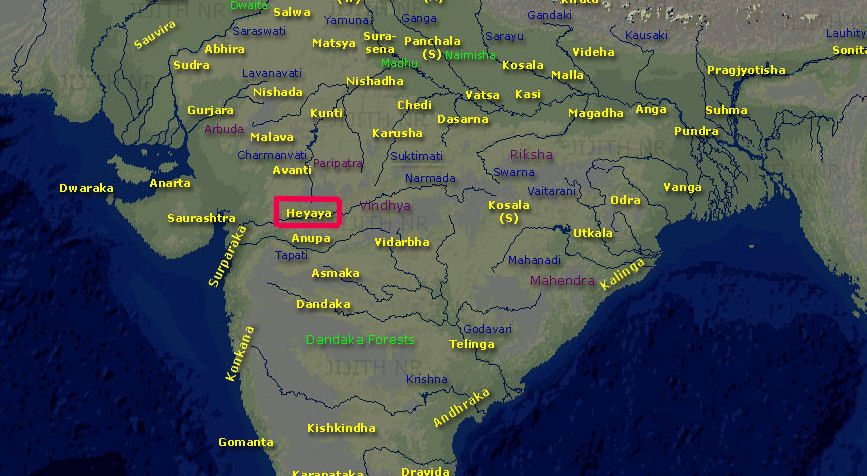
Abb.: Wohngebiet der Haihaya
[Bildquelle: JIJITH NR / Wikipedia. -- GNU
FDLicense]
2 पीलुपर्णी - pīluparṇī f.: Pīlu-Blättrige
pīlu m. = Salvadora persica L. - Zahnbürstenbaum - Toothbrush Tree, hat ganz andere Blätter! pīlu hat auch die Bedeutungen "Pfeil" und "Elefant"
Coccinia grandis (L.) Voigt 1845 - Große Scharlachranke - Ivy Gourd
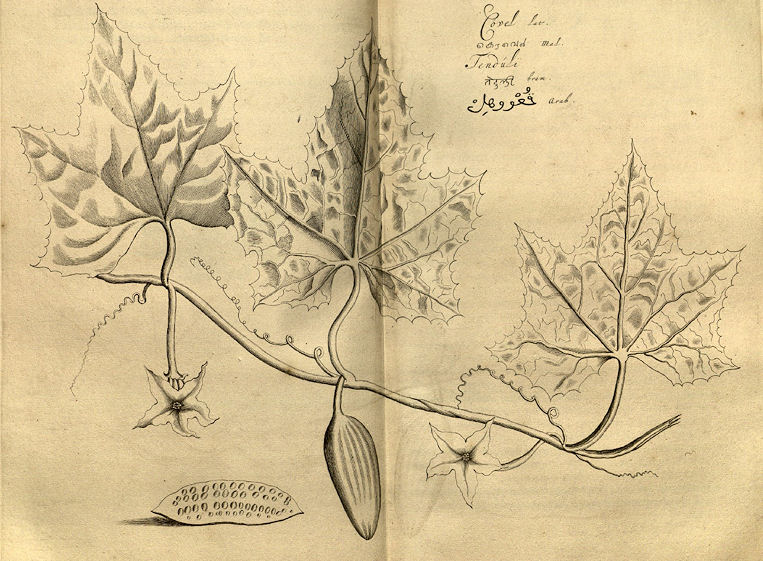
Abb.: पीलुपर्णी
। Coccinia grandis (L.) Voigt
1845 - Große Scharlachranke - Ivy Gourd
[Bildquelle: Hortus malabaricus VIII. Fig. 14,
1688]
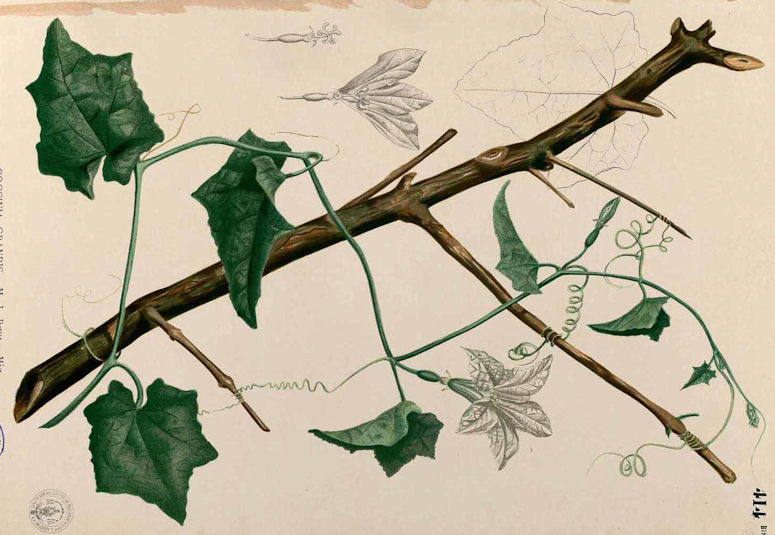
Abb.:
पीलुपर्णी
। Coccinia grandis (L.) Voigt
1845 - Große Scharlachranke - Ivy Gourd
[Bildquelle: Flora de Filipinas, 1880 / Wikipedia. -- Public domain]
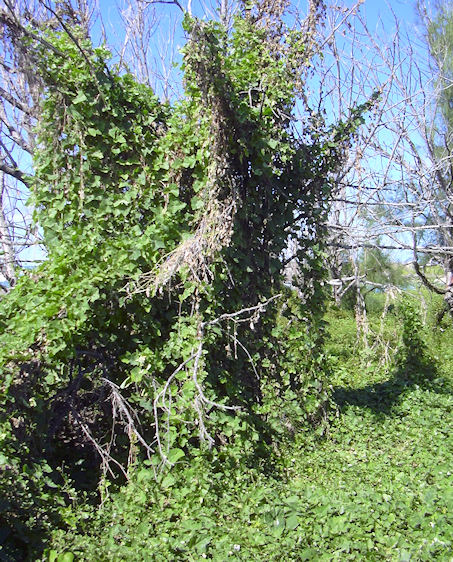
Abb.: Coccinia grandis (L.) Voigt
1845 - Große Scharlachranke - Ivy Gourd, Hawaii
[Bildquelle: Forest Starr & Kim Starr. --
http://www.hear.org/starr/images/image/?q=050222-0072&o=plants. -- Zugriff
am 2010-10-22. --
Creative Commons Lizenz (Namensnennung)]
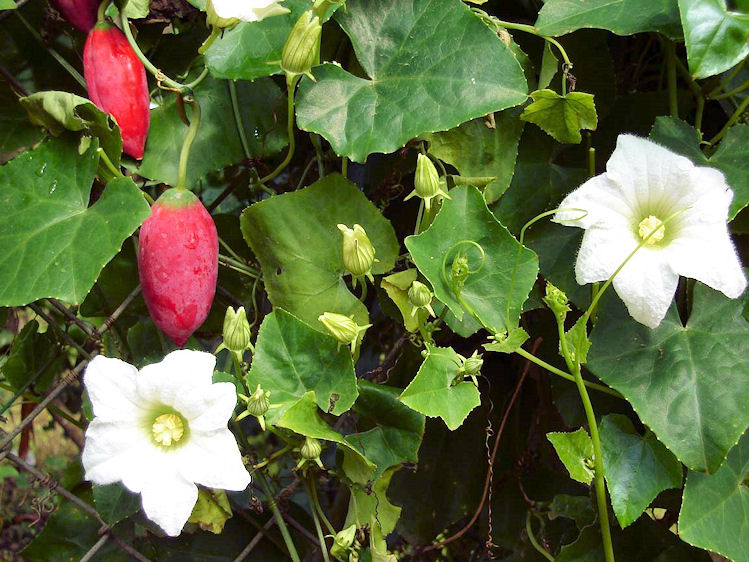
Abb.: रक्तफला
। Coccinia grandis (L.) Voigt
1845 - Große Scharlachranke - Ivy Gourd, Tonga
[Bildquelle: Tauʻolunga / Wikimedia. -- GNU FDLicense]
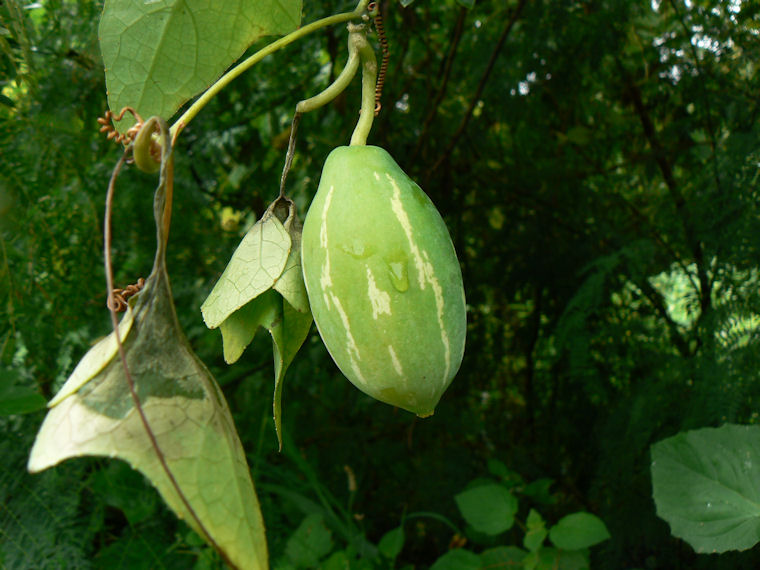
Abb.: बिम्बिका
। Coccinia grandis (L.) Voigt
1845 - Große Scharlachranke - Ivy Gourd, Maharashtra
[Bildquelle: dinesh_valke. --
http://www.flickr.com/photos/dinesh_valke/1427389068/. -- Zugriff am
2010-10-23. --
Creative
Commons Lizenz (Namensnennung, keine kommerzielle Nutzung, keine
Bearbeitung)]
"The Ivy Gourd (Coccinia grandis), also called tindora (tindori, tindoori), parwal, kundru, tondli (तोंडली in Marathi), toroda/kunduri (oriya), ghiloda, kundri, kowai, kovai, kovakkai (Malayalam - കോവയ്ക്ക),kovakka (Tamil), dondakaya (Telugu - దొండకాయ), tondekayi (Kannada - ತೊಂಡೆಕಾಯಿ), manoli, tindla, gentleman's toes (compare lady's fingers), tendli, thendli, thainli, tam lueng (ตำลึง), baby watermelon or little gourd (Sanskrit name : Bimbi बिम्बी ) is a tropical vine. Botany
Coccinia grandis botanical description "Dioecious perennial herbaceous vine. Stems mostly glabrous, produced annually from a tuberous rootstock; tendrils simple, axillary. Leaves alternate, simple, blade broadly ovate, 5-lobed, 5-9 x 4–9 cm, acute and mucronate at the apex, cordate with a broad sinus at the base; surfaces glabrous or scaly, with 3-8 glands near the base; margins denticulate; petiole 1–5 cm long. Inflorescence usually of solitary, axillary flowers. Calyx of 5 subulate, recurved lobes 2-5mm long on the hypanthium; peduncle 1–5 cm long. Corolla campanulate, white, 3-4.5 cm long, deeply divided into 5 ovate lobes. Stamens 3, present as staminodes in female flowers. Ovary inferior. Fruit a smooth, bright red, ovoid to ellipsoid berry 2.5–6 cm long" (PIER, 2001).Synonyms of botanical name "" cephalandra indica"
Geographic SpreadCoccinia grandis native range includes: Africa and Asia; India, Philippines, China, Indonesia, Malaysia, Thailand, Vietnam, eastern Papua New Guinea, Northern Territories (Australia) (PIER, 2003). It documented introduced range includes: Federated States of Micronesia, Fiji, Guam, Saipan, Hawai‘i, Marshall Islands, Samoa, Tonga, Vanuatu (PIER, 2003).
Seeds or fragments of the vine can be relocated and lead to viable offspring. This can occur when humans transport organic debris or equipment containing C. grandis. Once Ivy Gourd is established, it is presumed that it is spread by birds, rats and other mammals.In Hawaii PIER (2001) suggests that the fruit may be dispersed by pigs. Long distance dispersal is most commonly carried out by humans due to its culinary uses or by mistake.
[...]
CultivationCultivation in Southeast Asia, ivy gourd is grown for its edible young shoots and edible fruits (Linney 1986).
Medicinal ValueThe website Gardenbed.com (2001) describes ivy gourd's various medicinal qualities as follows "The juice of the roots and leaves is used in the treatment of diabetes. The leaves are used as a poultice in treating skin eruptions. The plant is used as a laxative. It is used internally in the treatment of gonorrhea. Aqueous and ethanolic extracts of the plant have shown hypoglycaemic principles."
Ivy gourd extracts and other forms of the plant can be purchase online and healthfood stores with. It is claimed that these products help regulate blood sugar levels. It is said that compounds with the plant inhibits the enzyme glucose-6-phosphate which supports the body's own regulatory system and promotes a more balanced and healthy body. Therefore it is sometimes recommended for diabetic patients. These claims have not been supported but currently there is quite a bit of research focused on the medical properties of this plant. We can use all body parts for as medicinal purpose. So it can use for hypoglycaemic case, as anioxident, as immune grower....etc. Some counties in Asia like Thailand they prepare traditional tonic like drinks for medicinal aspects.
RecipesThe website Gardenbed.com (2001) reports, "Young leaves and long slender stem tops are cooked and eaten as a potherb or added to soups. Young and tender green fruits are eaten raw in salads or cooked and added to curries. Ripe scarlet fruit is eaten raw."
There are a variety of recipes from all over the world that list Ivy Gourd as the main ingredient. It is often compared to bitter melon. The fruit is commonly eaten in Indian cuisine. Natives of Thailand, Indonesia, and other southeast Asian countries also consume the fruit and leaves. Cultivation of ivy gourd in home gardens has been encouraged in Thailand due to its being a good source of several micronutrients, including vitamins A and C.
It is eaten as a curry, by deep-frying it; stuffing it with masala and sauteing it ; or boiling it first in a cooker and then frying it. It is also used in sambar, a vegetable and lentil-based soup.
NutritionIvy gourd is rich in beta-carotene."
[Quelle: http://en.wikipedia.org/wiki/Coccinia_grandis. -- Zugriff am 2011-01-11.]
Lamiaceae (Lippenblütler)
|
5. a./b. barbarā kabarī tuṅgī kharapuṣpājagandhikā बर्बरा कबरी तुङ्गी खरपुष्पाजगन्धिका ।५ क। [Bezeichnungen für Ocimum basilicum L. 1753 - Basilikum - Basil:]
|
Colebrooke (1807): "Barbarā. Ocymum [= Ocimum] gratissimum [L. 1753] ?"
Ocimum basilicum L. 1753 - Basilikum - Basil
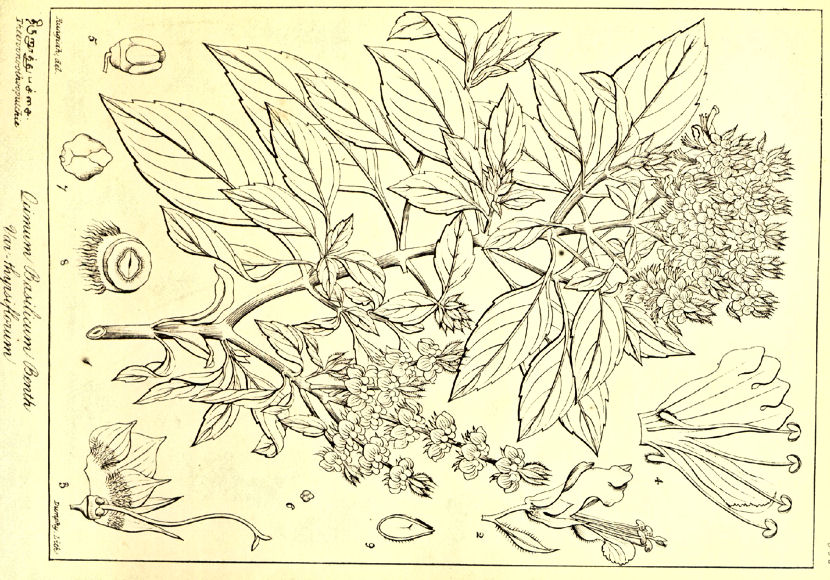
Abb.: तुङ्गी
। Ocimum basilicum L. 1753 -
Basilikum - Basil
[Bildquelle: Wight Icones III, Tab. 868, 1846]
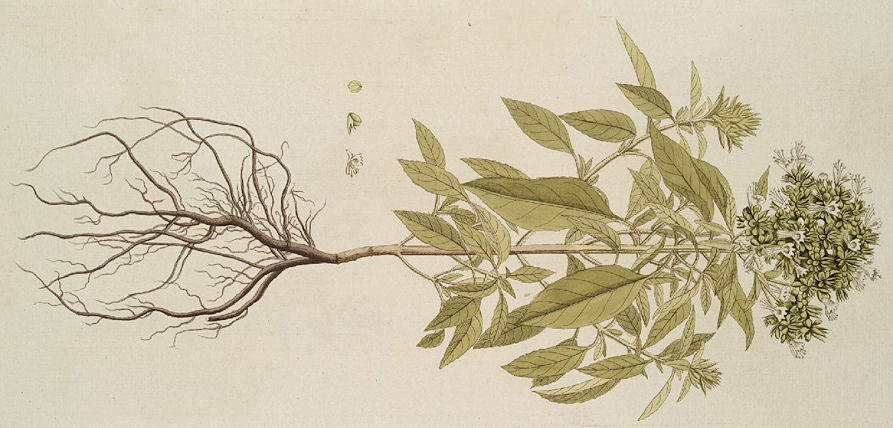
Abb.: बर्बरा
। Ocimum basilicum L. 1753 -
Basilikum - Basil
[Bildquelle: Hortus botanicus vindobonensis,
seu, Plantarum rariorum, quae in Horto botanico vindobonensi ... :coluntur,
icones coloratae et succinctae descriptiones / cura et sumptibus Nicolai Josephi
Jacquin. -- Wien, 1770 - 1776. -- Bd. 3. -- Tab. 72.]
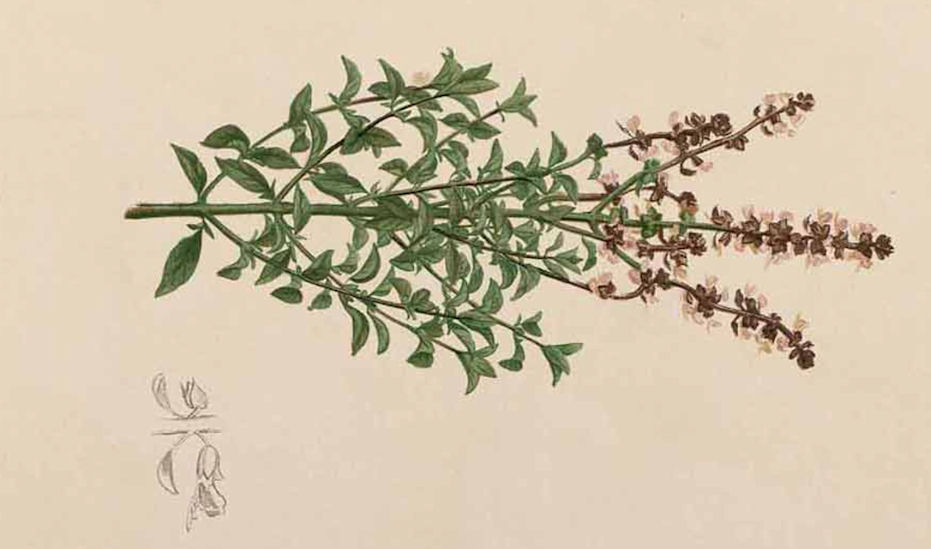
Abb.: कबरी
। Ocimum basilicum L. 1753 -
Basilikum - Basil
[Bildquelle: Flora de Filipinas, 1880 / Wikipedia. -- Public domain]
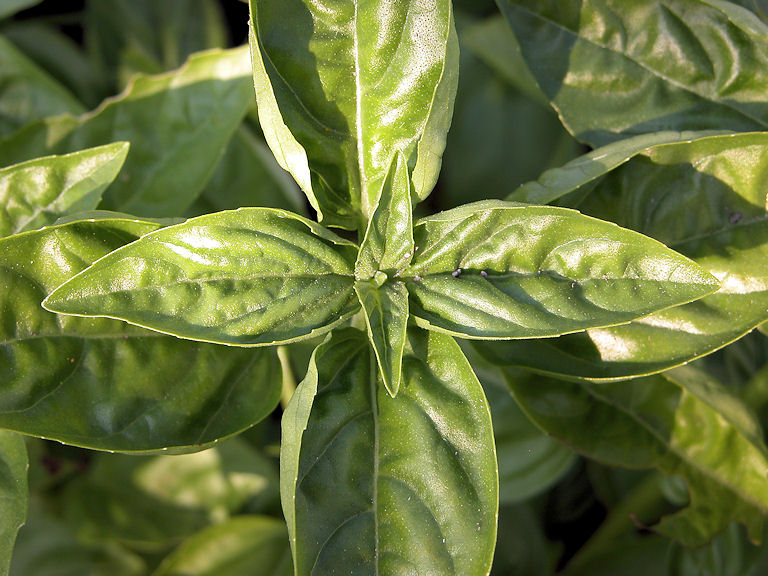
Abb.: Ocimum basilicum L. 1753 -
Basilikum - Basil
[Bildquelle: Carl E. Lewis. --
http://www.flickr.com/photos/carllewis/1469384173/. -- Zugriff am
2010-10-24. --
Creative Commons Lizenz (Namensnennung)]
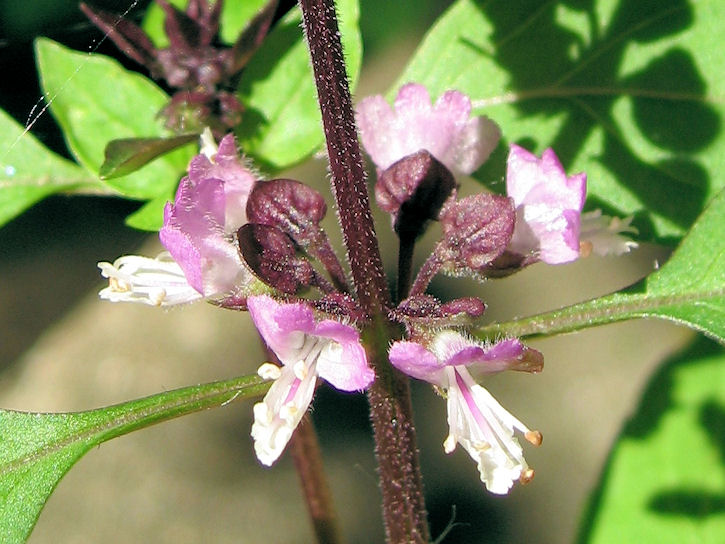
Abb.: Ocimum basilicum L. 1753 -
Basilikum - Basil
[Bildquelle: beautifulcataya. --
http://www.flickr.com/photos/beautifulcataya/3655729892/. -- Zugriff am
2010-10-25. --
Creative
Commons Lizenz (Namensnennung, keine kommerzielle Nutzung, keine
Bearbeitung)]
"Ocimum Basilicum (Linn.) N. O. Lamiaceae. Sweet Basil, Eng. [...]
Description.—Herbaceous, erect, glabrous; [...] flowers small, white.
Fl. Nearly all the year.— Wight Icon. t. 868.
O. pilosum, Benth. and Willd.—Roxb. Fl. Ind. iii. 16.
Peninsula. Bengal Oude. Travancore.
The varieties are :—
- O. anisatum, Benth. More erect and less pilose; leaves larger, thicker, and slightly toothed; corollas usually villous.—0. basilicum, Linn.—Rod). Fl. Ind. iii. 16.—Rheede, x. t. 87.
O. glabratum, Benth. Erect; petioles and calyxes sparingly ciliated; leaves scarcely toothed; racemes elongated, simple.—O. in- tegerrimum, Willd.—O. caryophyllatum, Roxb. Fl. Ind. iii. 16.—Goolaltulsee, Beng. Patna.
O. thyrsiflorum, Benth. Erect, glabrous; petioles and calyxes hardly ciliated ; raceme thyreoid; branched flowers pale-pink.—Roxb. Fl. Ind. iii. 15.— Wight Icon. t. 868.
Medical Uses.—The whole plant is aromatic and fragrant The seeds are cooling and mucilaginous, and are said to be very nourishing and demulcent. An infusion is given as a remedy in gonorrhoea, catarrh, dysentery, and chronic diarrhoea. The juice of the leaves is squeezed in the ear in ear-ache. Dr Fleming states that the seeds are a favourite medicine with Hindoo women for relieving the after-pains of parturition. In Europe the leaves and small branches or leafy tops are gathered for culinary purposes, and used in highly-seasoned dishes. Sometimes they are introduced into salad and soups.—(Don. Ainslie.) The juice of the leaves of O. villosum, mixed with ginger and black pepper, is given during the cold stages of intermittent fever. It is also prescribed to allay vomiting arising from irritation produced by worms.—(Long Indig. Plants of Bengal.) The seeds steeped in water swell and form a pleasant jelly, useful as a diaphoretic and demulcent—Powell's Panj. Prod."
[Quelle: Drury, Heber <1819 - 1872>: The useful plants of India : with notices of their chief value in commerce, medicine, and the arts. -- 2d ed. with additions and corrections. London : Allen, 1873. -- xvi, 512 p. ; 22 cm. -- s.v.]
"OCIMUM BASILICUM, Linn.
Fig. —Wight Ic, t. 868; Jacq. Hort. Vind, iii., t, 72; Rheede, Hort. Mal. x., t. 87.
Sweet Basil
Hab. —Persia, Punjab. Cultivated throughout India.
[...]
History, Uses, &c.—The Hindus dislike the smell of this plant; the Mahometans on the other hand are very partial to it. The Arabs call it Rihān or "the herb," and the Persians Shahasperham or "king of herbs," and Nāzbu, "having a delicate odour "; it is also known in Persia as Habak-i-Kirmāni, " Kirman mint," from its abundance in that province. The author of the Makhzan states that it is the Ocimum of Europeans, who call the large-leaved variety Ocimum magnum, and the small-leaved Ocimum parvum. The plant is considered. to be hot and dry, deobstruent, carminative, and stimulant, and the seeds taken whole are much Valued on account of their mucilaginous properties : when crushed they are said to be astringent, and are prescribed in fluxes from the bowels. The juice of the plant snuffed up causes sneezing and clears the brain. O. basilicum id probably the ωκιμον of Dioscorides, but perhaps not of Theophrastus, who describes ωκιμον as a shrub. The Ocimum of Pliny is probably a kind of clover which also bore this name, as he states that it is given to mares and asses to promote conception.
De Gubernatis (Myth. des Plant. ii., 35) gives an interesting account of the history of Basil in Europe where it is considered to be erotic and funereal. In Southern Italy it is worn in the waist or bosom of young girls and in the hair of married women, and is called Bacia-nicola; the youths stick a sprig of it above the ear when they go courting. In Tuscany the Basil is called Amorino. In Crete it is a sign of mourning, but is universally cultivated in window gardens; Boccacio's story of Isabetta of Messina is too well known to require repetition. De Gubernatis is of opinion that all the superstitions concerning this plant current in Southern Europe are of Byzantine origin. According to the Apomamris Apotelesmata, to dream of Basil is unlucky.
In Europe Sweet Basil is used as a potherb for certain kinds of food, and is considered to have general qualities as thyme, sage, &c. It has long been a popular remedy for mild nervous or hysterical disorders, and in Buenos Ayres its fresh juice is said to be used as an anthelmintic, and to possess the advantage of not tending to produce unpleasant symptoms. Its essential oil was formerly in vogue as a carminative and nervine. (Med. Record, xvi., 325.)
Description.—Three forms of this plant are common in India:
the mint-like garden basil, with large flower, and green or purple stems;
the variety pilosum of Roxburgh having a pleasant lemon odour;
and a small variety common in gardens and on waste ground having a marked peppermint odour, and hardly different from O. canum."
[Quelle: Pharmacographia indica : a history of the principal drugs of vegetable origin met with in British India / by William Dymock [1834-1892], C. J. H. Warden and David Hooper [1858-1947]. -- Bd. 3. -- London, 1893. -- S. 83ff.]
Ocimum gratissimum L. 1753
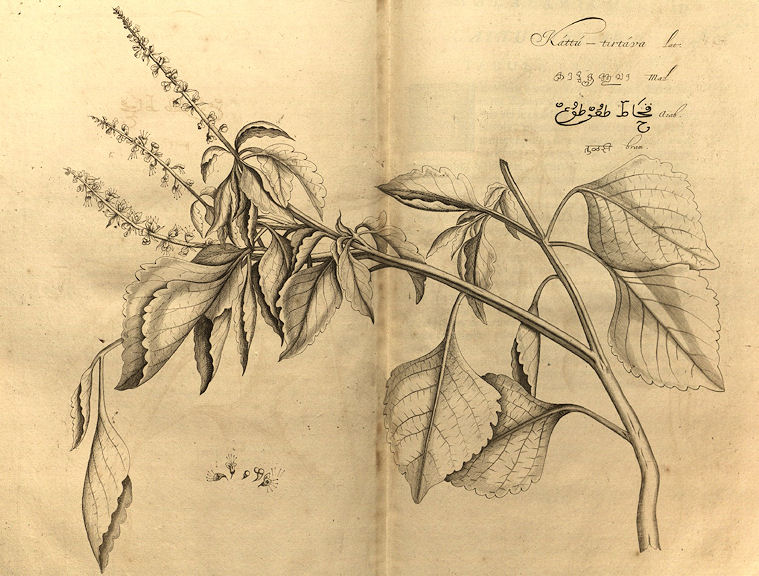
Abb.: Ocimum
gratissimum L. 1753
[Bildquelle: Hortus malabaricus X. Fig. 86, 1690]
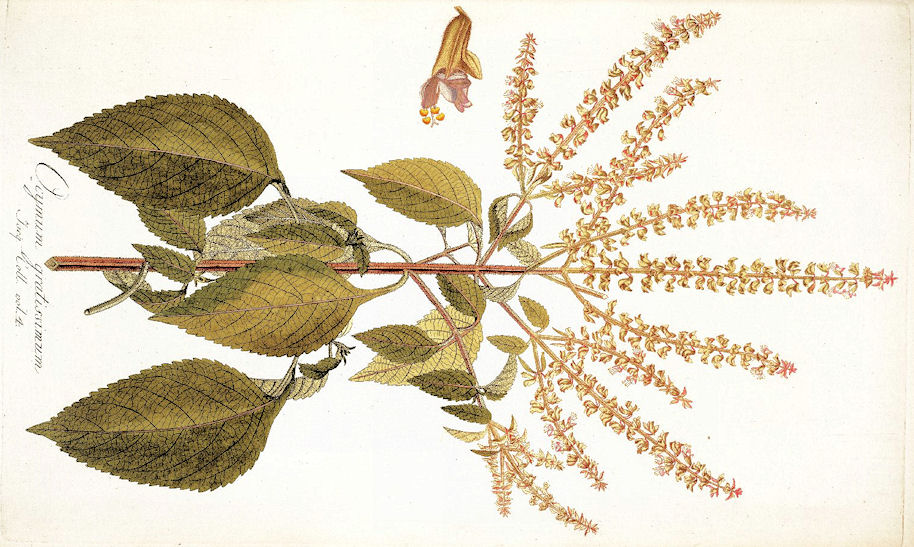
Abb.: Ocimum
gratissimum L. 1753
[Bildquelle: Icones plantarum rariorum / editae Nicolao Josepho
Jacquin. -- Vol. 3. -- 1786 - 1793. -- Tab. 495]
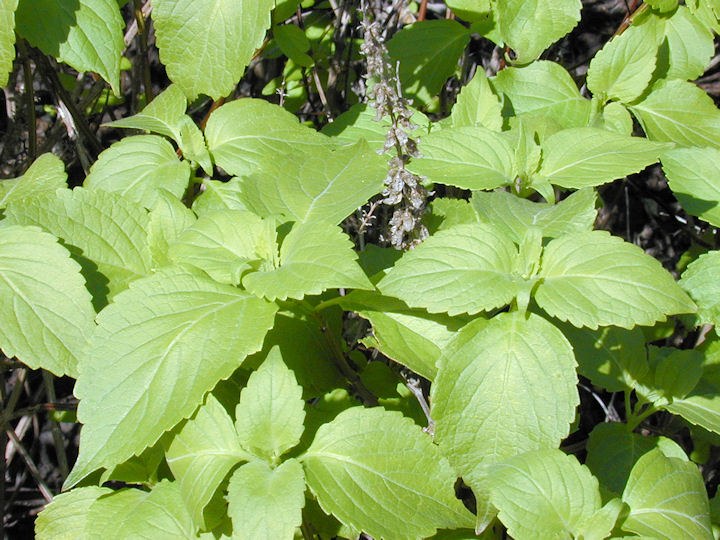
Abb.: Ocimum
gratissimum L. 1753, Hawaii
[Bildquelle: Forest & Kim Starr. --
http://www.hear.org/starr/images/images/plants/full/starr-030202-0010.jpg. -- Zugriff
am 2010-12-01. --
Creative Commons Lizenz (Namensnennung)]
"OCIMUM GRATISSIMUM, Linn.
Fig.—Jacg. Ic. Pl. Rar. iii., t. 495; Rheede, Hort, Mal. x., t. 86.
Hab.—Bengal, Chittagong, E. Nepal, Decean Peninsula.
[...]
History, Uses, &c.—This plant is the Yarvara, Barbara, and Ājvalla of the Nighantas. The leaves have a remarkably grateful lemon odour and taste, and are made into a chutney by the Hindus, and are also used as a cooling remedy in gonorrhoea. Baths and fumigations prepared with this plant are used in the treatment of rheumatism and paralysis. A decoction of the mucilaginous seeds is used as a demulcent. This plant has been wrongly identified with the Palangmishk or Faranjmishk of Persia. The seeds imported into Bombay from Persia under these names bear no resemblance to those of O. gratissimu."
[Quelle: Pharmacographia indica : a history of the principal drugs of vegetable origin met with in British India / by William Dymock [1834-1892], C. J. H. Warden and David Hooper [1858-1947]. -- Bd. 3. -- London, 1893. -- S. 85f.]
Pluchea: Asteraceae (Korbblütler)
Alpinia: Zingiberaceae (Ingwergewächse)
Vanda: Orchidaceae (Orchideen)
Inula: Asteraceae (Korbblütler)
|
5. c./d. elāparṇī tu suvahā rāsnā yuktarasā ca sā एलापर्णी तु सुवहा रस्ना युक्तरसा च सा ॥५ ख॥ [Bezeichnungen für Pluchea lanceolata Oliver & Hiern oder Alpinia galanga (L.) Willd. 1797 - Siamesische Ingwerlilie - Galangal oder Vanda tessellata (Roxb.) Hook. ex G. Don 1830 oder Inula racemosa Hook. f. 1881:]
|
Colebrooke (1807): "Elānī. Mimosa octandra [Roxb. = Mimosa rubicaulis Lam. 1783] ?"
1 एलापर्णी - elāparṇī f.: Kardamom-Blättrige
elā f. = Amomum subulatum Roxb. 1820 - Nepal-Cardamom - Black Cardamom & Elettaria cardamomum (L.) Maton 1811 - Malabar-Kardamom - Chester Cardamom
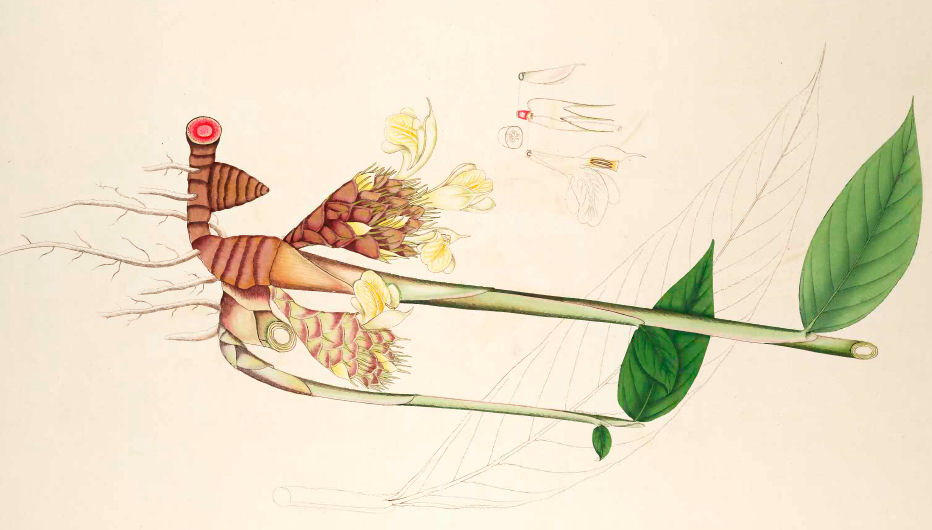
Abb.: निष्कुटिः ।
Amomum subulatum Roxb. 1820 - Nepal-Cardamom - Black Cardamom
[Bildquelle: Roxburgh. -- Vol III. -- 1819. -- Image courtesy Missouri Botanical
Garden. http://www.botanicus.org. --
Creative Commons Lizenz
(Namensnennung, keine kommerzielle Nutzung)]
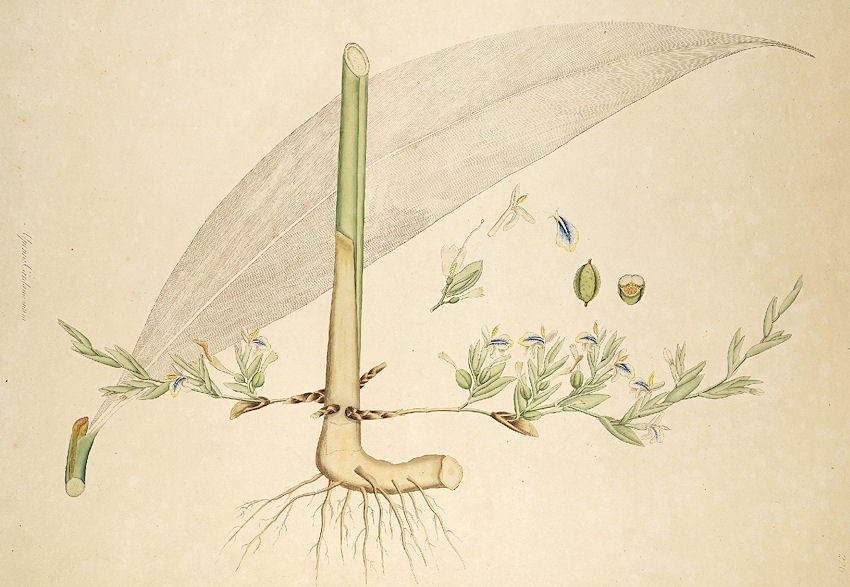
Abb.: उपकुञ्चिका । Elettaria cardamomum (L.)
Maton 1811 - Malabar-Kardamom - Chester Cardamom
[Bildquelle: Roxburgh. -- Vol III. -- 1819. -- Tab. 226. -- Image courtesy
Missouri Botanical Garden.
http://www.botanicus.org. --
Creative Commons Lizenz
(Namensnennung, keine kommerzielle Nutzung)]
Pluchea lanceolata Oliver & Hiern
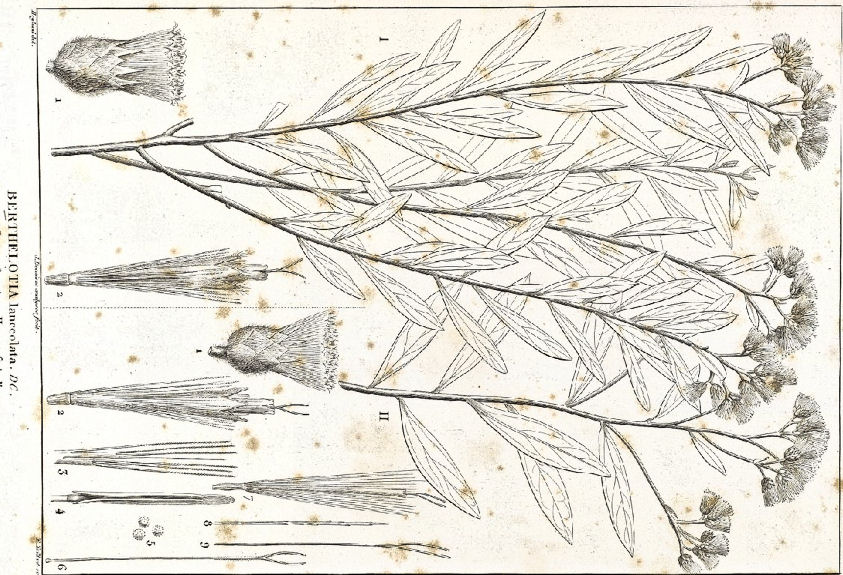
Abb.: Pluchea lanceolata Oliver &
Hiern
[Bildquelle: Icones selectae plantarum quas
in systemate universali : ex herbariis parisiensibus, praesertim ex Lessertiano
/ descripsit Aug. Pyr. de Candolle, ex archetypis speciminibus a P.J.F. Turpin
delineatae et editae a Benj. De Lessert. -- Paris, 1820 - 1846. -- Vol. IV, Pl.
21]
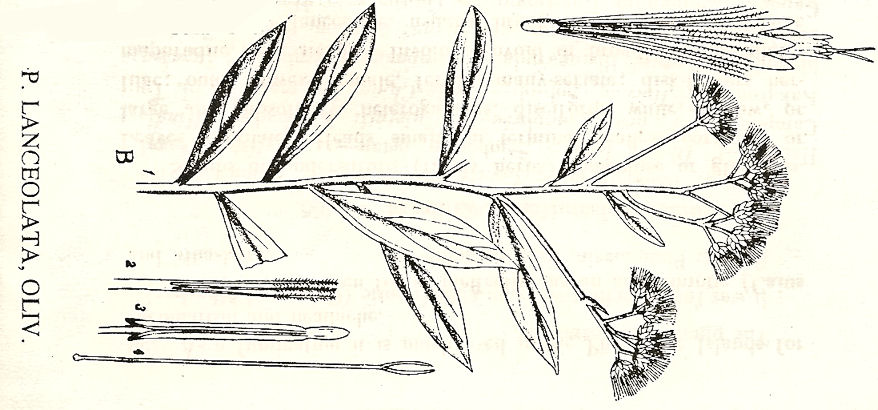
Abb.: Pluchea lanceolata Oliver &
Hiern
[Bildquelle: Kirtikar-Basu, ©1918]
"PLUCHEA LANCEOLATA, Oliv.
Fig.—Deless. Ic. Sel. iv., t. 21.
Syn. Berthelotia lanceolata.
Hab.—Upper Bengal, Oude, Punjab, Sind.
[...]
Description.—An annual, with spreading branches, and opposite, petioled, oval or oblong leaves covered with stomata on both sides, edges vertical; florets tubular, with silky pappus. It forms thickets up to four and five feet high. The leaves are said to be aperient, and used as a substitute for senna. We have not had an opportunity of examining them."
[Quelle: Pharmacographia indica : a history of the principal drugs of vegetable origin met with in British India / by William Dymock [1834-1892], C. J. H. Warden and David Hooper [1858-1947]. -- Bd. 2. -- London, 1891. -- S. 256f.]
Alpinia galanga (L.) Willd. 1797 - Siamesische Ingwerlilie - Galangal
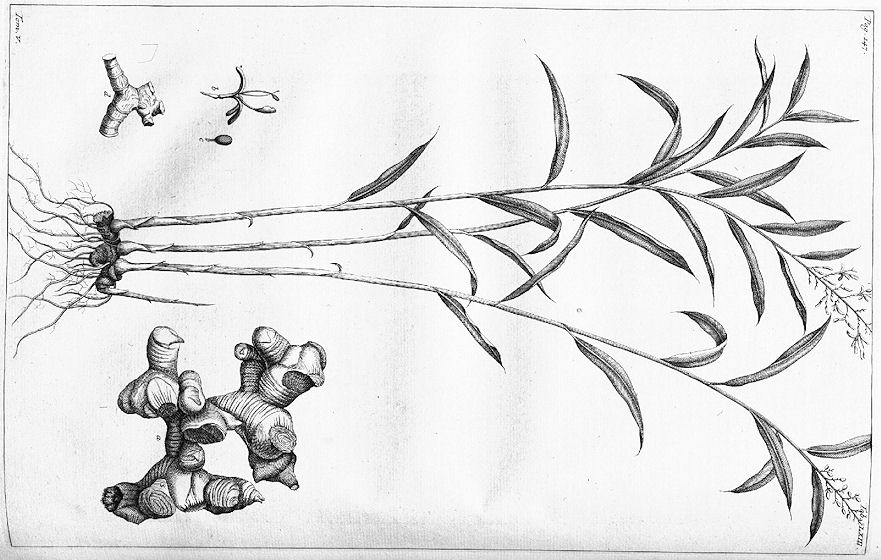
Abb.:
Alpinia galanga (L.) Willd. 1797 - Siamesische Ingwerlilie - Galangal
[Bildquelle: Herbarium amboinense / Georg.
Everhard Rumphius. -- Amsterdam, 1741 - 1750. -- Vol 5, Tab. 63.]
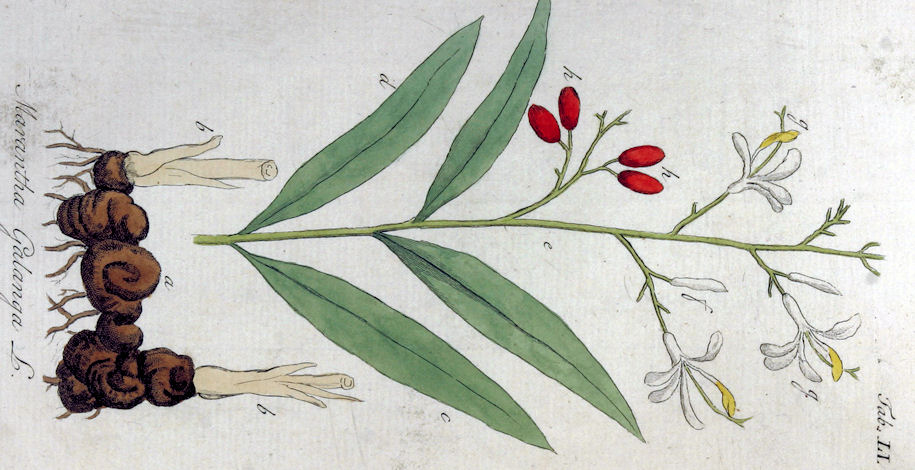
Abb.:
Alpinia galanga (L.) Willd. 1797 - Siamesische Ingwerlilie - Galangal
[Bildquelle: Adolphus Ypey 1813 / Wikimedia. -- Public domain]
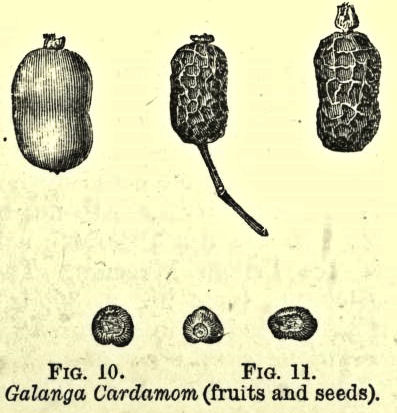
Abb.:
Alpinia galanga (L.) Willd. 1797 - Siamesische Ingwerlilie - Galangal
[Bildquelle: Science papers, chiefly pharmacological and botanical / by Daniel
Hanbury. -- London, 1876. -- S. 107]
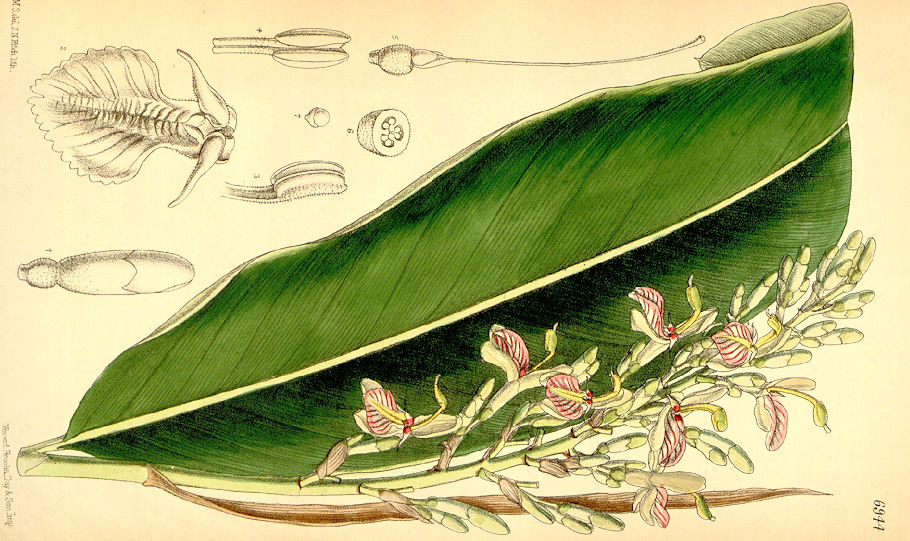
Abb.:
Alpinia galanga (L.) Willd. 1797 - Siamesische Ingwerlilie - Galangal
[Bildquelle: Curtis's Botanical Magazine, v. 113 (1887), Tab. 6944]
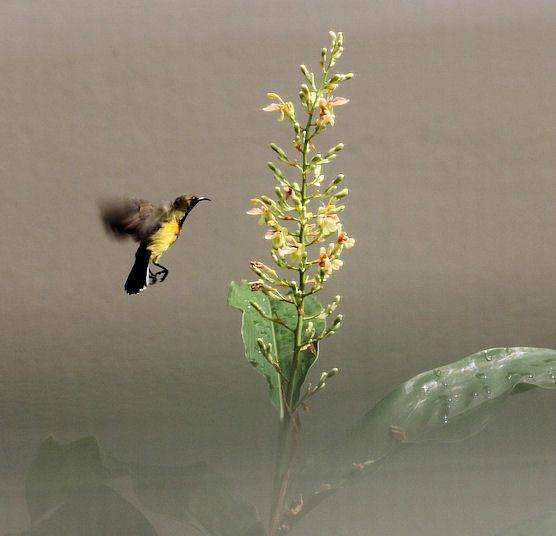
Abb.:
Alpinia galanga (L.) Willd. 1797 - Siamesische Ingwerlilie - Galangal,
Bangkok, Thailand
[Bildquelle:
Pakorn Krisprachant. --
http://www.flickr.com/photos/pakornk/564362677/. -- Zugriff am 2010-10-24.
-- Creative
Commons Lizenz (Namensnennung, keine kommerzielle Nutzung, share alike)]
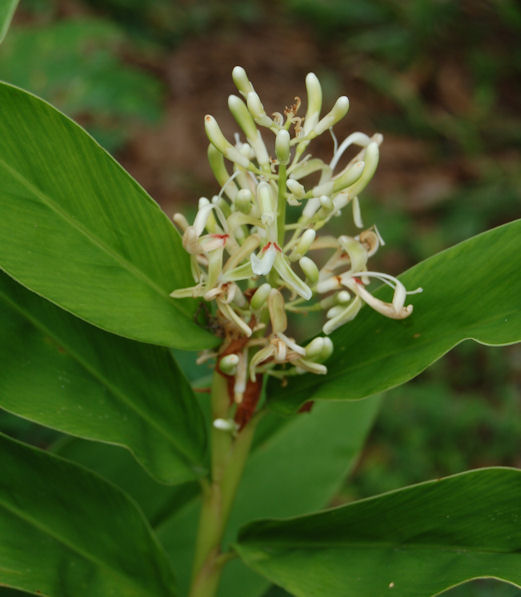
Abb.:
Alpinia galanga (L.) Willd. 1797 - Siamesische Ingwerlilie - Galangal
[Bildquelle: Meneerke bloem / Wikimedia. --
GNU FDLicense]
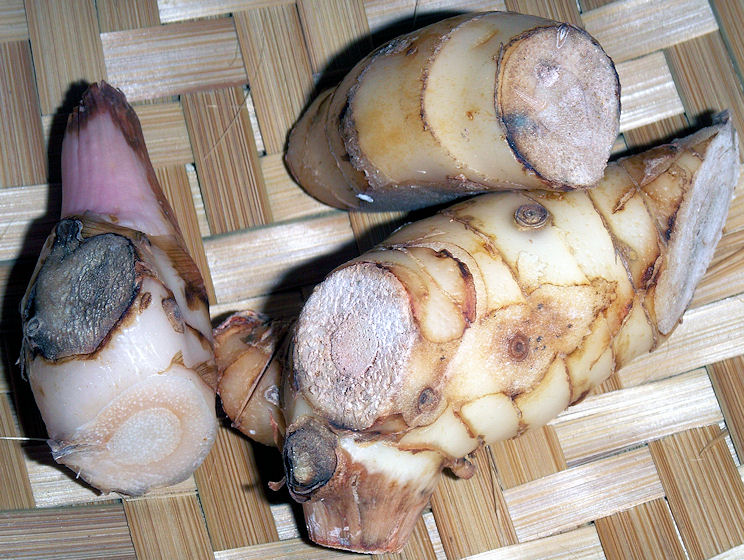
Abb.:
Alpinia galanga (L.) Willd. 1797 - Siamesische Ingwerlilie - Galangal
[Bildquelle: McLeod / Wikimedia. -- GNU FDLicense]
"Alpinia galanga (Swz.) N. 0. Zingiberaceae. [...]
Description.—Perennial; [...]
Fl. April—May.—Roxb. Fl. Ind. i. 59.
Maranta galanga, Linn.
South Concan. Chittagong. Travancore.
Medical Uses.—The tubers, which are faintly aromatic, pungent, and somewhat bitter, are the larger galangal of the shops, and are used as a substitute for ginger. They are given in infusion in fevers, rheumatism, and catarrhal affections. The galangal root is much used in China, and is one of the articles of commerce, realising in London 12s. to 16s. per cwt. It has an aromatic pungent taste; the outside is of a reddish-brown; internally it is reddish-white.
An inferior sort of galangal is got from A. Allughas (Roscoe), the root of which is considerably aromatic. Of this latter species Rheede says, that the juice of the root is applied externally in gout, and is also used internally. The root itself macerated and mixed with wine is a good external application for pains in the limbs; and, pulverised, is administered in colic. It is the Mala Inschikua of Rheede.—(Ainslie. Simmonds. Rheede.) The A. Khulinjan, a variety of the A. Chinensis, is found growing in several gardens at Madras; and its rhizome, when dried, resembles that of the lesser galangal It is supposed to be a distinct species by some, though closely approximating the A. Calcarata. It is stimulant, carminative, stomachic, and expectorant. It is useful in all diseases where ginger is used, and also in most nervous disorders. It has also proved useful in incontinence of urine.—Suppl. to Pharm. of India."
[Quelle: Drury, Heber <1819 - 1872>: The useful plants of India : with notices of their chief value in commerce, medicine, and the arts. -- 2d ed. with additions and corrections. London : Allen, 1873. -- xvi, 512 p. ; 22 cm. -- s.v.]
"ALPINIA GALANGA, Willd.
Fig.—Rumph. Amb. v., t. 63.
The greater Galangal. Java Galangal
Hab.—Java, Sumatra, Southern India. Cultivated Bengal.
[...]
History, Uses, &c.—The great Galangal is known in China by the same names as the lesser Galangal, and does not appear to have been distinguished from the latter drug by the Greeks, Arabs or Persians. Hanbury (Science Papers, p. 373) remarks that Garcia D'Orta was the first writer to point out (1563) that there are two kinds of Galangal—the one, as he says, of smaller size and more potent virtues, brought from China, the other, a thicker and less aromatic rhizome, produced in Java. Loureiro describes the plant which produces it under the name of Amomum Galanga, and gives Câo Leâm Kiâm as its name in Cochin-China. Roxburgh (i., 60) fully describes the plant grown in Calcutta from roots sent to him by Dr. Charles Campbell from Bencoolen, and quotes a note by Mr. Colebrooke to the effect that the roots are the Kulanjana of the Raja Nirghanta, and the Sughanda-vacha and Malabari-vacha of the Bhavaprakasha. From the latter name it appears that the Hindus regard the plant as a native of Malabar or of Western India; the correctness of this opinion has been confirmed by Dalzell and Gibson, who found it growing truly wild upon the Wagh Dongar or "tiger hill" in the Southern Concan. (Bomb. Fl., p. 274.) The root of the Indian plant does not, however, appear to have been collected for commercial purposes until a comparatively recent date, which has given rise to the supposition that the plant is not a native of India. At the present time it is cultivated both in Malabar and Bengal.
The fruits of A. galanga furnish the Galanga Cardamom. In the fresh state they are of the size of a small cherry, obovate, smooth, and of a deep orange-red colour. Hanbury (Science Papers, p. 252) describes the dried fruit (Kaon-leang-keang-tsze, Chinese) as about half an inch in length, of an oblong form, somewhat constricted in the middle, or occasionally pear-shaped; [...] (For figure, see Science Papers, p. 107.)
The root is readily distinguished from that of A. officinarum by its larger size, feebler odour and taste, orange-brown exterior and yellowish-white interior. The statistics of Indian commerce do not enable us to distinguish this drug from China galangal. It is valued in Bombay at about Rs. 50 per candy of 7 cwts. Galangal cardamoms are not found in Indian commerce.
In the Kew Bulletin for January 1891 (p. 5) an interesting account is given of the identification of the plant yielding the rhizome employed to make the well-known Chinese preserved ginger. As long ago as 1878, Dr. E. Percival Wright, of Trinity College, Dublin, called the attention of Mr. Thiselton Dyer to the fact that the preserved ginger has very much larger rhizomes than Zingiber officinale and that it was quite improbable that it was the produce of that plant. The difficulty in identifying the plant arose from the fact that, like many others cultivated for the root or tuber, it rarely flowers. The first flowering plant was sent to Kew from Jamaica by Mr. Harris, the Superintendent of the Hope Garden there. During the past year the plant has flowered both at Dominica in the West Indies and in the Botanic Garden at Hongkong. Mr. C. Ford, the Director of the Botanic Garden at Hongkong, has identified the plant as Alpinia galanga, the source of the greater or Java galangal root of commerce. Mr. Watson, of Kew, appears to have been the first to suggest that the Chinese ginger plant is probably a species of Alpinia, and possibly identical with the Siam ginger plant, which was described by Sir J. D. Hooker in the Botanical Magazine (tab. 6944) in 1887 as a new species, under the name of Alpinia zingiberina. Mr. J. G. Baker, in working up the Scitamineae for the 'Flora of British India, arrived at the conclusion that it is not distinct from the Alpinia galanga, Willd. The Siam and Chinese gingers are therefore identical, and both are the produce of Alpinia galanga, Willd. Pharm. Joum., Jan 31st, 1891."
[Quelle: Pharmacographia indica : a history of the principal drugs of vegetable origin met with in British India / by William Dymock [1834-1892], C. J. H. Warden and David Hooper [1858-1947]. -- Bd. 3. -- London, 1893. -- S. 440ff.]
Vanda tessellata (Roxb.) Hook. ex G. Don
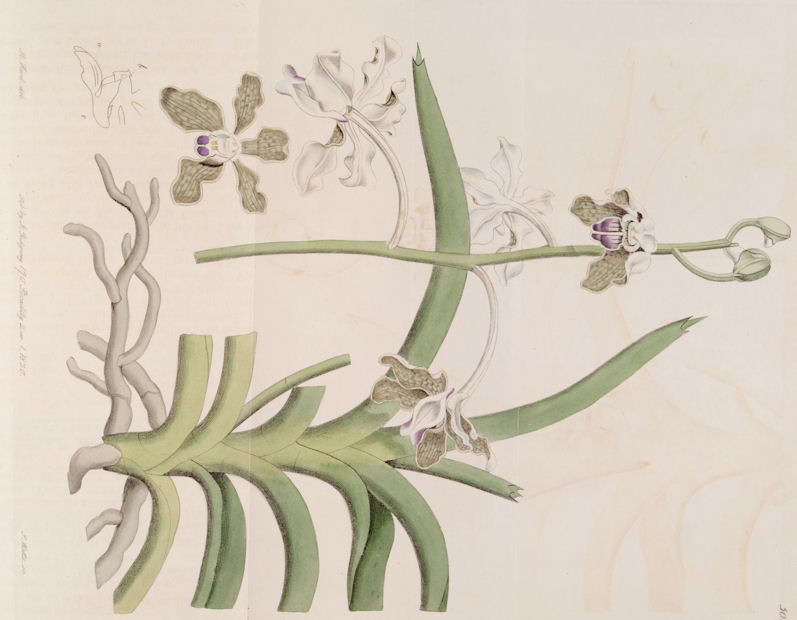
Abb.:
Vanda tessellata (Roxb.) Hook. ex G. Don
[Bildquelle: The botanical register 1812 /
Wikimedia. -- Public domain]
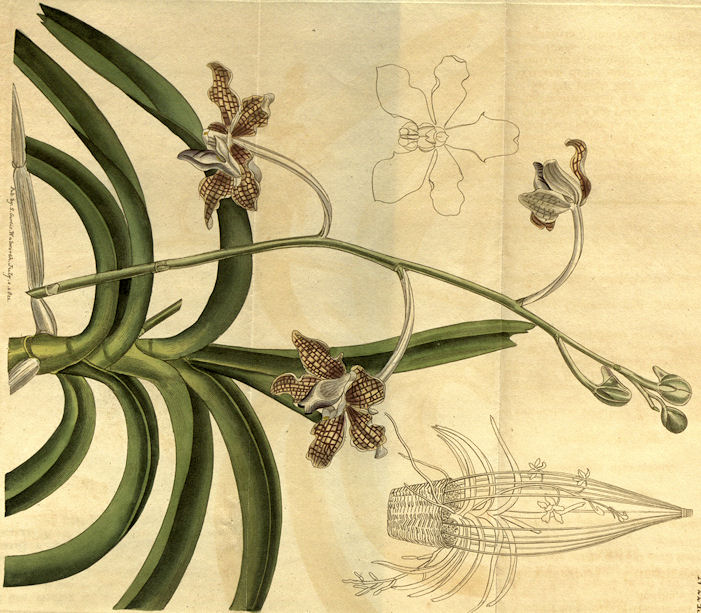
Abb.: Vanda tessellata (Roxb.)
Hook ex G. Don 1830
[Bildquelle: Curtis' Botanical Magazine 1831 / Wikimedia. -- Public domain]
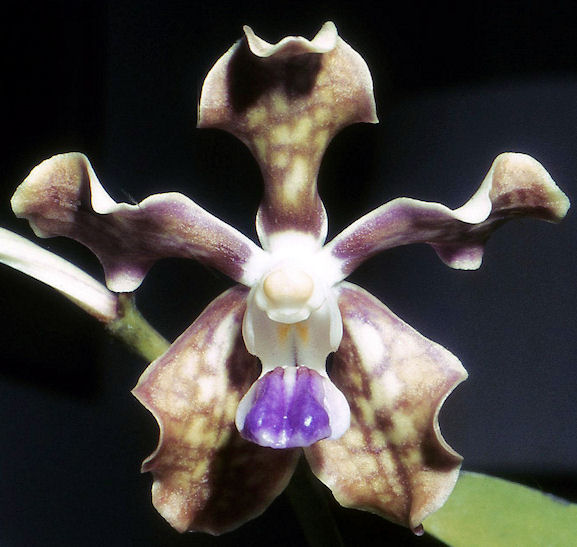
Abb.: Vanda tessellata (Roxb.)
Hook ex G. Don 1830
[Bildquelle: Orchi / Wikimedia. -- GNU FDLicense]
"Vanda Roxburghii, Br. [= Abb.: Vanda tessellata (Roxb.) Hook. ex G. Don] Fig.--Bot. Reg., t. 506 ; Wight Ic., t. 916. Fl. des Serres II., t. 11 ; Reichb. Fl. Exot., t. 121.
Hab.--Bengal, Behar, Guzerat, Concan to Travancore.
Saccolabium Papillosum, Lindl.
Fig.-- Bot. Reg., t. 1552.
Hab.--Bengal and the Lower Himalaya, Assam, the Gangetic Delta, the Circars and Tenasserim.
Vernacular.--Rāsna (Ind. Bazaars)
History, Uses, &C.—We have already stated (Vol. ii, p. 260) that we consider it probable that the original Rāsna of the Arians was Inula Helenium, as the two drugs at the head of this article are notably deficient in the properties ascribed to Rāsna by Sanskrit writers; for instance, the plants under consideration cannot be described AS Gandha-mūla having a strong smelling root." Dutt (MaT: Med., p. 258) remarks :—
"Under the name of rāsna, the roots of Vanda Roxburghii and Acampe papillosa are both indiscriminately used by native physicians. They are very similar in the appearance of their roots and leaves, though tliey differ much in their flowers and fruit. One native physician whom I consulted, pronounced both of these plants to be rāsna ; when, however, I showed him the different flowers and fruit of the two species, he was puzzled." The description of the properties and uses of rāsna will, we think, convince our readers that the original drug was not what is now used.
Rāsna is said to be bitter and fragrant, and useful in rheumatism ; the Rāsnapanchaka is a decoction of rāsna; Tinosporum cordifolia, wood of Cedrus Deodara, Ginger, and root of Ricinus communis, of each equal parts; it is a popular prescription for rheumatism. Rāsna guggulu is a ghrita composed of eight parts of rāsna and ten of bdellium beaten into a uniform mass with clarified butter; it is given in drachm doses in sciatica. Rāsna is also an ingredient of several oils used for external application in rheumatism and neuralgia, such as Mahāmāsha taila, Madhyama Narāyana taila, &c. Vanda is a general name in Sanskrit and the vernaculars for parasitic plants; other Sanskrit names for these plants are Vrikshādani and Vriksharuha "growing on trees." They are further distinguished by the addition of the names of the tree on which they grow, thus Amara-vanda would signify the Vanda of the Amara or mango.
Description.— V. Roxburghii.—Stem climbing, 1—2 feet;"
[Quelle: Pharmacographia indica : a history of the principal drugs of vegetable origin met with in British India / by William Dymock [1834-1892], C. J. H. Warden and David Hooper [1858-1947]. -- Bd. 3. -- London, 1893. -- S. 392f.]
Inula helenium L. 1753 - Echter Alant - Elacampane
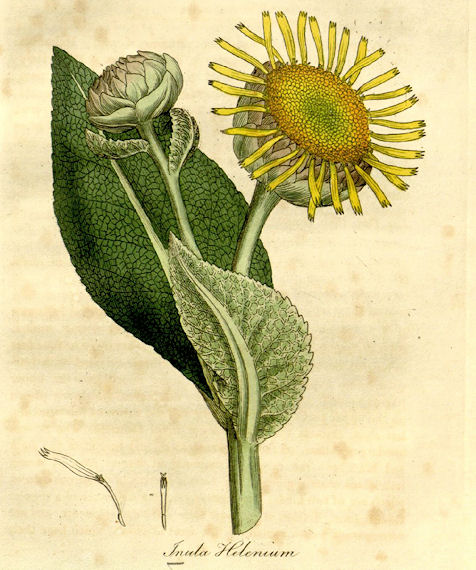
Abb.: Inula helenium L. 1753 - Echter Alant - Elacampane
[Bildquelle: Medical botany : containing
systematic and general descriptions, with plates of all the medicinal plants,
comprehended in the catalogues of the materia medica, as published by the Royal
Colleges of Physicians of London, Edinburgh, and Dublin, together with the
principal medicinal plants not included in those pharmocopoeias, accompanied
with a circumstantial detail of their medicinal effects, and of the diseases in
which they have been most successfully employed / by William Woodville. --
London, 1842. -- Vol 1, Tab. 26.]
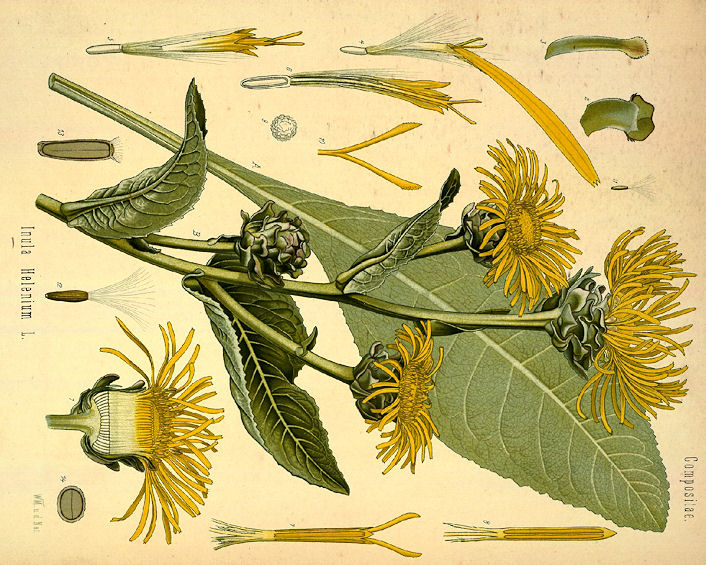
Abb.: Inula helenium L. 1753 - Echter Alant - Elacampane
[Bildquelle: Köhler, 1883-1914]
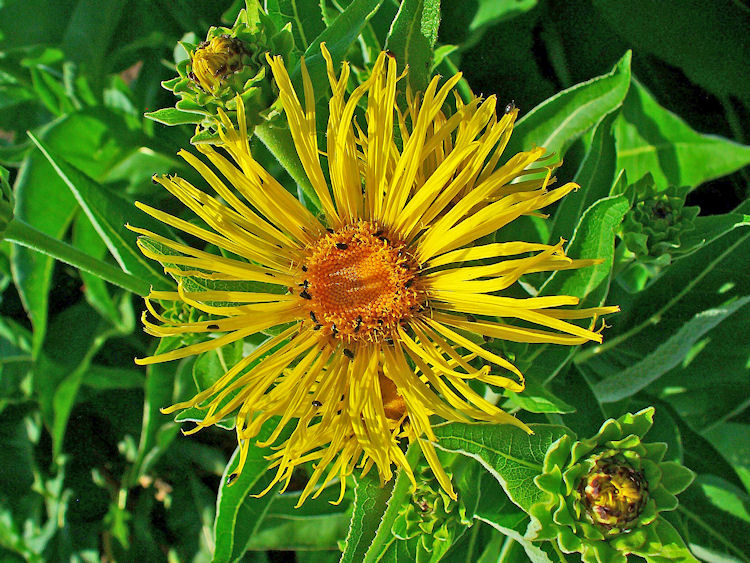
Abb.: Inula helenium L. 1753 -
Echter Alant - Elacampane
[Bildquelle: H. Zell / Wikimedia. -- GNU FDLicense]
"INULA HELENIUM, Linn.
Fig.—Woodville Med. Bot. t. 20 ; Bentl. and Trim. 150.
Elecampane
Hab.—Central Asia, Central and Southern Europe.
History, Uses, &c.—All the Indian Mahometan writers on Materia Medica mention this drug under the names of Rāsan, Kust-i-shāmi, or Zan jabil-i-shāmi, i.e. Syrian Costus or Syrian ginger. Rāsan is a Persian name for the plant which has been adopted by the Arabs. From the Burhān-i-Kalia we learn that the plant is also known in Persia as Pil-gush (elephant's ear), and Gharsa, and is useful for eruptions and all kinds of pains, especially those arising from chill, bites of animals, &c. Elecampane is the ελενιον of the Greeks, and is described by Hippocrates as a stimulant of the brain, stomach, kidneys and uterus; it is the Inula of the Romans and the Enula campana of mediaeval writers, and was formerly much used in pectoral affections, such as cough and asthma, and in acid dyspepsia, rheumatism, &c. ; an ointment made with it was used to cure itch. It is still a domestic remedy in France and Germany, and to a less extent in England, and the root holds a place in the Pharmacopoeias of Germany, France and the United States of America. The root is preserved as a pectoral candy on the continent of Europe, and is used in France in the preparation of absinthe. Of late years the active principle, helenin, has been introduced into medical use, and is said to possess remarkable antiseptic properties; it is recommended as a gargle in ozaena and internally in diseases of the respiratory organs for reducing inflammation. It is said to speedily relieve chronic bronchitis, and has also been employed in anthrax and acid dyspepsia. Korab claims for helenin a power of destroying bacilli (Bul., de Therap. ciii. 271). The dose of this principle is from 1/6 to 1/2 of a grain.
It is imposible to determine whether Elecampane was known to the ancient Hindus, but the old Persian name Rāsan leads us to suspect that it was possibly the original Rāsna of the Hindu Materia Medica, although entirely different roots are now in use under that name. It is significant that Gandhamūla, i.e. "aromatic root, " is a synonym for the rāsna of the Nighantas, whilst the roots actually in use are not aromatic; the properties also attributed to these roots in the same books are those of Elecampane and not of the inert roots now in use in the plains of India."
[Quelle: Pharmacographia indica : a history of the principal drugs of vegetable origin met with in British India / by William Dymock [1834-1892], C. J. H. Warden and David Hooper [1858-1947]. -- Bd. 2. -- London, 1891. -- S. 259f.]
"Inula racemosa, Hook. f., a native of the Western Himalayas and Cashmere, is used in veterinary medicine in those parts, as a tonic and stomachic; its roots closely resemble in properties those of I. Helenium."
[Quelle: Pharmacographia indica : a history of the principal drugs of vegetable origin met with in British India / by William Dymock [1834-1892], C. J. H. Warden and David Hooper [1858-1947]. -- Bd. 2. -- London, 1891. -- S. 260.]
Mimosa rubicaulis Lam. 1783
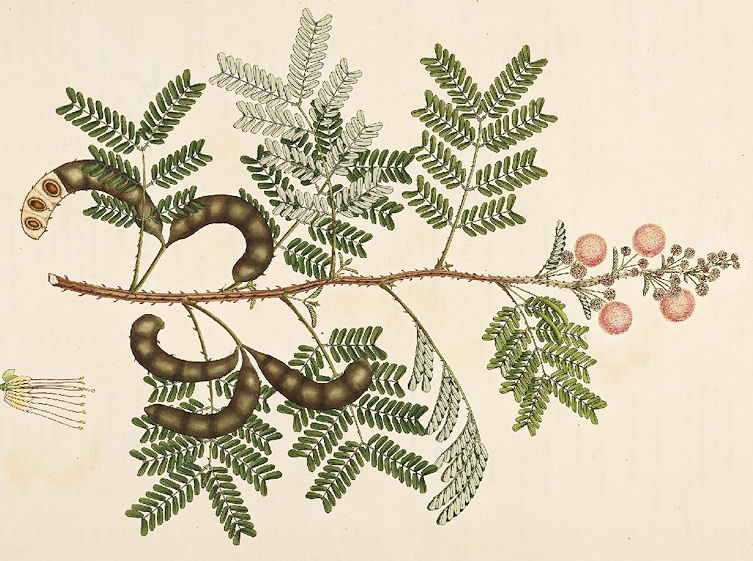
Abb.: Mimosa rubicaulis Lam. 1783 [Roxb.: Mimosa
octandra]
[Bildquelle: Roxburgh. -- Vol II. -- 1795. -- Tab. 200. -- Image courtesy Missouri Botanical Garden.
http://www.botanicus.org. --
Creative Commons Lizenz
(Namensnennung, keine kommerzielle Nutzung)]
"Mimosa rubicaulis is a shrub belonging to Fabaceae and subfamily Mimosoideae. It is bipinnately compound, each leaf having 8-12 pairs of pinnae, each with 16-20 pairs of pinnules, unlike Mimosa pudica which has at most two prickly pairs of leaflets. It is found across India." [Quelle: http://en.wikipedia.org/wiki/Mimosa_rubicaulis. -- Zugriff am 2011-01-11]
Alpinia nigra (Gaertn.) B. L. Burtt 1977 (= Alpinia allughas (Retz.) Roscoe 1807)
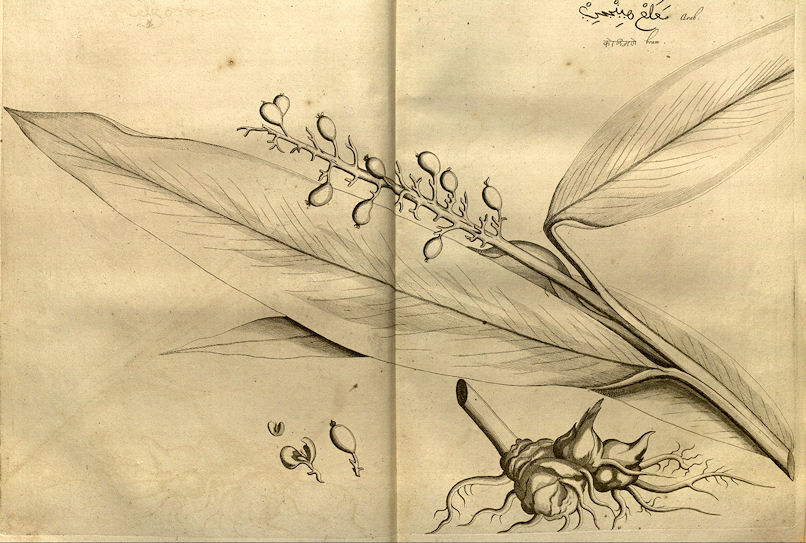
Abb.: Alpinia nigra (Gaertn.) B. L. Burtt 1977 (=
Alpinia allughas (Retz.) Roscoe 1807)
[Bildquelle: Hortus malabaricus XI. Fig.
14,
1692]
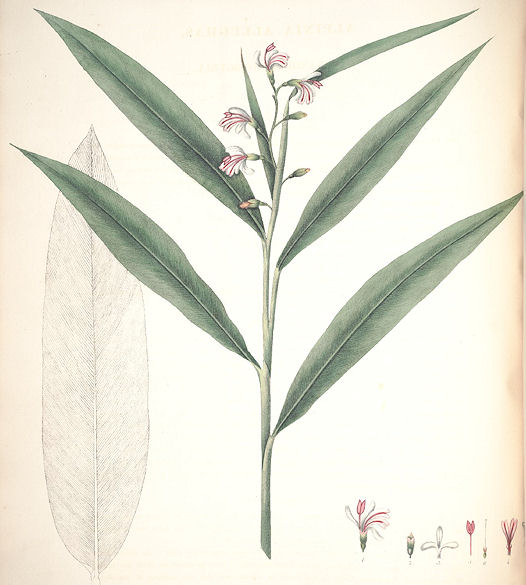
Abb.: Alpinia nigra (Gaertn.) B. L. Burtt 1977 (=
Alpinia allughas (Retz.) Roscoe 1807)
[Bildquelle: Monandrian plants of the order Scitamineae :
chiefly drawn from living specimens in the botanic garden at Liverpool, arranged
according to the system of Linnaeus with descriptions and observations / by
William Roscoe. -- Liverpool, 1828.]
"Alpinia nigra est une espèce de plantes de la famille des Zingiberaceae. Cette espèce est d'origine asiatique : Chine, Bhoutan, Inde, Sri Lanka et Thaïlande. Elle est parfois cultivée ailleurs.
Sa pseudo-tige peut atteindre 2 à 3 mètres. Ses feuilles sont sessiles et peuvent mesurer jusqu'à 40 cm de long pour une largeur de 8 cm.
Elle croît généralement en milieu forestier, vers 1 000 m d'altitude.
Son rhizome est recherché en médecine traditionnelle chinoise.
Synonymes: Zingiber nigrum Gaertn., Heritiera allughas Retz., Alpinia allughas (Retz.) Roscoe"[Quelle: http://fr.wikipedia.org/wiki/Alpinia_nigra. -- Zugriff am 2010-01-11]
Oxalidaceae (Sauerkleegewächse)
|
6. a./b. cāṅgerī cukrikā dantaśaṭāmbaṣṭhāmlaloṇikā चाङ्गेरी चुक्रिका दन्तशटाम्बष्ठाम्ललोणिका ।६ क। [Bezeichnungen für Oxalis corniculata L. 1753 - Hornfrüchtiger Sauerklee - Yellow Sorrel:]
|
Colebrooke (1807): "Wood Sorrel. Oxalis monadelpha, Roxb."
1 अम्बष्ठा - ambaṣṭhā f.: Aṃbaṣtherin
ambaṣṭha m.: ein Volksstamm; auch: Angehöriger einer Mischkaste: Vater Brahmane + Mutter Vaiśya
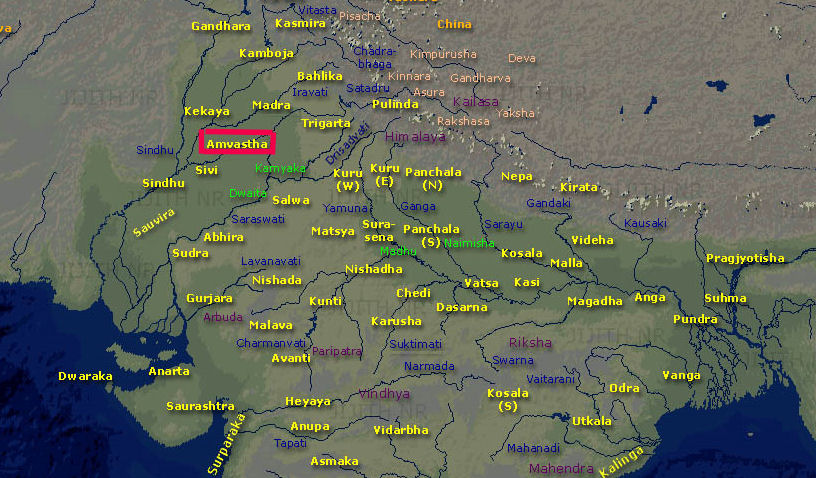
Abb.: Wohngebiet der Ambaṣṭha
[Bildquelle: JIJITH NR / Wikipedia. -- GNU
FDLicense]
2 अम्ललोणिका - amlaloṇikā f.: Sauer-Loṇikā, Sauer-Portulak
loṇī f. = Portacula quadrifida L. 1767 - Chickenweed & Portacula oleracea L. 1753 - Portulak
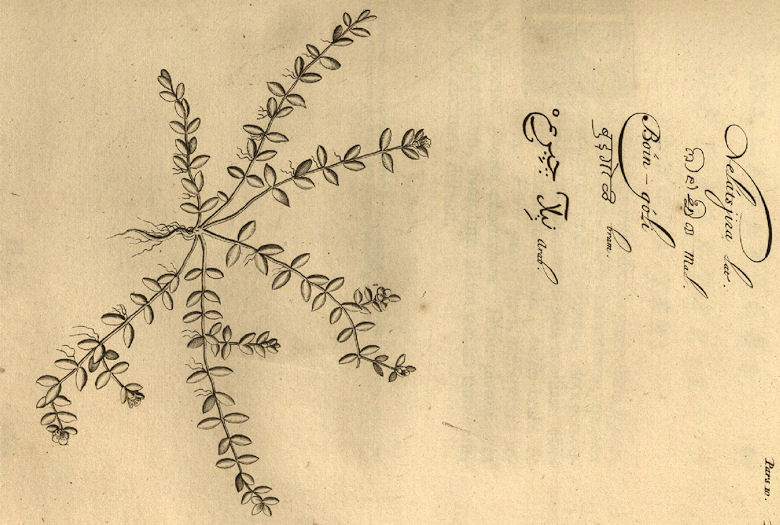
Abb.: Portacula quadrifida L. 1767 - Chickenweed
[Bildquelle: Hortus malabaricus X. Fig.
31, 1690]
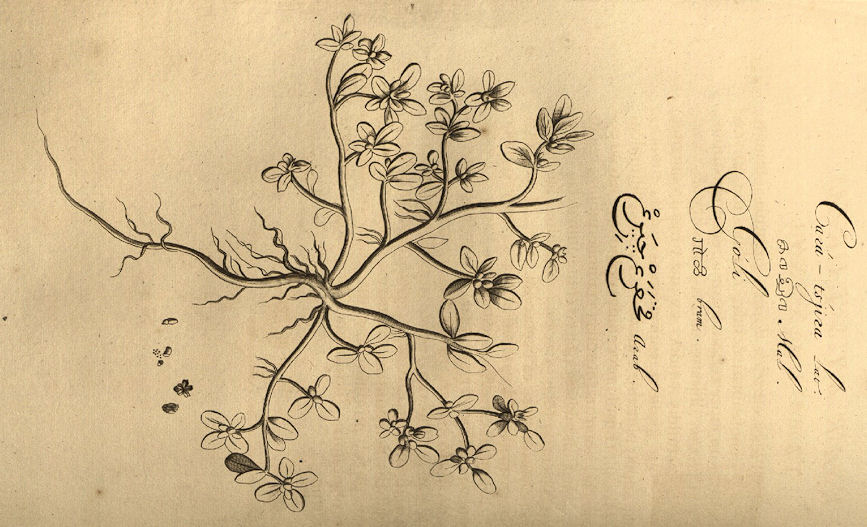
Abb.: Portacula oleracea L. 1753 - Portulak
[Bildquelle: Hortus malabaricus X. Fig.
36, 1690]
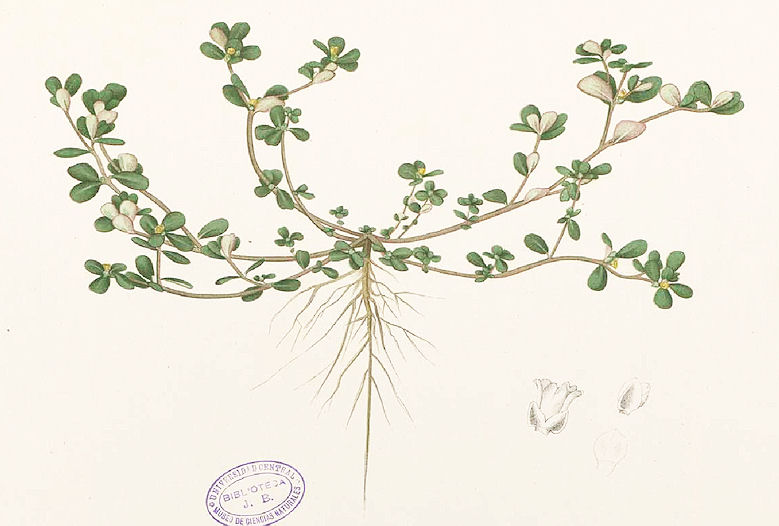
Abb.: Portacula oleracea L. 1753 - Portulak
[Bildquelle: Flora de Filipinas, 1880 / Wikimedia. -- Public domain]
Oxalis corniculata L. 1753 - Hornfrüchtiger Sauerklee - Yellow Sorrel
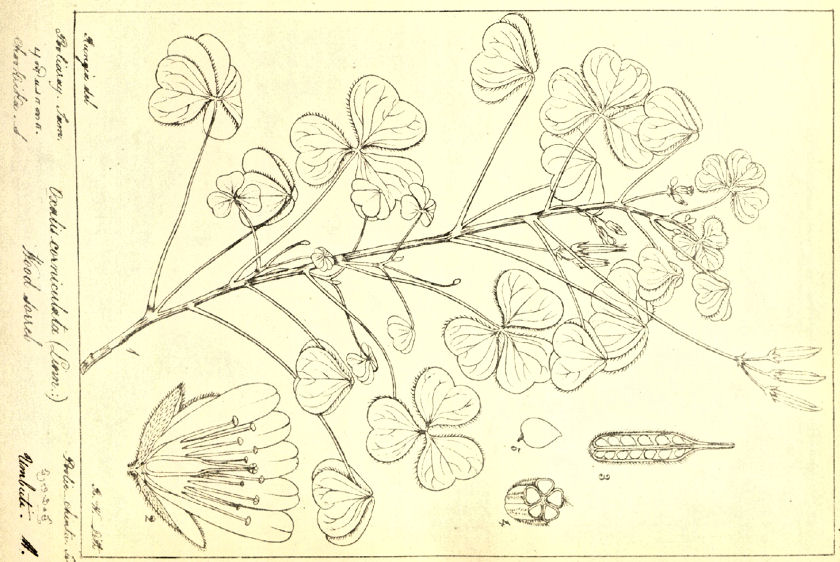
Abb.: Oxalis corniculata L. 1753 -
Hornfrüchtiger Sauerklee - Yellow Sorrel
[Bildquelle: Wight Icones I, Tab. 18, 1840]
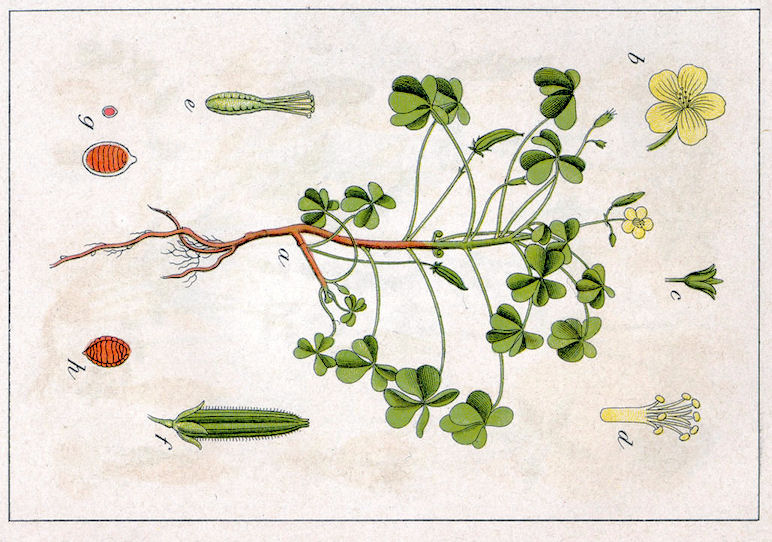
Abb.: Oxalis corniculata L. 1753 -
Hornfrüchtiger Sauerklee - Yellow Sorrel
[Bildquelle: Jacob Sturm 1796 / Wikimedia. -- Public domain]
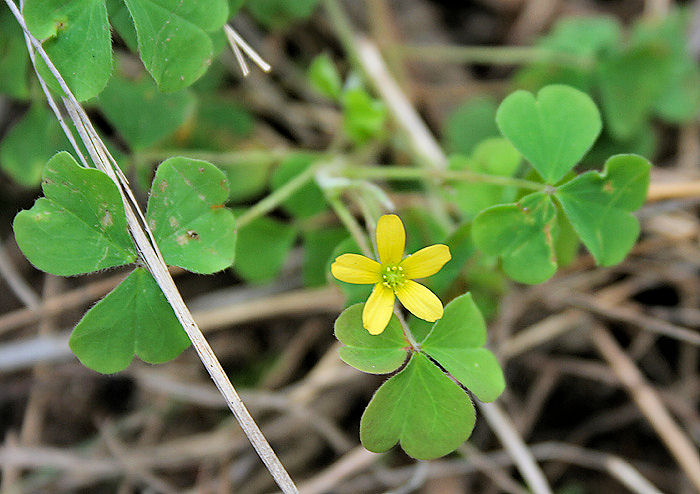
Abb.: Oxalis corniculata L. 1753 -
Hornfrüchtiger Sauerklee - Yellow Sorrel, Talakona (తలకోన) Forest, Andhra Pradesh
[Bildquelle: J. M. Garg / Wikimedia. -- GNU FDLicense]
"Oxalis corniculata (Linn.) N. O. Oxalidaceae. Yellow Wood-sorrel [...]
Description. — [...] flowers yellow.
Fl. Nearly all the year.
W. & A. Prod. i. 142.— Roxb. Fl. Ind. ii. 457.— Wight Icon. i. t. 18.
Common everywhere. Base of the Himalaya.
Medical Uses.—The leaves, stalks, and flowers are used by the Hindoos as cooling medicines, especially in dysentery.—(Ainslie.) It contains salts of oxalic acid, and acts as a refrigerant in fevers, as well as an antiscorbutic. Its juice may be used to remove ink-spots, as it rapidly dissolves most compounds of iron. It is used externally to remove warts, and fibres over the cornea.—(Powell's Punj. Prod.) The O. sensitiva, is reckoned tonic in Java.—Ainslie."
[Quelle: Drury, Heber <1819 - 1872>: The useful plants of India : with notices of their chief value in commerce, medicine, and the arts. -- 2d ed. with additions and corrections. London : Allen, 1873. -- xvi, 512 p. ; 22 cm. -- s.v.]
"OXALIS CORNICULATA, Linn.
Fig.—Wight Ic. t, 4. 18; Fl. Graec, t. 451.
Horned Wood-Sorrell
Hab.—A weed of cultivation, Asia, Europe, &c.
[...]
History, Uses, &c.-This plant, called in Sanskrit works Amlalonika and Chāngerī, is considered by the Hindus to be cooling, refrigerant, and stomachic. The fresh juice is given to relieve intoxication from Datura, and is said to be useful in dysentery and prolapsus of the rectum. (Hindu Materia Medica, Dutt.) Chakradatta gives the following formula for preparing a ghrita with the herb : Chāngerī ghrita—Take of clarified butter 4 seers, curdled milk (dadhi) 16 seers, leaves of Oxalis comiculata beaten into a paste 1 seer. Boil together in the usual way, and prepare a ghrita. The fresh herb made into a poultice with hot water is used as a healing application to various eruptions in the Madras Presidency. In the Concan the plant is rubbed down with water, boiled, and the juice of white onions added : this mixture is applied to the head in bilious headache. Mahometan writers briefly notice the plant as being used by the Hindus. Ainslie describes it, and mentions it use as a cooling medicine in doses of two teaspoonfuls twice a day. The plant is a native of Europe, and is called μοσχοφιλο in modern Greek. In Reunion it is considered a laxative, and is called Petit trèfle.
Description —O. corniculata is one of the most troublesome garden weeds in India;"
[Quelle: Pharmacographia indica : a history of the principal drugs of vegetable origin met with in British India / by William Dymock [1834-1892], C. J. H. Warden and David Hooper [1858-1947]. -- Bd. 1. -- London, 1890. -- S. 246f.]
Clusiaceae
|
6. c./d. sahasravedhī cukro 'mlavetasaḥ śatavedhy api सहस्रवेधी चुक्रो ऽम्लवेतसः शतवेध्य् अपि ॥६ ख॥ [Bezeichnungen für Garcinia pedunculata Roxb. ex Buch.-Ham. 1827:]
|
Colebrooke (1807): "Sorrel [= Rumex acetosa L. - Sauerampfer]. Other interpretations are also stated by commentators."
1 अम्लवेतस - amlavetasa m.: Sauer-Vetasa
vetasa m. = Salix caprea L. 1753 - Sal-Weide - Goat Willow, oder: Calamus tenuis Roxb. - Rotang: Siehe II.1. Vers 10
Garcinia pedunculata Roxb. ex Buch.-Ham. 1827
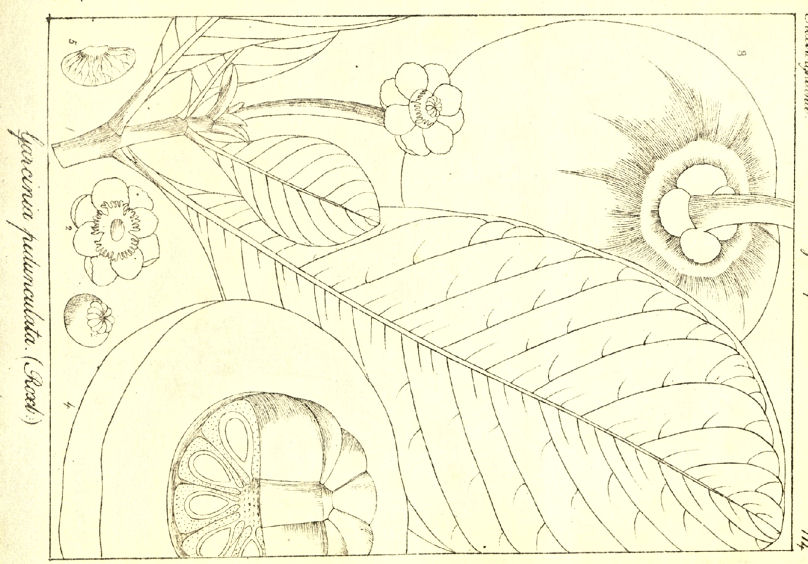
Abb.: सहस्रवेधी
। Garcinia pedunculata Roxb.
ex Buch.-Ham. 1827
[Bildquelle: Wight Icones I, Tab. 114, 1840]
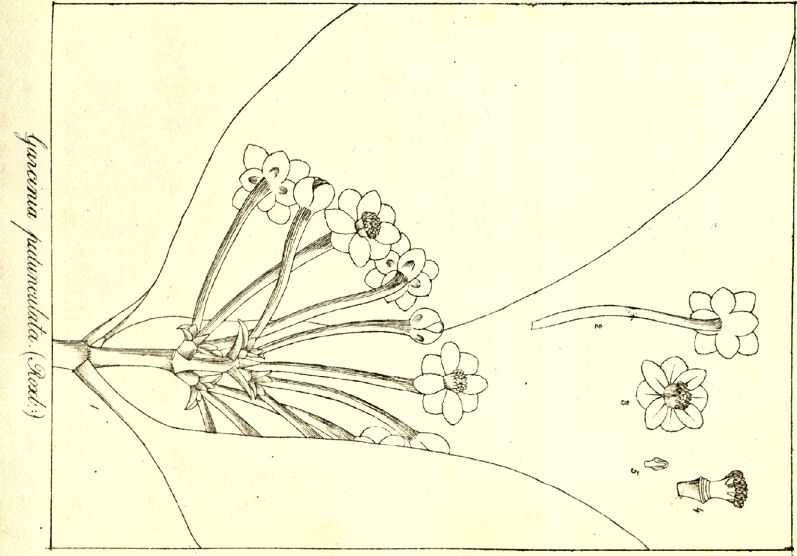
Abb.: Garcinia pedunculata Roxb.
ex Buch.-Ham. 1827
[Bildquelle: Wight Icones I, Tab. 115, 1840]
"Garcinia pedunculata (Roxb.) [...]
Description.—Tree, 60 feet; [...]
Fl. Jan.—March.
Roxb. Fl. Ind. ii. 625.—Wight's Ill. i. 125.—Icon, t. 114, 115.
Rungpore.
Economic Uses.—The fruit of this species of Garcinia ripens about April or May. It is very large, about 2 lb. weight, of a rich yellow colour when ripe, and exceedingly acid to the taste. Each seed is enclosed in its own proper aril, within which is generally found a soft yellow resin. The fleshy part of the fruit has a sharp, pleasant, acid taste. It is used by the natives in their curries, and for acidulating water. If cut into slices and dried it retains its qualities for years, and might possibly be used to advantage during long sea-voyages as a substitute for limes, or put into various messes where salt meat is employed.—Roxb.
One of the most delicious fruits, the Mangosteen, is produced by a tree of this order (Garcinia mangostana, Linn.), growing in the Eastern Archipelago. The white delicate pulp which surrounds the seeds has been aptly likened by Sir E. Tennent to "perfumed snow." The tree has been successfully grown and the fruit ripened at Courtallum; but it requires great care, and the fruit never acquires the size and flavour it has in its native country.—(Pers. Obs.) The fleshy pericarp is a valuable astringent. It contains tannin, resin, and a crystallisable principle. It has been successfully employed in the advanced stages of dysentery and in chronic diarrhoea. Dr Waitz (Diseases of Children in Hot Climates, p. 164) recommends a strong decoction as an external astringent application in dysentery. —Pharm. of India."
[Quelle: Drury, Heber <1819 - 1872>: The useful plants of India : with notices of their chief value in commerce, medicine, and the arts. -- 2d ed. with additions and corrections. London : Allen, 1873. -- xvi, 512 p. ; 22 cm. -- s.v.]
Rumex acetosa L. - Sauerampfer - Sorrel
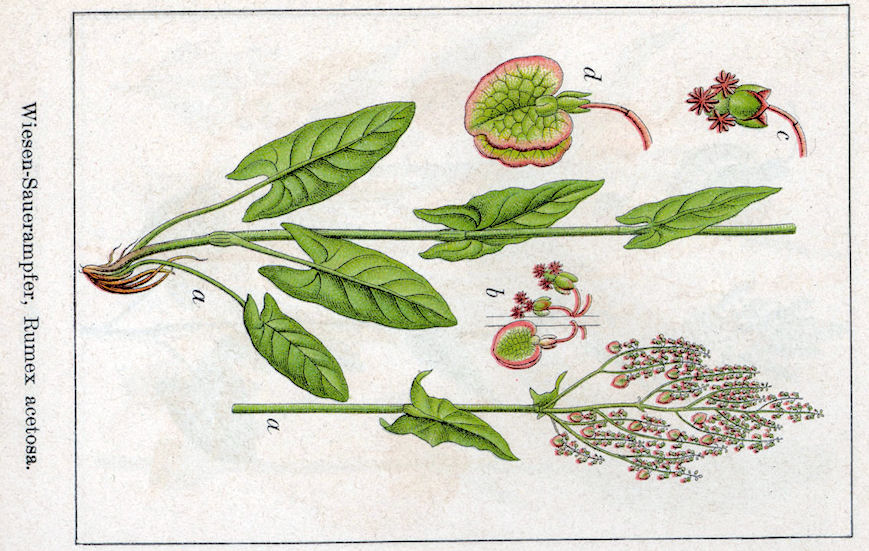
Abb.: Rumex acetosa
L. - Sauerampfer - Sorrel
[Bildquelle: Sturm, 1796 / Wikimedia. -- Public domain]
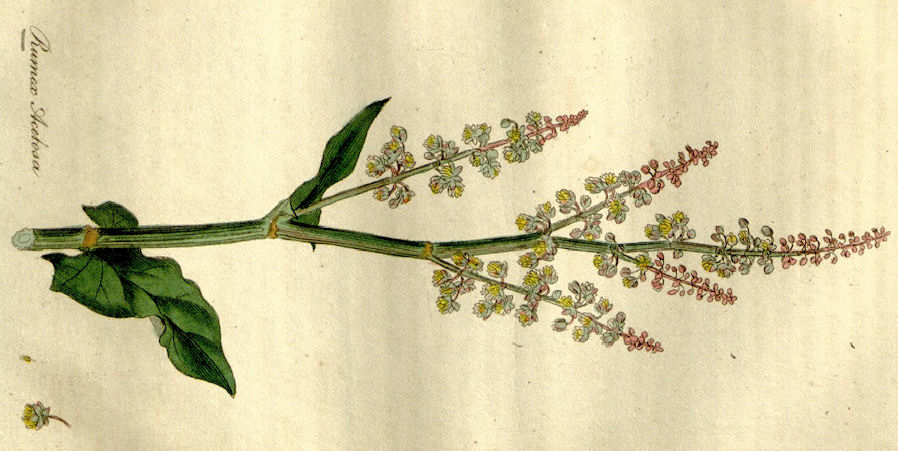
Abb.: Rumex acetosa
L. - Sauerampfer - Sorrel
[Bildquelle: Medical botany : containing
systematic and general descriptions, with plates of all the medicinal plants,
comprehended in the catalogues of the materia medica, as published by the Royal
Colleges of Physicians of London, Edinburgh, and Dublin, together with the
principal medicinal plants not included in those pharmocopoeias, accompanied
with a circumstantial detail of their medicinal effects, and of the diseases in
which they have been most successfully employed / by William Woodville. --
London, 1842. -- Vol 4, Tab. 230.]
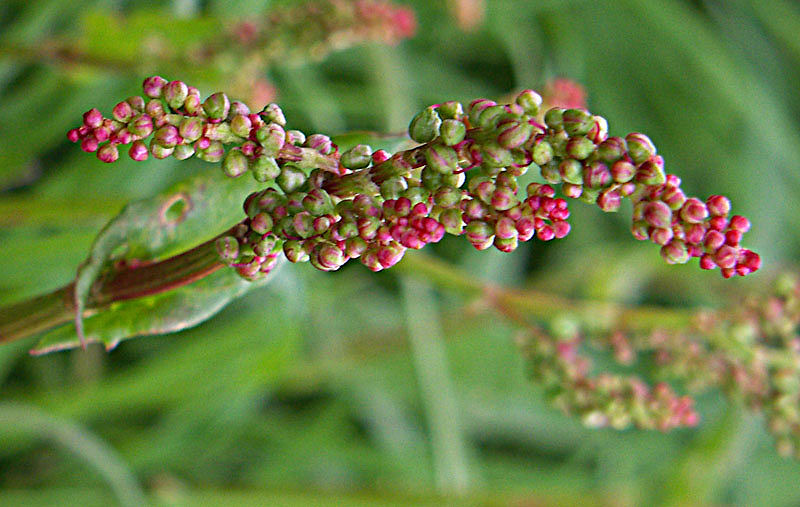
Abb.: Rumex acetosa
L. - Sauerampfer - Sorrel, Blüte, Deutschland
[Bildquelle: Steffen Heinz / Wikimedia. -- GNU FDLicense]
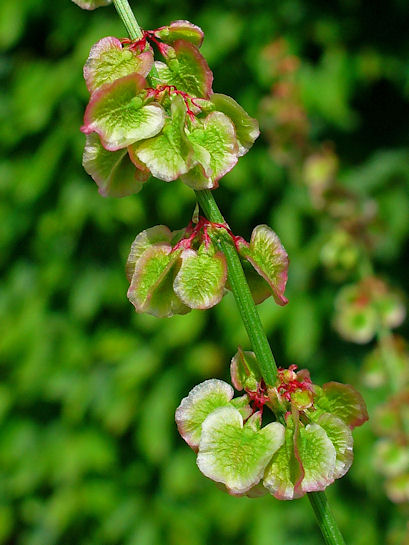
Abb.: Rumex acetosa
L. - Sauerampfer - Sorrel, Frucht, Deutschland
[Bildquelle: H. Zell / Wikimedia. -- GNU FDLicense]
"Common sorrel or garden sorrel (Rumex acetosa), often simply called sorrel and also known as spinach dock or narrow-leaved dock, is a perennial herb that is cultivated as a garden herb or leaf vegetable (pot herb). Growth
Sorrel is a slender plant about 60 cm high, with roots that run deep into the ground, as well as juicy stems and edible, oblong leaves. The lower leaves are 7 to 15 cm in length, slightly arrow-shaped at the base, with very long petioles. The upper ones are sessile, and frequently become crimson. The leaves are eaten by the larvae of several species of Lepidoptera (butterfly and moth) including the blood-vein moth.
CharacteristicsIt has whorled spikes of reddish-green flowers, which bloom in summer, becoming purplish. The stamens and pistils are on different plants (dioecious); the ripe seeds are brown and shining.
UsesCommon sorrel has been cultivated for centuries. The leaves may be puréed in soups and sauces or added to salads and shay; they have a flavor that is similar to kiwifruit or sour wild strawberries. The plant's sharp taste is due to oxalic acid, which is a poison. In small quantities sorrel is harmless; in large quantities it can be fatal[1].
In northern Nigeria, sorrel is known as yakuwa or sure (pronounced suuray) in Hausa or karassu in Kanuri. It is also used in stews usually in addition to spinach. In some Hausa communities, it is steamed and made into salad using kuli-kuli (traditional roasted peanut cakes with oil extracted), salt, pepper, onion and tomatoes. The recipe varies according to different levels of household income. A very refreshing drink called sob'o is made from a decoction of the plant calyx. Recent research though inconclusive indicates that this drink may be effective in lowering blood pressure.
In Russia and Ukraine it is called shchavel' (щавель) and is used to make soup. It is used as a soup ingredient in other countries, too (e.g., Lithuania, where it is known as rūgštynė). In Hungary this is known as soska [ pronounced Shoshka]. It is called kuzu kulağı in Turkish. In Polish it is called szczaw. (pronounced /ʂʈʂav/)
Among Northern Sami it is known as juopmu and was traditionally added to reindeer milk as a flavoring and preservative.
In parts of Belgium it is served mixed with mashed potatoes, or as part of a traditional dish containing eel and other green herbs.
In rural Greece it is used with spinach, leeks, and chard in spanakopita."
[Quelle: http://en.wikipedia.org/wiki/Sorrel. -- Zugriff am 2011-01-11]
Mimosaceae (Mimosengewächse)
|
7. a./b. namaskārī gaṇḍakārī samaṅgā khadirīty api नमस्कारी गण्डकारी समङ्गा खदिरीत्य् अपि ।७ क। [Bezeichnungen für Mimosa pudica L. 1753 - Rühr-mich-nicht-an - Touch-me-not:]
|
Colebrooke (1807): "A sensitive plant. Some make those four and the preceding five terms synonymous, as names of a sensitive plant. Others refer this line to the Lycopodium imbricatum (Roxb.)."
1 नमस्कारी - namaskārī f.: die Blätter wie Hände bei der Begrüßung (namaskāra) Zusammenlegende

Abb.: Namaskāra
[Bildquelle: Oct11988duh / Wikipedia. -- Public domain]
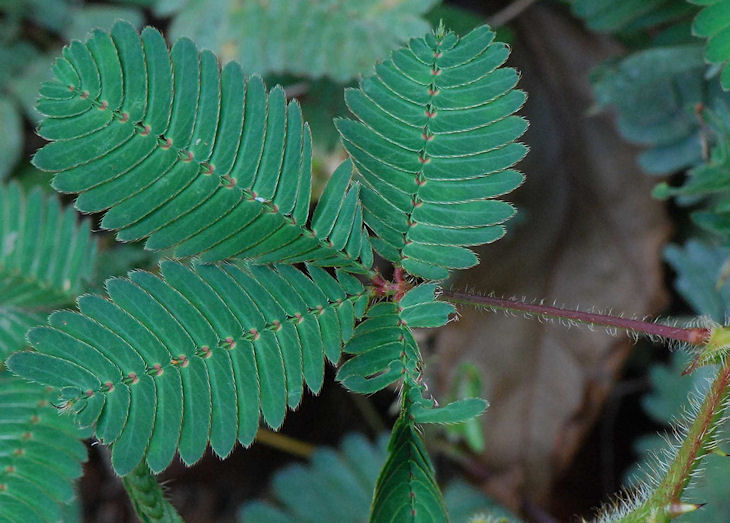
Abb.: नमस्कारी
। Mimosa pudica L. 1753 -
Rühr-mich-nicht-an - Touch-me-not, vor Berührung
[Bildquelle: Pancrat / Wikimedia. -- GNU
FDLicense]
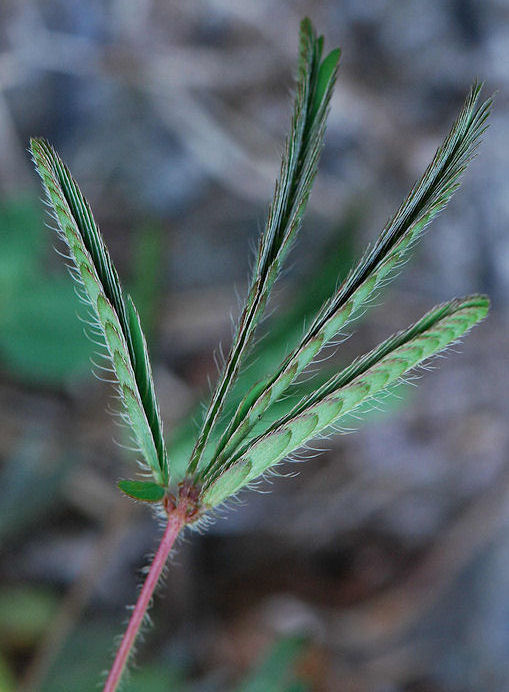
Abb.: नमस्कारी
। Mimosa pudica L. 1753 -
Rühr-mich-nicht-an - Touch-me-not, nach Berührung
[Bildquelle: Pancrat / Wikimedia. -- GNU
FDLicense]
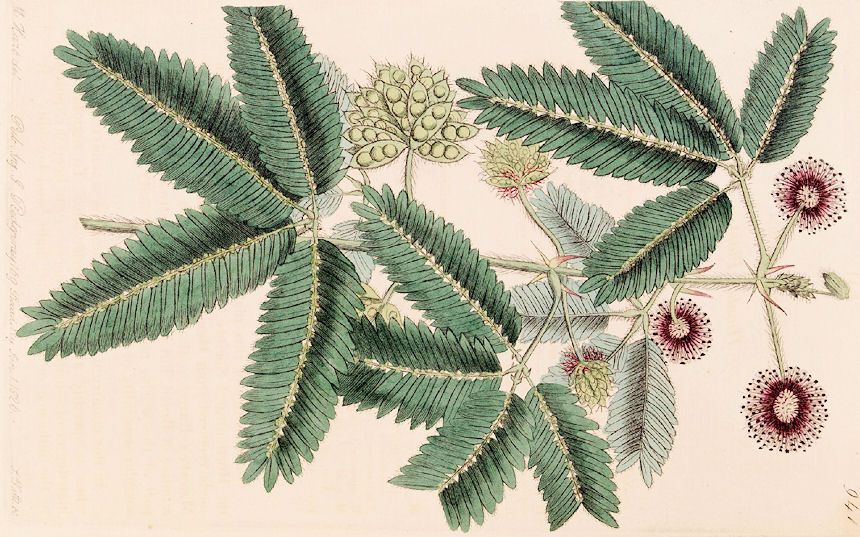
Abb.: Mimosa pudica L. 1753 -
Rühr-mich-nicht-an - Touch-me-not
[Bildquelle: The Botanical register, v. 11 (1825), Pl. 941.]
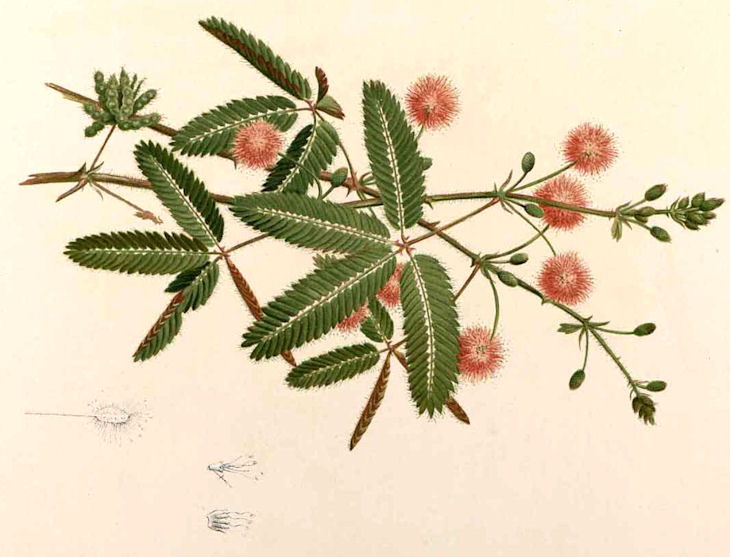
Abb.: Mimosa pudica L. 1753 - Rühr-mich-nicht-an -
Touch-me-not
[Bildquelle: Flora de Filipinas, 1880 / Wikipedia. -- Public domain]
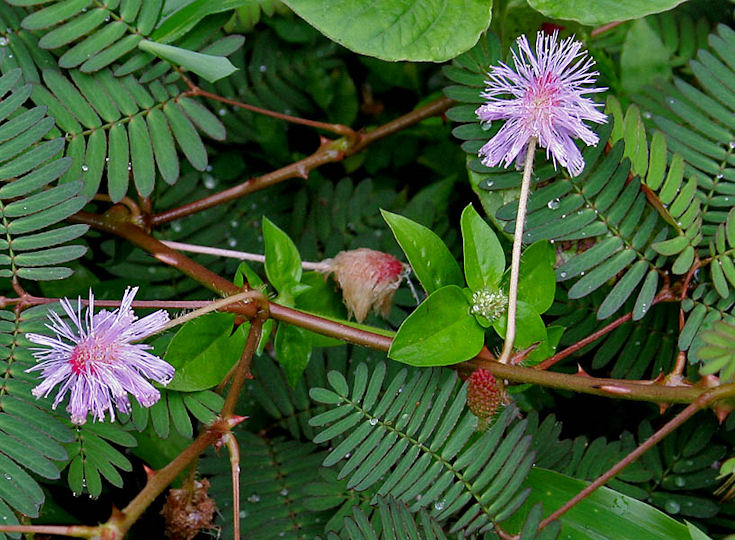
Abb.: Mimosa pudica L. 1753 -
Rühr-mich-nicht-an - Touch-me-not, Goa
[Bildquelle: J. M. Garg / Wikimedia. -- GNU FDLicense]
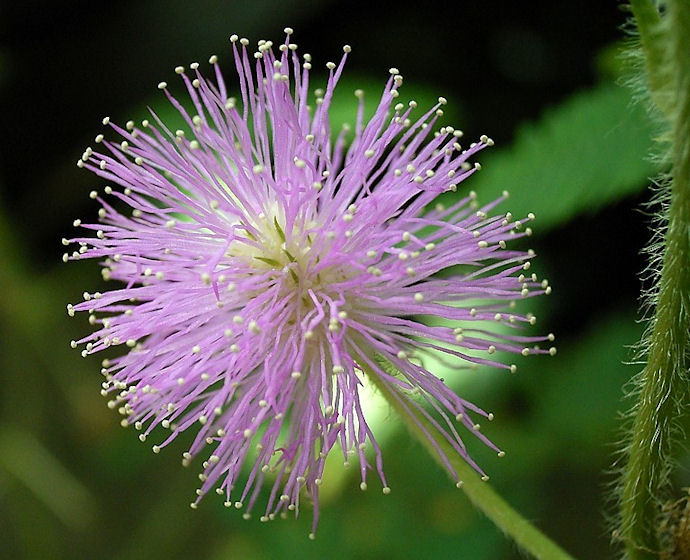
Abb.: Mimosa pudica L. 1753 -
Rühr-mich-nicht-an - Touch-me-not
[Bildquelle: Frank Vincentz / Wikimedia. -- GNU FDLicense]
"MIMOSA PUDICA, Linn.
Fig.—Bot. Reg. t. 544.
Sensitive plant (Eng.)
Hab.—Hotter parts of India, probably introduced from Tropical America.
[...]
History, Uses, &c.—An ative of Brazil long naturalized in India, and called in Sanskrit Khadiri and Anjalikarika, i.e., joining the hands in worship or prayer. Mir Muhammad Husain states that it is much valued as a medicine by the Indians, and is considered to be resolvent, alterative, and useful in diseases arising from corrupted blood and bile. The juice is also applied externally to fistulous sores. He says that at the time of the Pakhad Nahshatra, the Indian Mahometans resort to the places where the plant grows, wash, and offer some sweets and burn incense; they then gather the plant, taking care that the shadow of the gatherer does not fall upon it, and dry it in the shade : when the moon is again in the same Nakshatra, they powder it and mix about four grains with cow's milk, and say the following mantra seven times before they take it :—
(* This mantra appears to be a farrago of Arabic, Persian and Sanskrit of doubtful meaning.)
The medicine is taken every day for three weeks in the same manner,—in the first week all bilious diseases and fevers are supposed to be cured, in the second piles, jaundice, &c, and in the third leprosy, scabs and pox.
Ainslie, noticing its use in Southern India, says:—"A decoction of the root of this plant is considered on the Malabar Coast to be useful in gravellish complaints. The Vytians of the Coromandel side of India prescribe the leaves and root in cases of piles and fistula : the first are given in powder, in a little milk, to the quantity of two pagodas' weight or more during the day." (Mat. Ind. II., 432.) In the Concan the leaves are rubbed into a paste and applied to hydrocele ; and their juice with an equal quantity of horse's urine is made into an anjan which is used to remove films of the conjunctiva by setting up an artificial inflammation. In what is called cracked pot cough by the natives, the root is directed to be gathered on Sunday, wrapped in Bhojpatra (bark of Betula Bhojpatra), and tied with a string made of silk of five different colours; this packet is to be kept in the sun and tied upon the patient's neck at ebb tide. This is the commonest kind of sensitive plant, and is too well known to require description; it has an acid and pungent taste ; the root is fibrous.
Theophrastus (H. P. IV. 3.) mentions a sensitive plant called υλημα with pinnate leaves and spinous branches of which he says εαν τισ αφηται των κλονιων, τα φυλλα, ωσπερ αφαυαινομενα συμπιπται, ειτα μετα τινα χρονον αναβιασκει και θαλλει"
[Quelle: Pharmacographia indica : a history of the principal drugs of vegetable origin met with in British India / by William Dymock [1834-1892], C. J. H. Warden and David Hooper [1858-1947]. -- Bd. 1. -- London, 1890. -- S. 538f.]
Asclepiadaceae (Seidenpflanzengewächse)
|
7. c./d. jīvantī jīvanī jīvā jīvanīyā madhusravā जीवन्ती जीवनी जीवा जीवनीया मधुस्रवा ॥७ ख॥ [Bezeichnungen für Leptadenia reticulata (Retz.) W. & A. 1834:]
|
Colebrooke (1807): "Jīyatī. Celtis orientalis [L. 1753 = Trema orientalis (L.) Blume 1856 - Indian Charcoal Tree] ?"
Leptadenia reticulata (Retz.) W. & A. 1834
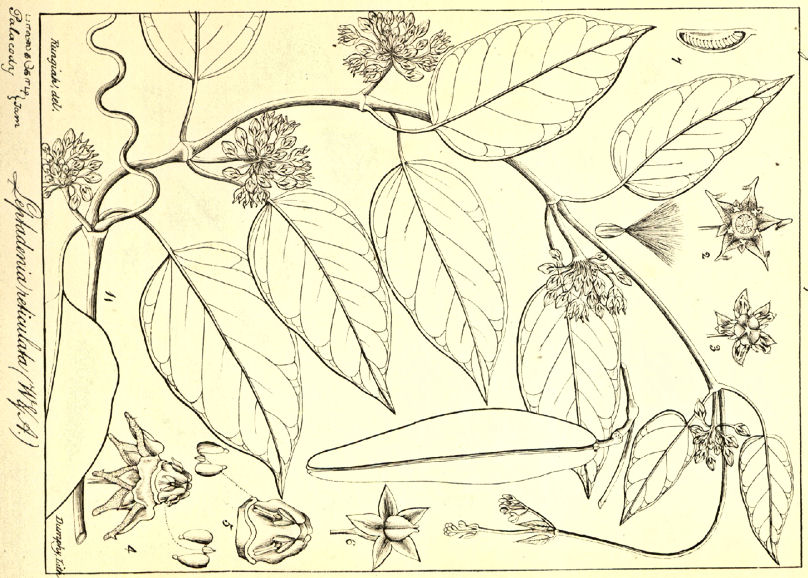
Abb.: Leptadenia reticulata (Retz.)
W. & A. 1834
[Bildquelle: Wight Icones II, Tab. 350, 1843]
Trema orientalis (L.) Blume 1856 - Indian Charcoal Tree
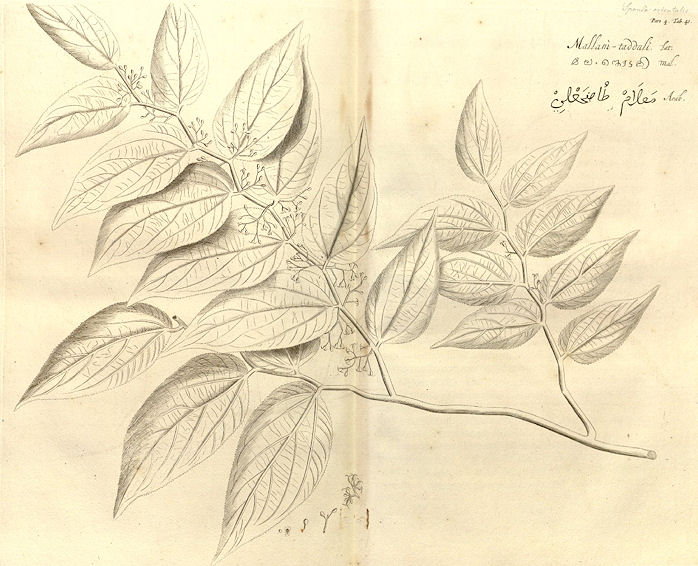
Abb.: Trema
orientalis (L.) Blume 1856 - Indian Charcoal Tree
[Bildquelle: Hortus malabaricus IV. Fig. 40, 1683]
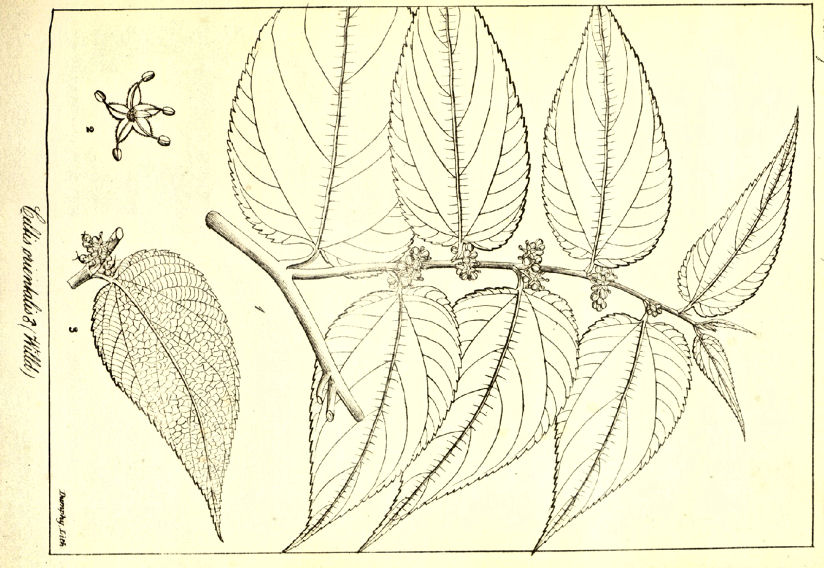
Abb.: Trema
orientalis (L.) Blume 1856 - Indian Charcoal Tree
[Bildquelle: Wight Icones II, Tab. 602, 1843]
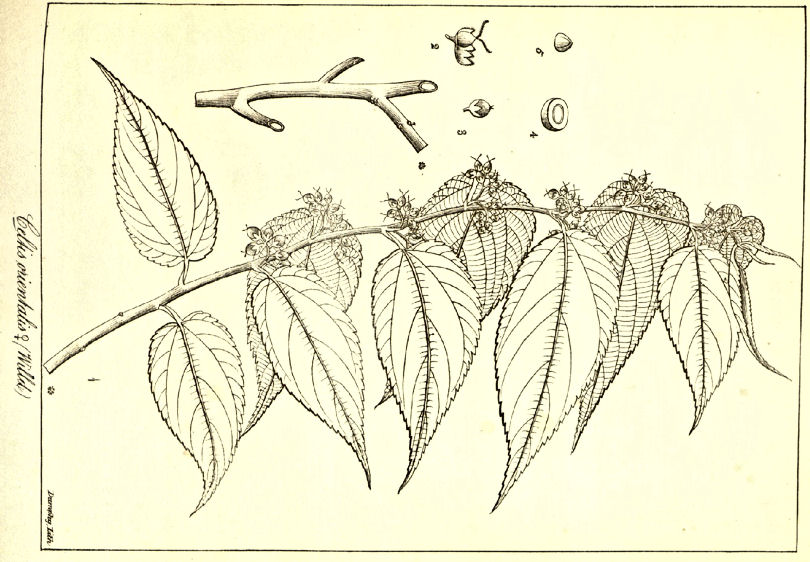
Abb.: Trema
orientalis (L.) Blume 1856 - Indian Charcoal Tree
[Bildquelle: Wight Icones II, Tab. 603, 1843]
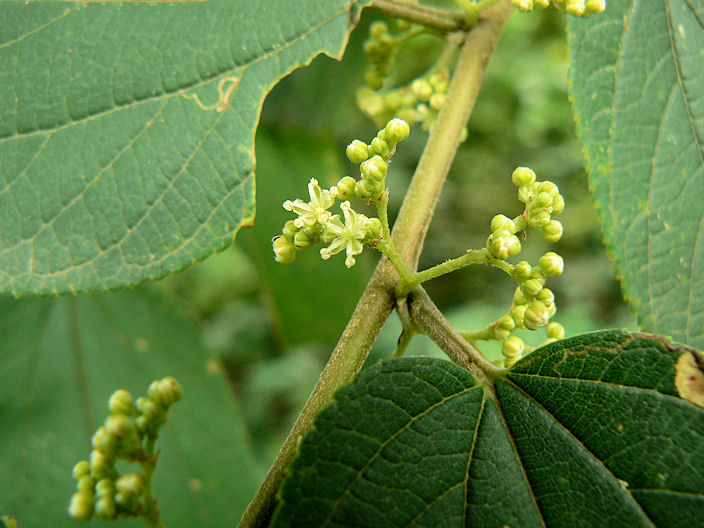
Abb.: Trema
orientalis (L.) Blume 1856 - Indian Charcoal Tree, Maharashtra
[Bildquelle: dinesh_valke. --
http://www.flickr.com/photos/dinesh_valke/1081309540/. -- Zugriff am
2010-12-01. --
Creative
Commons Lizenz (Namensnennung, keine kommerzielle Nutzung, keine
Bearbeitung)]
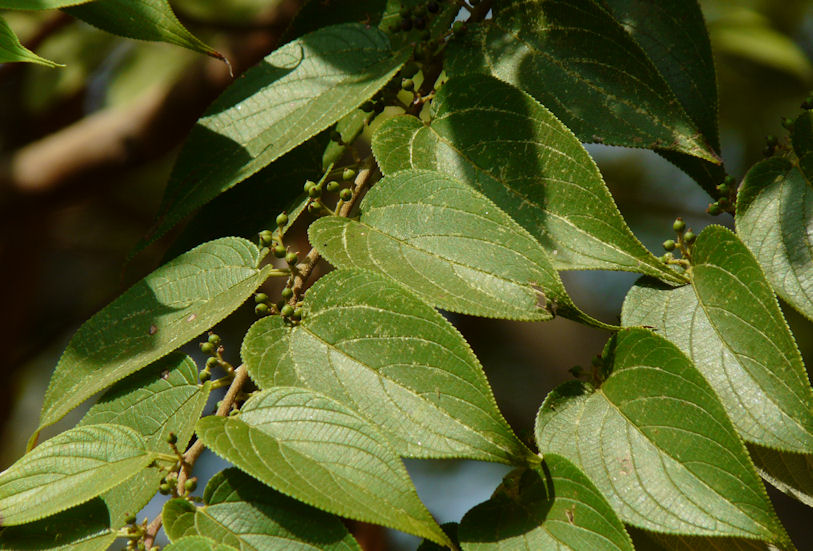
Abb.: Trema
orientalis (L.) Blume 1856 - Indian Charcoal Tree, Maharashtra
[Bildquelle: dinesh_valke. --
http://www.flickr.com/photos/dinesh_valke/3187243907/sizes/o/in/photostream/. -- Zugriff am
2010-12-01. --
Creative
Commons Lizenz (Namensnennung, keine kommerzielle Nutzung, share alike)]
"Trema orientalis is a species of flowering tree in the hemp family, Cannabaceae. It is found from South Africa to Tropical Africa and in warm regions of Asia. It is commonly called Pigeon Wood.[1] It has become naturalized in Hawaii where it is known as the Gunpowder Tree.[2] This tree is also known as Nalita.[3] General Use
The wood is relatively soft, and burns easily and quickly when dry. The wood is suitable for paper and pulp production,[4][5] producing paper with good tensile strength and folding endurance.[4] The bark can be used for making string or rope, and used as waterproofing fishing-lines.[1][6] In India and Tanzania, the wood is used to make charcoal.[6]
Medicinal UseThe tree has various traditional medicinal uses in a wide range of cultures.[1] The leaves and the bark are used to treat coughs, sore throats, asthma, bronchitis, gonorrhea, yellow fever, toothache, and as an antidote to general poisoning[4][7] A bark infusion is reportedly drunk to control dysentery and a leaf decoction is used to deworm dogs.[4] In recent pharmacological studies, an aqueous extract from the bark has been shown to reduce blood sugar levels in an experimental animal model of diabetes mellitus, and may be useful for treating this disease.[8] Extracts from leaves of related species (Trema guineense and Trema micrantha) showed anti-inflammatory, anti-arthritic and analgesic activity in rodents,[9] suggesting that T. orientalis could produce similar results.
[edit] Ecological SignificanceThis species has a high ecological impact with at least 14 species of butterfly using it as a larval food plant.[1] Several species of birds eat the fruit or feed on the abundant insects which live in these trees. Pigeons and doves are often found in these trees where they eat the fruits or make their nests; giving the origin of the name 'Pigeon Wood'.[1] The leaves, pods and seeds are used as fodder for cattle, buffaloes and goats in the Philippines.[4][7] The leaves are also browsed by game animals and can be used as spinach. This tree is a fast-growing species found in previously disturbed areas and on forest margins. It is a pioneer species that can grow on poor soil and can be used to regenerate forest areas by providing shade and protection to saplings of forest hardwoods. T. orientalis is nitrogen fixing and can thereby improve soil fertility for other plant species.[7]"
[Quelle: http://en.wikipedia.org/wiki/Trema_orientalis. -- Zugriff am 2011-01-10]
Arecaceae (Palmengewächse)
|
8. a./b. kūrcaśīrṣo madhurakaḥ śṛṅga-hrasvāṅga-jīvakāḥ कूर्चशीर्षो मधुरकः शृङ्ग-ह्रस्वाङ्ग-जीवकाः ।८ क। [Bezeichnungen für Cocos nucifera L. 1753 - Kokospalme - Coconut:]
|
Colebrooke (1807): "Jīvaca."
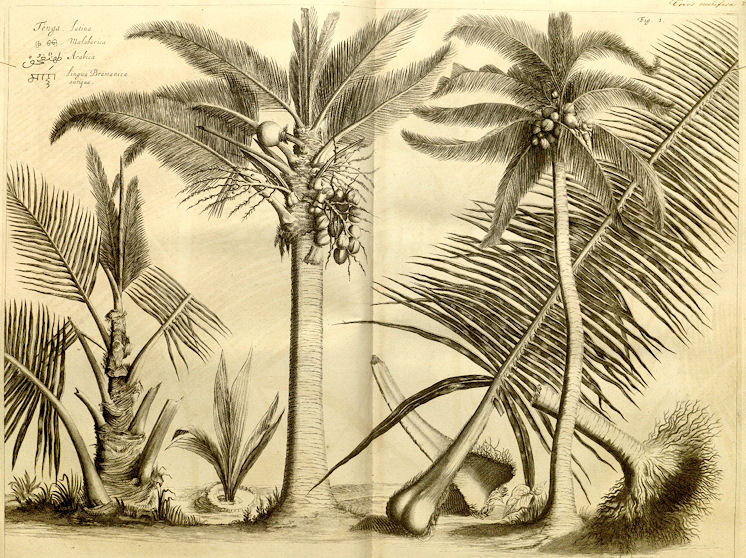
Abb.: कूर्चशीर्षः
। Cocos nucifera L. 1753 -
Kokospalme - Coconut
[Bildquelle: Hortus malabaricus I. Fig. 1,
1678]
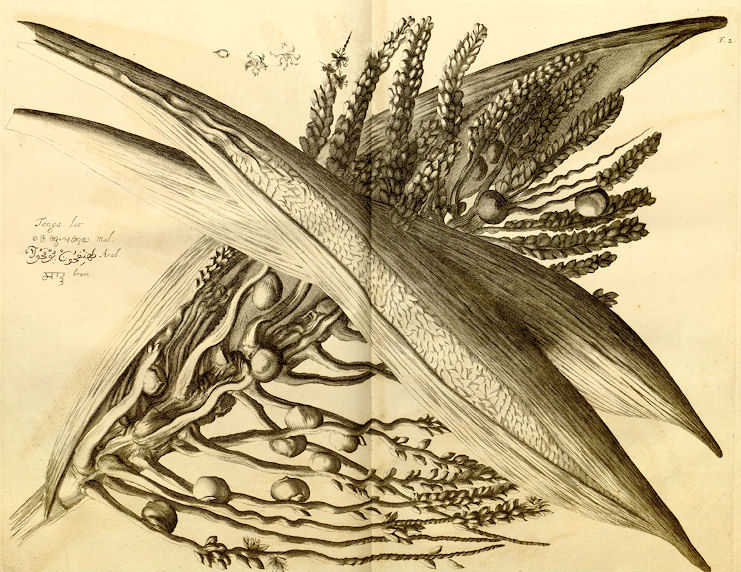
Abb.: Cocos nucifera L. 1753 -
Kokospalme - Coconut
[Bildquelle: Hortus malabaricus I. Fig. 2,
1678]
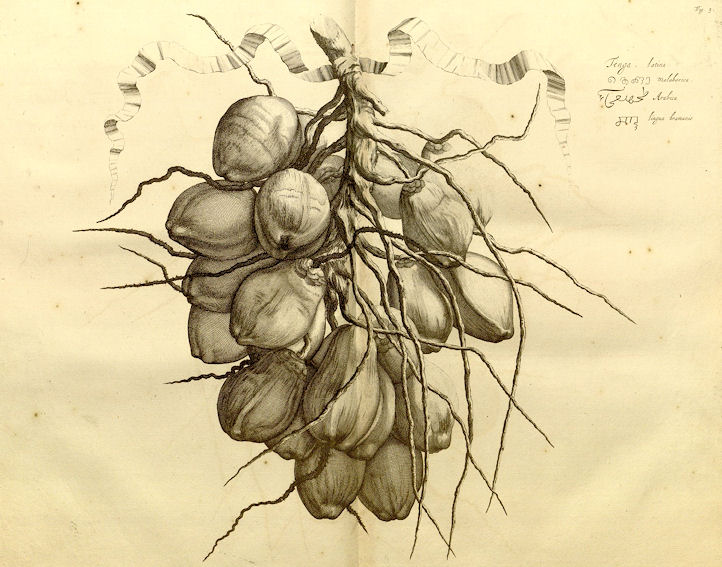
Abb.: Cocos nucifera L. 1753 -
Kokospalme - Coconut
[Bildquelle: Hortus malabaricus I. Fig. 3,
1678]
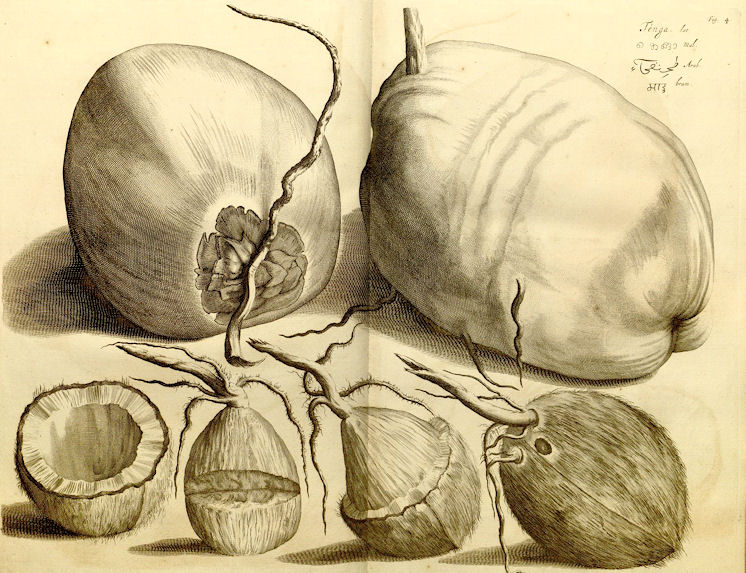
Abb.: मधुरकः । Cocos nucifera L. 1753 -
Kokospalme - Coconut
[Bildquelle: Hortus malabaricus I. Fig. 4,
1678]
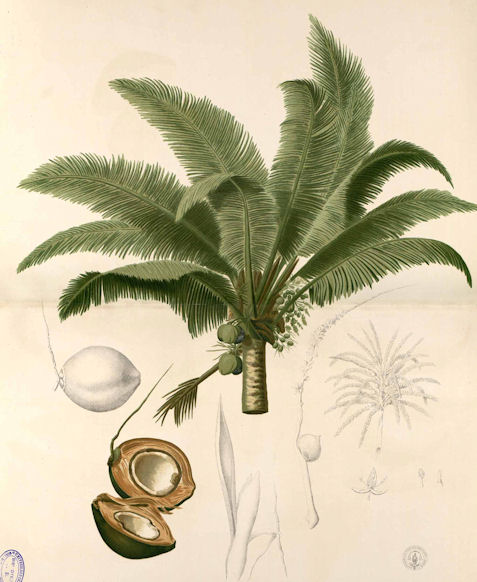
Abb.:
शृङ्गः । Cocos nucifera L. 1753 -
Kokospalme - Coconut
[Bildquelle: Flora de Filipinas, 1880 / Wikipedia. -- Public domain]
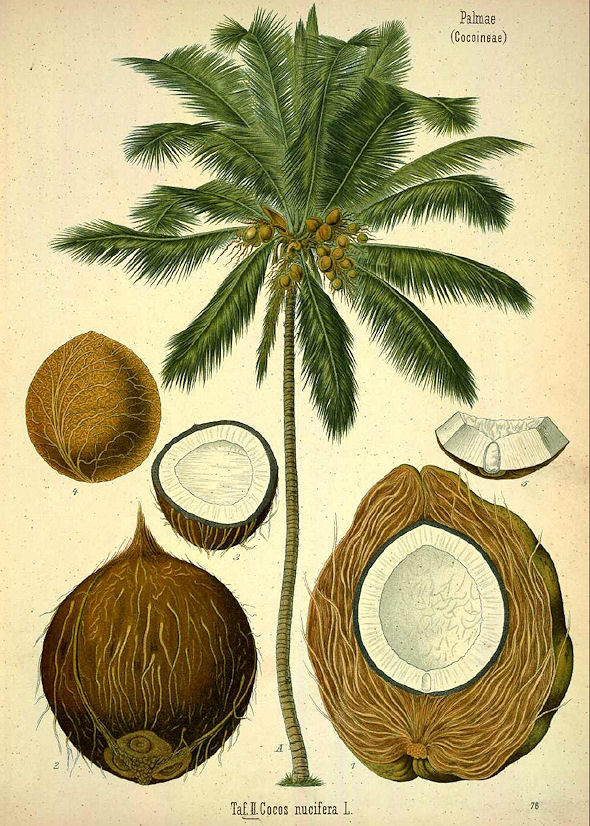
Abb.: मधुरकः
। Cocos nucifera L. 1753 -
Kokospalme - Coconut
[Bildquelle: Köhler, 1883-1914]
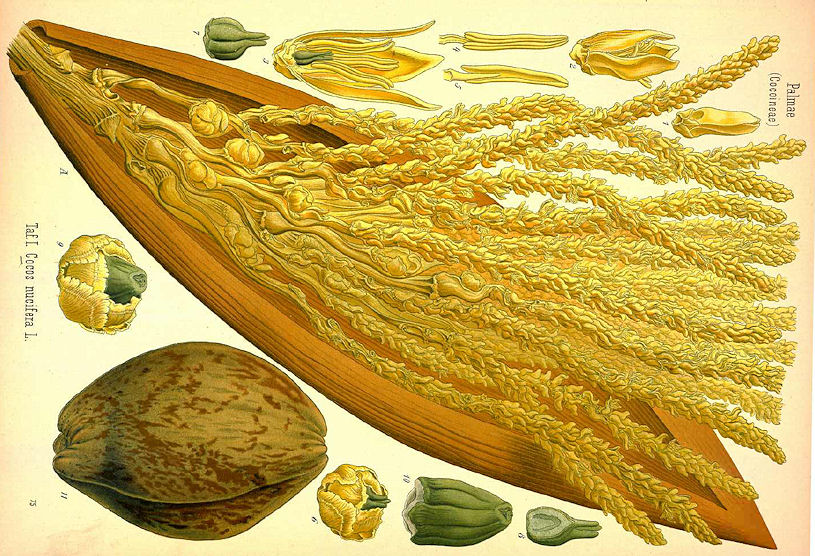
Abb.: Cocos nucifera L. 1753 -
Kokospalme - Coconut
[Bildquelle: Köhler, 1883-1914]
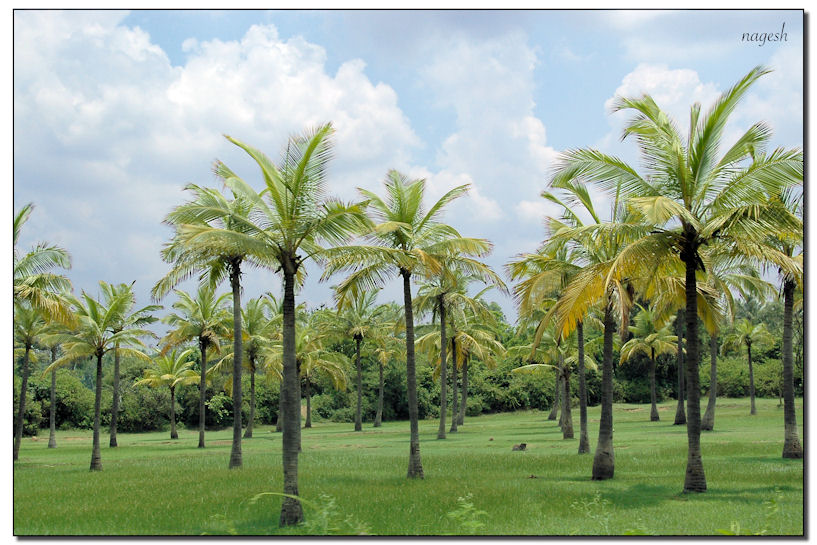
Abb.: Cocos nucifera L. 1753 -
Kokospalme - Coconut, Somanathapura - ಸೋಮನಾಥಪುರ, Karnataka
[Bildquelle: Nagesh Kamath. --
http://www.flickr.com/photos/nagesh_kamath/3068251686/. -- Zugriff am
2010-10-24. --
Creative Commons Lizenz (Namensnennung, share alike)]
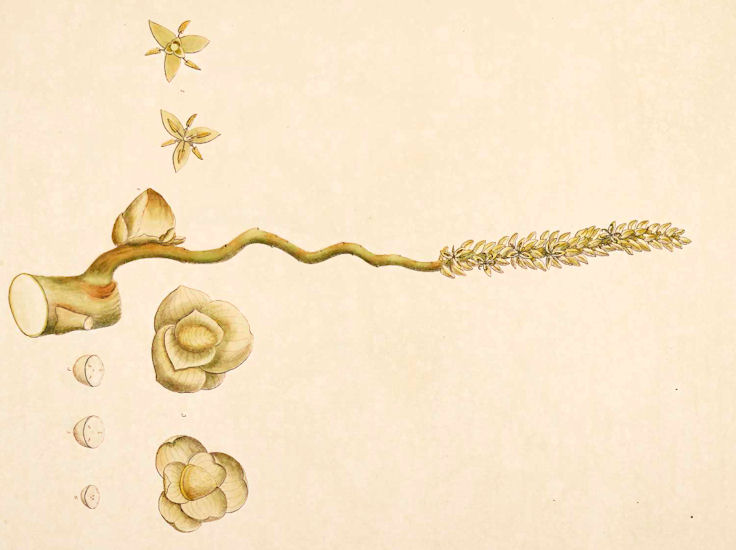
Abb.: Cocos nucifera L. 1753 -
Kokospalme - Coconut
[Bildquelle: Roxburgh. -- Vol I. -- 1795. -- Image courtesy Missouri Botanical
Garden. http://www.botanicus.org. --
Creative Commons Lizenz
(Namensnennung, keine kommerzielle Nutzung)]
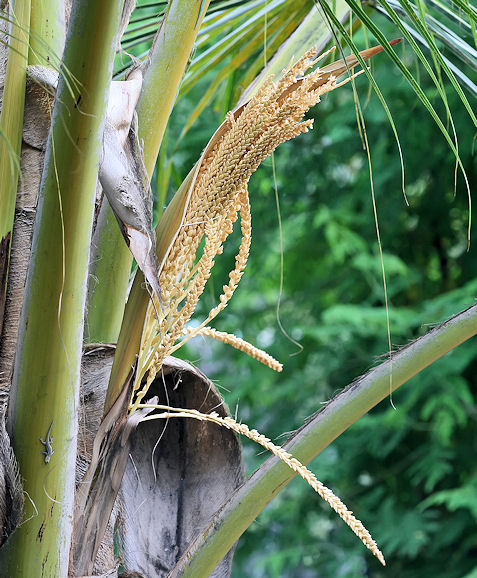
Abb.: Blüte von Cocos nucifera L. 1753 -
Kokospalme - Coconut
[Bildquelle: Muhammad Mahdi Karim / Wikimedia. -- GNU FDLicense]
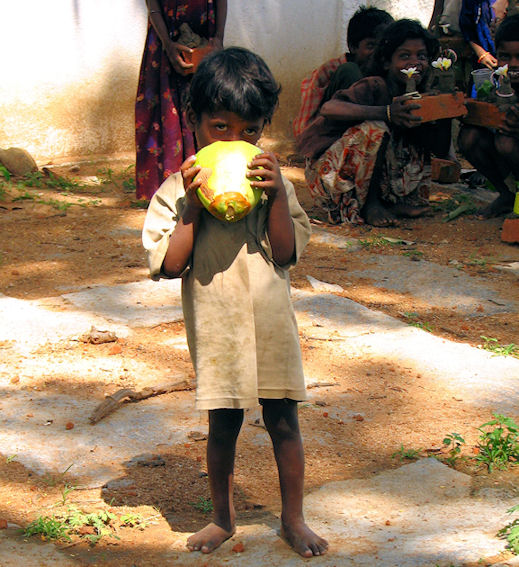
Abb.: जीवकः
। Kokossaft, Bangalore -
ಬೆಂಗಳೂರು,
Karnataka
[Bildquelle:
McKay Savage. --
http://www.flickr.com/photos/mckaysavage/529501515/. -- Zugriff am
2010-10-24. --
Creative Commons Lizenz (Namensnennung)]
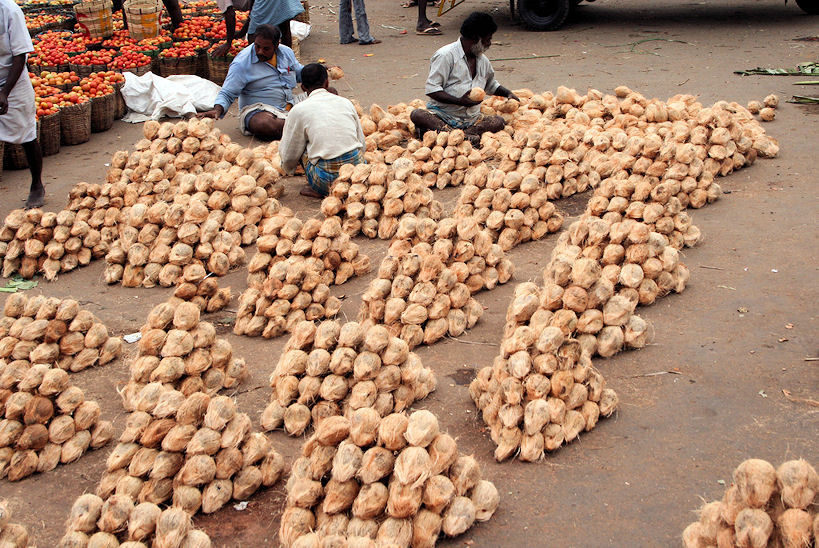
Abb.: Kokosnüsse auf dem Markt, Kurichi - குறிச்சி, Tamil Nadu
[Bildquelle:
Vilma Bharatan. --
http://www.flickr.com/photos/16454146@N06/2283666312/. -- Zugriff am
2010-10-24. --
Creative
Commons Lizenz (Namensnennung, keine kommerzielle Nutzung, keine
Bearbeitung)]
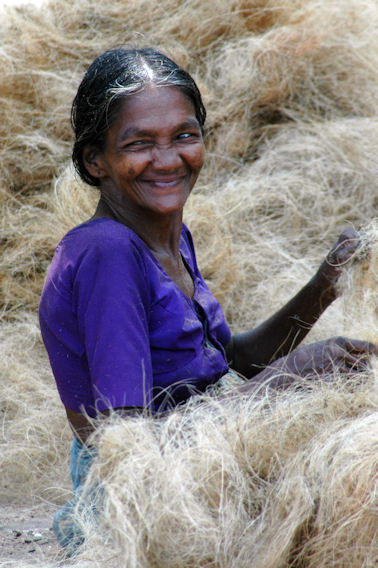
Abb.: Kokosfaser, Kovalam - കോവളം, , Kerala
[Bildquelle: sallylondon. --
http://www.flickr.com/photos/sallylondon/140941710/. -- Zugriff am
2010-10-24. --
Creative
Commons Lizenz (Namensnennung, keine kommerzielle Nutzung, keine
Bearbeitung)]
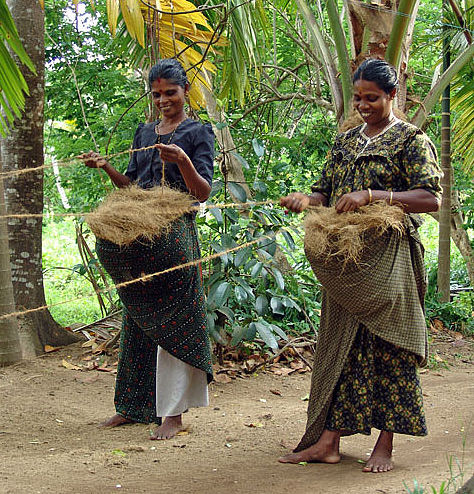
Abb.: Zwirnen von Kokosschnur, Kerala
[Bildquelle: Travel Diary. --
http://www.flickr.com/photos/98331846@N00/13317984. -- Zugriff am
2010-10-22. -- Creative
Commons Lizenz (Namensnennung)]
"Cocos nucifera (Linn.) N. O. Palmaceae. Coconut-palm. [...]
Description.-- [...]
Roxb. Fl. Ind. iii. 614.—Rheede, i. t. 1-4.
Shores of equinoctial Asia and its islands.
Medical Uses.—The freshly-prepared oil is of a pale-yellowish colour, and almost inodorous, but after a few days acquires a peculiar rancid odour and taste. It is much used for liniments and other external applications. It is often employed as a local application in baldness, and in loss of hair after fevers and debilitating diseases. It has been used as a substitute for cod-liver oil with good effect; but in such cases it was not the commercial oil in its crude state, but the oleine obtained by pressure, refined by being treated with alkalies, and then repeatedly washed with distilled water. Its prolonged use, however, is attended with disadvantage, inasmuch as it is apt to disturb the digestive organs, and induce diarrhoea. The expressed juice or milk of the fresh kernel has been successfully employed in debility, incipient phthisis, and cachexia. In large doses it proves aperient, and in some cases actively purgative, on which account it has been suggested as a substitute for castor-oil.—Pharm. of India.
Economic Uses.—The principal distribution of the Cocoa-palm lies within the intertropical regions of the Old and New Worlds, requiring a mean temperature of 72°. It is cultivated in great abundance in the Malabar and Coromandel coasts, Ceylon, the Laccadives, and everywhere in the islands of the Eastern Archipelago. It thrives best in low sandy situations, within the influence of the sea-breeze; and although it grows far inland on the continent, yet whenever found in places distant from the sea, the vigour of the palm is less than if cultivated in those maritime situations which nature has evidently determined should be its best and proper locality. Few if any products of the vegetable kingdom are so valuable to man in those countries where it is indigenous as the Cocoanut-palm, for there is scarcely a part of the plant which cannot be applied more or less to some use by the inhabitants of tropical climates. Of these uses, the chief are the oil from the nuts, the nuts themselves, the fibres, the leaves, the stem, and the toddy; but before detailing these separately, it may be as well to give a short account of the palm itself, its history, cultivation, &c. Many botanists have enumerated the manifold uses of the Cocoa-palm, and among them especially Kaempfer and Loureiro have collected much valuable information. One of the earliest accounts is that by Marco Polo, whose description of the "Indian nuts," as he terms them, is remarkably accurate. When speaking of an island in the Indian Archipelago, he says : "The Indian nuts also grow here, of the size of a man's head, containing an edible substance that is sweet and pleasant to the taste, and white as milk. The cavity of this pulp is filled with a liquor clear as water, cool, and better flavoured and more delicate than wine or any other kind of drink whatever." Sir John Mandeville also mentions the "great nut of India;" and another ancient writer has said in a paper read before the Royal Society in 1688 : "The Cocoanut-palm is alone sufficient to build, rig, and freight a ship with bread, wine, water, oil, vinegar, sugar, and other commodities. I have sailed," he adds, " in vessels where the bottom and the whole cargo hath been from the munificence of this palm-tree." Though there are several varieties enumerated by Rumphius, yet they have all been resolved into three species, of which one only is indigenous in the East, the other two being natives of Brazil. Fortunately so prolific a plant requires little care in its cultivation, and being essentially maritime, thrives best in those situations where other trees would perish or decay. In Ceylon, where greater care than elsewhere is bestowed upon its cultivation, it is considered best that they should not be planted too close together. The soil should first be carefully cleared from weeds. The nut should not be carelessly placed in the earth, but in a position favourable for germination, attention to which is somewhat important to the future perfection of the tree. The nut should be quite ripe before being deposited in the ground, and the hole may be dug with the slightest labour, it being sufficient to cover only two-thirds of the nut. In three or four months the nut begins to germinate. The usual time for planting on the western coast is before the rains; and, unless the nut is transplanted, no further watering is required in the hot season, the internal moisture of the nut being sufficient for the nourishment of the young plant for nearly a year. After that time the palm requires watering twice a-day until the fourth or fifth year, the roots being carefully heaped with earth to avoid too much exposure to the air. Beyond this no further care is requisite. From the fifth to the eighth year it begins to bear, according to the situation and soil, and continues bearing from seventy to eighty years. The tree is in its highest vigour from twenty-five to thirty years of age, and will attain the age of a hundred years. In the third year of its growth the fronds begin to fall, one. new frond appearing at the end of every month. These fronds fall more frequently in hot than in rainy weather. Of these there are about 28, more or less, in a full-grown tree. On a single tree there are about 12 branches or spadices of nuts, one bearing the dry nuts called Baruta or Cotta-tenga in Malayalum, another spadix the ripe ones, called Maninga-tenga. Most of the young fruits fall off, only a few coming to perfection; but as from 10 to 15 nuts on an average are produced on one branch, a single tree may produce from 80 to 100 nuts every year. Of trees requiring so little attention, it may easily be imagined how much value is attached to their possession. In Travancore and on the Malabar coast, the natives draw their chief subsistence from the produce of this useful palm. The price of a full-grown tree varies from 1/2 rupee to 5 rupees, according to circumstances. A yearly tax to the Sircar is averaged at a few annas, so that the profit derived from a large plantation is very considerable. It will now be necessary to enumerate the various uses to which the several parts of the tree may be applied, and first among them may be mentioned,
The Oil.—This is procured by first extracting the kernel from its outer integument or shell, and boiling it in water. It is then pounded and subjected to strong pressure. This being boiled over a slow fire, the oil floats on the surface. This is skimmed off as it rises, and again boiled by itself. Fourteen or fifteen nuts will yield about two quarts of oil. A somewhat different practice obtains on the Malabar coast. The kernel is divided into half-pieces, which are laid on shelves, and underneath is placed a charcoal fire in order to dry them. After two or three days they are placed on mats, and kept in the sun to dry, after which they are put in a press. When the oil is well extracted by this method, a hundred nuts will yield about two gallons and a half of oil. This is the method usually resorted to when the oil is required for exportation; the former, when merely used for culinary purposes. Of late years the application of steam, especially to a press, for the purpose of procuring the oil, has been attended with the greatest advantages. Cocoanut-oil in India is used chiefly for culinary purposes, burning in lamps, &c., and in Europe for the manufacture of soap and candles. The oil becomes solid about 70°. It is said that its consumption in Europe is likely to decrease, owing partly to the new means of purifying tallow, whereby candles equally good as those made from Cocoanut-oil are produced. Great quantities of oil are shipped annually from Ceylon and the western coast, and in extraordinary seasons have realised in England £70 a-ton, or upwards: the average price is from £35 to £40 a-ton. That which is shipped from Cochin bears generally a higher price than that from Ceylon.
The Copra, which is the dried kernels, as also the Poonac, is occasionally sent to Europe by itself from Ceylon and Cochin. The Poonac is the refuse of the kernel after the oil has been expressed. It is very fattening to fowls and cattle, and forms the best manure to young Cocoanut-trees, as it returns to the soil many of the component parts which the tree has previously extracted for the formation of the fruits. For this reason it has been found worth while to transmit the Poonac to those localities where the Cocoanut-tree grows far inland, away from the saline soil of the coast. The Cocoa-palm abstracts from the soil chiefly silex and soda; and where these two salts are not in abundance, the trees do not thrive. Common salt applied to the roots will be found very beneficial as a manure to the young trees when cultivated at any distance from the sea.
Coir is the fibrous rind of the nuts, with which the latter are thickly covered. There are several ways of stripping the fibres from the husk. One is by placing a stake or iron spike in the ground, and by striking the nut on the point, the fibres are easily separated. The husks are first separated from the nuts, and then placed in salt or brackish water for about 12 or 18 months ; they are then scraped and cleaned for use. There exists, however, no such necessity for steeping the husk so long in water, it haying been found that a shorter time is sufficient for the purpose. In the Jury Report of the Madras Exhibition, we find: "It has lately been proved that the fibre from the husk of the ripe fruit is greatly improved in quality and appearance by beating, washing, and soaking, and that the old method of steeping in salt water for 18 months or 2 years is quite unnecessary, and that it produces a harsher and dirtier coir. The tannin which this substance, contains prevents the fibre from rotting; but most of the coir of commerce is a dirty, harsh produce, very different from many of the clean and dyed samples exhibited, which are suited to a superior class of manufactures, as fine mats and furniture-brushes." Coir is applied to many uses—for stuffing couches and pillows, for cordage, saddles, &c. Large quantities are annually shipped to Europe, where it is manufactured into brushes, mats, and carpets, and even hats and bonnets; the latter attracted much attention at the Great Exhibition in London. The fibre is rather difficult to twist; still it is made into ropes for ordinary purposes in shipping. The character of Coir, says Royle, has long been established in the East, and is now well known in Europe as one of the best materials for cables, on account of its strength, lightness, and elasticity. These cables are further valuable, being durable, particularly when wetted with salt water.
Numerous instances have been related of ships furnished with cables of this light, buoyant, and elastic material, riding out a storm in security, while stronger-made though less elastic ropes of other vessels have snapped in two, and even when chain cables have given way. Indeed, until chain cables were so largely introduced, all the ships navigating the Indian seas were furnished with Coir cables. Coir cordage, in Dr Wight's experiments, broke at 224 lb. weight.
The mode of extracting the toddy is the same as that used in other palms (see Borassus). Spirit distilled from the toddy is called arrack. Good vinegar is also made from it, particularly at Mahè. One hundred gallons of toddy yield 25 of arrack. To procure the sugar or jaggery, the fresh toddy is boiled down over a slow fire, when the syrup is further evaporated to the brown coarse sugar. This jaggery is mixed with chunam for making a strong cement, enabling it to resist great heat and to take a fine polish. The toddy is called Tenna-kulloo, and Narillie in Dukhanie. If taken before sunrise it is very refreshing and delicious. The native doctors recommend it in consumption; and it is said that if regularly taken, it is good for delicate persons suffering from habitual constipation.
The water of the nuts is used by the bricklayers in preparing a fine whitewash, also in making the best and purest castor-oil, a certain portion of it being mixed with the water in which the seeds are boiled. The shell, when burnt, yields a black paint, which, in fine powder and mixed with chunarn, is used for colouring walls of houses. The soft downy substance found at the bottom of the fronds is a good styptic for wounds, leech-bites, &c. It is called in Tamil Tennamarruttoo punjee, and. in Malayalum Tennam-pooppa. The web-like substance which surrounds the Cocoa-palm at those parts where the branches expand is called Panaday in Tamil, Konjatty in Malayalum, and it is used by the toddy-drawers to strain the toddy through. In Ceylon it is manufactured into a coarse kind of cloth for bags and coverings, and from these bags, again, a coarse kind of paper is made. The Cocoanut cabbage is the terminal bud found at the summit of the tree; but to procure it the tree must be destroyed. It makes an excellent pickle, and may also be used as a vegetable.
In addition to the above uses, the leaves are employed for thatching houses, especially in Malabar, and the stems for rafters of houses, bridges, beams, small boats, and, where the wood is thick, is even used for picture-frames and articles of furniture. It is known in Europe as the porcupine-wood, and has a pretty mottled appearance. The nuts, dried and polished, are made into drinking cups, spoons, baskets, and a variety of fanciful ornaments. The midribs of the leaves are used for paddles.
The natives chew the roots as they do the areca nut with the betle-leaf. Abundance of potash is yielded by the ashes of the leaves. Cocoanuts are occasionally fixed on stakes in the public roads in India for the purpose of giving light, for which they are well adapted from their fibrous covering without and oily substance within. Marine soap, or Cocoanut-oil soap, so useful for washing linen in salt water, is made of soda, Cocoanut-lard, and water. So great and so varied are the uses of the Cocoa-palm,—fully calculated to realise the old saying, "Be kind to your trees and they will be kind to you."—Royle's Fib. Plants. Simmonds. Lindley. Ainslie."
"APPENDIX C. FURTHER USES OF THE COCOA - PALM.
By Hugh Cleghorn, M.D.
It is well known that the leaves furnish material for mats, thatch, screens, purdahs in zenanas, &c. The finer nerves of the pinnules are employed in constructing a superior description of mat. The fibrous husk of the nut yields kayār, from which ropes and cables are made, and with which mattresses are stuffed. When the husk is cut across and the inner shell removed, a hard brush is formed, which is much used for polishing waxed furniture, and for many other purposes. The hard shell (endocarp), besides its use for ladles, &c., affords when burnt a good black pigment, occasionally employed in colouring the walls of houses.
The albumen and the milk are used as an ingredient in curries (and no pillau or curry is considered complete without them); the milk is also used in the arts. The kernel is pounded, and subjected to strong pressure, for the purpose of yielding the cocoa-oil of commerce. The manufacture of this oil constitutes a regular trade on the western coast of Hindostan. Toddy is drawn from the tree for six months of the year. The process of extracting the sap is as follows: When the spathe is a month old, the flower-bud is considered sufficiently juicy to yield a fair return to the (Sānār) toddy-drawer, who ascends the tree with surprising ease and apparent security, furnished with the apparatus of his vocation. This apparatus and the mode of ascent were described by Dr Cleghorn in his paper. A year's practice is requisite before the Sānār becomes an expert climber. The spathe when ready for tapping is 2 feet long and 2 inches thick. It is tightly bound with strips of young leaves to prevent expansion, and the point is cut off transversely to the extent of 1 inch. He gently hammers the cut end of the spathe to crush the flowers thereby exposed, that the juice may flow freely. The stump is then bound up with a broad strip of fibre. This process is repeated morning and evening for a number of days—a thin layer being shaved off on each occasion, and the spathe at the same time trained to bend downwards. The time required for this initiatory process varies from five to fifteen days in different places. The time when the spathe is ready to yield toddy is correctly ascertained by the chattering of birds, the crowding of insects, the dropping of juice, and other signs unmistakable to the Sānār. The end of the spathe is then fixed into an earthen vessel, and a slip of leaf is pricked into the flower to catch the oozing liquor and convey the drops clear into the vessel. After the juice begins to flow the hammering is discontinued. A man attends to thirty or forty trees, which do not bleed so freely during the heat of the day as at night. Forty trees yield twelve Madras measures of juice, about to 2 gallons, the times of collecting being seven in the morning and five in the evening. Jaggery (coarse brown sugar) is procured by boiling down fresh toddy over a slow fire, a gallon yielding about a pound. Jaggery mixed with lime forms a strong cement, and takes a fine polish. It is to this mixture, in part at least, that the Madras Chunam owes its celebrity.
Wood.—The trunk is only used for temporary purposes; when fresh cut it possesses great elasticity, and is for this reason particularly well adapted for temporary stockades which are exposed to cannon-shot. Cocoa-palms are easily transplanted, and often with advantage. Some of the fibrous radicles are cut away, a little manure and a handful of salt being applied to the roots each time."
[Quelle: Drury, Heber <1819 - 1872>: The useful plants of India : with notices of their chief value in commerce, medicine, and the arts. -- 2d ed. with additions and corrections. London : Allen, 1873. -- xvi, 512 p. ; 22 cm. -- s.v.]
"COCOS NUCIFERA, Linn.
Fig.—Roxb. Cor. Pl. i., t. 73; Rheede, Hort. Mal. i., tt. 1 to 4.
Cocoanut
Hab.—-Indian Archipelago and coasts of India.
[...]
History, Uses, &c.—The cocoanut, formerly written coconut, derives its European names from the Portuguese coco, "a mask." Garcia ab Horta says : "We have given it the name of coqus on account of its having three holes which cause it to resemble the face of a cat or similar animal." The resemblance, however, of this nut to a head and face had not escaped the notice of the Hindus ; long before the Portuguese had set foot in India, nāral was used as a cant term in the sense of head, pate, sconce, &c, and was sometimes used to represent the head of a dummy figure by the relatives of a deceased person whose body could not be found, and who nevertheless were desirous of rendering to it the usual funeral rites. Various superstitious uses to which the cocoanut is put in India attracted the notice of the early missionaries. Vincenzo Maria da Santa Caterina (Viaggio alle Indie Orient., iii., 29) states that when an Indian falls sick, they spin a cocoanut; if it stops with its face towards the West, the sick person will die, but if it faces the East, he will recover ; he also notices the offering of a cocoanut at the commencement of any building. To this we may add that on the Western Coast cocoanuts are offered to the Sea on the day of the full moon of Shravan, when the monsoon is supposed to terminate. It is related that in former days the European Governor of Bombay used to go in state and throw a golden cocoanut into the sea on this day. In Hindustan there is also a practice among the Indian Mahometans of breaking a cocoanut to ascertain whether a pregnant woman will be delivered of a male or female child; if it is empty she will be delivered of a son, if not, of a daughter: this is called "nariyal torna." Breaking a cocoanut against the wall of a person's house is in Western India an indication of enmity to the inmates of the house, and is connected with the practice of smelling the heads of children before allowing them to leave the house. The utarna or casting away of disease or misfortune maybe performed by carrying a cocoanut to a distance from the house and breaking it.
Among the Hindus the most important function of this nut is at marriages, when it is the custom to place the tali of the bride, which the parents must see and touch in token of their approbation of the marriage, in the half of a broken cocoanut. Here the tali and nut represent le Jeu des epoux. De Gubernatis relates that the continuance of this practice among their converts greatly exercised the patience of the Jesuit missionaries, and that the matter was finally settled in 1704 by a decree of the Cardinal de Tournon to the following effect:— "Fructus etiam vulgo dictus Coco, ex cujus fractione prosperitatis vel infortunii auspicia gentiles temere ducunt, vel omnino a Christianorum nuptiis regiciatur, vel saltern, si illum comedere velint non publice sed secreto et extra solemnitatem apariatur ab iis qui, evangelica luce edocti, ab hujusmodi auspiciorum deliramento sunt alieni." In the coast districts, cocoanuts and sugar-cakes (nāral, batāsa) are lavishly distributed to the guests on important festive occasions, such as marriage, the phool ceremony on the event of the first menstruation and first pregnancy, and the thread ceremony; in other parts of India their place is supplied by betel-nuts. In Europe nuts appear to have been always regarded as auspicious and symbolical of fertility; the Romans scattered nuts at weddings; Virgil says, "Sparge, marite, nuces," and De Gubernatis states that this custom still exists in several parts of Southern Europe ; in Piedmont there !s a proverb : Pan e nus vita da spus.
The economic uses to which the cocoanut tree and its products are put in the East, are so numerous, and have so often been described, that we will not attempt to recapitulate them, but refer the reader to the Dictionary of the Economic Producta of India (ii. 415). At the Colonial and Indian Exhibition, Mr. M. C. Pereira, Head Assistant to the Government Medical Storekeeper, Bombay, exhibited a collection of eighty-three articles prepared from the tree, and we are informed that he has since added considerably to his collection.
Sanskrit medical writers describe the tree under the name Nārikela or Nārikera, and give it many synonyms, such as Tunga "lofty," Trina-rāja "king of grasses," Skandha-taru ''stem tree," Dur-āroha "difficult of ascent," Kūrcha-sekhara crowned with a bunch of fruit," Dridha-phala "having hard fruit," Rasa-phala "having juicy fruit," Dridha-nira "having strong juice," &c. The tree also bears the name of Langala "membrum virile."
Dutt (Mat. Med. of the Hindus, p. 247) gives the following summary of the medicinal uses of the cocoa palm mentioned in Sanskrit medical works:—"The water of the unripe fruit is described as a fine-flavoured, cooling, refrigerant drink, useful in thirst, fever, and urinary disorders. The tender pulp of the fruit is said to be nourishing, cooling, and diuretic. The pulp of the ripe fruit is hard and indigestible, but is used medicinally in the preparation called Nārikela-khanda. The terminal bud of the tree is esteemed as a nourishing, strengthening, and agreeable vegetable. The root of the tree is used as a diuretic, and also in uterine diseases. The oil is said to promote the growth of the hair and to prevent it from turning grey, and is much used by native women; in Bengal it is scented and sold under the name of Māthāghasā. The ashes of the leaves are used in medicine, and contain much potash. The fresh juice of the tree is considered refrigerant and diuretic; when fermented it constitutes one of the spirituous liquors described by the ancient writers. The cleared shell of the nut is burnt in the fire, and when thoroughly ignited covered up in a stone cup, the fluid thus obtained is rubefacient, and is an effectual domestic remedy for ringworm. The Nārikela-khanda already mentioned is made in the following manner:—Take of the pounded pulp of cocoanut half a ser, fry it in eight tolas of clarified butter, and afterwards boil in four sers of cocoanut water till reduced to a syrupy consistence. Now add coriander, long-pepper, bamboo manna, cumin and nigella seeds, cardamoms, cinnamon bark and leaves, cyperus root and the flowers of Mesua ferrea, one tola each in fine powder, and prepare a confection. The dose is two to four tolas, in dyspepsia and consumption.
The cocoa palm is supposed by some to have been the κοθριοφορον (δενδρον) of Theophrastus"(H. P. iv., 2, 7), and the Cuci of Pliny (13,19), but their description appears to agree better with the Hyphaene coriacea or Doom palm of Egypt. The Arabs call the cocoanut Nārjil, and the Persians Nārgil, Bādinj, and Rānaj ; their physicians describe it as hot and dry, nutritive and aphrodisiacal, beneficial to those suffering from piles; the kernel when it has been kept for some time is considered to be anthelmintic. They remark that it is not easily digested, especially when old.
European physicians, who have practised in India, recommend the water contained in the unripe fruit as a cooling, refrigerant drink, useful in fever and urinary disorders. The milky fluid obtained by pulping the unripe kernel and expressing it has been recommended as a nutritive diet in debility and cachexia; in large doses it is aperient, and Mr. Wood has suggested its use as a substitute for castor oil. (Pharmacopoeia of India.) The anthelmintic properties of the cocoanut noticed by Mahometan writers have been confirmed by European observers; the dose is the rasped kernel of a single nut, followed by a dose of castor oil. Cocoanut oil has been recommended as a substitute for cod liver oil, but its prolonged use is said to induce disturbance of the digestive organs and diarrhoea; this objection may be removed by using the olein separated from the solid parts, as is done by the natives in the preparation of what they call muthel or hand oil. To prepare this the kernel of the fresh nuts is pulped and strained and the oil separated from the milky fluid by heating it; a preparation of the same kind is now known in Europe as coco-olein. Cocoanut oil is not suitable as a vehicle for liniments, but tie soap prepared from it, and known as marine soap, may be used in plaster-making and in the preparation of soap liniment; it is freely soluble in spirit. A purified cocoanut oil has of late years been introduced in Germany as a substitute for lard ; it has been recommended to pharmacists as less liable to rancidity than lard. The saccharine juice obtained by cutting the spathe of the cocoa palm, when fermented and distilled, yields a clean spirit suitable for pharmaceutical purposes."
[Quelle: Pharmacographia indica : a history of the principal drugs of vegetable origin met with in British India / by William Dymock [1834-1892], C. J. H. Warden and David Hooper [1858-1947]. -- Bd. 3. -- London, 1893. -- S. 511ff.]
Gentianaceae (Enziangewächse)
|
8. c./d. kirātatikto bhūnimbo 'nāryatikto 'tha saptalā किराततिक्तो भूनिम्बो ऽनार्यतिक्तो ऽथ सप्तला ॥८ ख॥ [Bezeichnungen für Swertia chirata Buch.-Ham. ex Wall. 1831:]
|
Colebrooke (1807): "Sort of Gentian. Gentiana Cherayta, Roxb. [= Swertia chirata Buch.-Ham. ex Wall. 1831]"
1 किराततिक्त - kirātatikta m.: Kirāta-Würze
"KIRĀTAS. Foresters and mountaineers living in the mountains east of Hindustan. (There is a tribe in the Central Himalayas called Kirantis.) They are described in the Rāmāyaṇa as "islanders, who eat raw fish, live in the waters, and are men-tigers" (men below and tigers above, according to the commentator). Their females are described as "gold-coloured and pleasant to behold," and as having "sharp-pointed hair-knots." They are perhaps the Cirrhadae placed on the Coromandel coast by classic writers."
[Quelle: Dowson, John <1820-1881>: A classical dictionary of Hindu mythology and religion, geography, history, and literature. -- London, Trübner, 1879. -- s.v. ]
2 भूनिम्ब - bhūnimba m.: Boden-Nimba, Erd-Nimba
nimba m. = Azadirachta indica (L.) A. Juss. 1830 - Nimbaum - Neem Tree
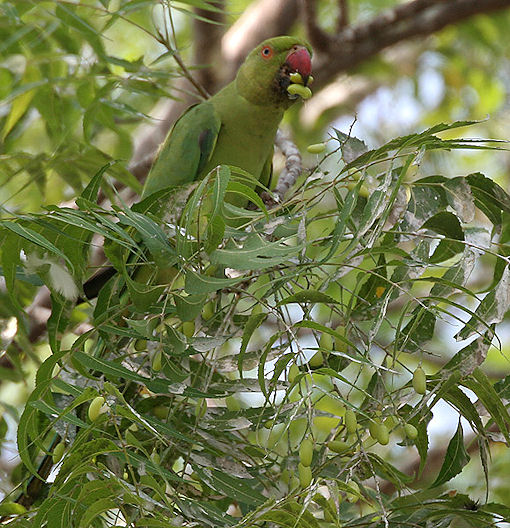
Abb.: Azadirachta indica (L.) A. Juss. 1830 -
Nimbaum - Neem Tree, mit
Psittacula krameri -
Rose-ringed Parakeet - Halsbandsittich, Amaravati - అమరావతి,
Andhra Pradesh
[Bildquelle: J. M. Garg / Wikimedia. -- GNU FDLicense]
Abb.: Swertia chirata Buch.-Ham. ex Wall. 1831
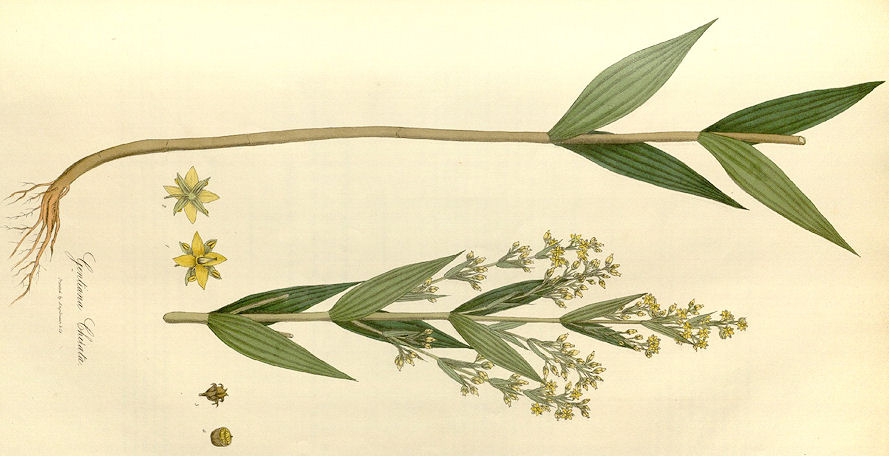
Abb.: Swertia chirata Buch.-Ham.
ex Wall. 1831
[Bildquelle: Plantae Asiaticae rariores, or, Descriptions and figures of a
select number of unpublished East Indian plants / by N. Wallich. -- London,
1830-32. -- Vol. 3, P. 252.]
"SWERTIA CHIRATA, Ham.
Fig.— Wall. Pl. As. Rar. iii., t. 252; Bentl. and Trim., t. 183.
Chiretta
Hab.—Temperate Himalaya.
[...]
History, Uses, &C.—Kirāyat has long been an important article of the Hindu Materia Medica. It is mentioned by Susruta and other Sanskrit writers under the name of Kirātatikta, which means the bitter plant of the Kirātas, an outcaste race of mountaineers in the north of India. It is also called Anārya-tikta, "the bitter plant of the non-Aryans." Another Sanskrit name is Bhūnīmba, "ground-nim." The herb is much esteemed by the Hindu physicians on account of its tonic, anthelmintic and febrifuge properties, and is prescribed in masked forms of malarial fever in which the chief symptoms are dyspepsia; it is usually combined with aromatics, such as ginger and lemon grass.
It is also considered to be laxative, anthelmintic and alterative. In the Bhaishajya-ratnavali, a decoction is directed to be made of equal parts of chiretta, Tinosposa stems, raisins, emblic myrobalans and zedoary root. Chiretta is one of the 54 ingredients of the compound powder known as Sudarsana-churna, and it gives its name to a compound oil called Kirātādi-taila, in which it is combined with 26 other drugs, mostly aromatics and stimulants. This oil is rubbed on the body in obstinate cases of ague, causing emaciation and anaemia. (Bhaishajya-ratnavali.)
Mahometan writers upon Indian drugs have identified Chiretta with the Kasab-ed-darira of the Arabsf and Calamus aromaticus of Dioscorides. Guibourt was also of the same opinion, but Fée and Royle dissent from it.
The author of the Makhzan-el Adwiya gives at the end of his article upon Kasab-ed-darira the following short summary of the manner in which Chiretta is used by the Hindu physicians :—
"They consider it to be cold and dry, light and flatulent; a remedy for colds and bilious affections, burning of the body, and the fever arising from derangement of the three humors which they call sannipāt (fever with delirium)." The plant was first described by Roxburgh under the name of Gerntiana Chirayita in 1814. Ainslie notices it, and remarks that it appears to be much used in Bengal; it was probably rather a scarce drug in Southern India in his time, as he says little about it. In England it began to attract attention about the year 1829 ; and in 1839 was introduced into the Edinburgh Pharmacopoeia. It is now official in the British and Indian Pharmacopoeias, and is generally accepted as a valuable bitter tonic. In Western India it has a reputation as a remedy for bronchial asthma, and in some cases we have known it used with success.
Description.—The entire plant is collected when in flower, or more commonly when the capsules are fully formed, and tied up with a slip of bamboo into flattish bundles about 3 feet long, each weighing when dry from 1 1/2 to 2 lbs."
[Quelle: Pharmacographia indica : a history of the principal drugs of vegetable origin met with in British India / by William Dymock [1834-1892], C. J. H. Warden and David Hooper [1858-1947]. -- Bd. 2. -- London, 1891. -- S. 511f.]
Euphorbia: Euphorbiaceae
(Wolfsmilchgewächse)
Acacia: Mimosaceae (Mimosengewächse)
|
8. c./d. kirātatikto bhūnimbo 'nāryatikto
'tha saptalā
किराततिक्तो भूनिम्बो ऽनार्यतिक्तो ऽथ सप्तला ॥८
ख॥ [Bezeichnungen für Euphorbia tirucalli L. 1753 - Latex-Wolfsmilch - Rubber Euphorbia oder Euphorbia dracunculoides Lam. 1788 oder Acacia concinna (Willd.) DC. 1825 (???):]
|
Colebrooke (1807): "Charmaghās."
"This plant has not been correctly identified so far. In South India Acacia concinna DC. soapnut tree is commonly used under this name." (Bhāvaprakāśa I, S. 239)
Euphorbia tirucalli L. 1753 - Latex-Wolfsmilch - Rubber Euphorbia
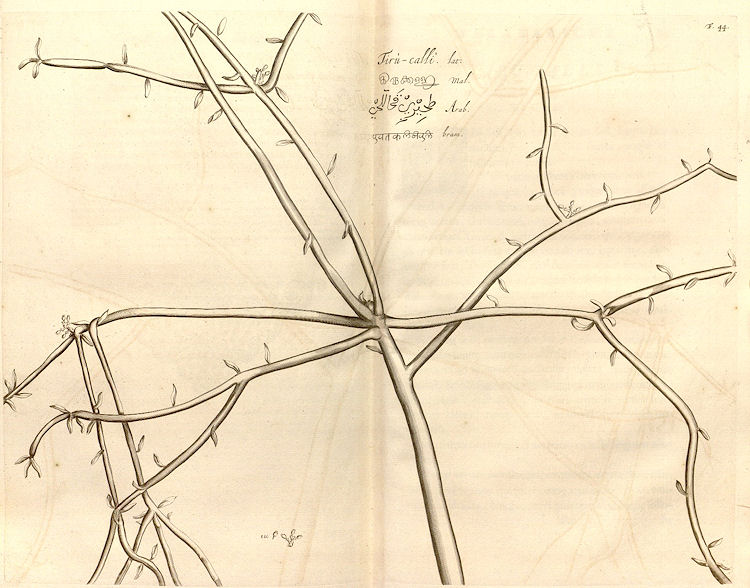
Abb.: विमला
। Euphorbia tirucalli L. 1753
- Latex-Wolfsmilch - Rubber Euphorbia
[Bildquelle: Hortus malabaricus II. Fig. 44,
1679]
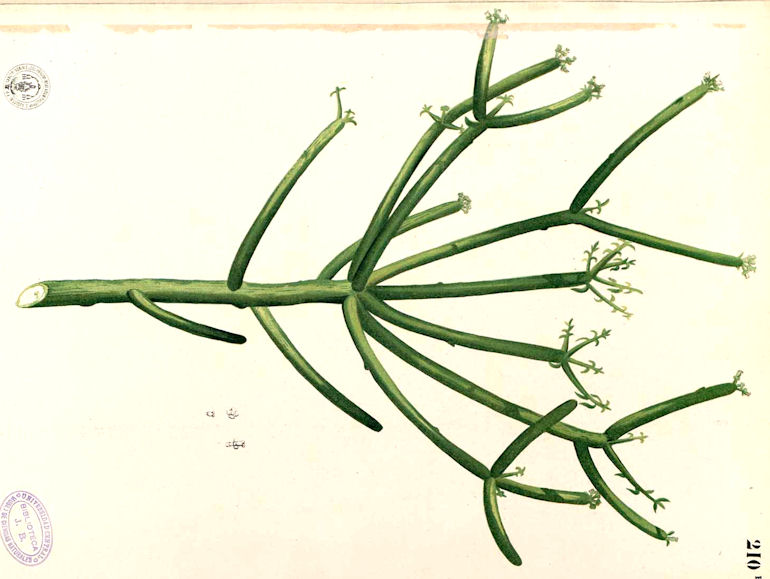
Abb.: सातला
। Euphorbia tirucalli L. 1753
- Latex-Wolfsmilch - Rubber Euphorbia
[Bildquelle: Flora de Filipinas, 1880 / Wikipedia. -- Public domain]
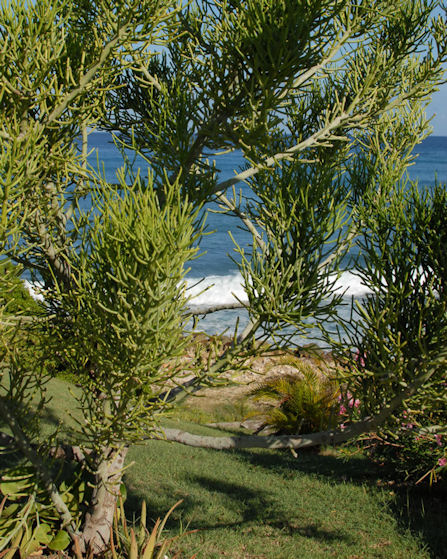
Abb.:
भूरिफेना
। Euphorbia tirucalli L. 1753
- Latex-Wolfsmilch - Rubber Euphorbia, Antillen
[Bildquelle:
Bordy Nathalie. --
http://www.flickr.com/photos/atelier-bordy-desirade/4009841169/. -- Zugriff
am 2010-10-24. --
Creative Commons
Lizenz (Namensnennung, share alike)]
"Euphorbia tirucalli (Linn.) Milk-hedge or Indian Tree Spurge [...]
Description.—Tree unarmed, 20 feet; [...] flowers [...] pale yellow
Fl. June—Sept.
Roxb. Fl. Ind. ii. 470.—Rheede, ii. t 44.
CoromandeL Malabar. Bengal.
Medical Uses.—The fresh acrid juice of this plant is used as a vesicatory. Rheede says that a decoction of the tender branches is given in colic, and the milky juice mixed with butter as a purgative, on the Malabar coast. It is used among the natives as a good manure. Goats will eat the plant notwithstanding its acrid juice. The bark and small branches are ingredients used in dyeing cotton a black colour. The root in decoction is administered internally in pains in the stomach. On the Coromandel coast it is frequently employed for hedges, and is known as the milk-hedge.—Roxb."
[Quelle: Drury, Heber <1819 - 1872>: The useful plants of India : with notices of their chief value in commerce, medicine, and the arts. -- 2d ed. with additions and corrections. London : Allen, 1873. -- xvi, 512 p. ; 22 cm. -- s.v.]
"EUPHORBIA TIRUCALLI, Linn.
Fig.—-Rheede, Hort. MaL. ii., t. 44.
Milk-bush
Hab.—Africa. Cultivated in India and the East.
[...]
History, Uses, &c —This shrub has been introduced into the East from Africa, and is much used for making fences round cultivated fields, as cattle will not break through it owing to the acrid nature of the milky juice. The earliest notice of E. Tirucalli that we know of is in the Kāmus, which was written about the middle of the 14th century; it is there called dihan, the name by which it is still known in Arabia (Forskahl), and is described as a noxious plant, used to poison wild beasts. The plant is not mentioned in the Nighantas, but the juice is in general use among the natives of India as a purgative, and, applied locally, as a counter-irritant. Rheede states that a decoction of the root is given in certain cases of colic, and that the milky juice mixed with melted butter is prescribed as a purge. It is the Ossifraga lactea of Rumphius, who says that the bark is applied in Java to fractures. According to Horsfield, the Javanese, who call it Kayoo-oorb, also use it as a vesicant. Virey {Hist Nat., p. 299) says :—"Il guérit très bien l'affection venérienne ; il est aussi purgativ et vomitif." Loureiro notices its caustic nature: " Occulos si tangat excaecat." (Ainslie, Mat. ind., ii., 133 and 425.) In the Concan 1 to 4 drops of the milky juice are given with treacle or the flour of Cicer arietinum as a purge, and the charcoal, which is very light, is used in making pastilles. Dr. G. Y. Hunter speaks of the juice as a good application in neuralgia. In Goa it is used for poisoning fish.
Description.—A shrub or small tree, 15—20 feet"
[Quelle: Pharmacographia indica : a history of the principal drugs of vegetable origin met with in British India / by William Dymock [1834-1892], C. J. H. Warden and David Hooper [1858-1947]. -- Bd. 3. -- London, 1893. -- S. 252f.]
Acacia concinna (Willd.) DC. 1825
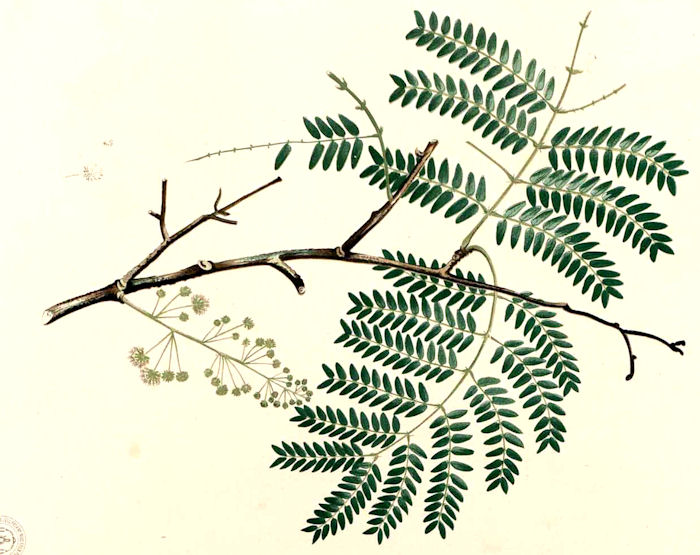
Abb.: Acacia concinna (Willd.) DC. 1825
[Bildquelle: Flora de Filipinas, 1880 / Wikipedia. -- Public domain]
"Acacia concinna (Dec.) [...]
Description.—Climbing; [...] flowers small, white.
Fl. July—October.
W. & A. Prod. i. 277.
Mimosa concinna, Willd.
Bengal. Assam. Mysore.
Economic Uses.—A considerable trade is carried on in some parts of the country in the pods of this shrub, which resemble the soap-nut, and are used, like it, for washing the head. The Hindoos also use them for marking the forehead. The leaves are acid, and are used in cookery as a substitute for tamarinds.—Roxb. Nimmo."
[Quelle: Drury, Heber <1819 - 1872>: The useful plants of India : with notices of their chief value in commerce, medicine, and the arts. -- 2d ed. with additions and corrections. London : Allen, 1873. -- xvi, 512 p. ; 22 cm. -- s.v.]
"ACACIA CONCINNA, DC.
Hab.—India, Burmah.
[...]
History, Uses, &c.—The tree is called in Sanskrit Saptala and Charma-kasa, or "skin-injurer," on account of its numerous thorns, and is common in many parts of the country. Ainslie has the following notice of the medicinal use of the pods in Southern India:—"Sheeakai is the name given by the Tamools to a long flat pod, or legume, containing separate, small, oval, dark-coloured seeds, and which is considered by the native practitioners as a most valuable medicine ; in taste it somewhat resembles the soap-nut, but is more acid, less bitter, and has a singular pungency; its qualities are allowed to be deobstruent and detergent, and, I am inclined to think, expectorant; it is commonly ordered in cases of jaundice and other biliary derangements, and is besides used by the Indians like soap-nut for washing the head. The small leaves of the prickly shrub have a pleasant acidity, and are frequently put into pepper-water when it is found necessary to keep the bowels open or work off bile. The pod is usually prescribed in electuary in doses of about the size of a small walnut, every morning for three successive days." Nimmo notices the use of the pods by Hindus for making sectarial marks on the forehead. The leaves are used as an acid ingredient in food instead of tamarinds, and the bark is used in tanning."
[Quelle: Pharmacographia indica : a history of the principal drugs of vegetable origin met with in British India / by William Dymock [1834-1892], C. J. H. Warden and David Hooper [1858-1947]. -- Bd. 1. -- London, 1890. -- S. 560.]
|
9. c./d. vāyasolī svādurasā vayaḥsthātha makūlakaḥ वायसोली स्वादुरसा ययःस्थाथ मकूलकः ॥९ ख॥ [Bezeichnungen für ???:]
|
Colebrooke (1807): "Cācolī."
Euphorbiaceae (Wolfsmilchgewächse)
|
9. c./d. vāyasolī svādurasā
vayaḥsthātha makūlakaḥ
वायसोली स्वादुरसा ययःस्थाथ
मकूलकः ॥९ ख॥
[Bezeichnungen für Baliospermum montanum (Willd.)
Muell. Arg. 1866:] मकूलक -
makūlaka m.: Makūlaka निकुम्भ
- nikumbha m.: Nikumbha (zu kumbha m.: Topf; vielleicht = "in den
Topf hinein" = Topfgemüse; oder "nach unten gerichteter Topf")
दन्तिका
- dantikā f.: Gezahnte प्रत्यक्श्रेणी
- pratyakśreṇī f.: nach hinten
gerichtete Menge, mit einer innerlichen Menge (an Staubfäden ?) उदुम्बरपर्णी
- udumbaraparṇī f.: Udumbara-Blättrige1 |
Colebrooke (1807): "Danti."
1 उदुम्बरपर्णी - udumbaraparṇī f.: Udumbara-Blättrige
udumbara m. = Ficus racemosa L. - Cluster fig
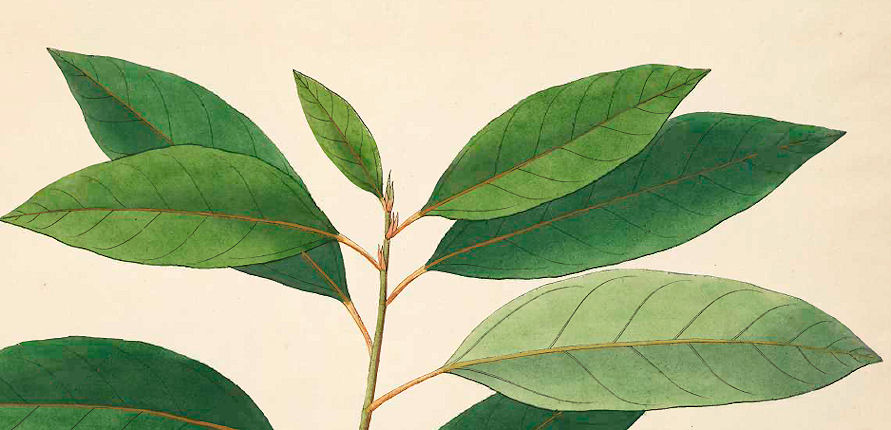
Abb.: Blätter von Ficus racemosa L. - Cluster fig
[Bildquelle: Roxburgh. -- Vol II. -- 1795. -- Tab. 123. --Image courtesy
Missouri Botanical Garden.
http://www.botanicus.org. --
Creative Commons Lizenz
(Namensnennung, keine kommerzielle Nutzung)]
Baliospermum montanum (Willd.) Muell. Arg. 1866
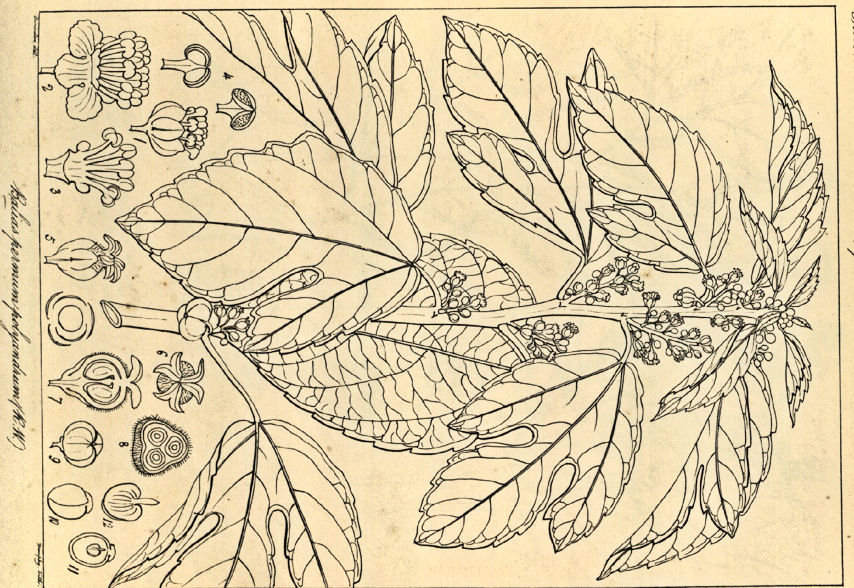
Abb.: Baliospermum montanum (Willd.)
Muell. Arg. 1866
[Bildquelle: Wight Icones V, Tab. 1885, 1852]
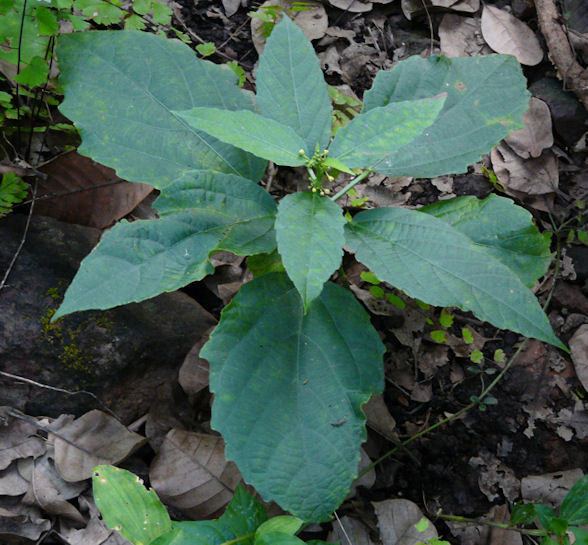
Abb.: दन्तिका । Baliospermum montanum (Willd.)
Muell. Arg. 1866, Maharashtra
[Bildquelle: dinesh_valke. --
http://www.flickr.com/photos/dinesh_valke/2935137904/. -- Zugriff am
2010-10-24. --
Creative
Commons Lizenz (Namensnennung, keine kommerzielle Nutzung, share alike)]
Description.--Undershrub ; [...] Dec. Prod, xv. s. 2, p. 1125. Jatropha montana, Willd. Croton polyandrum, Roxb. B. polyandrum, Wight Icon. t. 1885.
Hills in Bengal. Northern parts of the Peninsula.
Malabar. Medical Uses.—The seeds are cathartic, and
probably furnish the greater part of the Jumalgota of the
drug-sellers. East of the Sutlej its leaves are in high repute for
wounds, and its sap is believed to corrode iron.—Stewart's Punj.
Plants." [Quelle: Drury, Heber <1819 - 1872>: The useful
plants of India : with notices of their chief value in commerce, medicine, and
the arts. -- 2d ed. with additions and corrections. London : Allen, 1873. -- xvi,
512 p. ; 22 cm. -- s.v.]
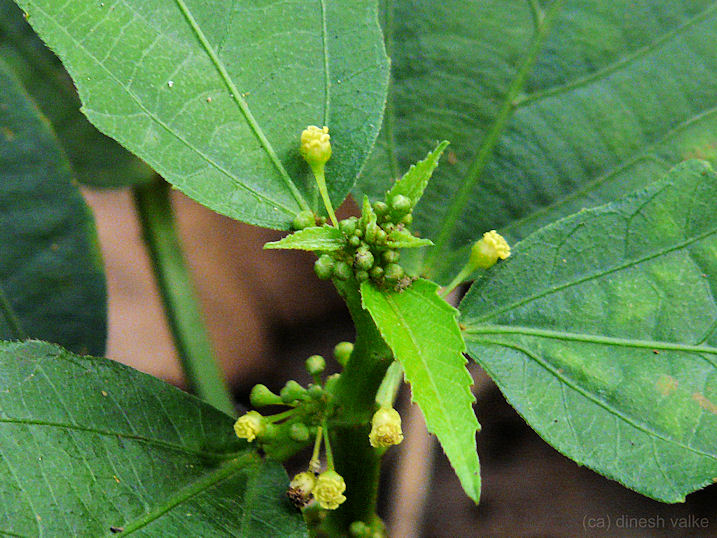
Abb.: दन्तिका । Baliospermum montanum (Willd.)
Muell. Arg. 1866, Maharashtra
[Bildquelle: dinesh_valke. --
http://www.flickr.com/photos/dinesh_valke/2935140760/. -- Zugriff am
2010-10-24. --
Creative
Commons Lizenz (Namensnennung, keine kommerzielle Nutzung, share alike)]
"Baliospermum montanum (Müller) N. O. Euphorbiaceae.
2.8.21. Trachyspermum ammi (L.) Sprague 1929 - Indischer Kümmel -
Kummel
Apiaceae (Doldenblütler)
|
10. c./d. ajamodā tūgragandhā
brahmadarbhā yavānikā अजमोदा तूग्रगन्धा ब्रह्मदर्भा यवानिका ॥१० ख॥ [Bezeichnungen für Trachyspermum ammi (L.) Sprague 1929 - Indischer Kümmel - Kummel:]
|
Colebrooke (1807):
[10.c.:] "Carui. Carum Carui [= Carum carvi L. 1753 - Wiesenkümmel - Caraway] : or according to some, synonymous with the following. Others confound it with Apium involucratum [Roxb. ex Flem. = Trachyspermum roxburghianum (de Candolle) H. Wolff 1927 = Trachyspermum involucratum (Roxburgh) Maire]."
[10.d.:] "Ajuen. Ligusticum Ajwaen, Roxb. [= Trachyspermum ammi (L.) Sprague 1929]"
1 ब्रह्मदर्भा - Brahma-Gras, Brahma-Darbha
darbha = Desmostachys bipinnata (L.) Stapf. 1900. Siehe Vers 31c./d.
2 यवानिका - yavānikā f.: Yavānikā (zu yavana m.: Ionier, Grieche)
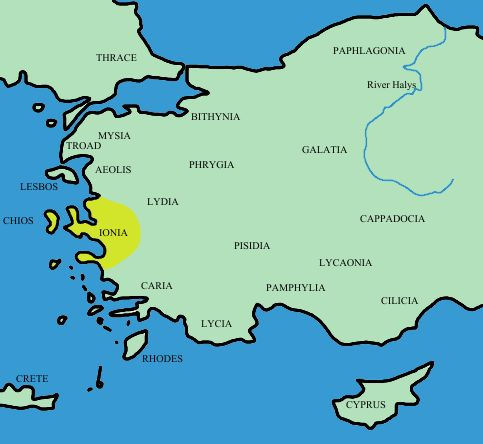
Abb.: Lage von Ionien (Ἰωνία / Ἰωνίη)
[Bildquelle: Roke / Wikimedia. -- GNU FDLicense]
Trachyspermum ammi (L.) Sprague 1929 - Indischer Kümmel - Kummel
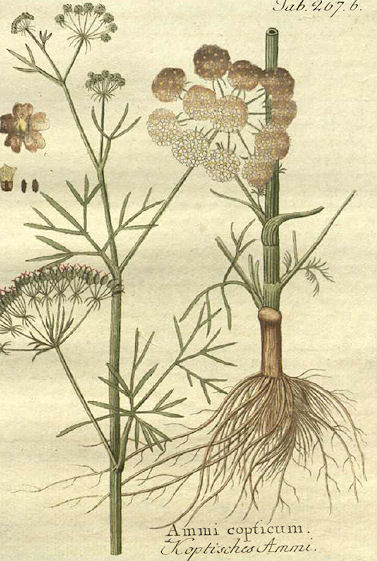
Abb.: Trachyspermum ammi (L.) Sprague 1929 - Indischer Kümmel -
Kummel
[Bildquelle: Icones
plantarum medico-oeconomico-technologicarum cum earum fructus ususque
descriptione =Abbildungen aller medizinisch-ökonomisch-technologischen
Gewächse mit der Beschreibung ihres Gebrauches und Nutzens. -- Wien, 1800 -
1822. -- Bd. 3, Tab. 267b]
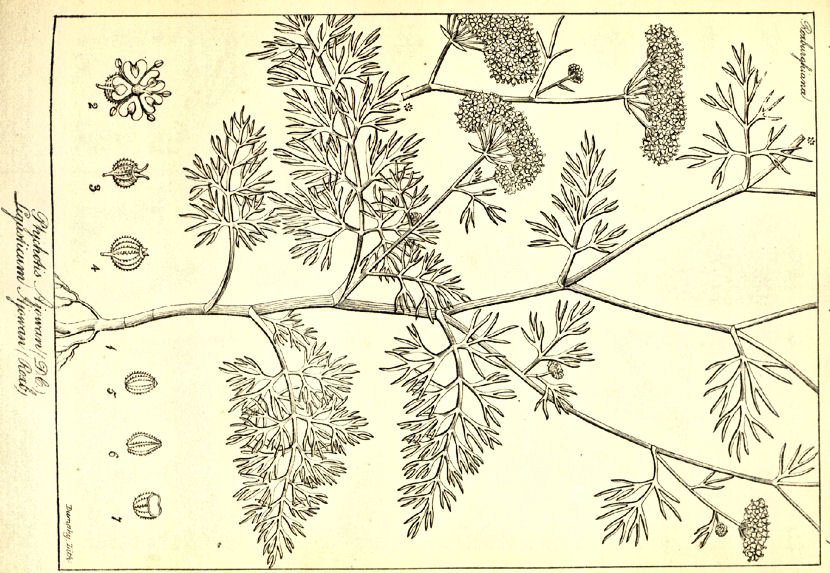
Abb.: Trachyspermum ammi (L.) Sprague 1929 - Indischer Kümmel -
Kummel
[Bildquelle: Wight Icones II, Tab. 566, 1843]
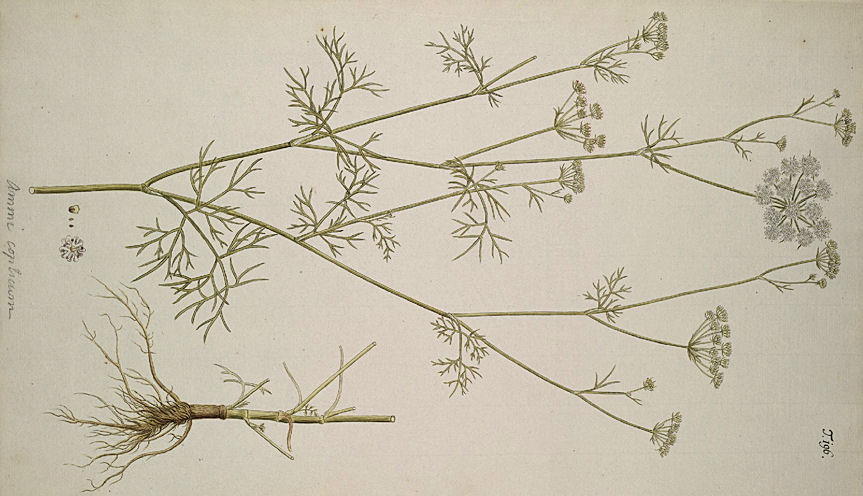
Abb.: Trachyspermum ammi (L.) Sprague 1929 - Indischer Kümmel -
Kummel
[Bildquelle: Hortus botanicus vindobonensis, seu, Plantarum rariorum, quae in
Horto botanico vindobonensi ... :coluntur, icones coloratae et succinctae
descriptiones / cura et sumptibus Nicolai Josephi Jacquin. -- Wien, 1770 - 1776.
-- Vol. 2, Taf. 196]
Bishops-weed Seed [...] Description.--Annual ; stem erect [...]
flowers white. Fl. Dec.—Jan. W. & A. Prod. i. 368.— Wight Icon. t. 566. Ligusticum ajowan, Flem.—Roxb. Fl. Ind. ii. 91.
Cultivated all over India. Medical Uses.—The seeds have an aromatic smell
and a warm pungent taste; they are much used by the natives for
medicinal and culinary purposes. They are small plants of the
Umbelliferous order, and are to be met with in every market of
India.—(Roxb.) The virtues of the seeds reside in a volatile oil.
They are stimulant, carminative, and antispasmodic; and are of much
value in atonic dyspepsia and diarrhoea. The preparation known as
omum-water is a valuable carminative, useful in disguising the taste
of nauseous drugs, and obviating their tendency to cause griping.
The fruits of the Ptychotis Roxburghianum are valued by the natives
as a stomachic and carminative. They partake of the properties of
the former, but in aroma are undoubtedly inferior.—(Pharm. of
India.) The wild plant is said to be poisonous. It probably contains
apiol, an oily liquid used as a substitute for quinine.—Powell's
Punj. Prod." [Quelle: Drury, Heber <1819 - 1872>: The useful
plants of India : with notices of their chief value in commerce, medicine, and
the arts. -- 2d ed. with additions and corrections. London : Allen, 1873. -- xvi,
512 p. ; 22 cm. -- s.v.] "CARUM COPTICUM, Benth. Fig.—Wight Ic., t. 566; Jacq. Hort. Vind, tt.
52, 200; Bentl. and Trim., t. 120. Bishop's weed, Lovage
Hab.—Africa, cultivated in India.
[...] History, Uses, &c.—A small African seed called
αμμι is described by Dioscorides (iii., 63); it had
an odour like origanon, was of a very hot and dry nature, and was
used as a carminative, &c. This seed was also called
βασιλικον κυμιον
or "king's cumin." A similar, if not identical drug is
mentioned by early Sanskrit writers under the name of
Yavāni or Yavānika, "of foreign origin," and appears to have
been one of several seeds to which the name Ajmoda was also
applied. In Persia also a similar seed was in use from a very
early date as a seasoning for bread, under the names of zhinian and nānkhāh, the latter name being a compound
of nan 'bread' and khāh 'relish.' Ibn Sina notices it under
the name of Nankhah, but does not identify it with any of the
kinds of cumin which he mentions. Pliny (20, 58,) says that
ammi and king's cumin are considered to be identical. Haji
Zein-el-Attar (A. D. 1368) identifies nankhah with the ammi
of Dioscorides and Paulus Aegineta, and quotes the opinions
of those physicians concerning its medicinal properties. He also
informs us that the drug has a reputation for its
antiseptic properties, and is used to promote the healing of foul sores,
and to remove the offensive odour of the discharges from them. The author of the Tuhfat-el-muminin, and
other Mahometan physicians, who have written in India,
identify Ajowan with the ammi or basilikon kuminon of
Dioscorides, and also with the zhinian and nānkhāh of Persia; they
give it the Arabic name of Kamūn-el-mulūki, "king's cumin." The authors of the Pharmacographia speaking
of Fructus Ajowan, remark : "Owing to their having been
confounded with some other very small umbelliferous
fruits it is difficult to trace them precisely in many of the older
writers on Materia Medica. It is however probable that they are
the Ammi of Anguillaria (1561), and the Ammi perpusillum
of Lobel (1571), in whose time the seeds were obtained from
Egypt. They are certainly the Ajave seeds of Percival (1773),
who obtained them from India." The plant is the Ptychotis
Ajowan of later European writers on Indian Materia Medica. In native practice, ajowan is much used as a
carminative, either alone or in combination with rock salt,
asafoetida, myrobalans, &c. It is also thought to check discharges of
a chronic kind, and is therefore used in making
lotions, collyria, &c.; upon the same principle it is prescribed
in bronchitis with copious expectoration. A plaster or poultice
of the crushed fruit is said to relieve pain. The Ark or
distilled water of ajowan is prepared and sold in the bazars,
and the stearopten under the name of Ajowan ke phūl (flowers of
ajowan) is prepared at Oojein and elsewhere in Central India, by exposing the
oil to spontaneous evaporation at a low temperature." [Quelle: Pharmacographia indica : a history of the principal drugs of
vegetable origin met with in British India / by William Dymock [1834-1892], C.
J. H. Warden and David Hooper [1858-1947]. -- Bd. 2. --
London, 1891. -- S. 116f.] Carum carvi L. 1753 - Wiesenkümmel - Caraway
"CARUM CARUI,
Linn. Fig.—Bentl. and Trim., t. 121.
Caraway
Hab.—Cashmir, Gurhwal, Persia.
[...] History, Uses, &c.—A kind of caraway called
Sushava and Krishna-jiraka (This name is also applied to the seeds of
Nigella sativa) or "black cumin" appears
to have been known to the Hindus before the introduction
into India of European caraway seeds. Royle is the first
European writer who notices Zeera seeah as a kind of caraway
imported from Kunawar, and as they are of a much darker
colour than ordinary caraways he named them Carum nigrum (Him.
Bot. 229). Stewart reduces Royle's C. nigrum to C.
Carui, and in this view he appears to be supported by Mr. C. B.
Clarke in the Flora of British India. The same variety of
caraway is known in Persia as Zireh-i-siyah, and as it is
principally cultivated in the neighbourhood of Kirman, is also called
Zireh-i-Kirmani. The European caraway is first mentioned by
the Arabians under the name of Carawiya. lbn Sina, Edrisi
and Ibn Baitar all treat of it as distinct from cumin. The
καρον
of the Greeks, so often identified with the caraway,
appears to have been quite a different plant, as it afforded
a root in common use as a vegetable which Paulus Aegineta classes
with parsnips and carrots. The Mahometan physicians derive
the name Karawiya or Kuruya from the Syrian Karui, and
give αρμενιον the Greek for caraways, a word applied by
Greek and Latin writers to several of the products of
Armenia. They describe the seeds as aromatic, carminative and
astringent; from them they prepare an eyewash, which is supposed to
strengthen the sight; they are also used as a pectoral, and
considered to be diuretic and anthelmintic. A caraway bath is
recommended for painful swellings of the womb, and a
poultice for painful and protruding piles." [Quelle: Pharmacographia indica : a history of the principal drugs of
vegetable origin met with in British India / by William Dymock [1834-1892], C.
J. H. Warden and David Hooper [1858-1947]. -- Bd. 2. --
London, 1891. -- S. 119f.] Trachyspermum involucratum (Roxb.) Maire
[Quelle:
http://flora.huh.harvard.edu/china/PDF/PDF14/Trachyspermum.pdf.
-- Zugriff am 2011-01-11
Iris: Iridaceae (Schwertliliengewächse)
मूले पुष्कर-काश्मीर-पद्मपत्राणि पौष्करे ।११ क।
Bezeichnungen für die Wurzel von पुष्कर - puṣkara: Iris x germanica L. 1753 - Schwertlilie - Common Iris oder
Inula racemosa Hook. f. 1881: Colebrooke (1807): "Costus. Costus speciosus [(J. König) Sm.
1791 - Prächtige Kostwurz - Malay Ginger] ?" Siehe: IV.
Vers 14.a./b. 1 काश्मीर
- kāśmīra n.: aus Kaśmīra Stamnmendes, Kaśmīrer kaśmīra m.: Königreich und Volksstamm,
wohnhaft im heutigen Tal von Kashmir
2 पद्मपत्र
- padmapatra n.: Lotusblatt padma m. n. = Nelumbo
nucifera Gaertn. - Indische Lotusblume
Iris x germanica L. 1753 - Schwertlilie - Common Iris
Fig.—Bot. Mag.,
t. 670; Bot. Reg., t. 818. Orris root Hab.—Central and Southern Europe, Northern India, and Persia.
[...] History, Uses, &c.—We have already stated (Vol. II., p. 296)
that we consider Orris root to be the Pushkara-m Iris root is considered by Mahometan hakīms to be deobstruent,
aperient, diuretic, especially useful in removing bilious obstructions. It is
also used externally as an application to small sores and pimples. Fro, the
large number of diseases in which this drug is recommended it would appear to be
regarded as a panacea. Description.—Eastern orris root differs from the European
drug, inasmuch as the bark of the rhizome has not been removed; it is also
smaller and of a darker colour." [Quelle: Pharmacographia indica : a history of the principal drugs of
vegetable origin met with in British India / by William Dymock [1834-1892], C.
J. H. Warden and David Hooper [1858-1947]. -- Bd. 3. --
London, 1893. -- S. 451f.] Costus speciosus (J. König) Sm. 1791 - Prächtige Kostwurz - Malay
Ginger
"Costus speciosus. Smith in Trans, of Linn. Soc.
1. 240. Linn. sp. pl. ed. Willd. 1. 11. [...] Tjana-Kua. Rheed. Mal. 11. p. 15.
f. 8. Tsiana speciosa, Gmel. 9. Herba spiralis hirsuta. Rumph. Amb. 6. p.
143. t. 64. f. 1. Suns. Kemooka. Banksia speciosa of Dr. König, See Retz. Obs.
4. 75. This is one of the most elegant looking
plants of the natural order Scitaminea. It is a native of moist
shady places, such as the low banks of water courses, &c.
Flowers during the wet season. [...] The fresh roots are almost insipid. The
natives make a preserve of them, which they deem wholesome,
and nutritious ; the dry root does not at all resemble the
Costus arabicus of the shops." [Quelle: Roxburgh, William <1751-1815>:
Flora indica, or, Descriptions of Indian plants / by the late
William Roxburgh. -- Serampore : Printed for W. Thacker, 1832. --
Vol. 1, S. 58f.] [...] Description.—Height 3-4 feet,
spirally ascending; [...] flowers large, pure white. Fl. July—Sept.—Roxb. Fl. Ind.
ed. Car. i. 58.— Wight Icon. t. 2014. C. Arabicus, Linn. Amomum hirsutum, Lam.—Rheede,
xi. t. 8. Coromandel. Concans. Bengal. Economic Uses.—A very elegant
plant, found chiefly near the banks of rivers and other moist and
shady places. A kind of preserve is made from the roots, which the
natives deem very wholesome. They are insipid.—Roxb." [Quelle: Drury, Heber <1819 - 1872>: The useful
plants of India : with notices of their chief value in commerce, medicine, and
the arts. -- 2d ed. with additions and corrections. London : Allen, 1873. -- xvi,
512 p. ; 22 cm. -- s.v.] "Costus Speciosus, Sm.; Lam. Ill. i., t. 3 ;
Rheede, Hort. Mai xi., t. 8. [...] Kemuka (sans.) Roxburgh notices a preserve
made of the fresh roots which is considered wholesome and
nutritious. C. speciosus is the Tjana-kua of Rheede and
the Herba spiralis hirsuta of Rumphius. Ainslie, quoting Brown's
History of Jamaica, says that the root is there used as
a substitute for ginger, but is very inferior to it. (Mat.
Ind. ii., 167.) In the Calcutta Exhibition Catague the root is described as depurative and aphrodisiac; similar properties are
attributed to it in the Concan, where it is very abundant in
moist situations. The rhizome resembles the great Galangal in
growth and structure, but has no aromatic properties, the taste
being mucilaginous and feebly astringent; it could only be used
as a substitute for ginger by being preserved with a quantity of
that root sufficient to flavour it." [Quelle: Pharmacographia indica : a history of the principal drugs of
vegetable origin met with in British India / by William Dymock [1834-1892], C.
J. H. Warden and David Hooper [1858-1947]. -- Bd. 3. --
London, 1893. -- S. 427.] Hybanthus: Violaceae (Veilchengewächse)
अव्यथातिचरा पद्मा चारटी पद्मचारिणी ॥११ ख॥
[Bezeichnungen für Hybanthus enneaspermus (L.) F. v. Muell. 1876 - Spade
Flower oder Hibiscus mutabilis L. - Filziger Roseneibisch - Cotton Rose:] Colebrooke (1807): "Sthalapadma. Hibiscus mutabilis." Hybanthus enneaspermus (L.) F. v. Muell. 1876 - Spade Flower
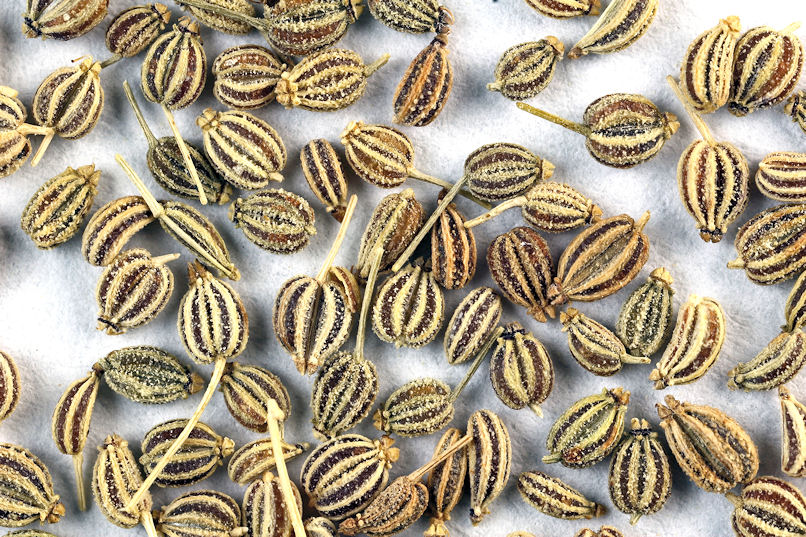
Abb.: Trachyspermum ammi (L.) Sprague 1929 - Indischer Kümmel / Ajowan - Kummel
[Bildquelle: Sanjay Acharya / Wikipedia. -- GNU FDLicense]
"Ptychotis ajowan (Dec.) [=
Trachyspermum ammi (L.) Sprague 1929] N. O. Apiaceae
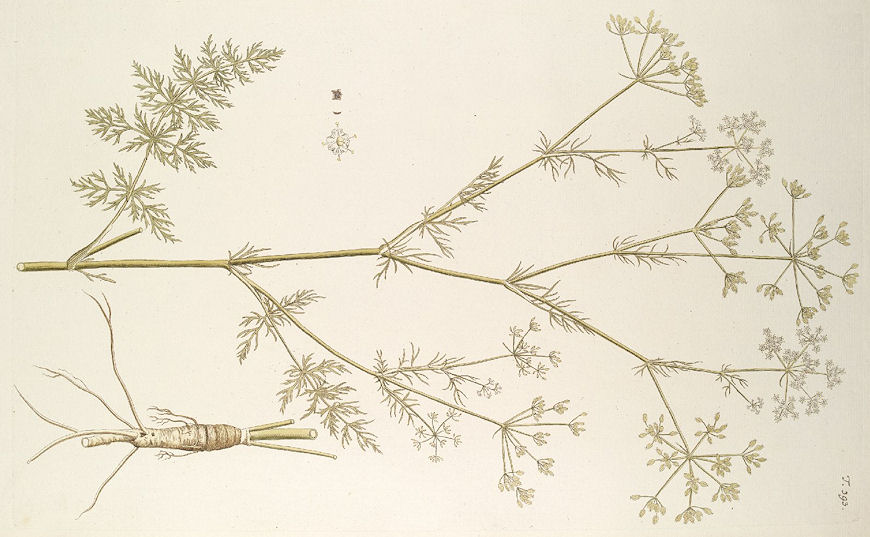
Abb.: Carum carvi L. 1753 - Wiesenkümmel - Caraway
[Bildquelle: Florae Austriacae, sive, Plantarum selectarum in Austriae
archiducatu :sponte crescentium icones, ad vivum coloratae, et descriptionibus,
ac synonymis illustratae / opera et sumptibus Nicolai Josephi Jacquin. -- Wien,
1773-1778. -- Vol 4, Taf. 393.] 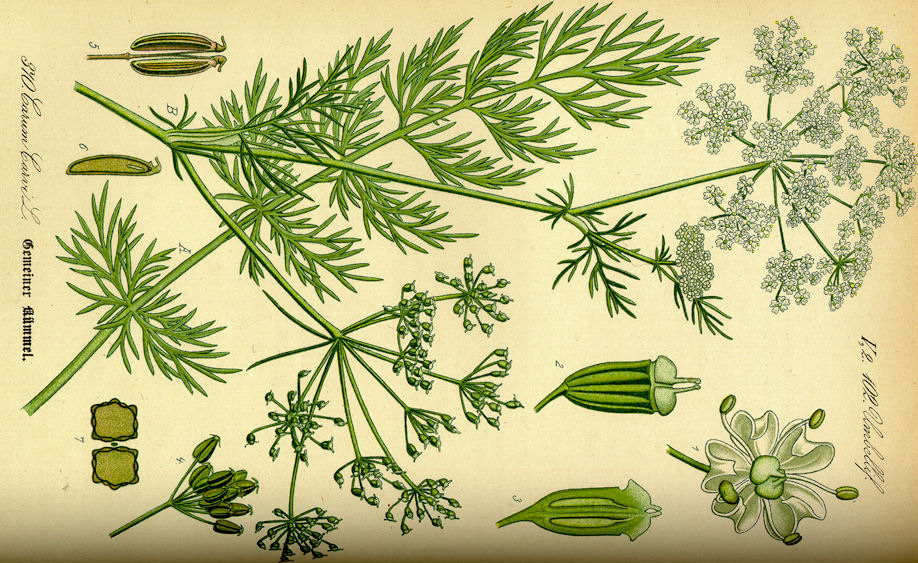
Abb.: Carum carvi L. 1753 - Wiesenkümmel - Caraway
[Bildquelle: Köhler, 1883-1914]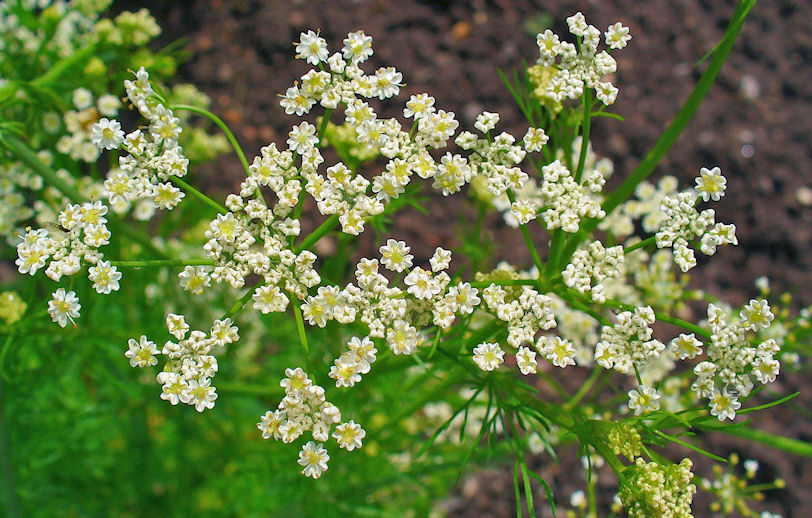
Abb.: Carum carvi L. 1753 - Wiesenkümmel - Caraway,
Deutschland
[Bildquelle: H. Zell / Wikimedia. -- GNU FDLicense]
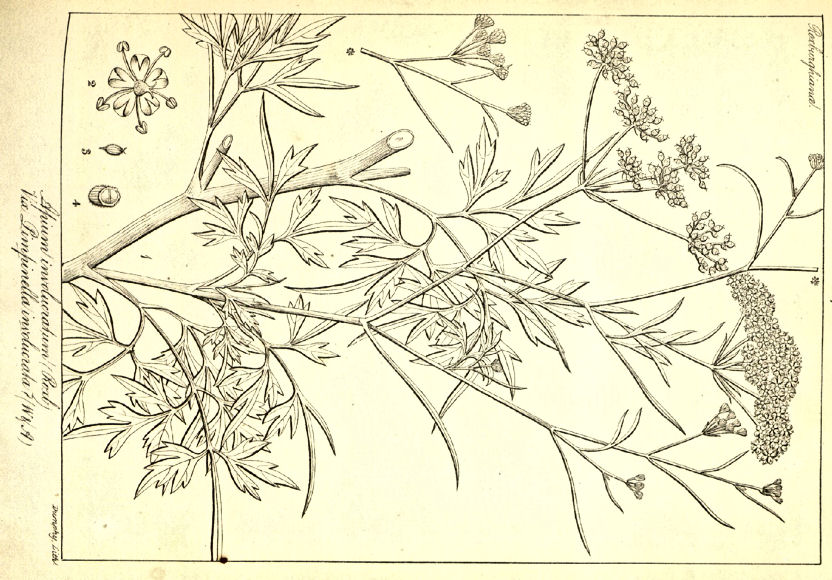
Abb.:
Trachyspermum involucratum (Roxb.) Maire
[Bildquelle: Wight Icones II, Tab. 567, 1843]
"This species cultivated as a spice
throughout the Indian subcon-tinent, SE Asia, and Indonesia."
2.8.22. Iris x germanica L. 1753 - Schwertlilie - Common Iris oder
Inula racemosa Hook. f. 1881
Inula: Asteraceae (Korbblütler)
11. a./b. mūle puṣkara-kāśmīra-padmapatrāṇi pauṣkare
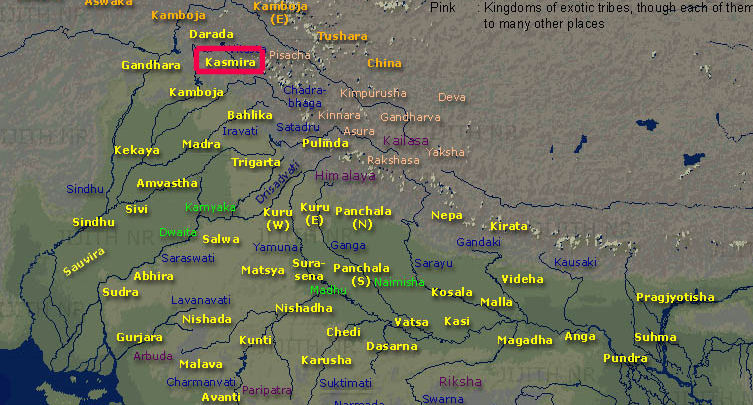
Abb.: Lage von kaśmīra
[Bildquelle: JIJITH NR / Wikimedia. -- GNU FDLicense]
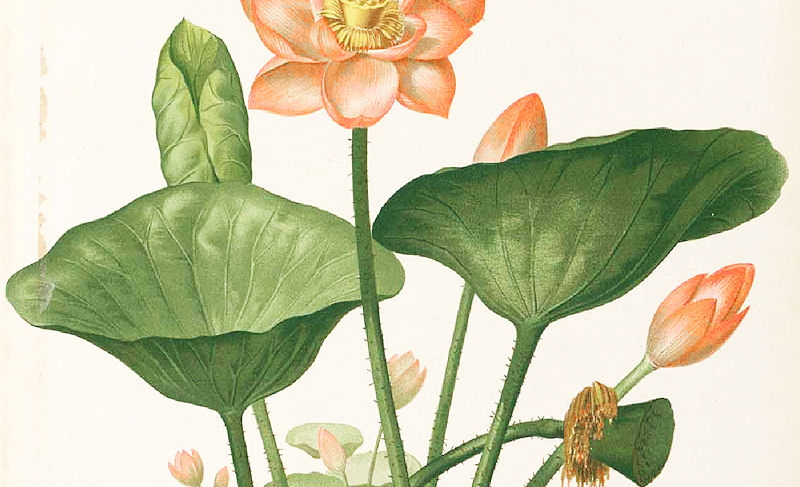
Abb.: Blätter von Nelumbo nucifera Gaertn. - Indische
Lotusblume
[Bildquelle: Flora de Filipinas, 1880 / Wikimedia. -- Public domain]
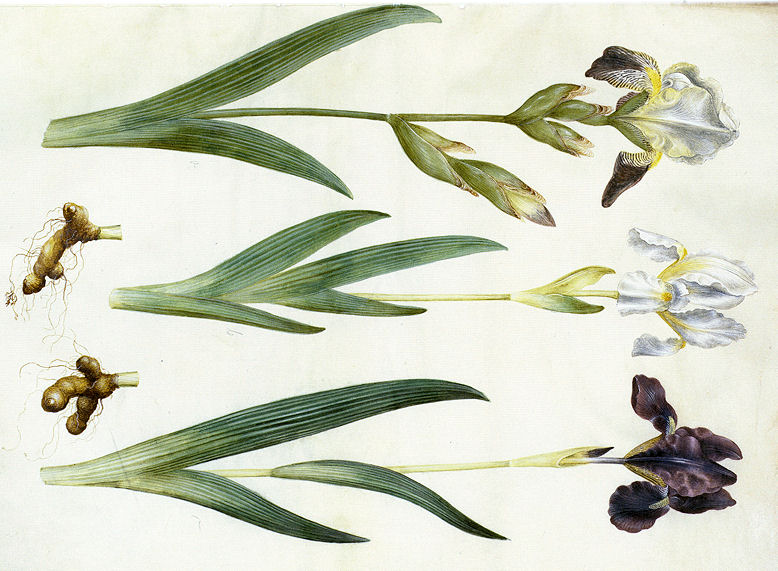
Abb.: पुष्करं
। पुष्करम्
। Iris x germanica L. 1753 - Schwertlilie - Common Iris
[Bildquelle: Hans-Simon Holtzbecker 1649 / Wikimedia. -- Public domain]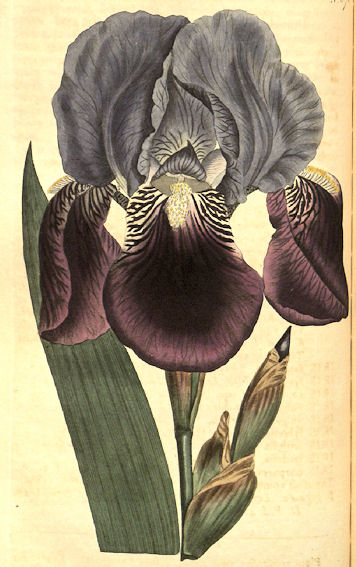
Abb.: Iris x germanica L. 1753 - Schwertlilie - Common Iris
[Bildquelle: Curtis's Botanical Magazine, v. 18 (1803), Tab. 670]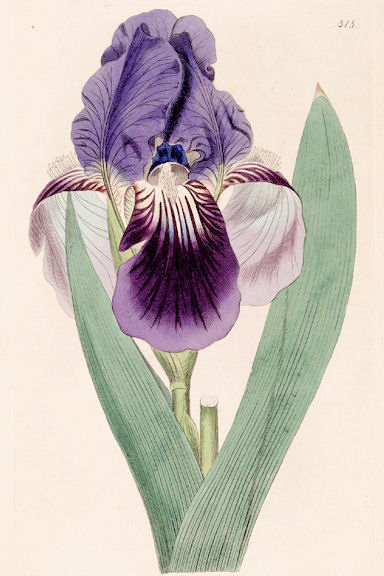
Abb.: पुष्करं
। Iris nepalensis = Iris x germanica L. 1753 - Schwertlilie - Common Iris
[Bildquelle: The Botanical register, v. 10 (1824), Pl. 818.]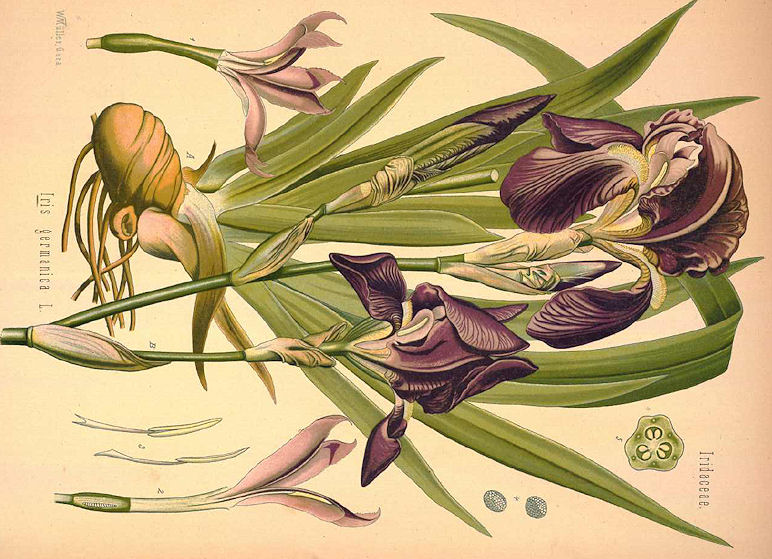
Abb.: Iris x germanica L. 1753 - Schwertlilie - Common Iris
[Bildquelle: Köhler, 1883-1914]
"IRIS GERMANICA, Linn.
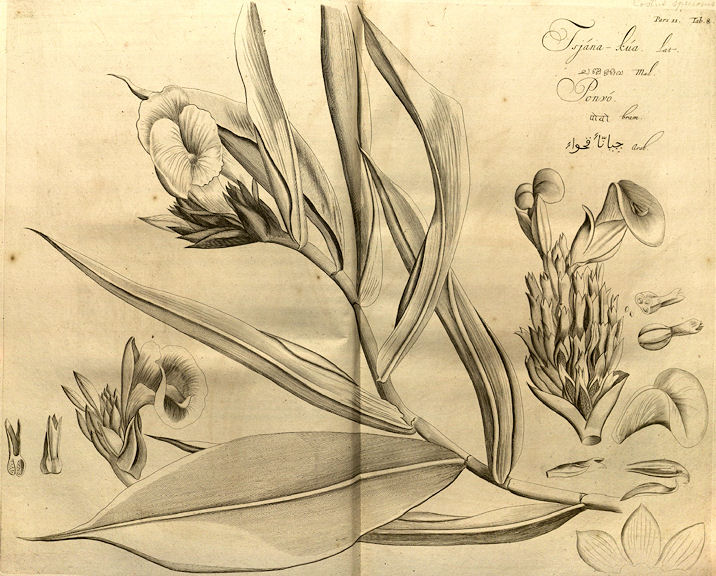
Abb.: Costus speciosus (J. König) Sm. 1791 - Prächtige Kostwurz - Malay
Ginger
[Bildquelle: Hortus malabaricus XI. Fig. 8,
1692]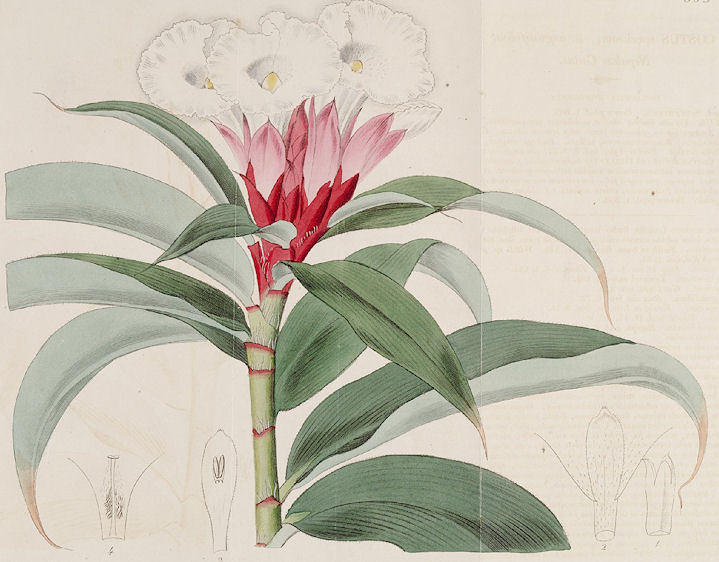
Abb.: Costus speciosus (J. König) Sm. 1791 - Prächtige Kostwurz - Malay
Ginger
[Bildquelle: The Botanical register, v. 8 (1822), Pl. 665.]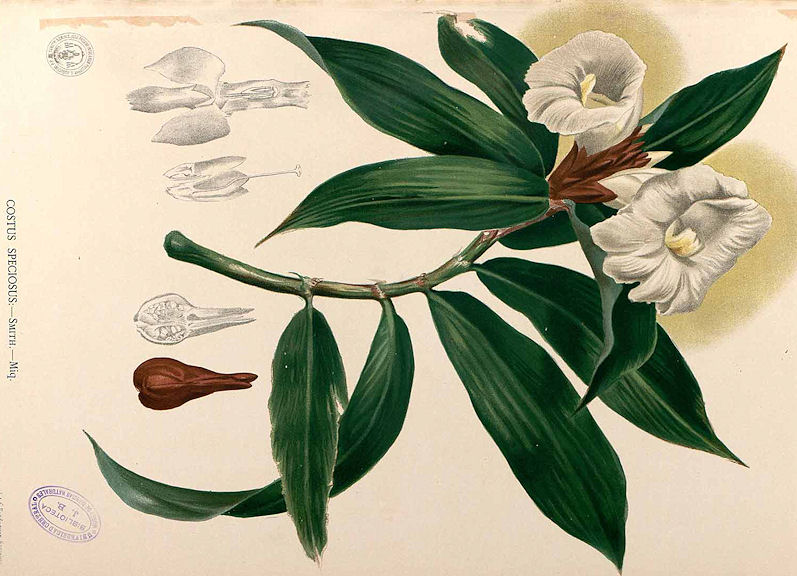
Abb.: Costus speciosus (J. König) Sm. 1791 - Prächtige Kostwurz - Malay
Ginger
[Bildquelle: Flora de Filipinas, 1880 / Wikimedia. -- Public domain]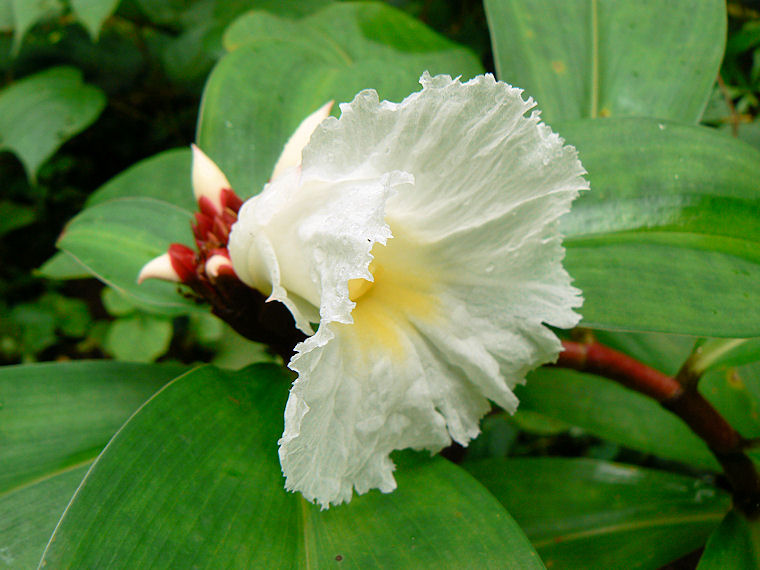
Abb.: Costus speciosus (J. König) Sm. 1791 -
Prächtige Kostwurz - Malay Ginger, Maharashtra
[Bildquelle: dinesh_valke. --
http://www.flickr.com/photos/dinesh_valke/1081982588/ . -- Zugriff am
2010-11-25. --
Creative
Commons Lizenz (Namensnennung, keine kommerzielle Nutzung, keine
Bearbeitung)]
"Costus speciosus
(Sm.) N. O. Zingiberaceae.
2.8.23. Hybanthus enneaspermus (L.) F. v. Muell. 1876 - Spade Flower
oder Hibiscus mutabilis L. - Filziger Roseneibisch - Cotton Rose
Hibiscus: Malvaceae (Malvengewächse)
11. c./d. avyathāticarā padmā cāraṭī padmacāriṇī
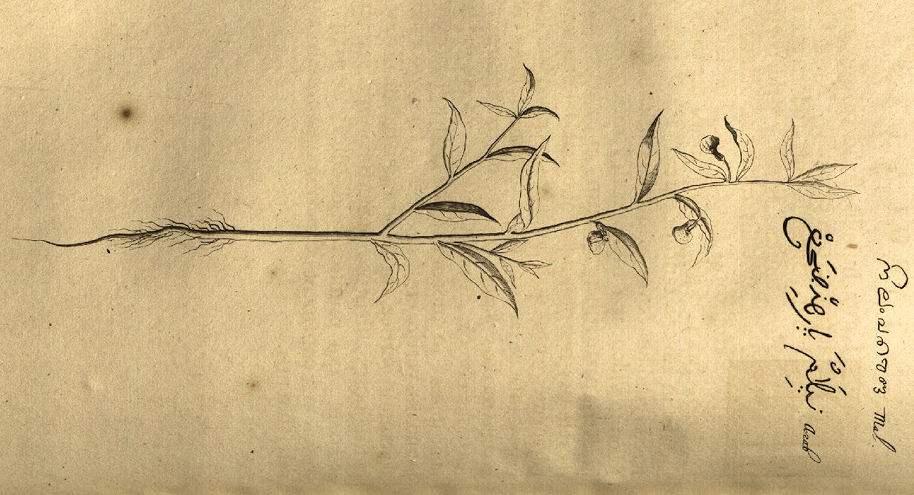
Abb.: Hybanthus enneaspermus (L.) F. v. Muell. 1876 - Spade Flower
[Bildquelle: Hortus malabaricus IX. Fig. 60,
1689]
"lonidium enneaspermum. Vent. Viola enneasperma. Lin. Quoted for the Viola enneasperma by Linnaeus, and by all other authors except Wight and Arnott, who consider it to be the Linnean V. suffruticosa, which may probably be nothing more than a variety, and in the late General Hardwick's copy, the following remark is written on this plate, 'Planta plerumque procumbens, in montosis tamen saepe erecta est.' There is not any specimen of V. suffruticosa in the Linnean Herbarium." [Quelle: Dillwyn, L. W. (Lewis Weston) <1778-1855>: A review of the references to the Hortus malabaricus of Henry Van Rheede Van Draakenstein [sic]. -- Swansea : Printed at the Cambrian-Office, by Murray and Rees, 1839. -- zu dieser Abb.]
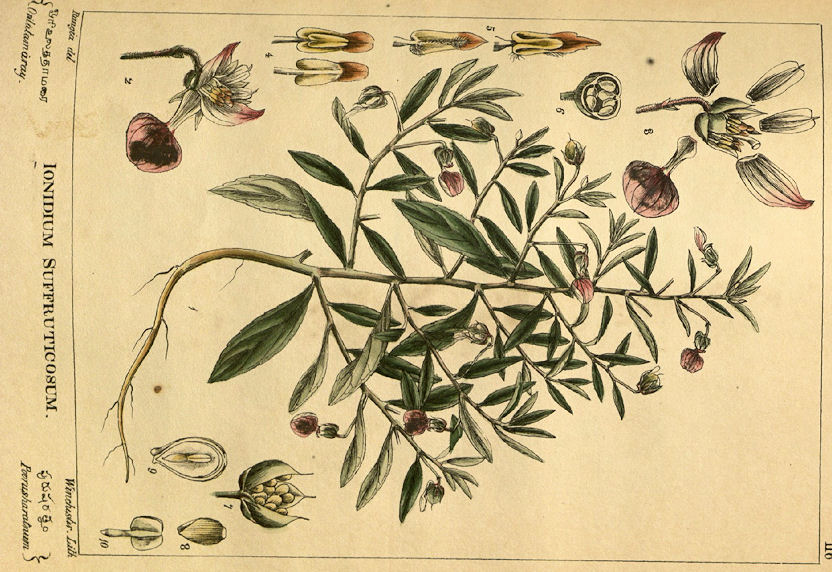
Abb.: Hybanthus enneaspermus (L.) F. v. Muell. 1876 - Spade Flower
[Bildquelle: Wight: Illustrations I, Tab. 19,
1840]
[...] Description.—Perennial; stem scarcely any; [...]
flowers small, rose-coloured. Fl. Nearly all the year. W. & A. Prod. p. 32, 33.—Wight Icon,. t.
308. Viola suffruticosa, Linn.—Roxb. Fl. Ind. i 649. —Rheede,
ix. t. 60. Peninsula. Travancore. Medical Uses.—The root in infusion is diuretic,
and is a remedy in gonorrhoea and affections of the urinary organs.
The leaves and tender stalks are demulcent, and are used in
decoction and electuary, and also employed, mixed with oil, as a
cooling liniment for the head.—(Ainslie.) It may not be unworthy of
remark that a species of this family of plants, the I. parviflorum (
Viola parviflora, Linn.), is used as an undoubted specific in
Elephantiasis in South America. It is there known as Cuichanchulli.
For instances of its effects see Curtis (Comp. to) Bot. Mag. i.
278." [Quelle: Drury, Heber <1819 - 1872>: The useful
plants of India : with notices of their chief value in commerce, medicine, and
the arts. -- 2d ed. with additions and corrections. London : Allen, 1873. -- xvi,
512 p. ; 22 cm. -- s.v.] "IONIDIUM SUFFRUTICOSUM, Ging. Fig. —Wight. Ill., t. 19; Ic. t. 308. Hab.—Tropical Asia, Africa and Australia.
[...] History, Uses, &c.—In Southern India this
plant is considered to be one of the two kinds of
Chārati mentioned by Sanskrit writers, a synonym for which is
Padma-charinī. The native physicians regard it as a tonic
and diuretic, and prepare a paka or confection of the whole
plant. Twenty to sixty grains of the plant are administered
in each dose. Rheede and Ainslie mention Chārati. According
to the latter writer, the leaves and tender stalks
are demulcent and are used by the natives in decoction and
electuary, and also employed in conjunction with some mild oil,
in preparing a cooling liniment for the head. The plant is
more or less known for its medicinal properties from Agra
to Ceylon, and is often used in Southern India as a
demulcent in gonorrhoea, and its demulcent properties are known in N.
S. Wales, where the plant is common. Description.—The drug as sold in the shops
consists of the root and some of the leafy portion of
the plant attached to it" [Quelle: Pharmacographia indica : a history of the principal drugs of
vegetable origin met with in British India / by William Dymock [1834-1892], C.
J. H. Warden and David Hooper [1858-1947]. -- Bd. 1. --
London, 1890. -- S. 139.]
Confederate roses tend to
be shrubby or treelike in Zones 9 and 10, though it behaves more
like a perennial further north. Flowers can be double or single
and are 4 to 6 inches in diameter; they open white or pink, and
change to deep red by evening. The 'Rubra' variety has red
flowers. Single blooming flowers are generally cup-shaped. Bloom
season usually lasts from summer through fall. Propagation by
cuttings root easiest in early spring, but cuttings can be taken
at almost any time. When it does not freeze, the Confederate
rose can reach heights of 15 to 18 feet with a woody trunk;
however, a much bushier, 5 or 6 feet plant is more typical and
provides more flowering. These plants have a very fast growth
rate. The Confederate rose was at one time very common in the
area of the Confederate States of America, which is how its
common name was derived. It grows well in full sun or partial
shade, and prefers rich, well-drained soil.[1] Uses Leaves and flowers of
H. mutabilis are emollient and cooling, and are used to
treat swellings and skin infections (Dasuki, 2001). Mucilage
from flowers and leaves is used by midwives to facilitate
delivery during labour. Floral colour change Flowers are white in
the morning, turning pink during noon and red in the evening of
the same day. Under laboratory conditions, colour change of
petals was slower than that of flowers under outdoor conditions
(Wong et al., 2009). Temperature may be an important
factor affecting the rate of colour change as white flowers kept
in the refrigerator remain white until they are taken out to
warm, whereupon they slowly turn pink (Ng, 2006). The red flowers remain
on plants for several days before they abort (Wong et al.,
2009). Weight of a single detached flower was 15.6 g when white,
12.7 g when pink and 11.0 g when red. Anthocyanin content of red
flowers was 3 times that of pink flowers and 8 times that of
white flowers. There was a significant increase in phenolic
content with colour change. Overall ranking of AOP of H.
mutabilis flowers was red > pink > white." Subramanian and Nair
(1970) postulated that anthocyanins in pink and red flowers of
H. mutabilis are synthesized independently since there is
no reduction in phenolic content. However, Lowry (1976)
suggested that anthocyanins are formed through direct conversion
from flavonols as they have structural similarities." [Quelle:
http://en.wikipedia.org/wiki/Hibiscus_mutabilis. -- Zugriff
am 2011-01-11] Euphorbiaceae (Wolfsmilchgewächse)
काम्पिल्लः कर्कशश् चन्द्रो रक्ताङ्गो रोचनीत्य् अपि ।१२
क।
[Bezeichnungen für Mallotus philippensis (Lam.) Muell. Arg. 1865 - Red
Kamala:] Colebrooke (1807): "Śundā-rochani. Crinum [Hakenlilie] ?" Siehe auch Amarakośa II.2. Vers 6./b. Mallotus philippensis (Lam.) Muell. Arg. 1865
[...] Description.—Small tree or under-shrub; [...] Dec., Prod. xv. s. 2, p. 980. Rottlera tinctoria, Roxb.
Common almost everywhere. Medical Uses.—The mealy powder covering the
capsules yields a dye called Kamila dye, which is used as a
vermifuge, and whose action, according to Dr Royle, depends on the
minute stellate hairs found in the powder. Kamila is the powder
rubbed off the capsules, and which is also found, though in smaller
quantities, on the leaves and stalks of the plant. The powder is of
a rich red colour, and has a heavy odour. Economic Uses.—The dye is used all over India,
especially for silk, to which it imparts a fine yellow colour. It is
rarely used for cotton. When the capsules are ripe in February or
March they are gathered; the red powder is carefully brushed off and
collected for sale, no preparation being necessary. This substance
is scarcely acted on by water, and has no particular taste. To
spirit it gives a rich deep orange, inclining to red. Neither spirit
nor alkaline solution dissolves it, for the minute grains of powder
are seen adhering to the sides of the vessels if shaken, about the
size of small grains of sand. Alum added to the alkaline infusion
renders the colour more bright and permanent. The Hindoo silk-dyers
use the following method :—Four parts of powder, one of powdered
alum, two of salts of soda (sold in the bazaars), rubbed well
together with a small quantity of oil of sesamum. When well mixed it
is boiled in water proportionate to the silk to be dyed, and kept
boiling smartly, according to the shade required, turning the silk
frequently to render the colour uniform. Of the dye which is called
Cupela-Rung in Hindustanee, the jurors at the Madras Exhibition
reported as follows:— " The tree is widely spread over the Madras
Presidency, and large supplies of the dye might be easily obtained.
The colouring matter does not require a mordant, all that is
necessary being to mix it with water containing about half its
weight of carbonate of soda. On silk the colour is a rich flame or
orange tint of great beauty and extreme stability;" and "the fact
that the material supplied by commerce contains between 70 and 80
per cent of real colouring matter ought to induce the silk-dyers of
this country to turn their attention to it."*—Roxb. Jury Rep. Mad.
Exhib. *For a careful report on the
colouring matter, see Anderson in Ed. Phil. Jour., April 1858;
and for its vermifuge properties, see Indian Annals of Medical
Science. Also a valuable paper by D. Hanbury in the Pharm.
Journal." [Quelle: Drury, Heber <1819 - 1872>: The useful
plants of India : with notices of their chief value in commerce, medicine, and
the arts. -- 2d ed. with additions and corrections. London : Allen, 1873. -- xvi,
512 p. ; 22 cm. -- s.v.]
Fig.—Bentl. and Trim., t. 236; Bedd. Fl. Sylv., t. 289; Roxb. Cor.
Pl. ii., t. 168; Rheede, Hort. Mal. v., 21, 24. Hab.—Throughout Tropical India.
[...] History, Uses, &c.—The glandular powder obtained
from this plant has been used as a dye in India from a very remote
period. It was probably collected, as at the present time, by the
aboriginal tribes, who call it Ruhin, before the Hindus invaded
India. In Sanskrit it is known as Kampilla, and bears the synonyms
of Rochanika, Rochana-rakta and Lohita-rakta, in allusion to its red
colour. In the Nighantas it is described as useful in removing
phlegm, bile, stone, worms, enlarged glands, boils, &c., and the
leaves are said to be astringent and cooling. In the Bhavaprakasa
one tola with treacle is said to kill and expel all intestinal
worms. It is also proscribed for worms in combination with the seeds
of Embelia Ribes (vaverang), chebulic myrobalans, carbonate of
potash, and rock salt. (Chakradatta.) The Arabs became acquainted
with Kampilla at an early date, and through them it appears to have
reached Europe, and to have been known to the later Greek physicians
about the 7th century. Ibn Massowiyeh, physician to the Caliph
Haroon-el-Raschid, speaks of it as highly astringent, a good
anthelmintic, and a useful application to moist eruptions of the
skin, which it soon dries up. It is also mentioned by Rāzi, Tamimi,
Baghdādi, Ibn Sina, Ibn Baitar and others, all of whom appear to
have been in much doubt as to its nature, but distinguish it from
Wars, a product of Arabia, the source of which they were acquainted
with, Ibn Sina says of Kanbīl:—" It is in grains like sand, red, but
less so than Wars, hot and dry in the third degree; Ibn Massowiyeh
considers to be highly astringent; it kills worms and flukes of the
intestines and expels them." Of Wars, he says :—"It is a substance
like powdered saffron, of an intense red colour, brought for sale
from Yemen; they say that it is scraped from a plant; it is hot and
dry in the third degree, astringent; a useful application to
pimples, freckles, &c." (A number of skin eruptions are named, the
exact nature of which is doubtful.) The author of the Makhzan, who wrote in India
(1770), is strangely ignorant of the source of this drug. He says:—
" Kinbīl is an Arabic form of the Persian Kampilla and Hindi Kamila";
he then recapitulates the various opinions held as to the source of
the drug, and concludes by saying: "I have heard that it is the pulp
of the fruit of a mountain-tree like the Ma'asfar, but its leaves
are rather larger, and it is armed with long stiff thorns, and has
fruit like a lime, which is green when young and red when ripe; when
ripe it bursts open and a dull-red substance escapes and falls on
the ground : this is collected, and is Kinbīl." Regarding its
properties, he says that in doses of from 1 to 2 dirhems rubbed into
an emulsion with any suitable vehicle it expels all kinds of
intestinal worms, and at the same time acts as a purgative. Speaking
of Wars, the same author says that there is a black kind, which
comes from Ethiopia, and is called 'Habshi,' and a dull-red kind
which is called Indian, and is the worst (as a dye); he concludes by
saying the seeds of the Wars are like Mash (Phaseolus radiatus).
There is no mention of its use as an anthelmintic; it is described
as an aphrodisiac, lithontriptic, and remedy for ringworm,
pityriasis and freckles. Sprengel thought that the source of Wars
was Memecylon tinctorium. (Confer. Hist. Med., t. II., p. 444, ed.
tert.; also Hist. rei Herb., t. I., p. 258,) Rheede first figured and described the plant; he
states that the leaves, fruit and root with honey are applied to
poisoned bites, bruises, &c. Buchanan (Journey through Mysore in
1801) notices Kamala ; it has also been noticed by Ainslie, Roxburgh,
and Royle, but Mackinnon of Bengal, in 1858, was the first to
introduce it into European practice in India ; since then it has
been used with success by many medical men in India and Europe.
Previous to this, Vaughan had sent Kamala to Hanbury from Aden under
the name of Wars, and had described its use as a dye, and as a
remedy in certain skin diseases. (Pharm. Journ., Vol. xii., p. 886,
1853.) The true Arabian Wars does not appear to have attracted
attention in Europe until 1867, when it was imported by Messrs.
Allen and Hanburys of London. The source of Wars remained unknown
until 1884, when it was ascertained to be the glands of the pod of
Flemingia Grahamiana, a leguminous plant common in Arabia and India.
(See Flemingia.) As noticed in the Pharmacographia, the names
Kanbīl and Kamāla are not in use in the bazars at Aden; the Indian
Kamāla being now commonly known there as Wars. The dose of Kamāla is from one to two drachms, or
one to three fluid drachms of a saturated tincture may be employed ;
it does not cause much nausea, colic, or purging. The parasite is
generally discharged dead, and it appears to be equally efficacious
in removing all kinds of worms. The dose should be repeated several
times at intervals of about three hours. Description.—Kamāla is a red powder, which varies
in depth of colour, mixed with it are greenish-yellow fragments of
the capsule of the plant; like lycopodium it is inflammable and
resists admixture with water. Alcohol and ether dissolve a
considerable portion of it, and the solution poured in water emits a
melon-like odour." [Quelle: Pharmacographia indica : a history of the principal drugs of
vegetable origin met with in British India / by William Dymock [1834-1892], C.
J. H. Warden and David Hooper [1858-1947]. -- Bd. 3. --
London, 1893. -- S. 296ff.] Crinum asiaticum L. 1753
"Crinum Asiaticum (Willd.) N. O.
Amaryllidaceae. [...] Description.—Stemless; [...] Fl. Oct.—Dec. Boxb. Fl. Ind. ii. 129 C. defixum, Bot. Mag. 2208.—Rheede, Mai. xi. t.
38. Both Concans. Medical Uses.—The leaves, bruised and mixed with
castor-oil, are useful in whitlows and local inflammations of the
kind. In Upper India the juice of the leaves is given in ear-ache.
In Java the plant is reckoned a good emetic, and it is also
considered of efficacy in curing wounds made by poisoned arrows. The
root, sliced and chewed, is emetic. The C. toxicarium is a variety
indigenous to both Concans, and of which Dr O'Shaughnessy found by
experiments the leaves to be equal as an emetic to the best
ipecacuanha; but recommended its only being resorted to when the
latter cannot be procured. The plant is found on the banks of rivers
and in marshy places, and flowers nearly all the year.—Boxb. J. Grah.
Ainslie. O'Shaughnessy." [Quelle: Drury, Heber <1819 - 1872>: The useful
plants of India : with notices of their chief value in commerce, medicine, and
the arts. -- 2d ed. with additions and corrections. London : Allen, 1873. -- xvi,
512 p. ; 22 cm. -- s.v.]
Fig.—Bot. Mag., tt. 1073, 2908, 2239; Wight Ic., t. 2021 ; Rheede,
Hort. Mal. xi., t. 38; Bentl. and. Trim. t. 275. Hab.—Concan. Cultivated throughout India.
[...] History, Uses, &c.—This plant is not mentioned by
Sanskrit writers on Materia Medica, but the juice of the leaves
after they have been slightly roasted is a popular remedy in
Hindustan for earache. The name Sukhdarshan, " pleasant to the
sight," is loosely applied to several species of Crinum in most
parts of Northern India. In the Concan the leaves smeared with
mustard oil or Mutel (the oil obtained from fresh rasped cocoanuts)
are warmed and bound round inflamed joints. Rheede says:—Ex planta
concisa et tosta bini sunt noduli, qui utrinque maxillaa appositi,
spasmum curant cynicum." Ainslie states that the natives of Southern
India bruise the leaves and mix them with a little castor oil, so
forming an application which they think useful for repelling
whitlows and other inflammations that come at the ends of the toes
and' fingers ; also that the juice of the leaves is employed for
earache in Upper India. Rumphius, who calls it Radix toxicaria,
speaks highly of its virtues in curing the disease occasioned by the
poisoned arrows of the Macassers in their wars; the root chewed is
emetic, provided a little of the juice is swallowed. Crinum
asiaticum is the Man-sy-lan of the Cochin-Chinese, and its virtues
are lauded by Loureiro. (Ainslie, Mat. Ind. vol. II., p. 464.) Sir
W. O'Shaughnessy remarks (Bengal Disp., p. 656) that this is the
only indigenous and abundant emetic plant, of which he has
experience, which acts without producing griping, purging, or other
unpleasant symptoms. In the Pharmacopoeia, of India, the root has
been made official as an emetic, nauseant, and diaphoretic;
directions for making a juice and syrup are given: the former to be
given in doses of 2 to 4 fluid drachms every 20 minutes until emesis
is produced, the latter in doses of 2 fluid drachms as a nauseant
and emetic for children." [Quelle: Pharmacographia indica : a history of the principal drugs of
vegetable origin met with in British India / by William Dymock [1834-1892], C.
J. H. Warden and David Hooper [1858-1947]. -- Bd. 3. --
London, 1893. -- S. 464f.] Caesalpiniaceae (Johannisbrotgewächse)
प्रपुन्नाडस् त्व् एडगजो दद्रुघ्नश् चक्रमर्दकः ॥१२ ख॥
a Colebr. उरणाक्षश् - uraṇākṣaś
[Bezeichnungen für Senna tora (L.) Roxb. 1832 - Chinesische Senna - Sickle Senna:] Colebrooke (1807): "Cassia. Cassia Tora [L. = Senna tora (L.) Roxb.
1832] or Alata [L. = Senna alata (L.) Roxb.]" 1 एडगज - eḍagaja m.:
Eḍa-Elefant eḍa m.: eine bestimmte, von mir nicht identifizierte,
Schafrasse oder Schaf-Art 2 दद्रुघ्न
- dadrughna m.: Dadru-Vernichter dadru m.: eine bestimmte Form von schwerem Hautausschlag,
oft als eine Art Aussatz identifiziert 3 चक्रमर्दक -
cakramardaka m.: Radvernichter, Cakra-Vernichter cakra n.: vermutlich = ringworm (Dermatophytosis, Tinea),
durch verschiedene Erreger bewirkt
Eine andere Erklärung gibt das PW: "चक्र (cakra) wird durch तगरपुष्प (tagarapuṣpa) erklärt
und im Tamil und Telinga hat die Cassia Tora einen mit Tagara
zusammengesetzten Namen, woher dieselbe bei einigen Botanikern auch den
Namen Cassia Tagara führt." (PW s.v.) 4 उरणाक्ष - uraṇākṣa m.: Schafbock-Auge
Senna tora (L.) Roxb. 1832 - Chinesische Senna - Sickle Senna
[...] Description.--Annual, with spreading branches; [...]
flowers small, yellow. Fl. Oct.—Jan. W. & A. Prod. i. 290. Senna tora, Roxb. Fl. Ind. ii. 340, var. b. C. tagera, Lam. (not Linn.) Senna toroides, Roxb.—Rheede Mal. ii. t. 53.
Peninsula. Medical Uses.—The leaves, which are mucilaginous
and have a disagreeable odour, are given in decoction as aperients
to children who suffer from fever while teething. Fried in
castor-oil they are applied to ulcers: the seeds ground and mixed
with buttermilk are used to allay irritation in itchy eruptions. The
root rubbed with lime-juice is a good remedy for ringworm. The
leaves are often employed for making warm poultices to hasten the
suppuration of boils. The seeds are used in preparing a blue dye,
generally fixed with lime-water. The leaves rubbed are applied to
parts stung by bees.— (Rheede. Ainslie.) A warm remedy in gout,
sciatica, and pains in the joints. The leaves are used to adulterate
Senna, but are known by their wedge-shaped and ciliated margins. —
Powell's Punj. Prod." [Quelle: Drury, Heber <1819 - 1872>: The useful
plants of India : with notices of their chief value in commerce, medicine, and
the arts. -- 2d ed. with additions and corrections. London : Allen, 1873. -- xvi,
512 p. ; 22 cm. -- s.v.] "CASSIA TORA, Linn. Fig.--Rheede, Hort. Mal. ii., t. 53.
Dil. Elt. 63, f. 73. Hab.-Thronghout India.
[...] History, Uses, &c.—This plant is called by
Sanskrit writers Chakramarda, " destroying ringworm,"
Prapunata or Prapunada, and Uranaksha; it has a great
reputation in all kinds of skin-diseases. Chakradatta directs
the seeds to be steeped in the juice of Euphorbia neriifolia,
and afterwards to be made into a paste with cow's urine as an
application to cheloid tumours. He also recommends the seeds
together with those of Pongamia glabra as a cure for
ringworm. The Arabs call the seeds Ain-es-sarātin, or cirab's
eyes. Under the names of Sanjisaboyah and Sangisaboyah, Mahometan
writers give an exact description of the plant, and notice
the closing of the leaves at night. They consider the seeds and
leaves to have solvent properties in those forms of
skin-disease accompanied by induration, such as leprosy, cheloid,
psoriasis, &c, and mention their having been used with advantage in
plague (waba), a term which is rather indefinite. C. Tora
and C. Sophera are named Gallinaria by Rumphius. (Hort. Amb. v.,
97, figs. 1, 2.) Ainslie says:—"The mucilaginous and fetid
smelling leaves of C. Tora are gently aperient, and are
prescribed in the form of decoction; and in doses of about 2 ounces,
for such children as suffer from feverish attacks while
teething; fried in castor oil they are considered as a good application
to foul ulcers. The seeds ground with sour buttermilk are
used to ease the irritation of itchy eruptions; and the root,
rubbed on a stone with limejuice, is supposed to be one of the
best remedies for ringworm. The leaves are also used as a
poultice to hasten suppuration." The plant is to be found as a
weed in every garden, and is used as a domestic remedy in
the manner described by Ainslie. In the Concan the following
prescription is used for itch:—Cassia Tora seeds, 6 parts;
Psoralia corylifolia seeds, 4 parts; carrot seeds, 2 parts; powder,
soak in cow's urine eight days, and apply. Lately the
seeds have been recommended as a Coffee-substitute. They are
also used as a dye. In India the young leaves are cooked and
eaten on the four Saturdays in the month of Shravan; they are
one of the five vegetables particularly acceptable to the
gods; the others are Bauhinia malabarica, Amarantus gangeticus,
Celosia argentea, and Phalangium tuberosum." [Quelle: Pharmacographia indica : a history of the principal drugs of
vegetable origin met with in British India / by William Dymock [1834-1892], C.
J. H. Warden and David Hooper [1858-1947]. -- Bd. 1. --
London, 1890. -- S. 516f.] Senna alata (L.) Roxb.
Ringworm Shrub [...] Description.--Shrub, 8 - 12 feet ; branches spreading [...]
flowers large, yellow. Fl. Sept.—Oct. W. & A. Prod. i. 287.— Wight Icon. t. 253. C. bracteata, Linn. Senna alata, Roxb. Fl. Ind. i. 349.
Travancore. Cultivated in India. Medical Uses.—The juice of the leaves mixed with
lime-juice is used as a remedy for ringworm : the fresh leaves
simply bruised and rubbed upon the parts will sometimes be found to
remove the eruption. Roxburgh says the Hindoo doctors affirm that
the plant is a cure in all poisonous bites, besides cutaneous
affections. The plant is said to have been introduced from the West
Indies. Its large yellow flowers give it a striking appearance when
in blossom.— (Ainslie. Roxb.) The leaves taken internally act as an
aperient. A tincture of the dried leaves operates in the same manner
as senna; and an extract prepared from the fresh leaves is a good
substitute for extract of colocynth.—Pharm. of India." [Quelle: Drury, Heber <1819 - 1872>: The useful
plants of India : with notices of their chief value in commerce, medicine, and
the arts. -- 2d ed. with additions and corrections. London : Allen, 1873. -- xvi,
512 p. ; 22 cm. -- s.v.] "Cassia alata, Linn, Wight Ic., t. 253,
is not a native of India, but has been introduced from the West Indies, where it has a reputation as a remedy for ringworm,
and is used internally to promote expectoration, the
action of the bowels and the secretion of urine. The evidence which was collected by the
authors of the Pharmacopoeia of India is strongly
in favour of its efficacy, and supports the favourable opinion of it
expressed in the Bengal. Dispensatory. The best way of applying it is
to bruise the leaves and mix them with limejuice, the paste
thus prepared is spread upon the affected part. The leaves
have also purgative properties, and have been used in the same manner as
Senna." [Quelle: Pharmacographia indica : a history of the principal drugs of
vegetable origin met with in British India / by William Dymock [1834-1892], C.
J. H. Warden and David Hooper [1858-1947]. -- Bd. 1. --
London, 1890. -- S. 518.] Alliaceae (Lauchgewächse)
पद्मटा उरणाख्यZ च
[Bezeichnungen für Allium cepa L. 1753 - Zwiebel - Onion:] Die grün-gelbe (harita) Sorte1
heißt Colebrooke (1807): "Onion. Allium cepa and ascalonicum [ascalonium
L. = Allium cepa Aggregatum Grp. - Schalotte - Shallot]." [13.c.:]
"A green onion." 1 grün-gelbe (harita) Sorte:
Allium cepa L. 1753 - Zwiebel - Onion
Allium cepa Aggregatum Grp. - Schalotte - Shallot
[Quelle: Pharmacographia indica : a history of the principal drugs of
vegetable origin met with in British India / by William Dymock [1834-1892], C.
J. H. Warden and David Hooper [1858-1947]. -- Bd. 3. --
London, 1893. -- S. 492.] Alliaceae (Lauchgewächse)
लतार्क-दुद्रुमौ तत्र हरिते
ऽथ
महौषधम् ॥१३ ख॥
[Bezeichnungen für Allium sativum L. 1753 - Knoblauch - Garlic:] Colebrooke (1807): "Garlick."
"ALLIUM SATIVUM, Linn. Fig.—Bentl. and Trim., 280; Woodville, t.
256; Reich. Ic. Fl. Germ. x., t. 488. Garlic Hab.—Central Asia. Cultivated throughout
India. [...]
History, Uses, &C.—Garlic is used as a
condiment and medicine by the Hindus. In the Raja
Nighanta it is described under the name of Rasona, and bears
many synonyms indicative of its properties, such as
Ugra-gandha "strong smelling," Mahanshadha "panacea," Bhuta-ghna
" destroying demons," Lasuna, &c. The Hindus consider it
to be tonic, hot, digestive, aperient, cholagogue, and
alterative; useful in cough and phlegmatic affections, fever, swellings,
gonorrhoea, piles, leprosy, colic, rheumatism, and worms. During
its use the diet should consist of wine, meat, and acids.
A decoction of garlic in milk is given in small doses in
hysteria, flatulence, sciatica, and heart disease. A compound
garlic powder called Svalparasona pinda, which contains garlic,
asafoetida, cumin, rock salt, sonchal salt, ginger, long pepper,
and black pepper in equal proportions, is given in doses of
about twenty grains every morning with a decoction of the root of
the castor oil plant, in facial paralysis, hemiplegia,
sciatica, paraplegia, and convulsive affections. Garlic juice is
applied externally as a counter-irritant. As a condiment, the bulbs
are largely used in the East. Garlic is the σκοδορον
of the
Greeks and Allium of the Romans, who appear to have used three kinds,
A. sativum, Linn., A. oleraceum, Linn., and A. ursinum, Linn. It
would be tedious to recapitulate all the medicinal properties
ascribed to these plants by the ancients, as they hardly differ from those accorded togarlic by the Hindu physicians. A summary of
them may be found in Pliny (xx., 23). Garlic is the thūm of the Arabians and sīr of the Persians; their
medical writers follow the ancients in mentioning three
kinds, viz., Bustānī "garden," Bari "wild," and Kirāthi "leek-like," and in
the account they give of its medicinal properties. The
leek-like garlic is probably meant for the bulbed leek (Porrum
capitatum) of Hippocrates (De Morb. Mul. ii., 89) which
was considered to have the property of opening the uterus when
contracted, and De Gubernatis states that in Sicily garlic is
still placed upon the beds of parturient women. He also notices
the wide-spread belief in the protective power of garlic
against evil influences among the Hindus, Scandinavians, Greeks, and
Germans, as shown by passages in Sanskrit works, in
the Songs of Sigurdrifa and Helgi, the Volsungasaga and
Hippocrates. In Bologna, at the present day, it is purchased
by every one on the feast of Saint John as a guarantee against
poverty during the year, whence the proverb : Chi 'n compra i ai al do d'San Zvan, Garlic is still used medicinally to some
extent on the Continent of Europe and in America, but in England it
is hardly ever prescribed. A syrup of garlic was
formerly official in the Dublin Pharmacopoeia, and was given in
doses of two drachms in moist asthma. As a condiment, it
enters into the composition of most sauces. After intense
fatigue a clove of garlic slowly chewed, and swallowed, acts as a powerful
restorative." [Quelle: Pharmacographia indica : a history of the principal drugs of
vegetable origin met with in British India / by William Dymock [1834-1892], C.
J. H. Warden and David Hooper [1858-1947]. -- Bd. 3. --
London, 1893. -- S. 488f.]
Nyctaginaceae (Wunderblumengewächse)
पुनर्नवा तु शोथघ्नी वितुन्नं सुनिषण्णकम्
॥१४ ख॥
[Bezeichnungen für Boerhavia repens L. 1753 + (rote:) Boerhavia diffusa
L. 1753 - Red Spiderling:] Colebrooke (1807): "Hogweed. Boerhavia diffusa alata." 1 शोथघ्नी
- śothaghnī f.: Ödeme-Vernichterin śotha m.: Schwellung, Ödem
Boerhavia repens L. 1753
"BOERHAAVIA REPENS, Linn. Fig.—Delile, Fl. Eg., t. 3, f. 1; Wight Ic.,
t. 874; Rheede, Hort. Mai. vii., t. 56. Spreading Hogweed Hab.—Throughout India.
[...] History, Uses, &c.—This plant is called by
Sanskrit medical writers Punar-nava, Punar-bhava, and
Punar-bhu, on account of its perennial habit, and Sothagni
from its use as a remedy tor dropsy. It is described in the
Nighantas as pungent, dry. hot, sweet and bitter, and is recommended as a
laxative, diuretic, and stomachic in jaundice,
strangury, dropsy, and internal inflammations. A compound decoction,
Punarbavashtaka, is made of the roots, dried Neem bark, leaves of Trichosanthes
dioica, dried ginger, root of Picrirhiza Kurroa, chebulic myrobalans, stem of
Tinospora cordifolia, and dried wood of Berberis (Dārhalad), each one quarter
tola, water 32 tolas, boiled down to one-fourth, which is to be taken
during the 24 hours. An oil and electuary are also used. Ainslie mentions the use of the root in
powder, in the quantity of a teaspoonful twice daily, as a
laxative. In the'Pharmacopoeia of India its successful use as
an expectorant in asthma is noticed, and it is said to act as
an emetic when given in large doses. This has been confirmed by
the experience of the French in the Antilles, where the plant is
called Patagon or Patagonelle-Valeriane. In Western India the
herb is used as a diuretic in gonorrhoea, and as an external
application the pounded leaves are applied to dropsical
swellings. In the rainy season, when luxuriant, it is eaten as a
potherb, after having been well boiled to remove its medicinal
properties. The use of the root in gonorrhoea appears to have been
introduced by the Portuguese ; in the West Indies the plant is
known as Bejuco de purgacion, and is the popular remedy for
that disease. A decoction (1 oz. to a pint of water) is used
in doses of a wineglassful every hour. Description.—A common creeping weed on waste
ground and roadsides;" [Quelle: Pharmacographia indica : a history of the principal drugs of
vegetable origin met with in British India / by William Dymock [1834-1892], C.
J. H. Warden and David Hooper [1858-1947]. -- Bd. 3. --
London, 1893. -- S. 130f.] Boerhavia diffusa
L. 1753 - Red Spiderling
Spreading Hoe-weed [...] Description. — Low creeping plant with many
diffused stalks, about two feet long; flowers pale rose-coloured,
[...] Fl. All the year. Roxb. Fl. Ind. i 146.—Rheede, vii. t. 56.— Wight
Icon, t. 874. CoromandeL Travancore. India generally. Medical Uses.—Of this troublesome weed, which is
common in all parts of India, there are two varieties—one with
white, the other with rose-coloured flowers. The root is given in
powder as a laxative, and in infusion as a vermifuge. The taste is
slightly bitter and nauseous. In Jamaica the leaves are given to
hogs, whence the English name.—(Ainslie.) It has been found a good
expectorant, and been prescribed in asthma with marked success,
given in the form of powder, decoction, and infusion. Taken largely,
it acts as an emetic.—Pharm. of India." [Quelle: Drury, Heber <1819 - 1872>: The useful
plants of India : with notices of their chief value in commerce, medicine, and
the arts. -- 2d ed. with additions and corrections. London : Allen, 1873. -- xvi,
512 p. ; 22 cm. -- s.v.] Marsileaceae (Kleefarngewächse)
पुनर्नवा तु शोथघ्नी
वितुन्नं सुनिषण्णकम् ॥१४ ख॥
[Bezeichnungen für Marsilea minuta L. 1771 - Dwarf Water Clover:] Colebrooke (1807): "A sort of potherb. Marsilea dentata, Roxb."
Ist im Punjab verbreitet
स्याद् वातकः शीतलो ऽपराजिताशनपर्ण्य् अपि ।१५ क।
[Bezeichnungen für ???:] Colebrooke (1807): "Asan-parni."
Celastraceae (Spindelbaumgewächse)
पारावताङ्घ्रिः कठभी पण्या ज्योतिष्मती लता ॥१५ ख॥
[Bezeichnungen für Celastrus paniculatus Willd.:] Colebrooke (1807): "Heart-pea. Cardiospermum Halicacabum [L.
1753 - Ballonrebe - Heart Pea]]." 1 पारावताङ्घ्रि
- pārāvatāṅghri f.: Tauben-Fuß pārāvata m.: Taube, bes. Columba livia Gmelin, 1789 -
Felsentaube - Rock Pigeon
Celastrus paniculatus Willd.
Staff-tree [...] Description.—Climbing shrub, unarmed; [...]
flowers small, greenish. Fl. March—May. W. & A. Prod, i. 158.—Wight Icon. t. 158.—Roxb.
Fl. Ind. i. 621. C. nutans, Fl. Ind. i. 623.
Neilgherries. Hilly parts of the Concans. Dheyra
Dhoon. Medical Uses.—The seeds yield an empyreumatic oil
(Oleum nigrum) used in lamps. It is said to be of a stimulant
nature, and is used medicinally, having been found a successful
remedy in beriberi. The seeds, owing to a resinous principle, have a
very hot and biting taste. Boyle says the oil is a stimulant and
useful medicine. It is of a deep scarlet colour. It is administered
in doses of a few drops daily in emulsion.—(Royle. Malcolmson.) The
oil is principally used for horses; also for rheumatism and
paralysis. It acts as a powerful diaphoretic and tonic. The oil is
made by putting the seeds with benzoin, cloves, nutmegs, and mace
into a perforated earthen pot, and then obtaining by distillation
into another pot below a black empyreumatic oil.—Powell's Punj.
Prod." [Quelle: Drury, Heber <1819 - 1872>: The useful
plants of India : with notices of their chief value in commerce, medicine, and
the arts. -- 2d ed. with additions and corrections. London : Allen, 1873. -- xvi,
512 p. ; 22 cm. -- s.v.] "CELASTRUS PANICULATA, Willi. Fig.—Wight Ill. 179, t. 72; Ic. t. 158. Hab.—Hilly districts from Himalaya to Ceylon.
[...] History, Uses, &c.—The seeds have long been
in repute with Hindu physicians on account of their
acrid and stimulating properties, and are called in Sanskrit
Vanhiruchi, Kanguni, Katumbhi and Jyotishmati, the last synonym
meaning "light-possessing," is an allusion to their
supposed property of stimulating the intellectual powers (बुद्धि - buddhi) and sharpening
the memory (स्मृति - smṛti). There is a treatise called Jyotishmati Kalpa in which is given the method of extracting
the oil from the seeds, either by laying them on the blade of
a sword and exposing them to the rays of the sun, or by
the action of heat over the fire. This oil is used in the Courts
and Colleges of India by a great many pundits to increase the
intelligence of their pupils. The Mahometans recapitulate
in their works on Materia Medica with some additions what the
Hindus say about the drug. The seeds are thought to be hot and dry,
aphrodisiacal, and stimulant, useful both as an external and
internal remedy in rheumatism, gout, paralysis, leprosy, arid
other disorders which are supposed to be caused by cold humours.
They may be administered in such cases commencing with a
dose of one seed to be gradually increased to fifty by daily
increments of one, at the same time the oil may be applied
externally, or the crushed seeds combined with aromatics. The latter
application is said to be very efficient in removing local pains
of a rheumatic or malarious nature. Another preparation for
internal administration is made by placing the seeds with benzoin,
cloves, nutmegs, and mace into a perforated earthen pot, and
then obtaining by distillation into another pot into which it
is fitted a black empyreumatic oil. This substance was brought
to notice by Herklots as a remedy in Beri-beri under the
name of oleum nigrum. In doses of from 10 to 15 drops twice
a day it acts as a powerful stimulant, and generally produces
free diaphoresis. In the Concan 4 tolas of the leaf-juice are
given as an antidote in overdoses of opium, and the seeds made
into a paste with cow's urine are applied to cure scabies." [Quelle: Pharmacographia indica : a history of the principal drugs of
vegetable origin met with in British India / by William Dymock [1834-1892], C.
J. H. Warden and David Hooper [1858-1947]. -- Bd. 1. --
London, 1890. -- S. 343f.] Cardiospermum halicacabum L. 1753 - Ballonrebe - Heart Pea
Smooth-leaved heart pea [...] Descbiption.—Annual, climbing; [...] flowers
small, white or pink, on long axillary peduncles. Fl. nearly all the year. W. & A. Prod. L 109.— Wight Icon. t. 508.—Roxb.
FL Ind. ii 292. —Rheede, viii. t. 28. Common everywhere. Medical Uses.—The root, which is diaphoretic and
diuretic, is given in decoction as an aperient. It is mucilaginous,
and slightly nauseous to the taste. On the Malabar coast the leaves
are administered in pulmonic complaints, and, mixed with castor-oil,
are internally employed in rheumatism and lumbago. The whole plant,
boiled in oil, is rubbed over the body in bilious affections. In the
Moluccas the leaves are cooked as a vegetable. The whole plant, says
Rheede, rubbed up with water, is applied to rheumatism and stiffness
of the limbs. The leaves, mixed with jaggery and boiled in oil, are
a good specific in sore eyes.—(Ainslie. Rheede.) The whole plant,
steeped in milk, is successfully applied to reduce swellings and
hardened tumours.—Pers. Obs." [Quelle: Drury, Heber <1819 - 1872>: The useful
plants of India : with notices of their chief value in commerce, medicine, and
the arts. -- 2d ed. with additions and corrections. London : Allen, 1873. -- xvi,
512 p. ; 22 cm. -- s.v.] "CARDIOSPERMUM HALICACABUM, Linn. Fig.—Bot. Mag. t. 1049; Griff. Ic. Pl. As. ie.,
t. 599, f. 3. Heart Pea
Hab.—India. T [...] History, Uses, &c.—Sanskrit writers mention
this plant under the name of Karna-sphota and
Pārāvata-pad (pigeon's foot); it also bears the synonym of
Jyotishmati (see Celastrus paniculata); they describe the
root as emetic, laxative, stomachic, and rubefacient; and prescribe it
in rheumatism, nervous diseases, piles, &c. The leaves are
used in amenorrhoea. The following prescription is given in the
Bhavaprakasha. Take the leaves of C. Halicacabum, impure
carbonate of potash (sarikā), acorus calamus root, root bark of
Terminalia tomentosa, of each equal parts, and reduce to a paste
with milk. About a drachm of this compound may be taken
daily for three days in amenorrhoea. The juice of the plant
is dropped into the ears to cure earache and discharge from
the meatus, whence the Sanskrit name Karna-sphota and the
Hindi Kānaphāta. It is a favourite vegetable with the Arabs
and Egyptians, who call it Taftaf. In Tenasserim it is much
cultivated for the same purpose. Rheede says that on the
Malabar Coast the leaves are administered in pulmonic
complaints. According to Ainslie, the root is considered aperient,
and is given in decoction to the extent of half a teacupful
twice daily. It would appear that in rheumatism the Hindus
administer the leaves internally rubbed up with castor-oil,
and also apply a paste made with them externally : a similar
external application is used to reduce swellings and tumours of
various kinds. A medicial plant, called αλικακαβος, and in pure
Latin Vesicaria (Bladderwort), was known to the Greeks and
Romans, and had a reputation for the cure of pains in the
bladder. (Confer. Pliny, 21, 31.) It is generally considered to
have been a species of Physalis. C. Halicacabum has been
thought by some to be the Abrong or Abrugi of Serapion,
who describes it as around grain spotted with black and white,
which is brought from China, having a bitter taste, hot and
dry in the second degree, a laxative and vermifuge. We think
that there can be little doubt that the Abrong of Serapion is
the fruit of Embelia Ribes, the Chitra-tandula or "spotted grain"
of the Hindus. Description.—Annual, climbing;" [Quelle: Pharmacographia indica : a history of the principal drugs of
vegetable origin met with in British India / by William Dymock [1834-1892], C.
J. H. Warden and David Hooper [1858-1947]. -- Bd. 1. --
London, 1890. -- S. 366f.]
वार्षिकम् त्रायमाणा स्यात् त्रायन्ती बलभद्रिका ।१६ क।
[Bezeichnungen für Gentiana kurroo Royle 1839 - Kies-Enzian:] Colebrooke (1807): "Trāyamāṇa."
"GENTIANA KURROO, Royle. Fig.—Royle Illus., t. 68, f. 2; Bot. Mag., t.
6470. Hab.—Cashmere and N.-W. Himalaya.
[...] History, Uses, &C.—This drug is not mentioned
by Sanskrit writers on Materia Medica. Their
Katuki, in the vernaculars Katki and Karā, which is in
general use all over India, is undoubtedly the root of Picrorhiza Kurrooa.
In the Dictionary of the Economic Products of India (iii.,
p. 486,) it is stated that G. Kurroo is largely exported to the
plains along with P. Kurrooa as the officinal Karū or Katki,
but we have been unable to find anything like the root of a
Gentian in the original parcels of that drug which arrive from the
hills. We believe that all the references to this
plant, as a drug in use in the plains, belong properly to Picrorhiza,
and that G. Kurroo is only used in the Himalayas and northern
districts of the Punjab. Description.—The root-stock is perennial and creeping," [Quelle: Pharmacographia indica : a history of the principal drugs of
vegetable origin met with in British India / by William Dymock [1834-1892], C.
J. H. Warden and David Hooper [1858-1947]. -- Bd. 2. --
London, 1891. -- S. 510.] Dioscoreaceae (Yamswurzelgewächse)
विश्वक्सेनप्रिया गृष्टिर् वाराही बदरेत्य् अपि ॥१६ ख॥
[Bezeichnungen für Dioscorea bulbifera L. 1753 - Yamswurzel - Air Potato:] Colebrooke (1807): "Vārāhi or chāmārālu. Dioscorea."
[...] Description.-- [...] Wight Icon, t. 878.—Rheede, vii. t. 36.
Both Concans. Economic Uses.—The Dioscoreas are climbing and sarmentaceous
plants. The roots are large, tuberous, and very rich in nutritious
starch. The flowers and roots are eaten by the poorer classes: the
latter are very bitter, but after undergoing the process of being
covered over with ashes and steeped in cold water, they become
eatable.—(J. Graham.) Several species yielding yams are eatable.
Among the principal may be mentioned the D. aculeata (Linn.) The
tubers are about 2 lb. or more in weight. They are dug up in the
forests in the cold season, and sold in the bazaars. They are known
as the Goa potato. The D. globosa (Roxb.) is much cultivated as
yielding the best kind of yam, much esteemed both by Europeans and
natives. The D. triphylla (Linn.), not eatable, for the tubers are
dreadfully nauseous and intensely bitter even after being boiled.
They are put into toddy to render it more potent, as they have
intoxicating properties. A few slices are sufficient for the
purpose.—J. Graham." [Quelle: Drury, Heber <1819 - 1872>: The useful
plants of India : with notices of their chief value in commerce, medicine, and
the arts. -- 2d ed. with additions and corrections. London : Allen, 1873. -- xvi,
512 p. ; 22 cm. -- s.v.] "DIOSCORINEAE. This genus is of much importance as a source
of food in India, and some of the species are used
medicinally on account of their acrid or bitter properties. In
Sanskrit they bear the general name of alu, and the different
species are distinguished by prefixes, e.g., Madhvalu "sweet yam" (Dioscorea
aculeata), Pindālu "globose yam" (D. globosa), Raktālu
"red yam" (D. purpurea), &c But the Sanskrit name alu is
also applied to other plants having tuberous roots, and it
is therefore difficult to say what the original meaning of
the word may have been. Dioscorea bulbifera in its wild state
is extremely bitter ; the small potato-like tubers on the vine
dried and powdered are used as a medicinal application to sores, and
are given internally in 4 massa doses with a little cumin and
sugar in milk as a remedy for syphilis and for dysentery;
the powder made into a bolus with butter is given to check
diarrhoea; the roasted tubers of the cultivated variety made into
balls with ghi and sugar-candy have a reputation as a remedy for
piles: under cultivation the plant loses its bitterness,
and is much grown for the tubers which are roasted and eaten." [Quelle: Pharmacographia indica : a history of the principal drugs of
vegetable origin met with in British India / by William Dymock [1834-1892], C.
J. H. Warden and David Hooper [1858-1947]. -- Bd. 3. --
London, 1893. -- S. 551.] Asteraceae (Korbblütler)
मार्कवो भृङ्गराजः स्यात् काकमाची तु वायसी
।१७ क।
[Bezeichnungen für Eclipta alba (L.) Hassk. - False Daisy:] Colebrooke (1807): "Bhringariva. Eclipta or Verbesina prostrata
[= Eclipta alba (L.) Hassk.]." Eclipta alba (L.) Hassk. - False Daisy
[...] Description.—Stem prostrate or erect; [...]
corolla white. Fl. All the year.— Wight Contrib. p. 17. E. prostrata, Roxb. Fl. Ind. iii. 438. Cotula alba, Linn.—Rheede Mai. x. t. 41.
Common in wet clayey soils in the Peninsula. Medical Uses.—This plant in its fresh state,
ground up and mixed with gingely-oil, is applied externally in cases
of elephantiasis. It has a peculiarly bitter taste and strong smell.
Roxburgh considered the E. erecta, prostrata, and punctata to be the
same species, varying in form from age, soil, and situation.—(Roxb.
Ainslie.) The root has purgative and emetic properties assigned to
it, and is also used in cases of liver, spleen, and dropsy.—Pharm.
of India. [Quelle: Drury, Heber <1819 - 1872>: The useful
plants of India : with notices of their chief value in commerce, medicine, and
the arts. -- 2d ed. with additions and corrections. London : Allen, 1873. -- xvi,
512 p. ; 22 cm. -- s.v.] Fig.—Lam. Ill. t. 687; Rheede, Hort. Mal. x., 41. Hab.—Throughout India. [...] History, Uses» &C.—This is a very common weed in
the rainy season, and may be found in irrigated fields and gardens
at all times of the year; it is used by the Hindus at the Shraddh
ceremony, being placed under and on the Pinda. It is called in
Sanskrit Kesaraja, Bhringaraja and Markava, names which include
Wedelia calendulacea, which is regarded by the natives of India as a
variety of Eclipta alba. In the Nighantas it is described as bitter,
pungent, hot, and dry, removing phlegm and wind, increasing the
appetite, and curing diseases of the skin, eye and head. In practice
it is principally used as a tonic and deobstruent in hepatic and
splenic enlargements, and in various chronic skin-diseases; in the
latter class of cases it is applied externally and given internally.
The juice of the plant is used in tatooing to communicate a blue
colour to the punctures, and it is stated in native works that when
taken internally and applied externally it will dye the hair black.
Mahometan writers follow the Hindus in their description of the
medicinal properties of this herb, and give Kadim-el-bint as the
Arabic name. Rheede states that a decoction is used for headache and
toothache, and that the juice with melted butter is given in
rheumatism. Pills made by pounding the plant with oil are supposed
to relieve vertigo, and remove phlegmatic humors from the brain;
whilst the leaves powdered and mixed with salt, pepper and
limejuice, stimulate the appetite. He describes Wedelia calendulacea
(x., 42,) as having similar properties. According to Dutt, the
last-named plant is the Kesarāja mostly used in Bengal, Ainslie also
mentions it under the name of Peela Bhangra, and describes it in the
following terms :— "It has an herbaceous stem, a foot high, and
nearly erect; leaves quite entire, opposite, lanceolate, bluntish,
with yellow flowers, terminating, solitary, and on a very long
peduncle. The leaves, seeds, yellow flowers, in a word the whole of
this low-growing plant, which is pleasant and somewhat aromatic to
the taste, is used in medicine; it is considered as deobstruent, and
is prescribed in decoction, in the quantity of half a teacupful
twice daily." Mr. J. J. Wood suggested that Eclipta alba would
be found eventually of greater service than taraxacum in hepatic
derangements. The expressed juice is recommended as the best form
for administration in the Pharmacopoeia of India, and in Bombay the
natives use the juice in combination with aromatics, such as ajowan
seeds, as a tonic and deobstruent, and give two drops of it with
eight drops of honey to new-born children suffering from catarrh.
The plant is used in Madras to alky the irritation caused by
scorpion sting. The leaves are rubbed from above the inflamed part
down to the wound, and a paste is then made of the leaves and
applied as a poultice. The following prescription is used in the Concan
for tetanus :—Māka juice 1 tolā, juice of Leucas zeylanica (Tumba)
1/4 tolā, Ginger juice 2 tolās, juice of Vitex trifolia 1 tolā, leaf
juice of Sesbania grandifiora 3 tolās; to be boiled with four times
the quantity of cocoanut juice and a little rice and treacle to form
a Khir, to be given twice a day. Description.—E. alba is a small prostrate or ascending plant,
stem reddish;" [Quelle: Pharmacographia indica : a history of the principal drugs of
vegetable origin met with in British India / by William Dymock [1834-1892], C.
J. H. Warden and David Hooper [1858-1947]. -- Bd. 2. --
London, 1891. -- S. 266f.] Wedelia calendulacea Less.
मार्कवो भृङ्गराजः स्यात् काकमाची तु वायसी ।१७ क।
[Bezeichnungen für Solanum nigrum L. - Gewöhnlicher Schwarzer Nachtschatten - Black
Nightshade:] Colebrooke (1807): "A potherb. Perhaps Solanum trilobatum [L.]."
1 काकमाची
- kākamācī f.:
Krähen-Mācī
kāka
m. = Corvus
splendens
Vieillot, 1817 -
Glanzkrähe - House
Crow
2 वायसी
- vāyasī f.:
Krähenweibchen, zu
den Krähen Gehörige,
Krähenfutter
vāyasa m. =
Corvus sp. =
Krähe, besonders
Corvus splendens
Vieillot, 1817 -
Glanzkrähe - House
Crow Solanum nigrum L. - Gewöhnlicher Schwarzer Nachtschatten - Black
Nightshade
"SOLANUM NIGRUM, Linn. Fig.—Wight Ic. t. 344; Jacq. Pl. Rar. ii., t.
326; Rheede, Hort. Mal. x., t. 73. Garden Nightshade { Hab.—Throughout India and Ceylon. All
temperate and tropical parts of the world. SOLANUM DULCAMARA, Linn. Fig.— Bentl. and Trim. t. 190.
Bitter-sweet
Nightshade Hab.-—Temperate W. Himalaya, Europe, Central
Asia. [...] History, Uses, &c.—The Sanskrit names
Kāka-māchi, Kākamāta, Dhvānksha-māchi, Jaghana-phala and
Kinkini are probably applicable to both of these plants;
whilst the vernacular names, with the exception perhaps of
the Hindi, are only applicable to S. nigrum. In the Nighantas the
drug is described as emollient, hot, sweet, strengthening,
cardiacal and alterative; a useful remedy in dropsy, skin
diseases, piles, fever, gonorrhoea, and inflammatory swellings. In a
preparation 'Hridayarnavarasa it is
combined with mercury and sulphide of copper as a remedy in heart
disease. In India at the present time S. nigrum is in general
repute as a remedy for skin diseases,, and as a local
application to rheumatic and gouty joints. It is also valued as a diuretic.
Under the name στρυχνος
or τρυχνος the Greek physicians
describe several Solanaceous plants, one of which, the
στρυχνος κηπαιος or "Garden nightshade" of Dioscorides (iv.69)
appears to agree well with S. nigrum. He distinctly states
that it may be eaten without danger, and describes it as very
cooling whether applied externally or administered internally. It
appears to have been used chiefly by the Greeks as a local
application to inflamed parts. Haji Zein-el-Attār, under the name of Inab-eth-thālib, "fox's grapes," in Persian Rūbah-turbak, and
Sag-angur "dog's grapes," describes a kind of nightshade with
yellowish red berries having similar properties, which he also says is useful in dropsy as a diuretic; he concludes with
a caution against the use
of another kind with black berries which causes delirium
and is highly poisonous. In cases of poisoning by the
latter plant he directs an emetic to be administered, and milk, or
honey and water with aniseed and bitter almonds to be given.
Most Arabian and Persian writers on Materia Medica
describe the four kinds of στρυχνος mentioned by Dioscorides as
varieties of Inab-eth-thalib, and copy from Greek writers, but they only
appear to have used the first and second kinds
medicinally, viz., Solanum nigrum or dulcamara, and Physalis Alkekengi,
commonly known as Kākanaj. The Inab-eth-thalib of the
present day, imported from Persia, consists entirely of the red
berries of S. dulcamara. In India the juice of S. nigrum is given in
doses of from 6 to 8 ounces in the treatment of chronic
enlargements of the liver, and is considered a valuable alterative and diuretic. The juice after expression is warmed in an earthen
vessel until it loses its green colour and becomes reddish brown;
when cool it is strained and administered in the morning. It
is said to act as ahydrogogue cathartic and diuretic. Mr. M.
Sheriff in his Supplement to the Pharmacopeia of India speaks very
favourably of it when used in this way. In smaller doses
(1 to 2ozs.) it is a valuable alterative in chronic skin
diseases, such as psoriasis. In the Concan the young shoots are cooked as
a vegetable and given in these diseases. Dr. D. B. Master of
Bombay informs us that he has seen them used with great
success in psoriasis. Loureiro states that the herb is anodyne,
and should be used with caution ; he notices its use externally
to allay pain." [Quelle: Pharmacographia indica : a history of the principal drugs of
vegetable origin met with in British India / by William Dymock [1834-1892], C.
J. H. Warden and David Hooper [1858-1947]. -- Bd. 2. --
London, 1891. -- S. 549f.] Solanum trilobatum L.
[...] Description.—Climbing shrub; corolla deeply
5-cleft, bluish purple; [...] Fl. Nearly all the year. Wight Icon. t. 854.—Roxb. Fl. Ind. i. 571.
Deccan. Cape Comorin. Medical Uses.—The root, leaves, and tender shoots
are all used medicinally—the two first in decoction or powder in
consumptive complaints. The leaves are eaten by the Hindoos. The
berries and flowers are given internally in decoction for
coughs.—Ainslie." [Quelle: Drury, Heber <1819 - 1872>: The useful
plants of India : with notices of their chief value in commerce, medicine, and
the arts. -- 2d ed. with additions and corrections. London : Allen, 1873. -- xvi,
512 p. ; 22 cm. -- s.v.] "Solanum trilobatum,
Linn., Wight Ic. t. 854, is mentioned by Ainslie as being used
medicinally in Southern India. He says:—"The root, leaves and tender
shoots of this creeper, are all used in medicine by the Tamools; the
two first, which are bitter, are occasionally prescribed in
consumptive cases in the form of electuary, decoction, or powder; of
the electuary a teaspoonful and a half are given twice daily.'"
(Mat. Ind. ii., 427.) It appears to be used as a substitute for S.
xanthocarpum." [Quelle: Pharmacographia indica : a history of the principal drugs of
vegetable origin met with in British India / by William Dymock [1834-1892], C.
J. H. Warden and David Hooper [1858-1947]. -- Bd. 2. --
London, 1891. -- S. 559f.] Solanum dulcamara L. 1753 - Bittersüßer Nachtschatten - Deadly
Nightshade
Verbreitung
Der Bittersüße Nachtschatten ist in
weiten Teilen Europas, Asiens und in Nordafrika verbreitet. In
Mitteleuropa ist diese Art in Bruch- und Auenwäldern von den
Ebenen bis auf maximal 1360 Meter über NN häufig. Er wächst
meist an feuchten Stellen wie Ufern, Gräben, Waldschlägen oder
Röhrichten, doch auch an mäßig trockenen Stellen wie nährstoff-
und stickstoffreichen Lehm- und Tonböden ist er zu finden. Der Bittersüße Nachtschatten ist meist
ein kletternder oder niederliegender Halbstrauch, der Wuchshöhen
von 30 bis 200 (bis 700) cm erreichen kann. Seine unteren Teile
verholzen; die oberen grünen, krautigen Teile aber erfrieren
meist im Winter. Im kontinentalen Klima meist ein Hemikryptophyt,
im subozeanischen Klima auch Kletterstrauch, schwach links- oder
rechts-windend. Im Gebüsch auch ein Spreizklimmer, wobei die
rückwärts gerichteten Zweige und eventuell auch die einseitigen
Blatteinschnitte dem „Einhakeln“ dienen. Seine eiförmigen bis
lanzettlichen Laubblätter sind ganzrandig. Die Pflanze bildet homogame
„Pollen-Glockenblüten“ in rispigen Wickeln. Die zwittrigen
Blüten sind fünfzählig. Die Kelchblätter sind 1,5 bis 2 mm breit
und 2 bis 3 mm lang. Die dunkel-violetten Kronblätter sind 5 bis
8 mm lang. Die auffälligen fünf gelben, etwa 2,5 bis 4 mm langen
Staubblätter haben miteinander verwachsene, 2 bis 3,5 mm lange
Staubbeutel (Antheren). Die Staubblätter werden nur durch den
5,5 mm langen Griffel überragt. Es handelt sich um
„Fliegentäuscheblüten“: Der Blütengrund ist napfförmig, glänzend
und trägt am Kronblattgrund weißgesäumte Höcker, die Nektarien
vortäuschen. Der Pollen wird erst durch aktives Vibrieren
seitens der Blütenbesucher freigegeben. Bestäuber sind
verschiedene Insekten. Fliegen lecken an den Scheinnektarien.
Auch Selbstbestäubung ist möglich. Der Bittersüße Nachtschatten
blüht von Juni bis August. Die Früchte sind längliche, etwas
gebogene, im reifen Zustand durch Karotinoide knallrot gefärbte
Beeren. Die giftigen Beeren sind reich an Zucker, im Geschmack
anfangs bitter, später süß und enthalten jeweils etwa 30 Samen
(1,5 bis 2 mm Durchmesser). Es findet Verdauungsverbreitung
statt und es handelt sich um Wintersteher. Die Fruchtreife ist
zwischen August und Oktober. Bestäubt wird die Pflanzenart von
Insekten, insbesondere Haut- und Zweiflügler. Manchmal kann auch
Selbstbestäubung stattfinden. In Pflanzengesellschaften ist sie
häufig zusammen mit Winden zu finden und kommt in
Tieflagen-Weidengebüschen, Flachmoor-Gebüschen und
Erlen-Bruchwäldern vor. Alle Pflanzenteile enthalten
Steroidalkaloide und mit diesen verwandte Saponine. Die
Pflanzenart bildet dabei drei verschieden Rassen aus, die sich
äußerlich nicht unterscheiden, aber eine unterschiedliche
Alkaloidzusammensetzung haben: Die Tomatidenol-Rasse kommt
westlich der Elbe vor, die Soladulcidin-Rasse östlich der Elbe
und die Solasodin-Rasse in Ungarn, Bulgarien und Frankreich. In
den grünen Beeren ist der Alkaloidanteil am höchsten, niedriger
in den Blättern und Stängeln und am niedrigsten, bis fast
fehlend, in vollreifen Früchten. Für Kinder können 30 bis 40
(oder weniger) unreife Beeren tödlich sein. Als Droge werden die getrockneten
2-3-jahrigen Stängelstücke verwendet; diese werden entweder im
Frühjahr gesammelt, wenn die Pflanze zu Blühen beginnt oder im
Herbst, wenn die Blätter abgefallen sind (Dulcamarae stipes).
Die giftige Droge selbst wird heute weniger verwendet; zur
Anwendung kommen vielmehr Fertigpräparate mit standardisierten
Extrakten. Inhaltsstoffe sind: Steroidalkaloidglykoside
(0,07-0,4%), wie alpha– und beta Solamarin, sowie
Steroidsaponine (0.18%). Als gesichert gelten heute
immunsuppressive, cortisonähnliche, entzündungshemmende und
juckreizmindernde Wirkungen der Präparate. Dementsprechend
werden sie (innerlich und äußerlich) zur unterstützenden
Therapie bei chronischen Hautleiden eingesetzt wie bei Ekzemen
oder Neurodermitis. Gegenanzeigen sind: Schwangerschaft und
Stillzeit In der Volksheilkunde wurde die Pflanze auch als
Blutreinigungstee, bei Übelkeit, Rheuma, chronischer Bronchitis
und bei Asthma eingesetzt. Homöopathische Zubereitungen
verabreicht man bei fieberhaften Infekten, Erkrankungen der
Atmungsorgane, des Magen-Darm-Kanals der Harnwege, der Gelenke
und der Haut." [Quelle:
http://de.wikipedia.org/wiki/Bitters%C3%BC%C3%9Fer_Nachtschatten.
-- Zugriff am 2011-01-11]
Apiaceae (Doldenblütler)
शतपुष्पा सितच्छत्रातिच्छत्रा
मधुरा मिसिः ॥१७ ख॥
[Bezeichnungen für Anethum graveolens L. 1753 - Ackerdill - Dill & Foeniculum vulgare Mill.
1768 - Fenchel - Fennel:] Colebrooke (1807): "Sonph. Anise [= Pimpinella anisum L.]
; or else Anethum sowa, Roxb. [= Anethum graveolens L. 1753 -
Dill]." [18.a:] "Some refer the two terms to a different plant." Anethum graveolens L. 1753 - Ackerdill - Dill
Dill or Bishop's weed [...] Description.—Annual, 2-4 feet, erect; [...]
flowers yellow. Fl. Feb.—April. W. & A. Prod, i 372.—Wight Icon. t. 572.—Roxb.
Flor. Ind. ii 96. A. graveolens, Wall. Bengal. Cultivated in the Peninsula. Medical Uses.—The seeds are to be met with in
every Indian bazaar. They form one of the chief ingredients in
curry-powder. They yield a valuable oil, prepared by distillation,
and used medicinally. Bruised and boiled in water and mixed with the
roots, these seeds are applied externally in rheumatic and other
swellings of the joints. The leaves, applied warm and moistened with
a little oil, are said to hasten suppuration.—Ainsl. Roxb." [Quelle: Drury, Heber <1819 - 1872>: The useful
plants of India : with notices of their chief value in commerce, medicine, and
the arts. -- 2d ed. with additions and corrections. London : Allen, 1873. -- xvi,
512 p. ; 22 cm. -- s.v.] "PEUCEDANUM GRAVEOLENS, Benth. Fig.—Bentl. and Trim., t. 132. Dill, (Eng.) Hab.—Cultivated in India.
[...] History, Uses, &c.—Dill seed is much esteemed
by the natives of India, who use it as a condiment
and medicine. An infusion of it is given as a cordial drink
to women after confinement. The leaves moistened with oil
are used as a stimulating poultice or suppurative, The
Sanskrit names are Misreya and Shatapushpa. Mahometan writers
describe Shibbit as resolvent and deobstruent,
carminative, diuretic, and emmenagogue. The Persian name is Shūd and
the Yunani Anitun. Description.—The fruits of the Indian plant,
which has by some boon culled Anethum Sowa do not
differ in any important respect from those of the European plant. The
mericarps are somewhat narrower and more convex, the
ridges more distinct, and the border less winged." [Quelle: Pharmacographia indica : a history of the principal drugs of
vegetable origin met with in British India / by William Dymock [1834-1892], C.
J. H. Warden and David Hooper [1858-1947]. -- Bd. 2. --
London, 1891. -- S. 128f.] Foeniculum vulgare Mill. 1768 - Fenchel - Fennel
Fig.—Bentl. and Trim., t. 123. Fennel Hab.—Cultivated in India.
[...] History, Uses, &c.—Fennel is identified by
Mahometan writers as the μαραθον
of the Greeks, who also called it μαραθρον.
It is mentioned by Hippocrates and Dioscorides as a diuretic and
emmenagogue, and the juice was supposed to sharpen the eyesight.
Nicander and Pliny mention certain superstitious notions concerning
fennel, which are expressed in the following lines by Macer Floridus
(De Vir. Herb.):— Cum vino cunctis obstat haec berba venenis; Indian Sweet Fennel is rather smaller and
straighter than the European article, but in other respects is
similar to it. Fennel fruit is used by the natives of India as a
condiment and as an aromatic adjunct to medicines. A distilled
water, known as Ark-i-bādiān, is prepared from it. The Sanskrit name
is Madhurika (sweet). As pointed out by Mr. M. Sheriff in his
Appendix to the Pharmacopoeia of India, this plant and the anise are
often confounded in Arabic and Persian works on Materia Medica. The
Persians call the fruits of both Razianahy but the Hindu
dealers in Bombay call Fennel Wariarī and Anise Erva-dos. The root
of fennel is rather an important medicine in native practice, being
to the present day esteemed as one of the five opening roots of the
ancients." [Quelle: Pharmacographia indica : a history of the principal drugs of
vegetable origin met with in British India / by William Dymock [1834-1892], C.
J. H. Warden and David Hooper [1858-1947]. -- Bd. 2. --
London, 1891. -- S. 124f.] Pimpinella anisum L. 1753 - Anis - Anise
"PIMPINELLA ANISUM, Linn. Fig.— Bentl and Trim., t. 122.
Anise Hab.—Persia, Europe, cultivated.
[...] History, Uses, &c.--Anise does not appear to
have been known to ancient Hindus, and is not mentioned in Sanskrit
works. It was introduced into India by the Mahometans from Persia,
whence the supply for the Bombay market still comes. Anise is now
grown in Northern India. The natives use anise in the same way as we
do. The Persians call it Rāziānah, which the Arabs corrupt into
Razianaj. They identify it with the Anisum of the Greeks, and the
Mahometan druggists of India know it by this name. The Bombay name,
Ervados, is a corruption of the Portuguese 'Herba doce.' M. Sheriff
states that the seeds of Carum Roxburgianum are sold in Southern
India as Anisum." [Quelle: Pharmacographia indica : a history of the principal drugs of
vegetable origin met with in British India / by William Dymock [1834-1892], C.
J. H. Warden and David Hooper [1858-1947]. -- Bd. 2. --
London, 1891. -- S. 131f.] Rubiaceae (Krappgewächse)
अवाक्पुष्पी कारवी च
सरणा तु प्रसारिणी ।
[Bezeichnungen für Paederia foetida (Lour.) Merr. 1767 - Skunkvine:] Colebrooke (1807): "Gandhabhadaliya. Paederia foetida."
[...] Description.—Climbing; [...] flowers small,
white. Fl. Dec.—Jan. W. & A. Prod. i. 424.—Roxb. Fl. Ind. i. 683.
Peninsula. Bengal. Medical Uses.—The whole plant when bruised has a
fetid smell. The roots are used as emetic by the Hindoos.—Roxb, Economic Uses.—The very beautiful fibre obtained from the stalk
has recently been attracting much attention in England." [Quelle: Drury, Heber <1819 - 1872>: The useful
plants of India : with notices of their chief value in commerce, medicine, and
the arts. -- 2d ed. with additions and corrections. London : Allen, 1873. -- xvi,
512 p. ; 22 cm. -- s.v.]
Fig.--Griff. Ic. Pl. As., t.
479, f. 3 ; Gärt. f. Fruct. iii. t. 195. Hab.--Central amd Eastern Himalaya, Bengal, W. Peninsula. [...] History, Uses, &c.—An article of the Hindu Materia Medica in repute as a remedy for rheumatism.
The Sanskrit names are Prāsārani, Apehi-vata, ''expelling
flatulence," and Gandha-bhādāliya. It is the P. foetida of
Willdenow (Spec. I., 1219), the Somarāji of the Asiatic
Researches (IV., 261), the Convolvulus foetidus of Rumphius (Amb. V.
436, t. 160), and the Apocynum foetidumof Burmannus (Ind., p.
73). The plant is found in most parts of India and all
through the Malayan Archipelago, extending from the Mauritius
northward to China and Japan; in Assam it is called 'Bedoli Sutta,' and in China
'Jung-gala'; it has been lately
brought to notice as a fibre-yielding plant; Roxburgh says that the
Hindus use the root as an emetic. Rumphius describes it as
emollient and carminative, and useful in colic, spasms,
rheumatism and gout. Corre and Lejanne say that in
Cochin-China it is used as an emetic under the name of Touî dit. As a
specific in rheumatism, used both internally and
externally, it is best known in Hindu medicine. Bhāva Misra
prescribes an electuary (Prasārani leha), which is made by boiling
down a strong decoction of the plant with treacle to the
consistence of a thick syrup, and then adding ginger, pepper and
Plumbago root. In Chakradatta the method of preparing a
liniment (Kubja prāsārani taila) will be found. (Dutt's Hindu Materia Medica, p. 179.) In the Bombay Presidency the plant
is found in the Southern Concan." [Quelle: Pharmacographia indica : a history of the principal drugs of
vegetable origin met with in British India / by William Dymock [1834-1892], C.
J. H. Warden and David Hooper [1858-1947]. -- Bd. 2. --
London, 1891. -- S. 228f.]
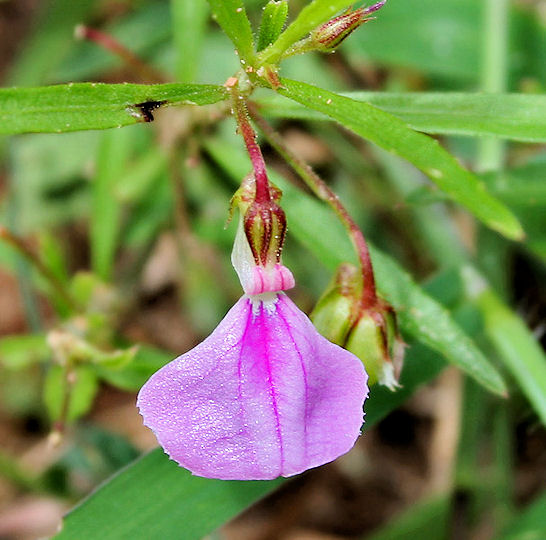
Abb.: पद्मा ।
Hybanthus enneaspermus (L.) F. v. Muell. 1876 - Spade Flower,
Talakona (తలకోన) Forest, Andhra Pradesh
[Bildquelle: J. M. Garg / Wikimedia. -- GNU FDLicense]
"Ionidium suffruticosum (Ging.) [=
Hybanthus enneaspermus (L.) F. v. Muell. 1876] N.
O. Violaceae.
Hibiscus mutabilis L. - Filziger Roseneibisch - Cotton Rose
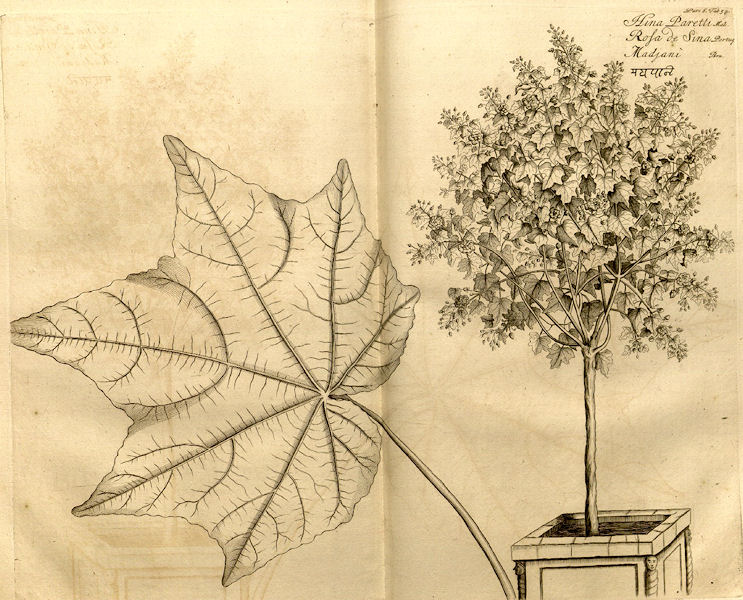
Abb.: Hibiscus mutabilis L. - Filziger Roseneibisch - Cotton Rose
[Bildquelle: Hortus malabaricus VI. Fig. 38,
1686]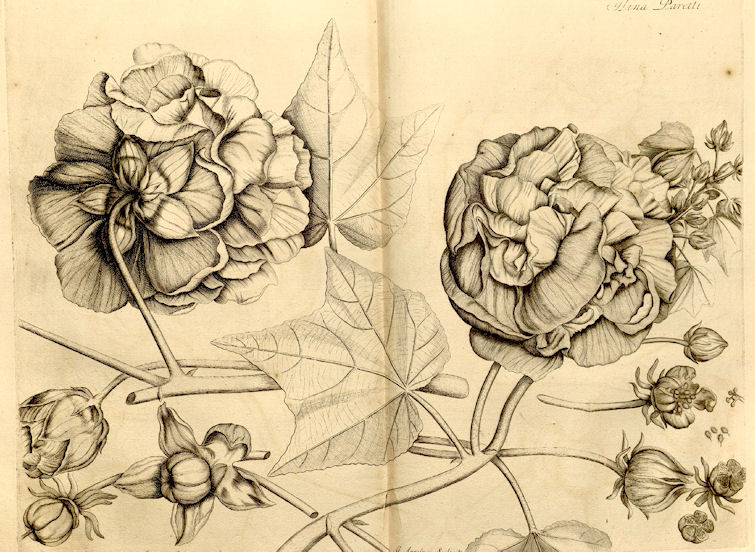
Abb.: Hibiscus mutabilis L. - Filziger Roseneibisch - Cotton Rose
[Bildquelle: Hortus malabaricus VI. Fig. 39,
1686]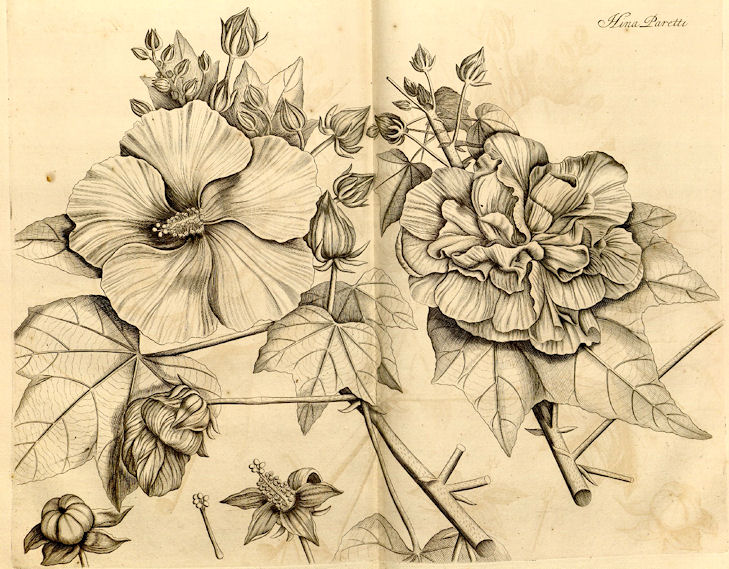
Abb.: Hibiscus mutabilis L. - Filziger Roseneibisch - Cotton Rose
[Bildquelle: Hortus malabaricus VI. Fig. 40,
1686]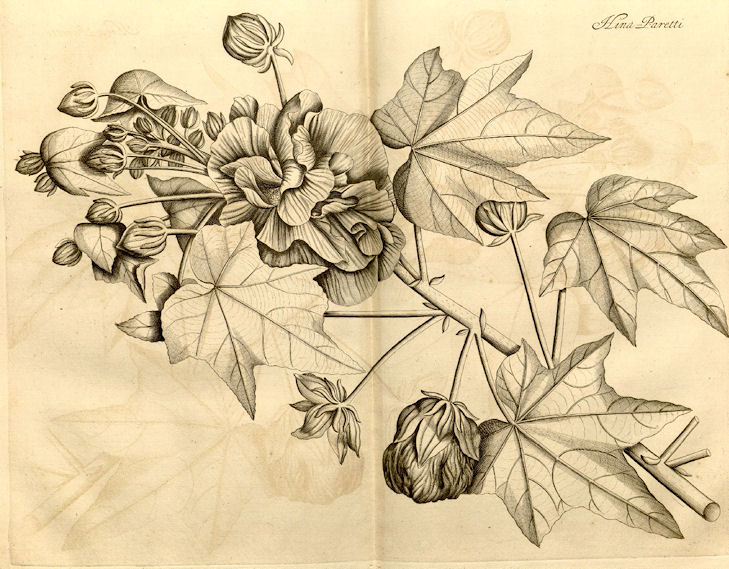
Abb.: Hibiscus mutabilis L. - Filziger Roseneibisch - Cotton Rose
[Bildquelle: Hortus malabaricus VI. Fig. 41,
1686]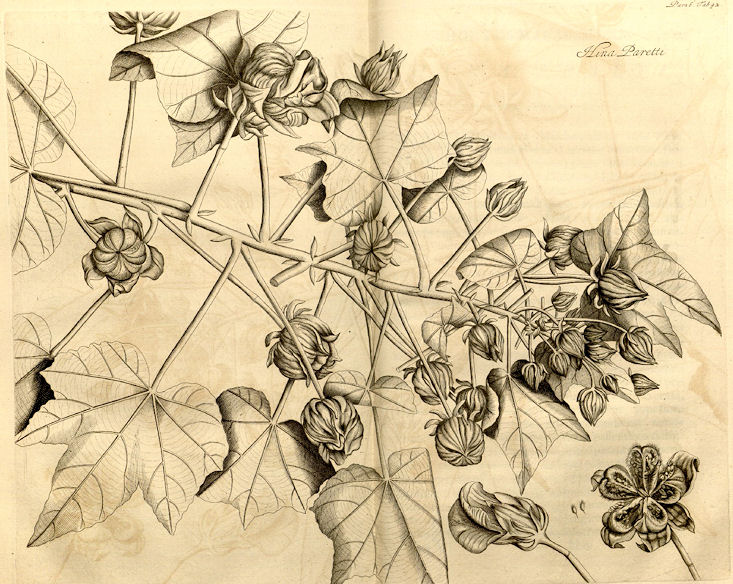
Abb.: Hibiscus mutabilis L. - Filziger Roseneibisch - Cotton Rose
[Bildquelle: Hortus malabaricus VI. Fig. 42,
1686]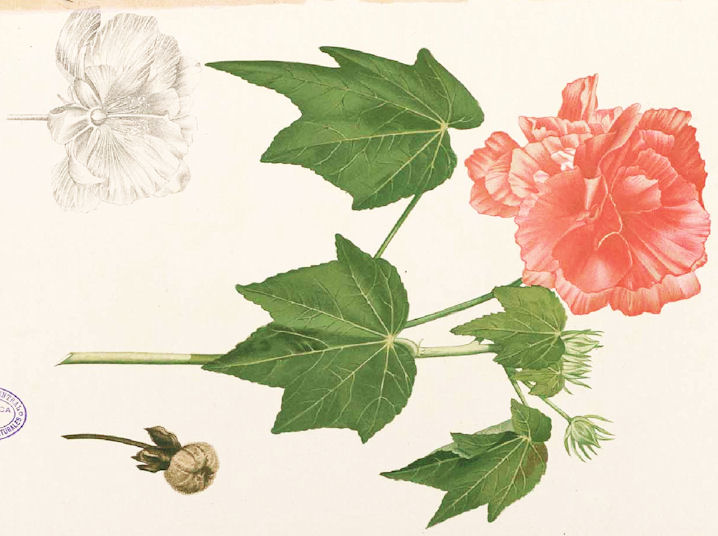
Abb.: Hibiscus mutabilis L. - Filziger Roseneibisch - Cotton Rose
[Bildquelle: Flora de Filipinas, 1880 / Wikipedia. -- Public domain]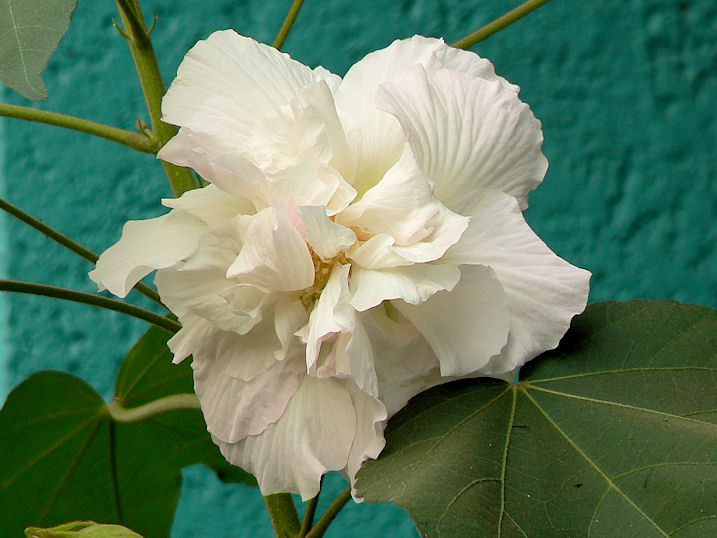
Abb.: Hibiscus mutabilis L. - Filziger Roseneibisch - Cotton Rose
[Bildquelle: dinesh_valke. --
http://www.flickr.com/photos/dinesh_valke/2077216411/. -- Zugriff am
2010-10-24. --
Creative
Commons Lizenz (Namensnennung, keine kommerzielle Nutzung, keine
Bearbeitung)]
"Hibiscus
mutabilis, also known as the Confederate rose or
the cotton rosemallow, is a plant noted for its flowers.
2.8.24. Mallotus philippensis (Lam.) Muell. Arg. 1865
- Red Kamala
12. a./b. kāmpillaḥ karkaśaś candro raktāṅgo rocanīty api
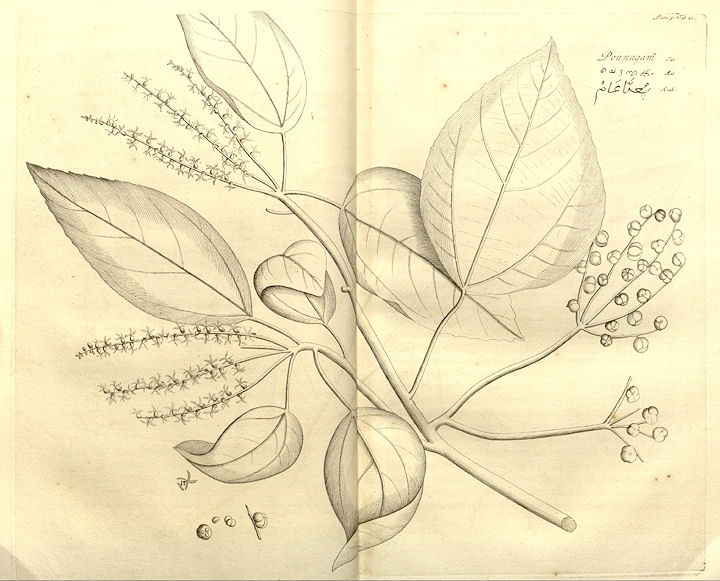
Abb.: Mallotus philippensis (Lam.) Muell. Arg. 1865
[Bildquelle: Hortus malabaricus V. Fig. 21, 1685]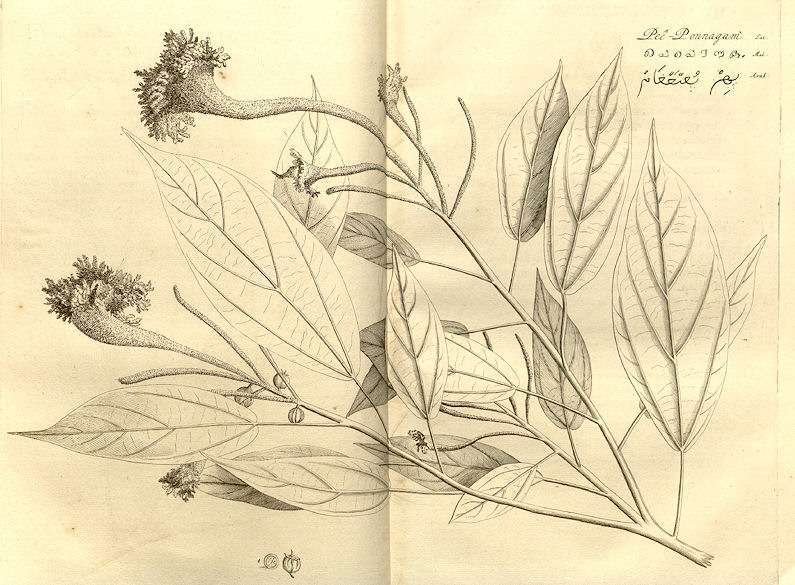
Abb.: Mallotus philippensis (Lam.) Muell. Arg. 1865
[Bildquelle: Hortus malabaricus V. Fig. 24, 1685]
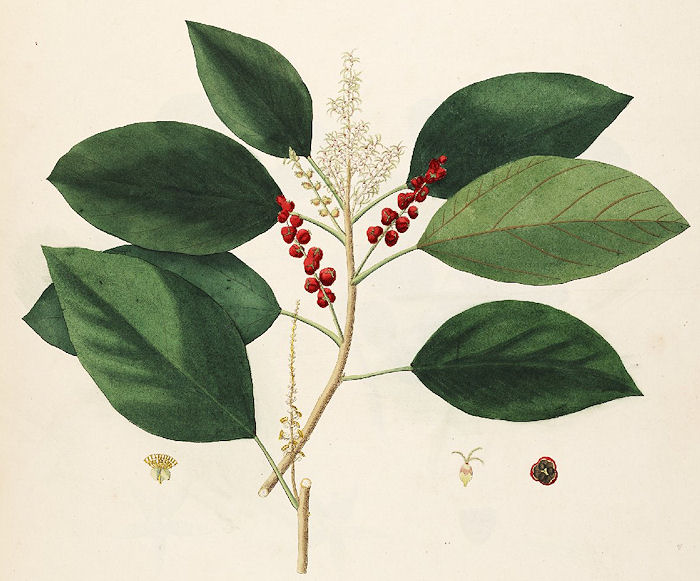
Abb.: रक्ताङ्गः
। Mallotus philippensis (Lam.) Muell. Arg. 1865 (Roxb.: Rottlera
tinctoria)
[Bildquelle: Roxburgh. -- Vol II. -- 1795. -- Tab. 168. -- Image courtesy Missouri Botanical Garden.
http://www.botanicus.org. --
Creative Commons Lizenz
(Namensnennung, keine kommerzielle Nutzung)]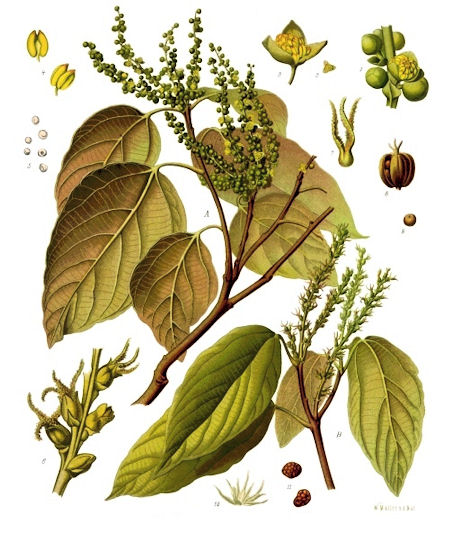
Abb.: Mallotus philippensis (Lam.) Muell. Arg. 1865
[Bildquelle: Köhler, 1887. -- Public domain]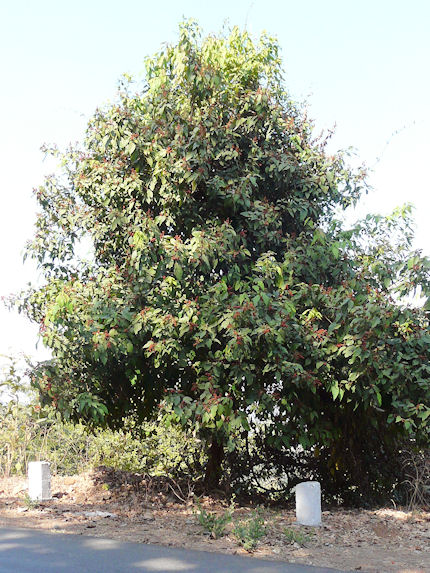
Abb.: Mallotus philippensis (Lam.) Muell. Arg. 1865, Maharashtra
[Bildquelle: dinesh_valke. --
http://www.flickr.com/photos/dinesh_valke/2222505895/. -- Zugriff am
2010-10-24. --
Creative
Commons Lizenz (Namensnennung, keine kommerzielle Nutzung, keine
Bearbeitung)]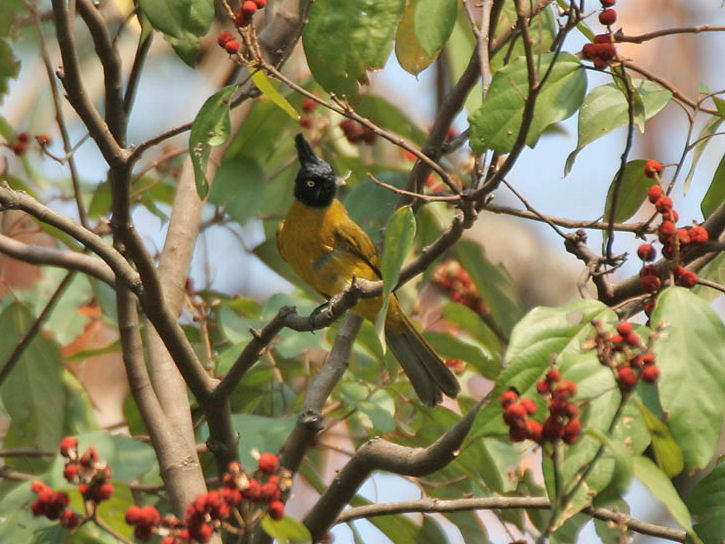
Abb.: रक्ताङ्गः
। Black-crested Bulbul (Pycnonotus melanicterus) auf Mallotus philippensis (Lam.) Muell.
Arg. 1865, Buxa National Park -
বক্সা জাতীয় উদ্যান,
West Bengal
[Bildquelle: J. M. Garg / Wikimedia. -- GNU FDLicense]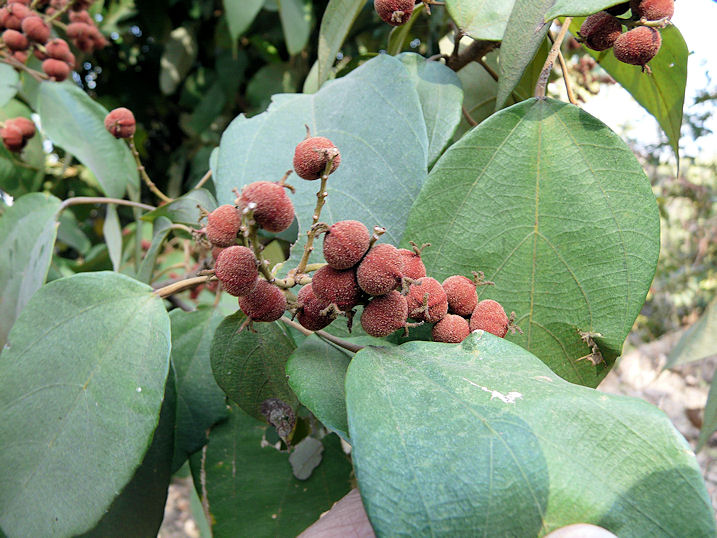
Abb.: रक्ताङ्गः
। Mallotus philippensis (Lam.) Muell. Arg. 1865, Maharashtra
[Bildquelle: dinesh_valke. --
http://www.flickr.com/photos/dinesh_valke/2222500247/. -- Zugriff am
2010-10-24. --
Creative
Commons Lizenz (Namensnennung, keine kommerzielle Nutzung, keine
Bearbeitung)]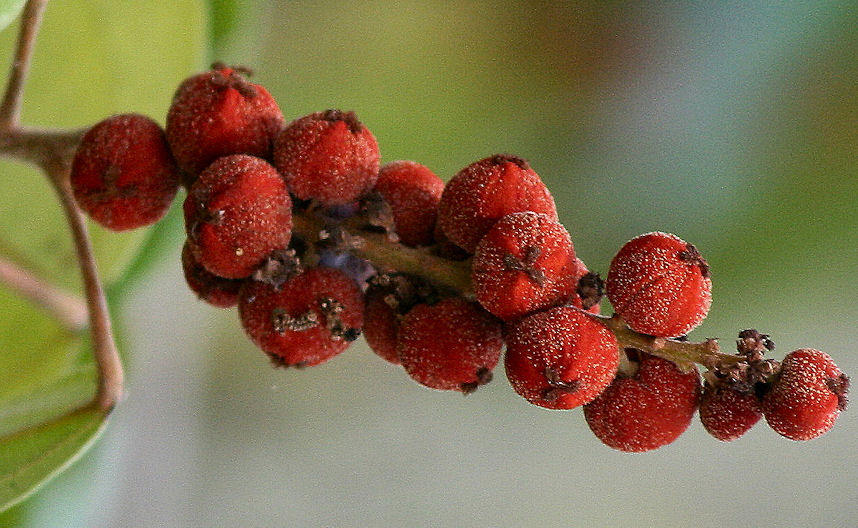
Abb.: कर्कशः ।
Mallotus philippensis (Lam.) Muell. Arg.
1865, Queensland, Australien
[Bildquelle:
Bill Higham. --
http://www.flickr.com/photos/22691568@N04/2432049527/. -- Zugriff am
2011-01-11. --
Creative Commons Lizenz (Namensnennung)]
"Mallotus Philippensis (Müller).
"MALLOTUS PHILLIPPINENSIS, Müll.-Arg.
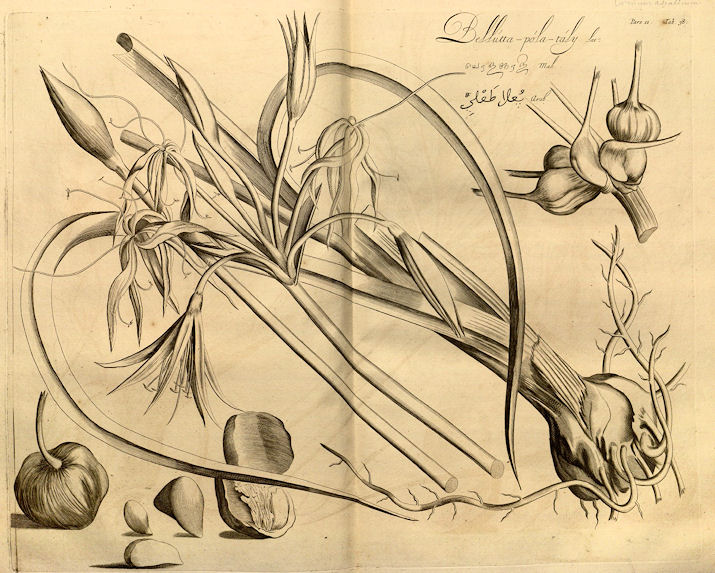
Abb.: Crinum asiaticum L. 1753
[Bildquelle: Hortus malabaricus XI. Fig. 38,
1692]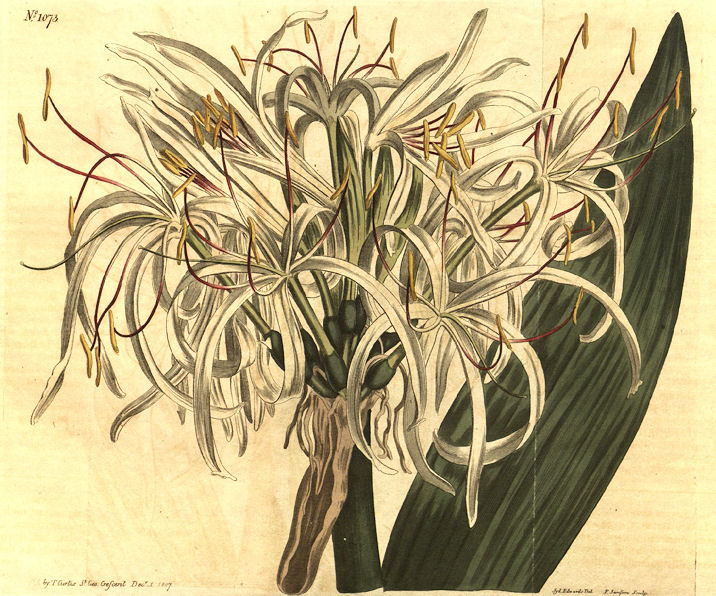
Abb.: Crinum asiaticum L. 1753
[Bildquelle: Curtis's Botanical Magazine, v. 27 (1808), Tab. 1073]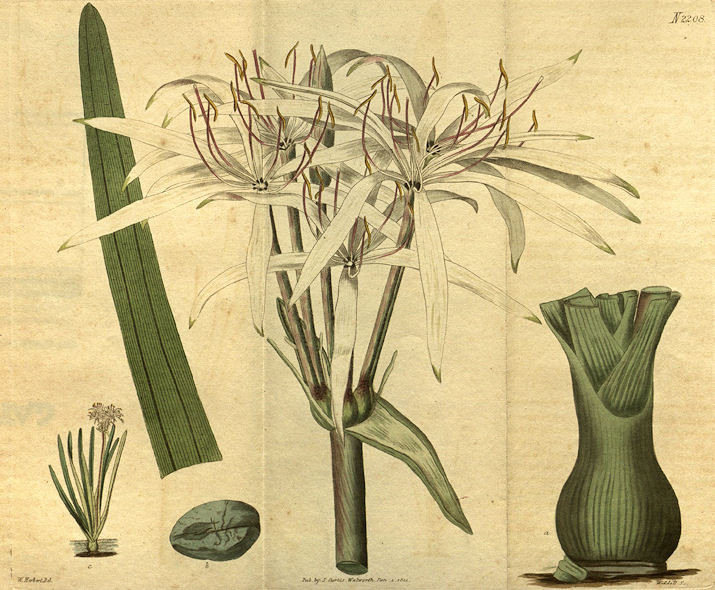
Abb.: Crinum asiaticum L. 1753
[Bildquelle: Curtis's Botanical Magazine, v. 48 (1820), Tab. 2208]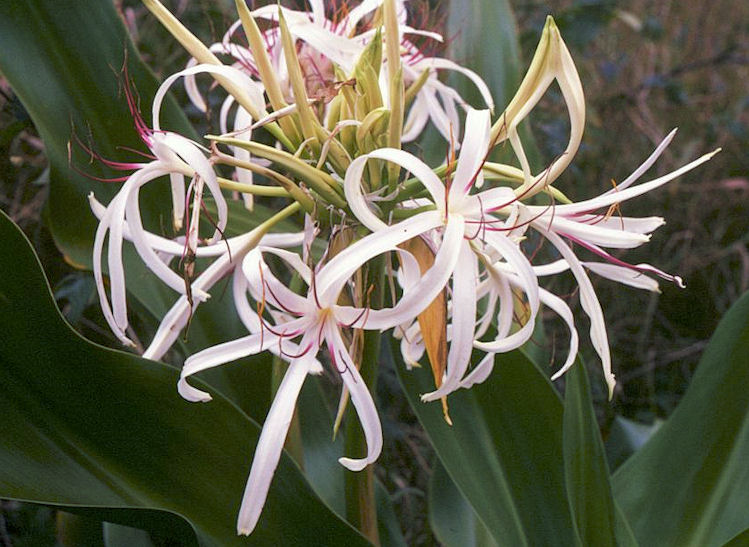
Abb.: Crinum asiaticum L. 1753, Kambodscha
[Bildquelle: Franz Xaver / Wikimedia. -- GNU FDLicense]
"CRINUM ASIATICUM, var. TOXICARIUM, Herbert.
2.8.25. Senna tora (L.) Roxb. 1832 - Chinesische Senna - Sickle Senna
12. c./d. prapunnāḍas tv eḍagajo dadrughnaś cakramardakaḥ
13. a./b. padmāṭa uraṇākhyaś ca
palāṇḍus tu sukandakaḥ
पद्माट उरणाख्यश्a च पलाण्डुस् तु सुकन्दकः
।१३ क।
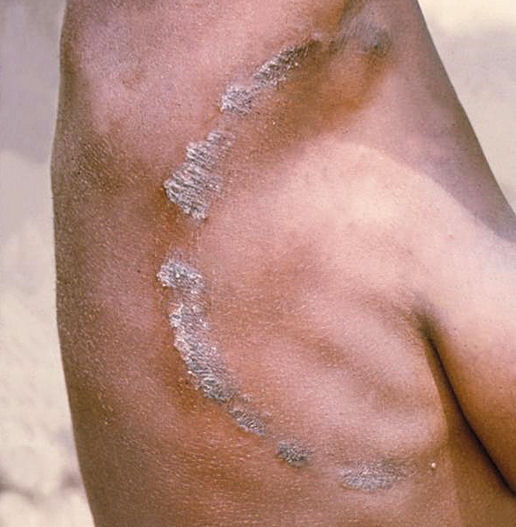
Abb.: चक्रम् । "ringworm" - Tinea corporis, bewirkt durch den Pilz
Trichophyton rubrum, Neuguinea
[Bildquelle: CDC/Lucille K. Georg / Wikimedia. -- Public domain]
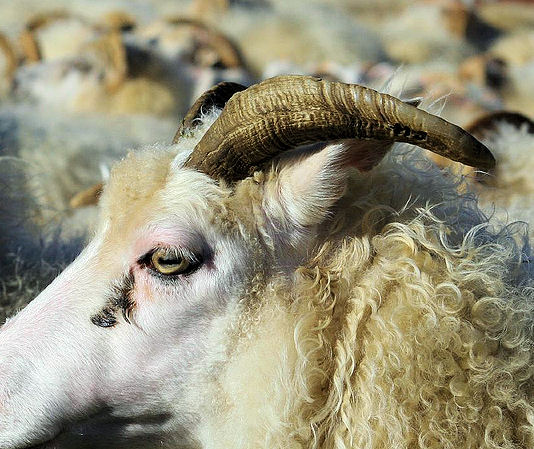
Abb.: उरणाक्षः । Island
[Bildquelle: Filip. --
http://www.flickr.com/photos/ironless/1351566511/. -- Zugriff am
2011-01-12. --
Creative
Commons Lizenz (Namensnennung, keine kommerzielle Nutzung, share alike)]
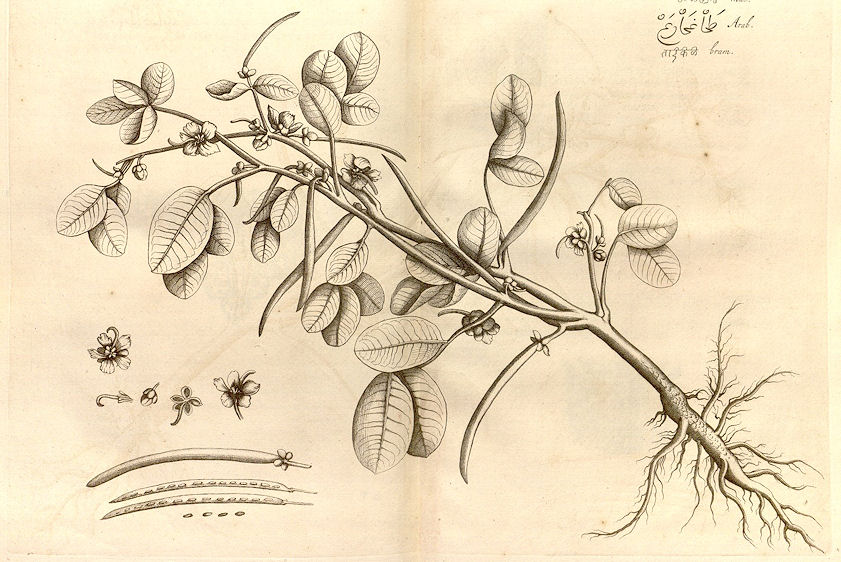
Abb.: Senna tora (L.) Roxb. 1832 - Chinesische Senna - Sickle Senna
[Bildquelle: Hortus malabaricus II. Fig. 53,
1679]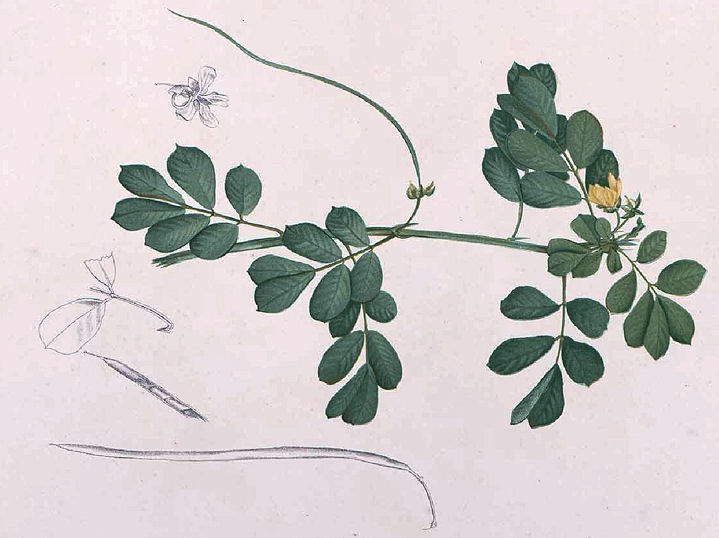
Abb.: Senna tora (L.) Roxb. 1832 - Chinesische Senna - Sickle Senna
[Bildquelle: Flora de Filipinas, 1880 / Wikipedia. -- Public domain]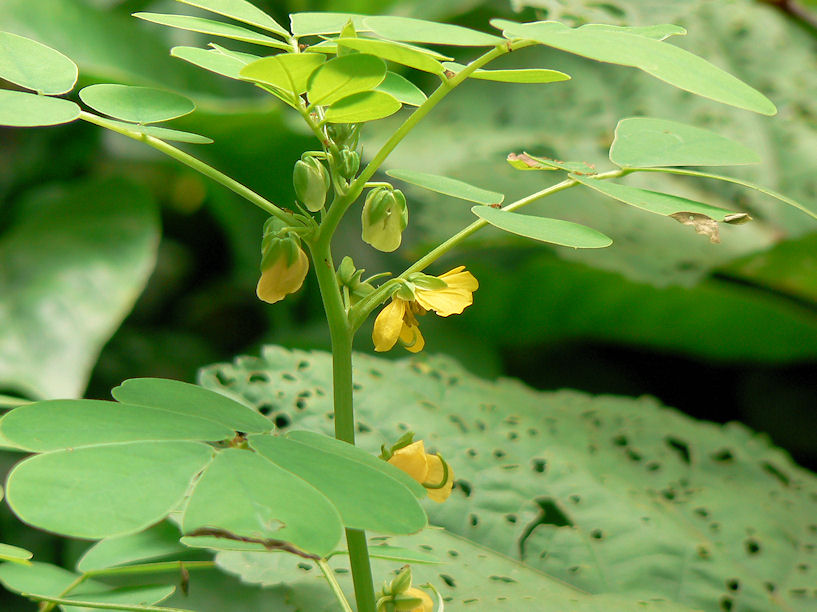
Abb.: उरणाक्षः ।
Senna tora (L.) Roxb. 1832 - Chinesische Senna - Sickle Senna
[Bildquelle: dinesh_valke. --
http://www.flickr.com/photos/dinesh_valke/1250292137/. -- Zugriff am
2010-10-24. --
Creative
Commons Lizenz (Namensnennung, keine kommerzielle Nutzung, keine
Bearbeitung)]
"Cassia tora (Linn.)
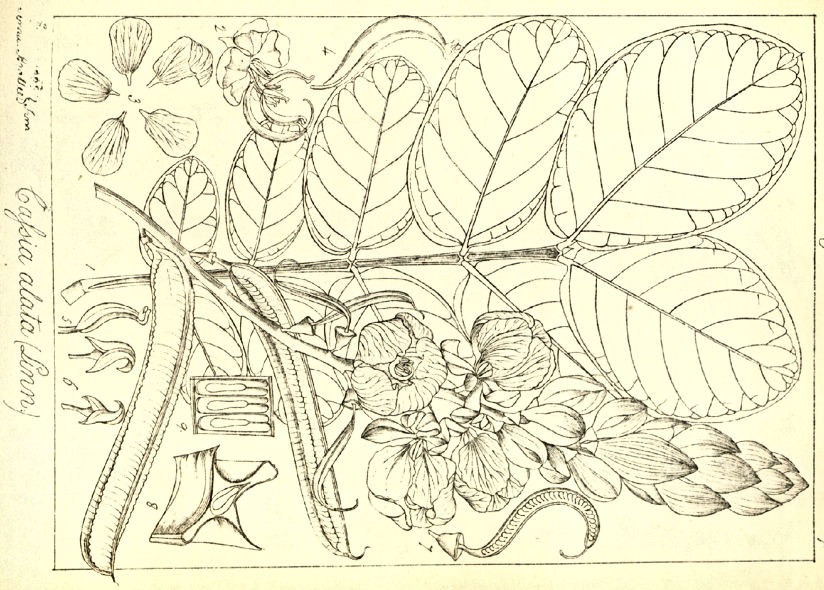
Abb.: Senna alata (L.) Roxb.
[Bildquelle: Wight Icones I, Tab. 253, 1840]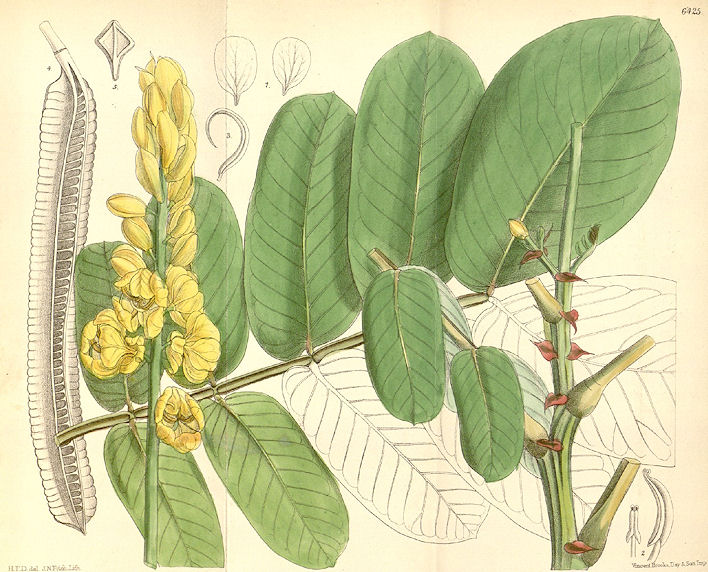
Abb.: उरणाक्षः ।
Senna alata (L.) Roxb.
[Bildquelle: Curtis's Botanical Magazine, v. 105 (1879), Tab. 6425]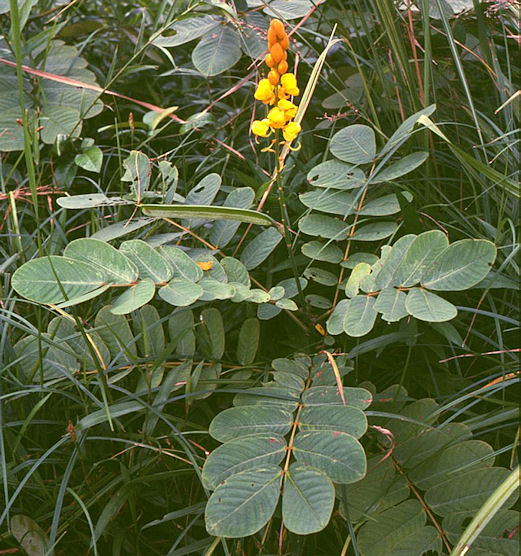
Abb.: उरणाक्षः ।
Senna alata (L.) Roxb., Kambodscha
[Bildquelle: Franz Xaver / Wikimedia. -- GNU FDLicense]
"Cassia alata (Linn.)
2.8.26. Allium cepa L. 1753 - Zwiebel - Onion
13.
padmāṭa uraṇākhyaś ca palāṇḍus tu sukandakaḥ
latārka-dudrumau tatra harite 'tha mahauṣadham
लतार्क-दुद्रुमौ तत्र हरिते
ऽथ
महौषधम् ॥१३॥
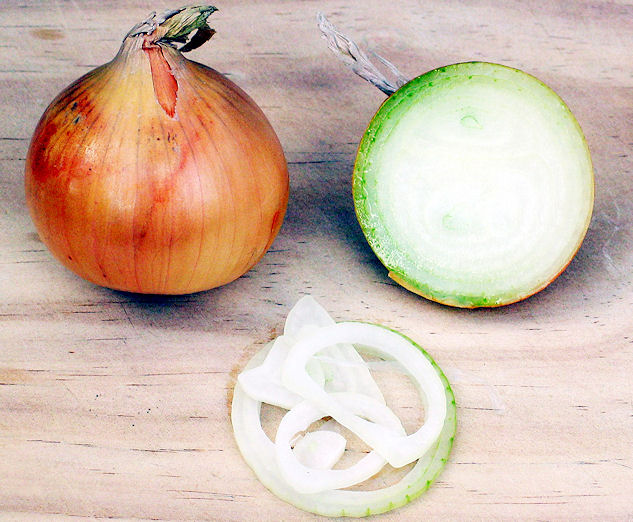
Abb.:
लतार्कः । grün-gelbe Zwiebel
[Bildquelle: Donovan Govan / Wikipedia. -- GNU FDLicense]
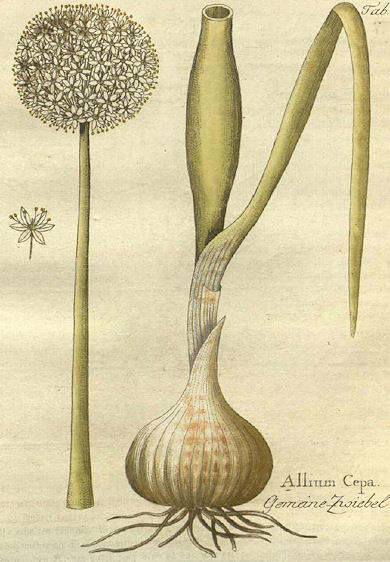
Abb.: सुकन्दकः ।
Allium cepa L. 1753 - Zwiebel - Onion
[Bildquelle: Icones
plantarum medico-oeconomico-technologicarum cum earum fructus ususque
descriptione =Abbildungen aller medizinisch-ökonomisch-technologischen
Gewächse mit der Beschreibung ihres Gebrauches und Nutzens. -- Wien, 1800 -
1822. -- Bd. 3, Tab. 260]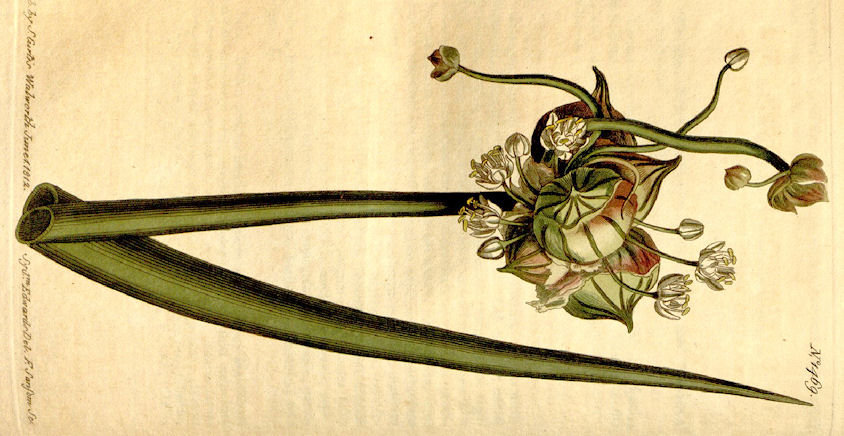
Abb.: Allium cepa L. 1753 - Zwiebel - Onion
[Bildquelle: Curtis's Botanical Magazine, v. 36 (1812), Tab. 1469]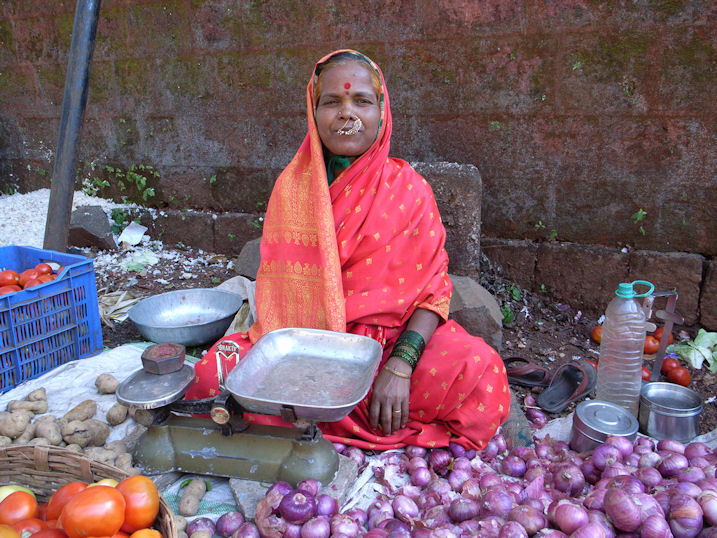
Abb.: सुकन्दकः ।
Zwiebelverkäuferin, Mahabaleshwar -
महाबळेश्वर, Maharashtra
[Bildquelle: Andi Hefti. --
http://www.flickr.com/photos/andihefti/1756609190/. -- Zugriff am
2010-10-24. --
Creative
Commons Lizenz (Namensnennung, keine kommerzielle Nutzung, keine
Bearbeitung)]
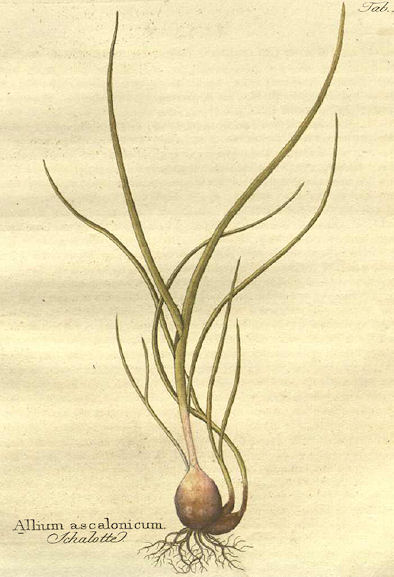
Abb.: Allium cepa Aggregatum Grp. - Schalotte - Shallot
[Bildquelle: Icones
plantarum medico-oeconomico-technologicarum cum earum fructus ususque
descriptione =Abbildungen aller medizinisch-ökonomisch-technologischen
Gewächse mit der Beschreibung ihres Gebrauches und Nutzens. -- Wien, 1800 -
1822. -- Bd. 3, Tab. 262]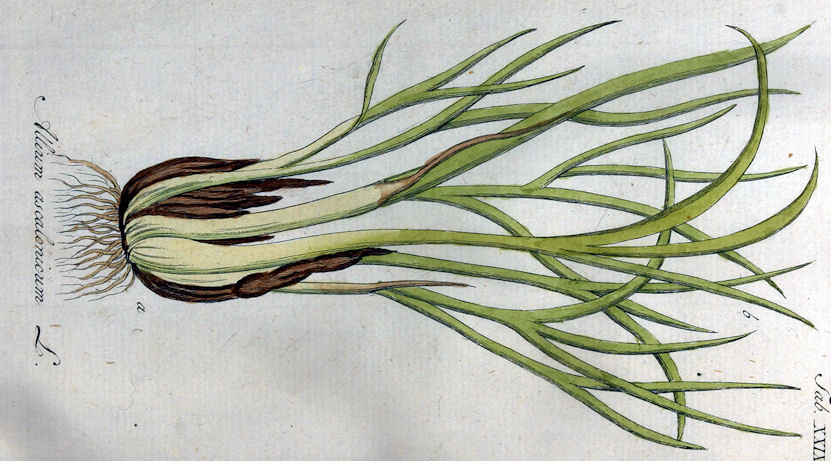
Abb.: Allium cepa Aggregatum Grp. - Schalotte - Shallot
[Bildquelle: Ypey, 1813 / Wikimedia. -- Public domain]
"Allium ascalonicum, the Shallot, is
called by the natives Ek-Kānda-lasun or Ekla-kali-lasan, "one-clove
garlic," and is used by them to cure earache, a small piece being
placed in the meatus. It is also fried in butter and preserved in
honey as an aphrodisiac."
2.8.27. Allium sativum L. 1753 - Knoblauch - Garlic
13. c./d.
latārka-dudrumau tatra harite
'tha mahauṣadham
14. a./b. laśunaṃ gṛñjanāriṣṭa-mahākandara-sonakāḥ
लशुनं गृञ्जनारिष्ट-महाकन्दर-सोनकाः ।१४ क।
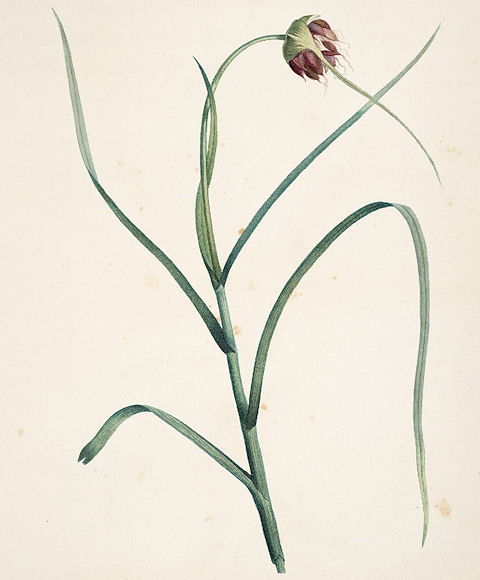
Abb.: लशुनम् ।
Allium sativum L. 1753 - Knoblauch - Garlic
[Bildquelle: La botanique de J.J. Rousseau: ornée de soixante-cinq planches,
imprimées en couleurs d'après les peintures de P.J. Redouté. -- Paris, 1805, Pl.
7.] 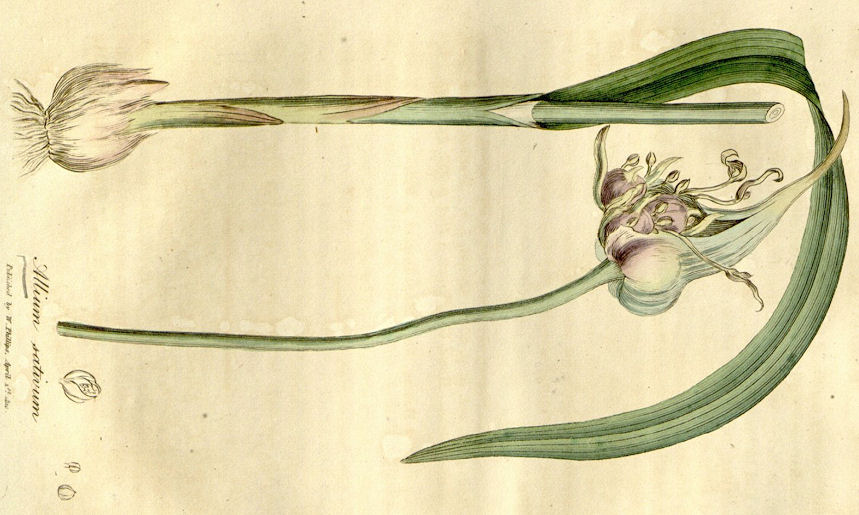
Abb.: महाकन्दरः ।
Allium sativum L. 1753 - Knoblauch - Garlic
[Bildquelle: Medical botany : containing
systematic and general descriptions, with plates of all the medicinal plants,
comprehended in the catalogues of the materia medica, as published by the Royal
Colleges of Physicians of London, Edinburgh, and Dublin, together with the
principal medicinal plants not included in those pharmocopoeias, accompanied
with a circumstantial detail of their medicinal effects, and of the diseases in
which they have been most successfully employed / by William Woodville. --
London, 1842. -- Vol 4, Tab. 256.] 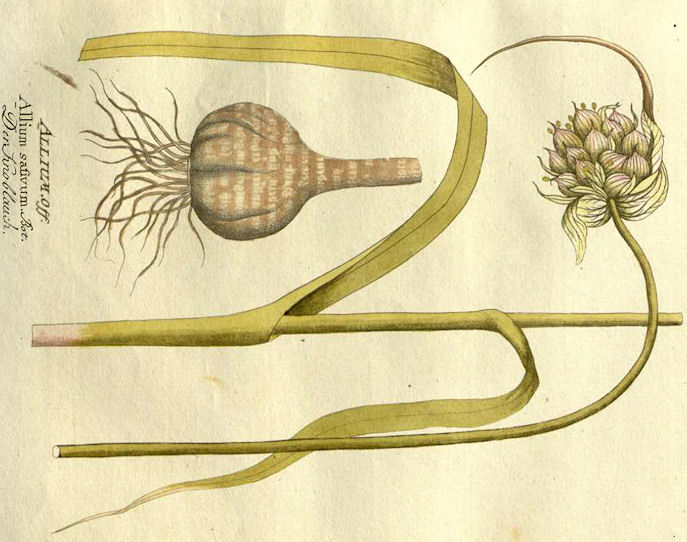
Abb.:
महौषधम् ।
Allium sativum L. 1753 - Knoblauch - Garlic
[Bildquelle: Icones plantarum medico-oeconomico-technologicarum
cum earum fructus ususque descriptione =Abbildungen aller
medizinisch-ökonomisch-technologischen Gewächse mit der Beschreibung ihres
Gebrauches und Nutzens. -- Wien, 1800 - 1822. -- Bd. 1, Tab. 12]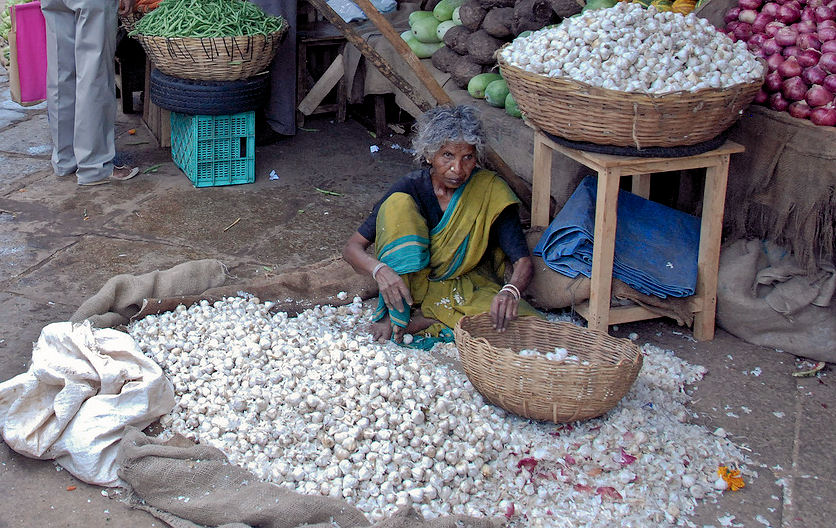
Abb.: महाकन्दरः ।
Knoblauchverkäuferin, Bangalore - ಬೆಂಗಳೂರು,
Karnataka
[Bildquelle: Benjamin Krause. --
http://www.flickr.com/photos/benjaminkrause/3303814086/. -- Zugriff am
2010-10-24. --
Creative Commons Lizenz (Namensnennung)]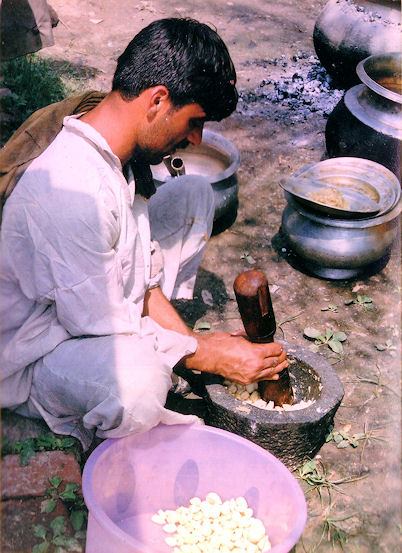
Abb.:
महाकन्दरः ।
Knoblauchmörser, Kashmir
[Bildquelle: Tom Jordan. --
http://www.flickr.com/photos/21346091@N03/5052800940/. -- Zugriff am
2010-10-24. --
Creative Commons Lizenz (Namensnennung, keine Bearbeitung)]
É povret tot gl'an. (Myth. des Plant., ii.,
7.)
2.8.28. Boerhavia repens L. 1753 + (rote:) Boerhavia diffusa
L. 1753 - Red Spiderling
14. c./d. punarnavā tu śothaghnī
vitunnaṃ suniṣaṇṇakam
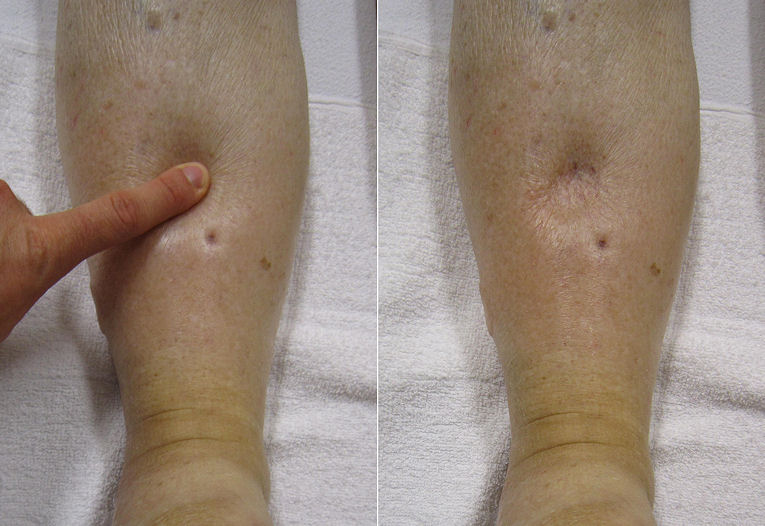
Abb.: शोथः । Ödem am Bein (Drucktest)
[Bildquelle: James Heilman, MD / Wikipedia. --
GNU FDLicense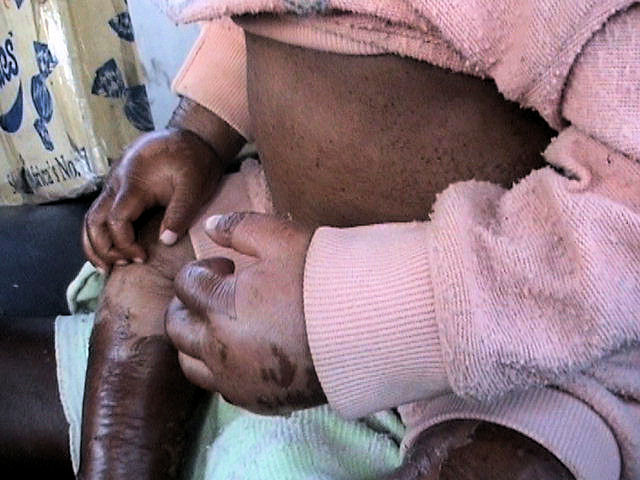
Abb.: शोथः । Hungerödeme bei Kwashiorkor,
Zimbabwe
[Bildquelle: Sokwanele - Zimbabwe. --
http://www.flickr.com/photos/sokwanele/2947297808/.
-- Zugriff am 2011-01-12. --
Creative Commons Lizenz (Namensnennung,
keine kommerzielle Nutzung, share alike)]
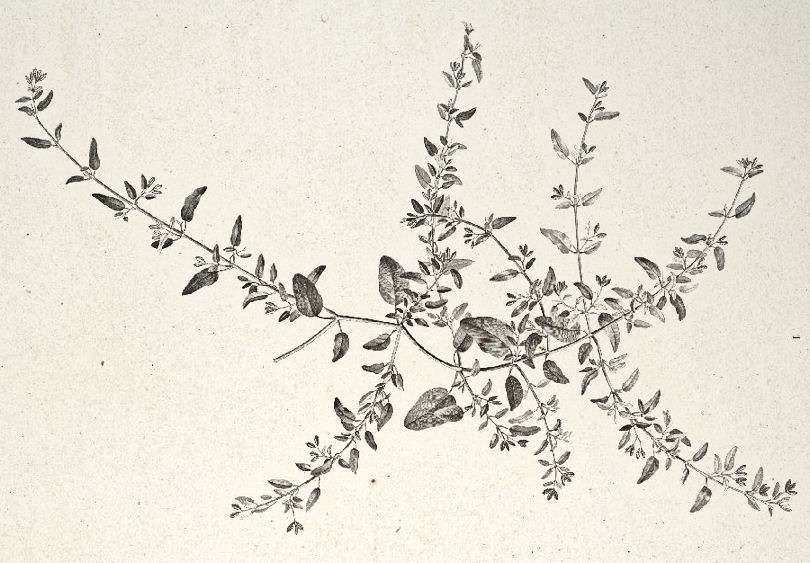
Abb.: Boerhavia repens L. 1753
[Bildquelle: Flore d'Egypte : explanation des planches /par M. Delile. -- Paris,
1813. -- Pl. 3.]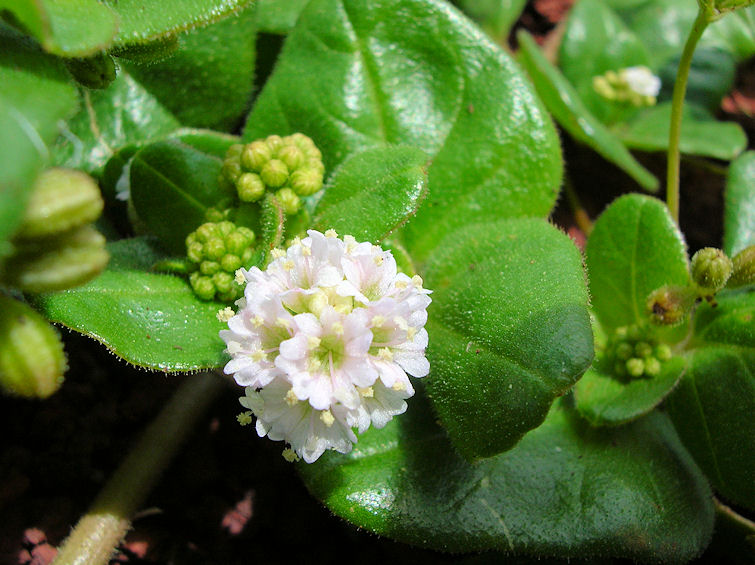
Abb.: Boerhavia repens L. 1753, Hawaii
[Bildquelle: Forest Starr & Kim Starr. --
http://www.hear.org/starr/images/image/?q=050405-5706&o=plants. -- Zugriff
am 2010-10-22. --
Creative Commons Lizenz (Namensnennung)]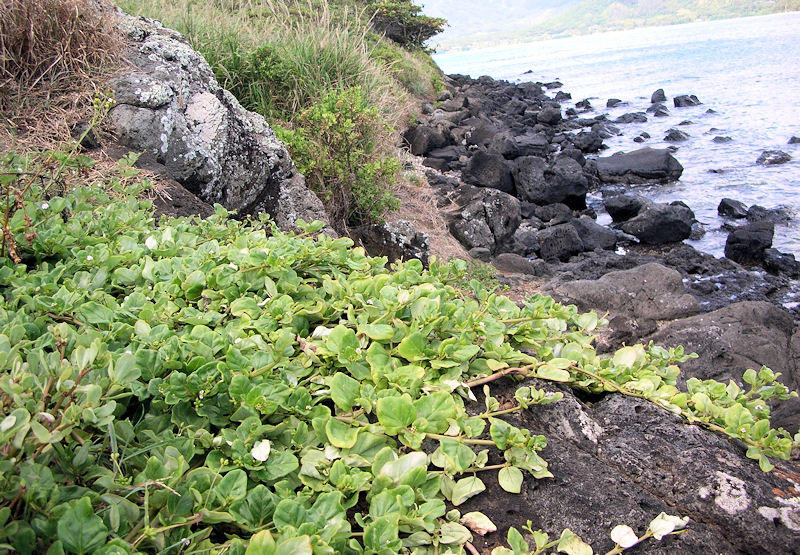
Abb.: Boerhavia repens L. 1753, Hawaii
[Bildquelle: Forest Starr & Kim Starr. --
http://www.hear.org/starr/images/image/?q=050419-6511&o=plants. -- Zugriff
am 2010-10-22. --
Creative Commons Lizenz (Namensnennung)]
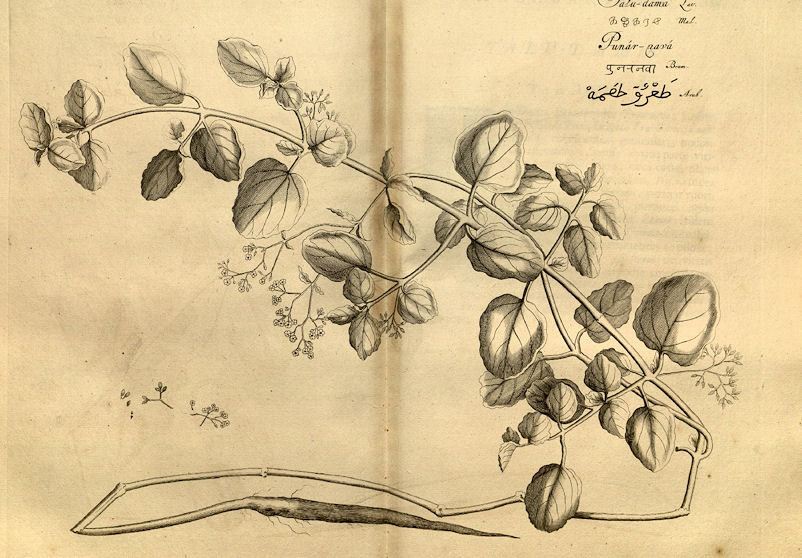
Abb.: Boerhavia diffusa
L. 1753 - Red Spiderling
[Bildquelle: Hortus malabaricus VII. Fig. 56,
1686]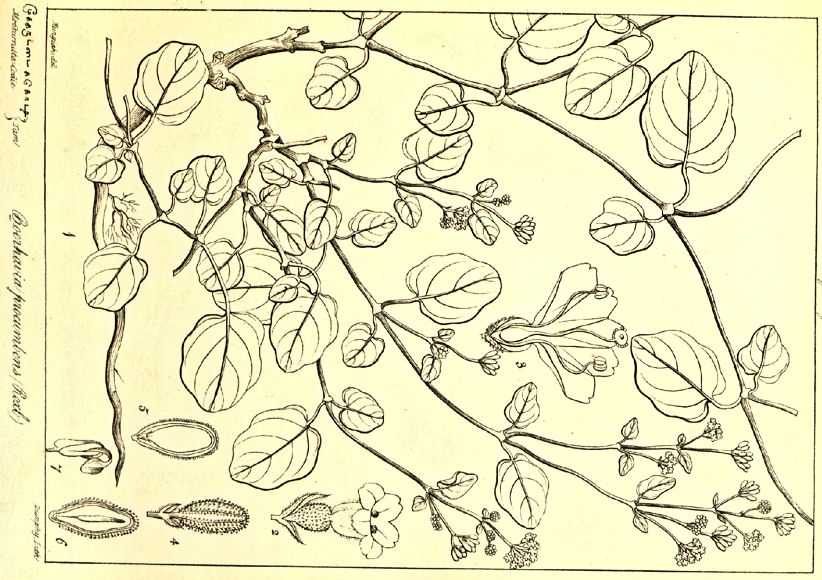
Abb.: Boerhavia diffusa
L. 1753 - Red Spiderling
[Bildquelle: Wight Icones III, Tab. 874, 1846]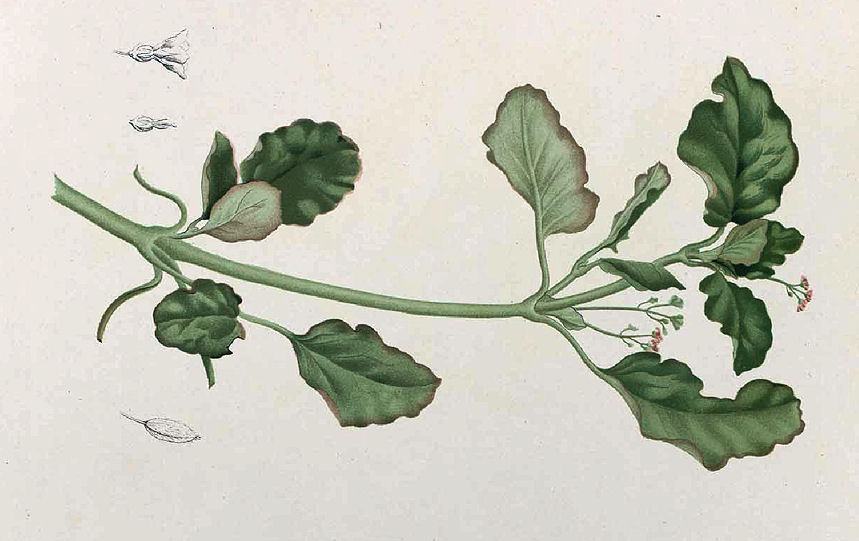
Abb.: Boerhavia diffusa
L. 1753 - Red Spiderling
[Bildquelle: Flora de Filipinas, 1880 / Wikipedia. -- Public domain]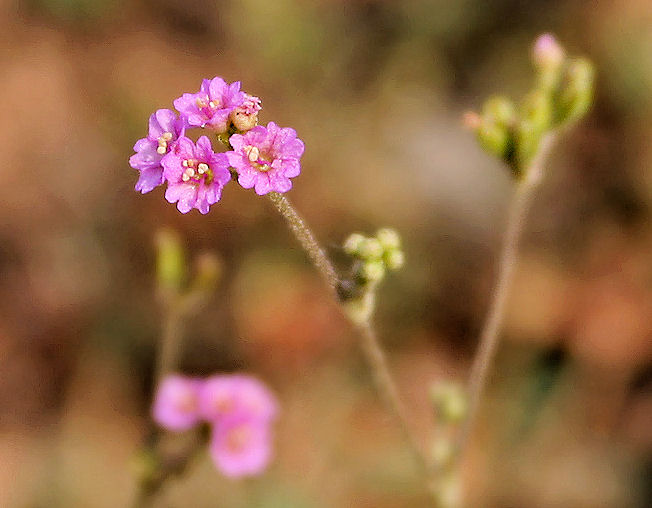
Abb.: Boerhavia diffusa
L. 1753 - Red Spiderling, Amaravati - అమరావతి, Andhra Pradesh
[Bildquelle: J. M. Garg / Wikimedia. -- GNU FDLicense]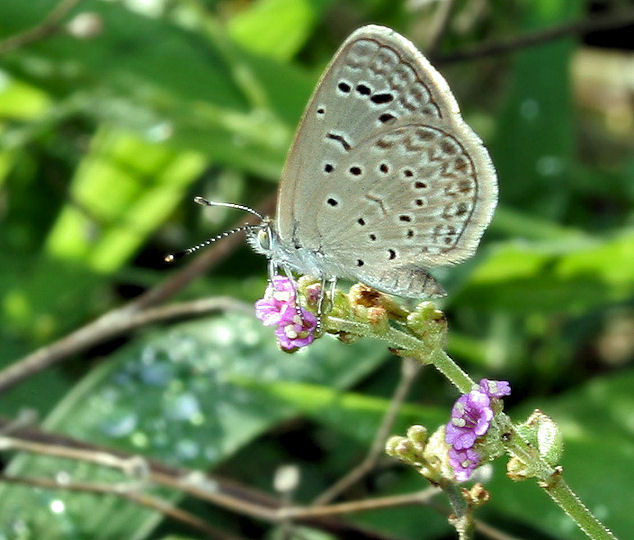
Abb.: Dark Grass Blue (Zizeeria karsandra) auf Boerhavia diffusa
L. 1753 - Red Spiderling, Hyderabad -
హైదరాబాద్ -
حیدرآباد, Andhra Pradesh
[Bildquelle: J. M. Garg / Wikimedia. -- GNU FDLicense]
"Boerhavia diffusa (Linn.) N. O.
Nyctaginaceae.
2.8.29. Marsilea minuta L. 1771 - Dwarf Water Clover
14. c./d.
punarnavā tu śothaghnī
vitunnaṃ suniṣaṇṇakam
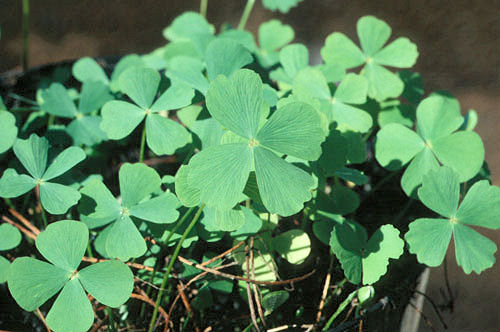
Abb.: सुनिषण्णकम्
। Marsilea minuta L. 1771 - Dwarf Water Clover
[Bildquelle: USGS / Wikimedia. -- Public domain]
2.8.30. ???
15. a./b. syād vātakaḥ śītalo 'parājitāśanaparṇy api
2.8.31. Celastrus paniculatus Willd.
15. c./d. pārāvatāṅghriḥ kaṭhabhī paṇyā jyotiṣmatī latā
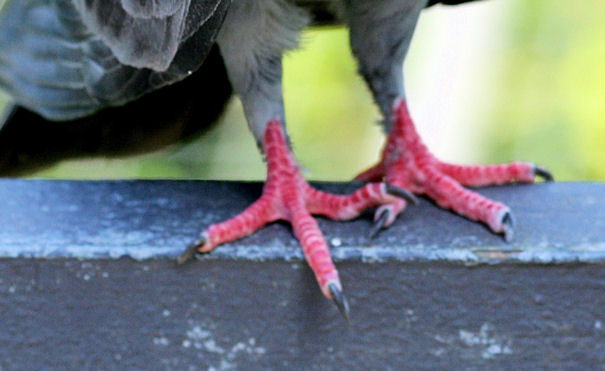
Abb.: पारावताङ्घ्रिः
। Fuß von Columba livia Gmelin, 1789 - Felsentaube - Rock Pigeon
[Bildquelle: AngMoKio / Wikimedia. --
Creative
Commons Lizenz (Namensnennung, share alike)]
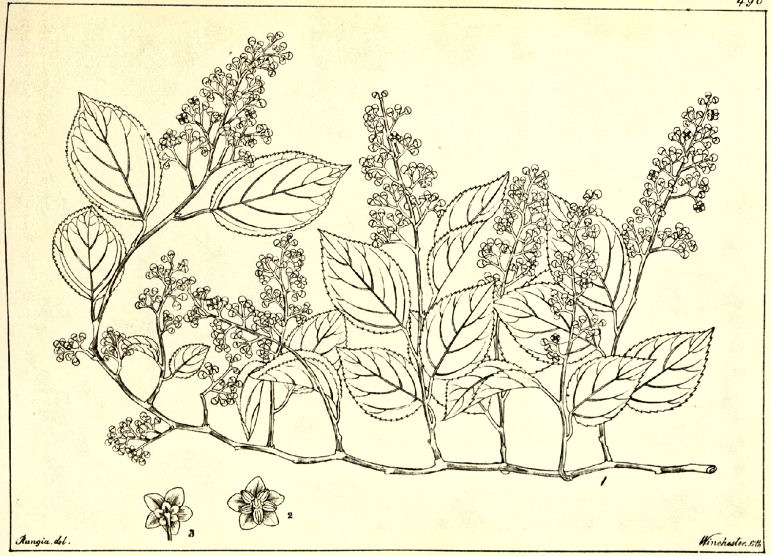
Abb.: Celastrus paniculatus Willd.
[Bildquelle: Wight Icones I, Tab. 158, 1840]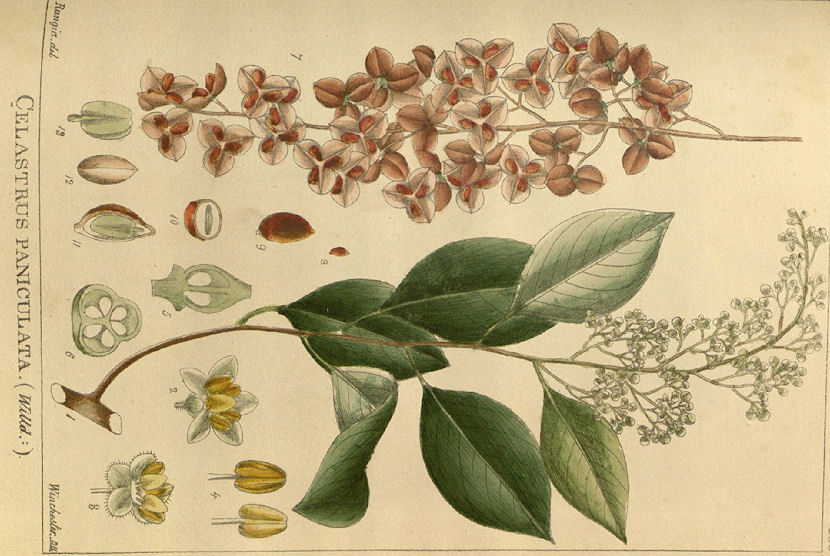
Abb.: पारावताङ्घ्रिः
। Celastrus paniculatus Willd.
[Bildquelle: Wight: Illustrations I, Tab. 72,
1840]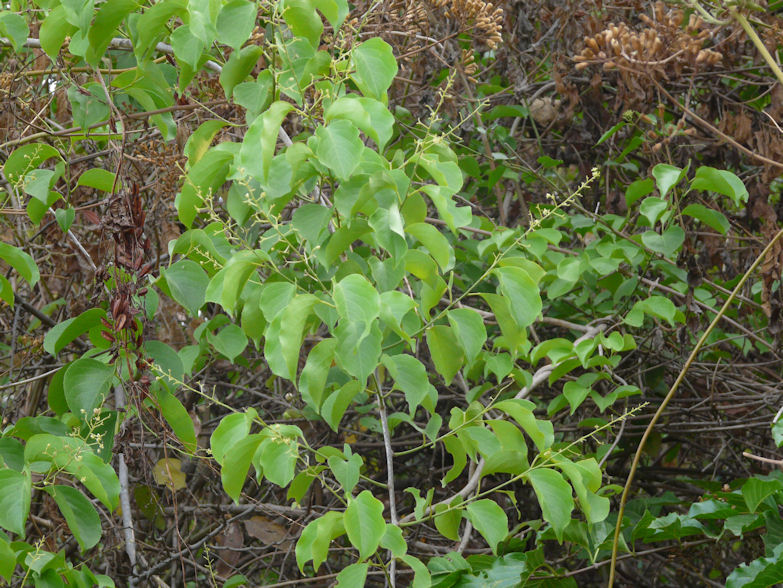
Abb.: लता । Celastrus paniculatus Willd.
[Bildquelle: dinesh_valke. --
http://www.flickr.com/photos/dinesh_valke/2463450203/. -- Zugriff am
2010-10-24. --
Creative
Commons Lizenz (Namensnennung, keine kommerzielle Nutzung, keine
Bearbeitung)]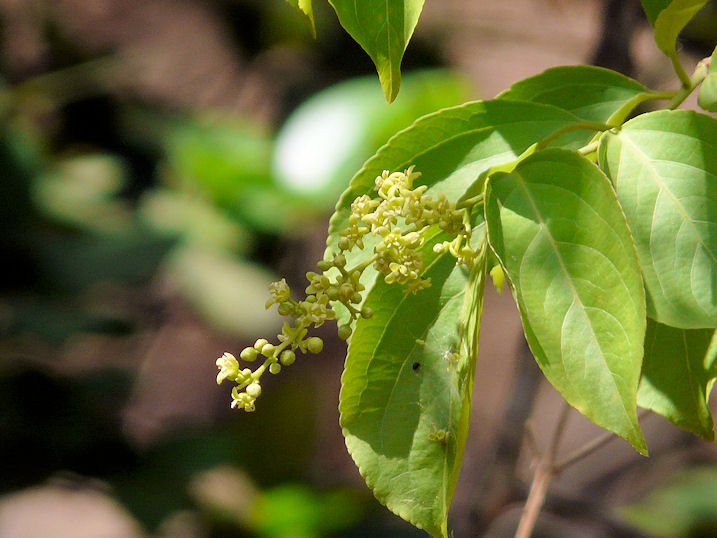
Abb.: Celastrus paniculatus Willd.
[Bildquelle: dinesh_valke. --
http://www.flickr.com/photos/dinesh_valke/2464540069/. -- Zugriff am
2010-10-24. --
Creative
Commons Lizenz (Namensnennung, keine kommerzielle Nutzung, keine
Bearbeitung)]
"Celastrus paniculata (Willd.) N. O.
Celastraceae.
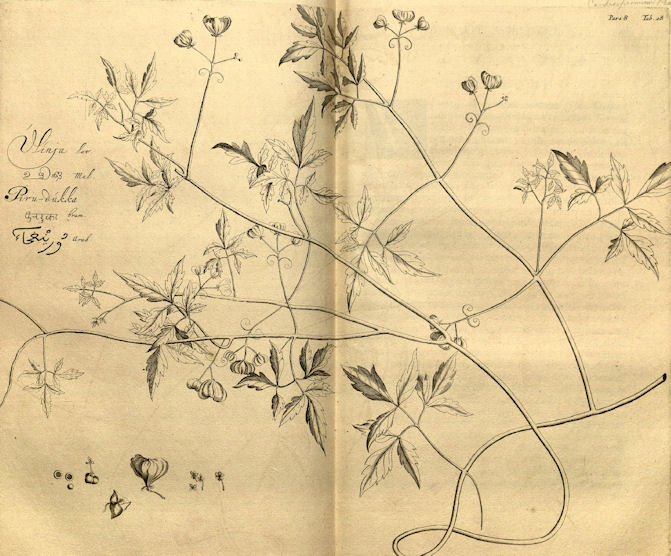
Abb.: Cardiospermum halicacabum L. 1753 - Ballonrebe - Heart Pea
[Bildquelle: Hortus malabaricus VIII. Fig. 28,
1688]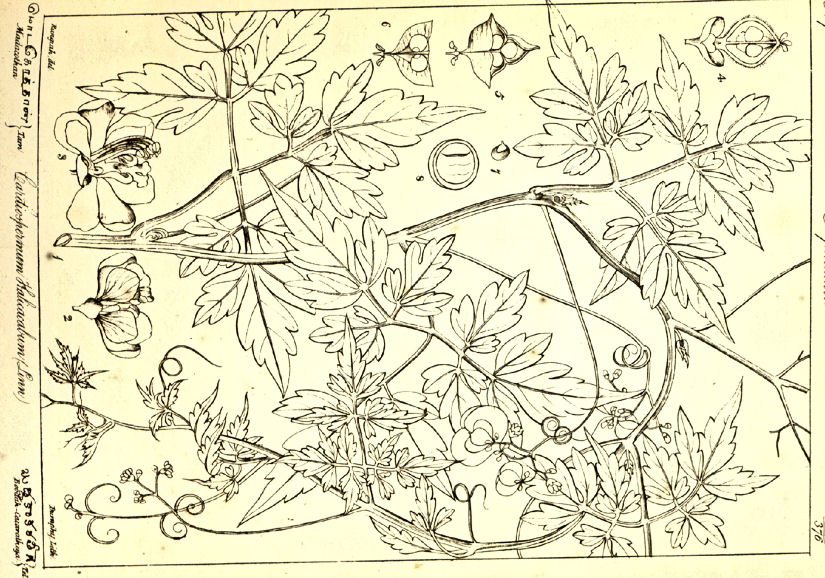
Abb.: Cardiospermum halicacabum L. 1753 - Ballonrebe - Heart Pea
[Bildquelle: Wight Icones II, Tab. 508, 1843]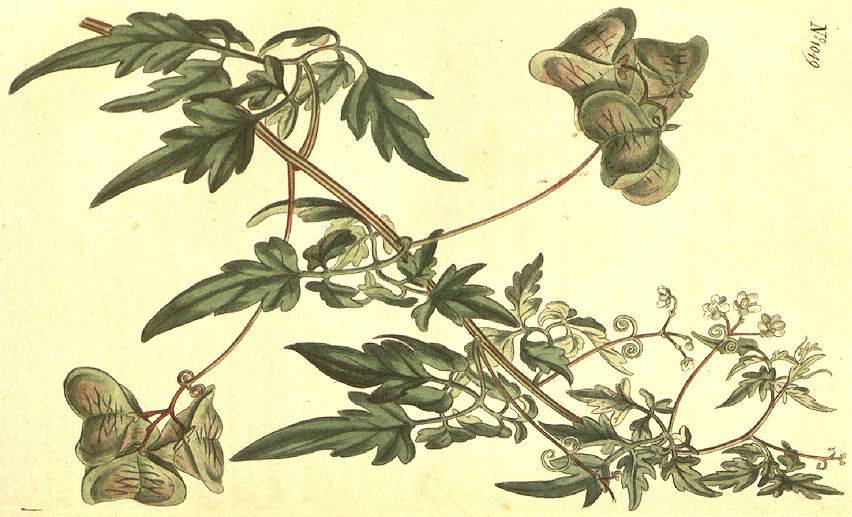
Abb.: Cardiospermum halicacabum L. 1753 - Ballonrebe - Heart Pea
[Bildquelle: Curtis's Botanical Magazine, v. 26 (1807), Tab. 1049]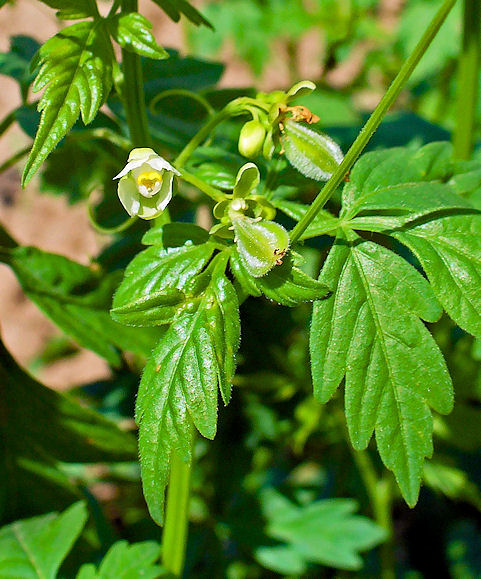
Abb.: Cardiospermum halicacabum L. 1753 - Ballonrebe - Heart Pea,
Deutschland
[Bildquelle: H. Zell / Wikimedia. -- GNU FDLicense]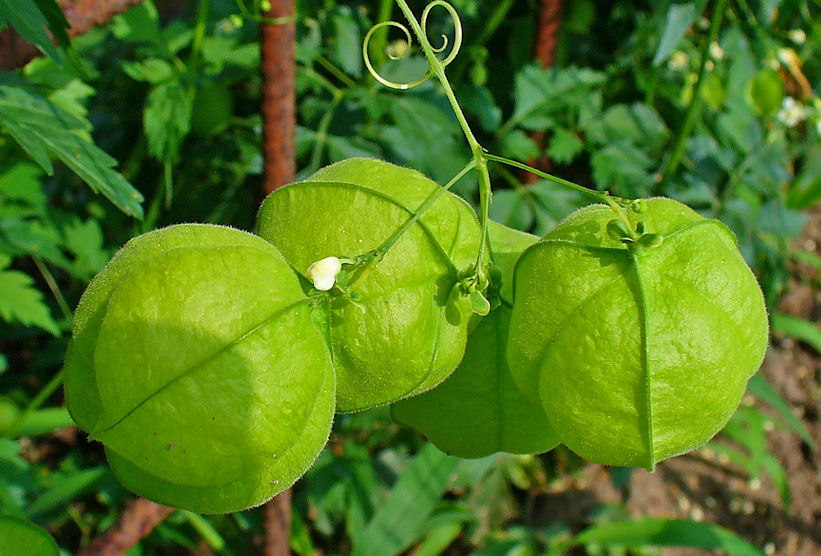
Abb.: Cardiospermum halicacabum L. 1753 - Ballonrebe - Heart Pea,
Deutschland
[Bildquelle: H. Zell / Wikimedia. -- GNU FDLicense]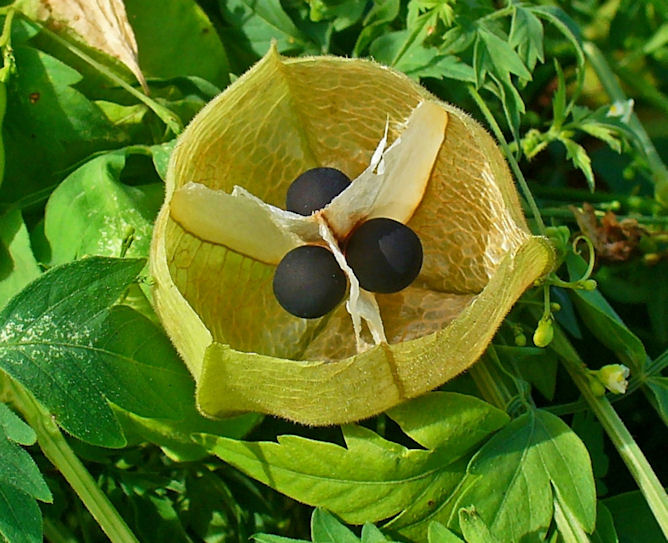
Abb.: Cardiospermum halicacabum L. 1753 - Ballonrebe - Heart Pea,
Deutschland
[Bildquelle: H. Zell / Wikimedia. -- GNU FDLicense]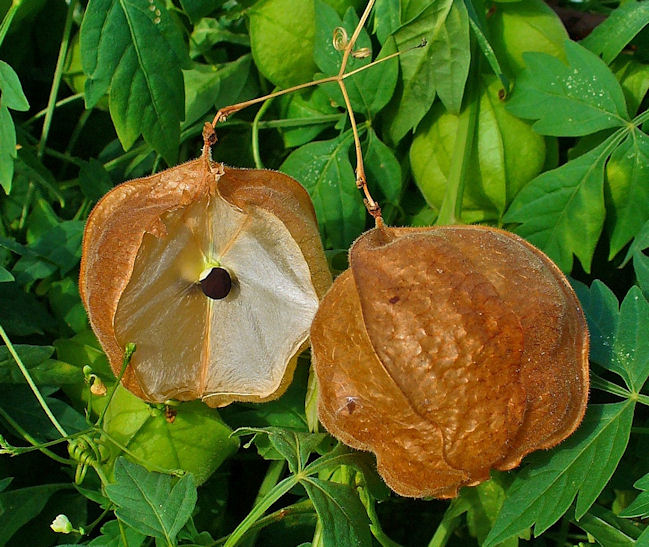
Abb.: Cardiospermum halicacabum L. 1753 - Ballonrebe - Heart Pea,
Deutschland
[Bildquelle: H. Zell / Wikimedia. -- GNU FDLicense]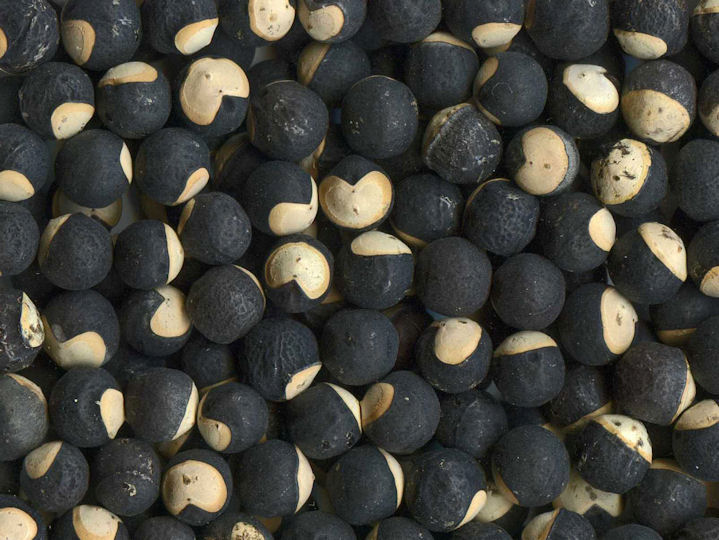
Abb.: Cardiospermum halicacabum L. 1753 - Ballonrebe - Heart Pea,
Deutschland
[Bildquelle: H. Zell / Wikimedia. -- GNU FDLicense]
"Cardiospermum Halicacabum (Linn.) N. O.
Sapindaceae.
2.8.32. Gentiana kurroo Royle 1839 - Kies-Enzian
Gentianaceae (Enziangewächse)
16. a./b. vārṣikaṃ trāyamāṇā syāt trāyantī balabhadrikā
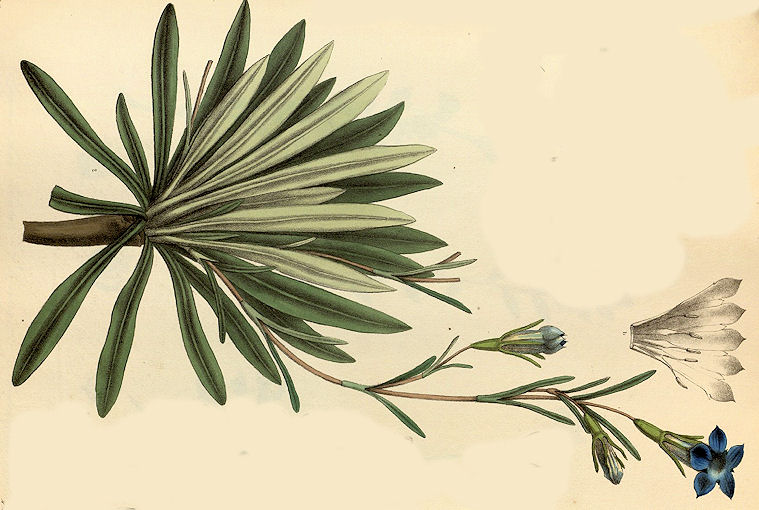
Abb.: Gentiana kurroo Royle 1839 - Kies-Enzian
[Bildquelle: Royle, J. Forbes <1799-1858>: Illustrations of the botany and other branches of the natural history of the
Himalayan Mountains :and of the flora of Cashmere. -- Vol 2: Plates. -- London :
Allen, 1839. -- Pl. 68.]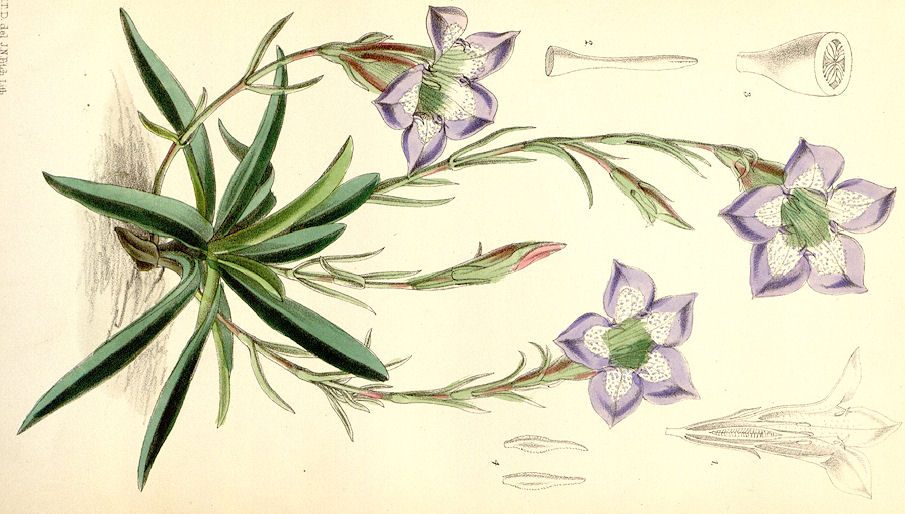
Abb.: Gentiana kurroo Royle 1839 - Kies-Enzian
[Bildquelle: Curtis's Botanical Magazine, v. 106 (1880), Tab. 6470]
2.8.33. Dioscorea bulbifera L. 1753 - Yamswurzel - Air Potato
16. c./d. viṣvaksenapriyā gṛṣṭir vārāhī badarety api
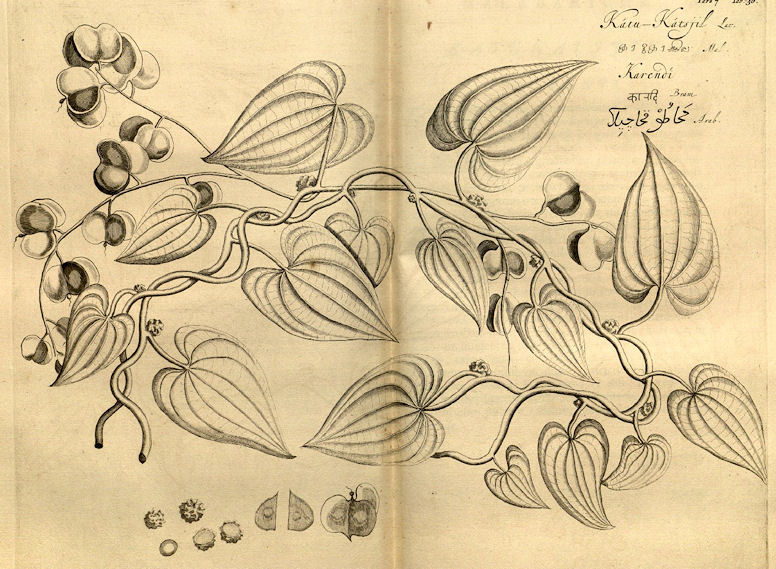
Abb.: Dioscorea bulbifera L. 1753 - Yamswurzel - Air Potato
[Bildquelle: Hortus malabaricus VII. Fig. 36,
1686]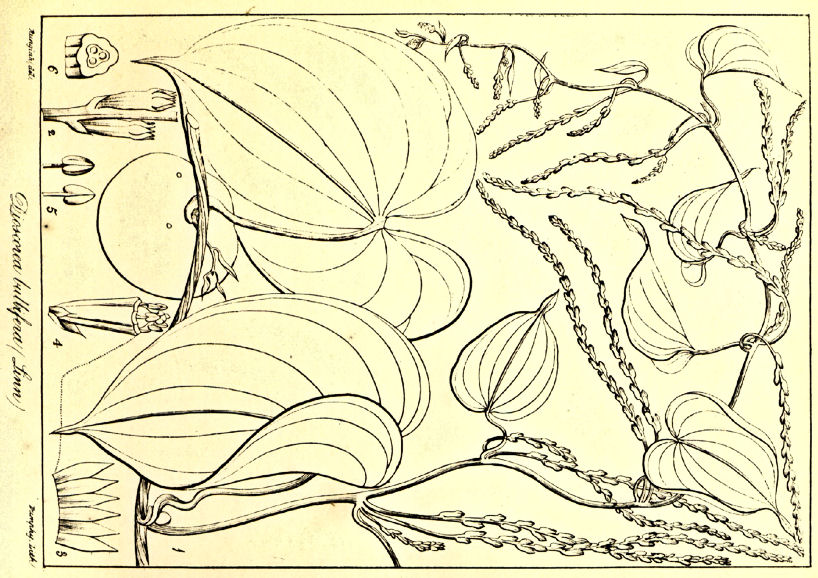
Abb.: Dioscorea bulbifera L. 1753 - Yamswurzel - Air Potato
[Bildquelle: Wight Icones III, Tab. 878, 1846]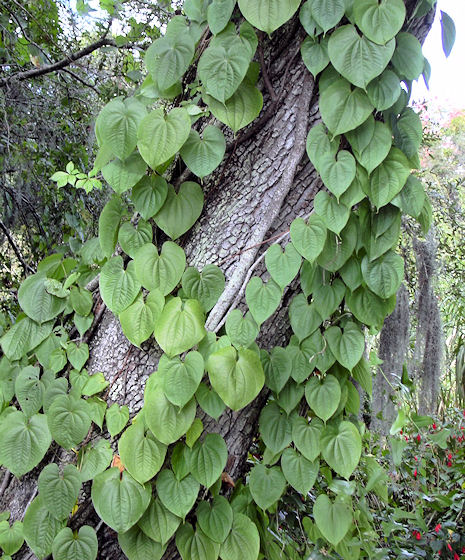
Abb.: Dioscorea bulbifera L. 1753 - Yamswurzel - Air Potato, Florida, USA
[Bildquelle: Forest Starr & Kim Starr. --
http://www.hear.org/starr/images/image/?q=031108-0224&o=plants. -- Zugriff
am 2010-10-22. --
Creative Commons Lizenz (Namensnennung)]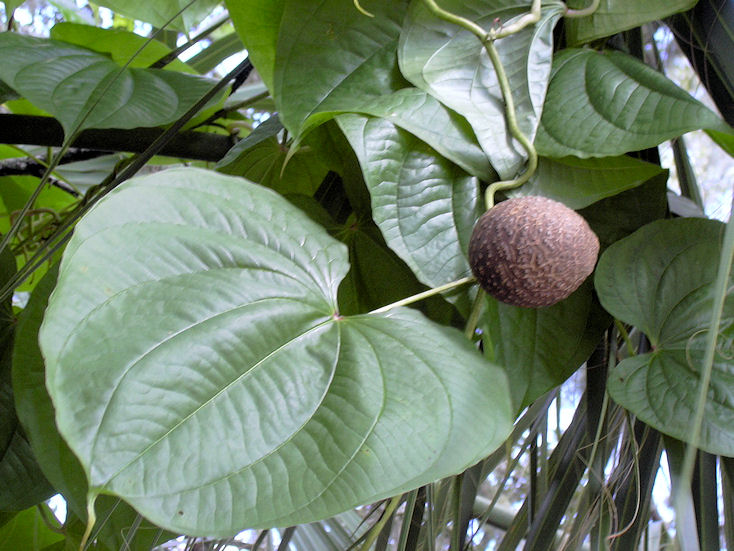
Abb.: Dioscorea bulbifera L. 1753 - Yamswurzel - Air Potato, Florida, USA
[Bildquelle: Forest Starr & Kim Starr. --
http://www.hear.org/starr/images/image/?q=031108-0225&o=plants. -- Zugriff
am 2010-10-22. --
Creative Commons Lizenz (Namensnennung)]
"Dioscorea bulbifera (Linn.) N. O. Dioscoreaceae.
2.8.34. Eclipta alba (L.) Hassk. - False Daisy
17. a./b. mārkavo bhṛṅgarājaḥ syāt
kākamācī tu vāyasī
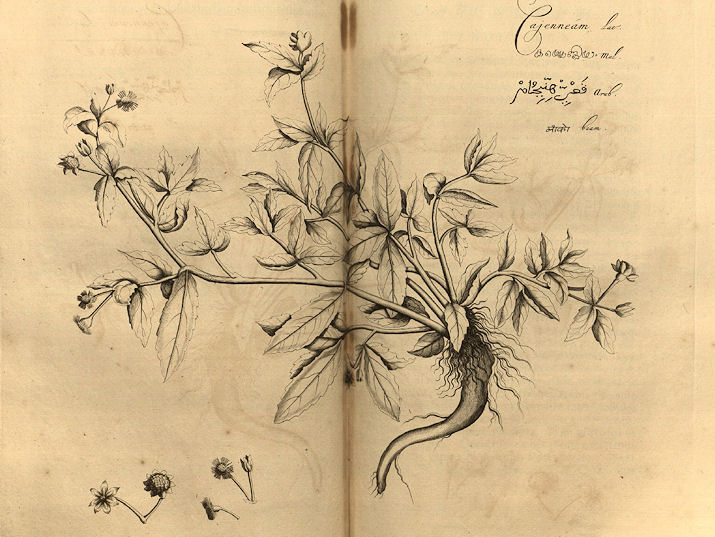
Abb.: मार्कवः
।
Eclipta alba (L.) Hassk. - False Daisy
[Bildquelle: Hortus malabaricus X. Fig. 41, 1690]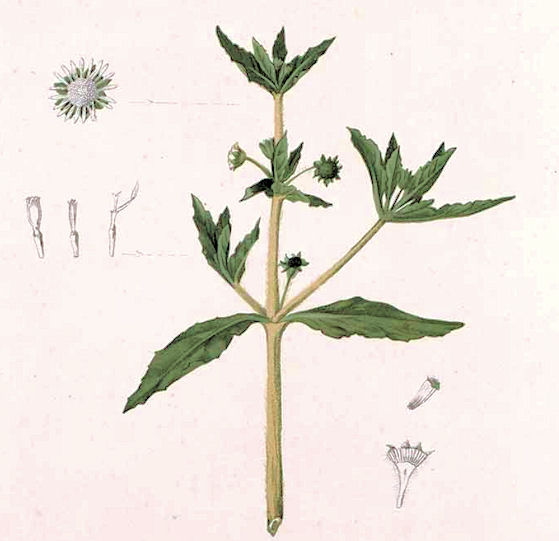
Abb.: मार्कवः
।
Eclipta alba (L.) Hassk. - False Daisy
[Bildquelle: Flora de Filipinas, 1880 / Wikipedia. -- Public domain]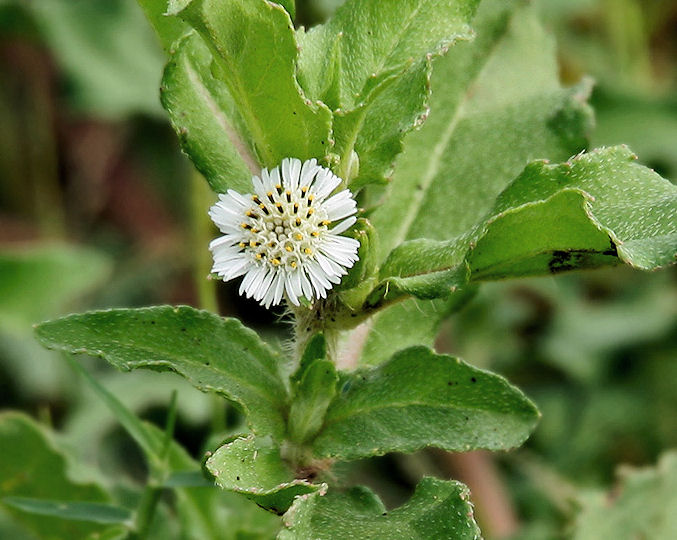
Abb.: भृङ्गराजः
।
Eclipta alba (L.) Hassk. - False Daisy, Pocharam Lake, Andhra
Pradesh
[Bildquelle: J. M. Garg / Wikimedia. -- GNU FDLicense]
"Eclipta erecta (Linn.) N. O. Asteraceae.
"ECLIPTA ALBA, Hassk.
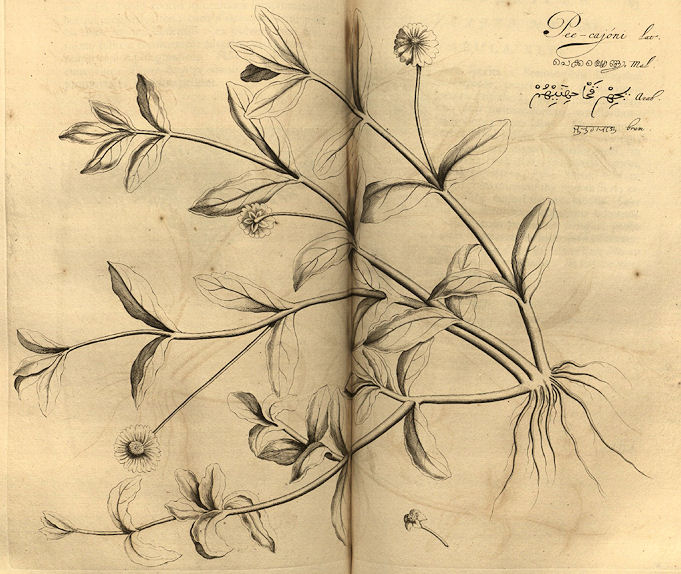
Abb.: मार्कवः
।
Wedelia calendulacea Less.
[Bildquelle: Hortus malabaricus X. Fig. 42, 1690]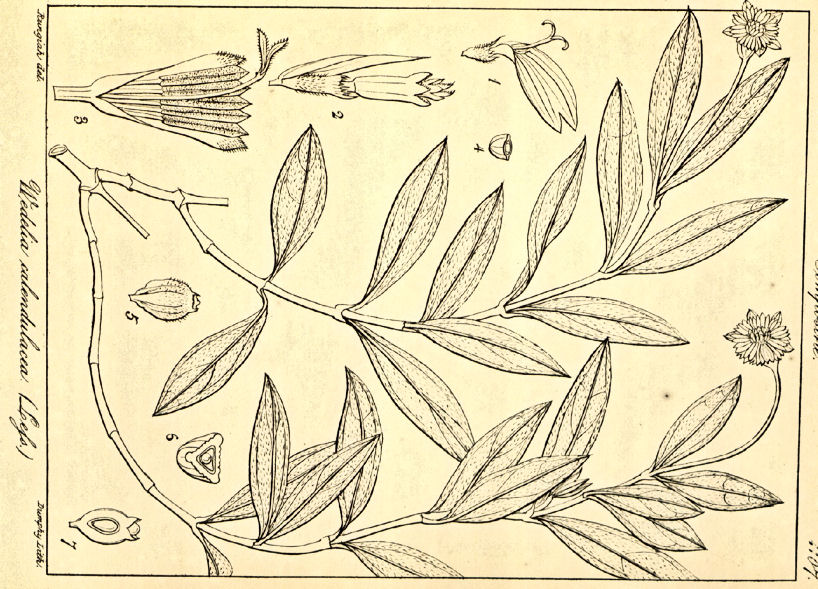
Abb.: मार्कवः
।
Wedelia calendulacea Less.
[Bildquelle: Wight Icones III, Tab. 1107, 1846]
2.8.35. Solanum nigrum L. - Gewöhnlicher Schwarzer Nachtschatten -
Black Nightshade
Solanaceae (Nachtschattengewächse)
17. a./b.
mārkavo bhṛṅgarājaḥ syāt
kākamācī tu vāyasī
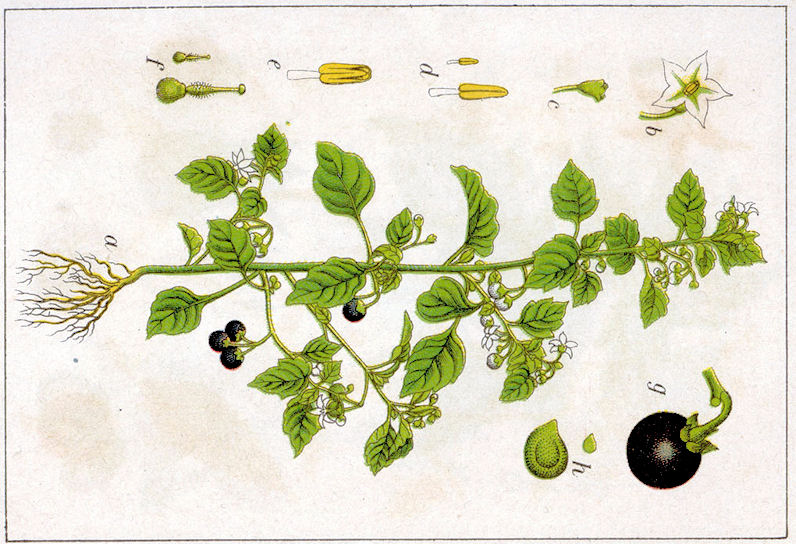
Abb.: Solanum nigrum L. - Gewöhnlicher Schwarzer Nachtschatten - Black
Nightshade
[Bildquelle: Jacob Sturm 1796 / Wikimedia. -- Public domain]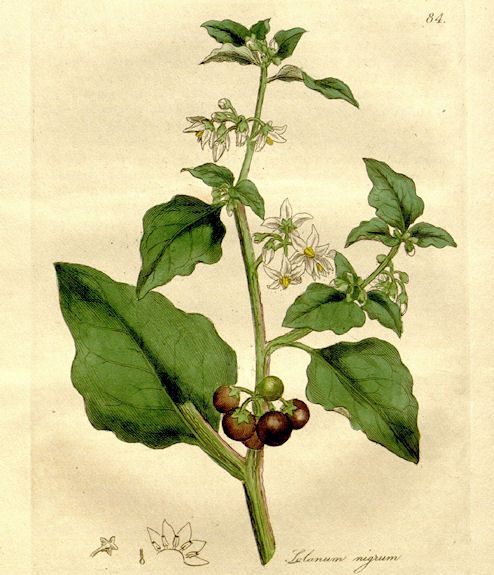
Abb.: Solanum nigrum L. - Gewöhnlicher Schwarzer Nachtschatten - Black
Nightshade
[Bildquelle: Medical botany : containing
systematic and general descriptions, with plates of all the medicinal plants,
comprehended in the catalogues of the materia medica, as published by the Royal
Colleges of Physicians of London, Edinburgh, and Dublin, together with the
principal medicinal plants not included in those pharmocopoeias, accompanied
with a circumstantial detail of their medicinal effects, and of the diseases in
which they have been most successfully employed / by William Woodville. --
London, 1842. -- Vol 2, Tab. 84.] 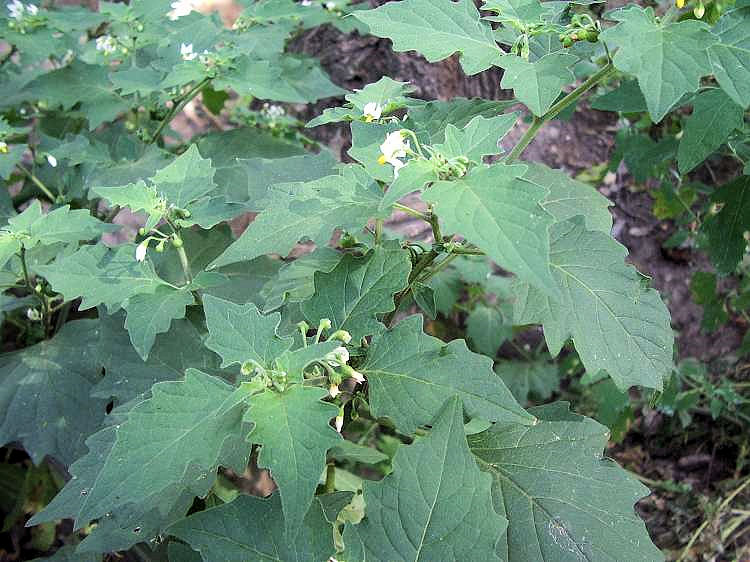
Abb.: Solanum nigrum L. - Gewöhnlicher Schwarzer Nachtschatten - Black
Nightshade
[Bildquelle: Funkdoctor / Wikipedia. -- GNU FDLicense]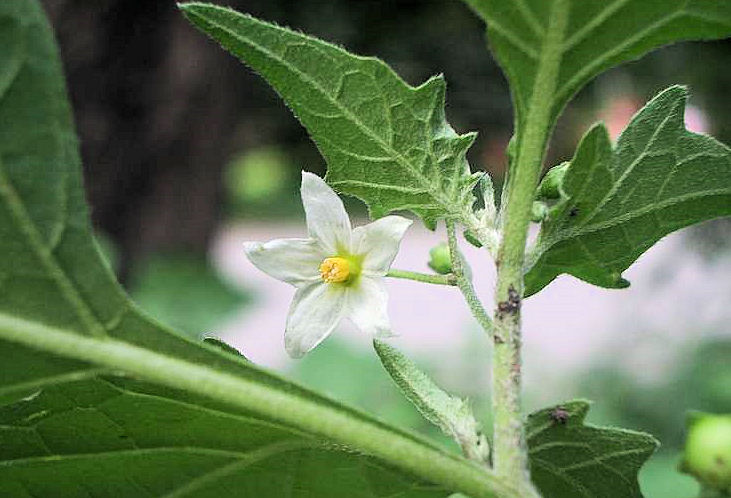
Abb.: Solanum nigrum L. - Gewöhnlicher Schwarzer Nachtschatten - Black
Nightshade
[Bildquelle: Harald Hubich / Wikimedia. -- GNU FDLicense]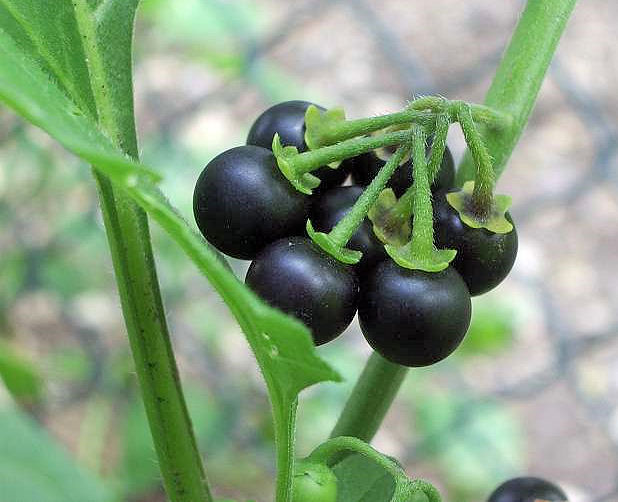
Abb.: Solanum nigrum L. - Gewöhnlicher Schwarzer Nachtschatten - Black
Nightshade
[Bildquelle: Harald Hubich / Wikimedia. -- GNU FDLicense]
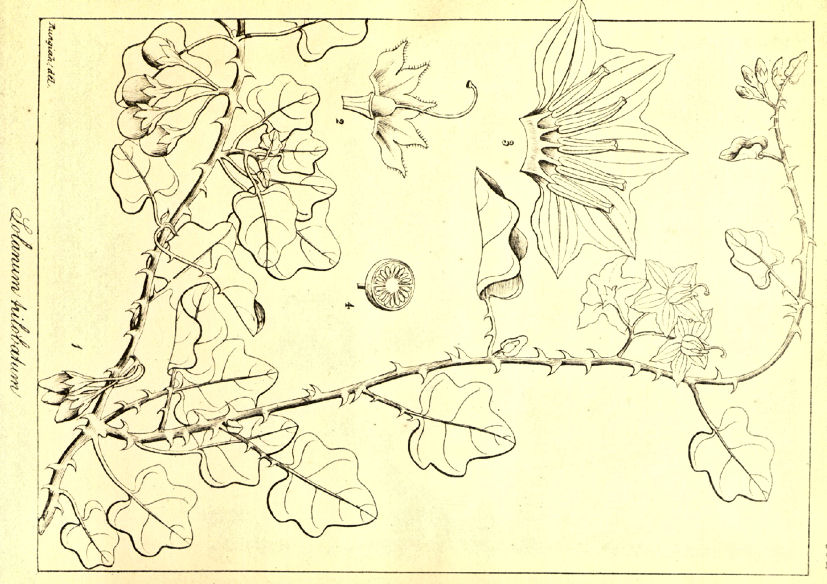
Abb.: Solanum trilobatum L.
[Bildquelle: Wight Icones III, Tab. 854, 1846]
"Solanum trilobatum (Linn.)
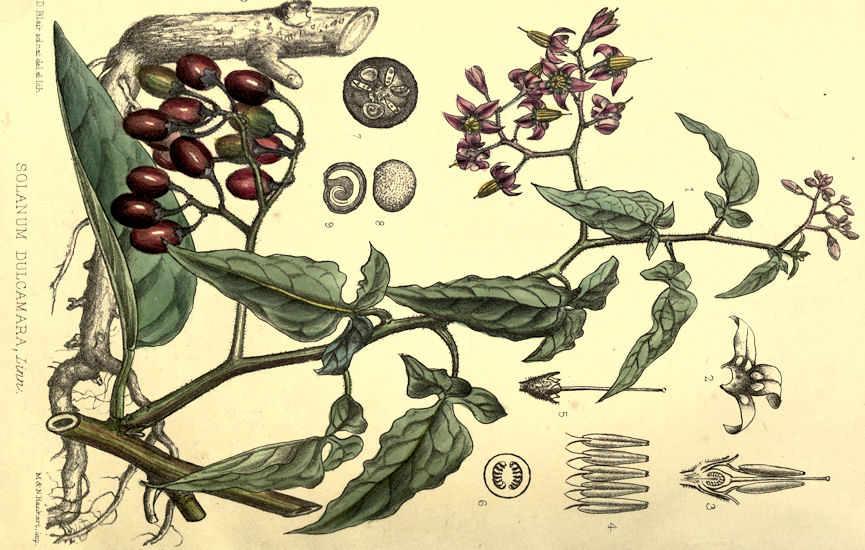
Abb.: Solanum dulcamara L. 1753 - Bittersüßer Nachtschatten - Deadly
Nightshade
[Bildquelle: Medicinal plants. Being
descriptions with original figures of the principal plants employed in medicine
and an account of the characters, properties, and uses of their parts and
products of medicinal value. / by Robert Bentley and Henry Trimen. Plates by
David Blair. In four volumes., 1880. -- vol. 2, pl. 190]
"Der Bittersüße Nachtschatten (Solanum
dulcamara) , oder einfach Bittersüß oder Hundbeere,
Mäuseholz, Mausholz, Natter(n)holz,
Pissranken, Rote Hundsbeere, Saurebe,
Stinkteufel, Süßstoff, Teufelsklatten,
Waldnachtschatten, Wasserranke, Wolfsbeere
genannt, ist ein Halbstrauch aus der Familie der
Nachtschattengewächse (Solanaceae). Er ist giftig, da er das
Saponin Solanin enthält.
2.8.36. Anethum graveolens L. 1753 - Ackerdill - Dill
& Foeniculum vulgare Mill.
1768 - Fenchel - Fennel
17. c./d. śatapuṣpā sitacchatrāticchatrā madhurā misiḥ
18. a./b. avākpuṣpī kāravī ca
saraṇā tu prasāriṇī
अवाक्पुष्पी कारवी च सरणा तु प्रसारिणी
।१८ क।
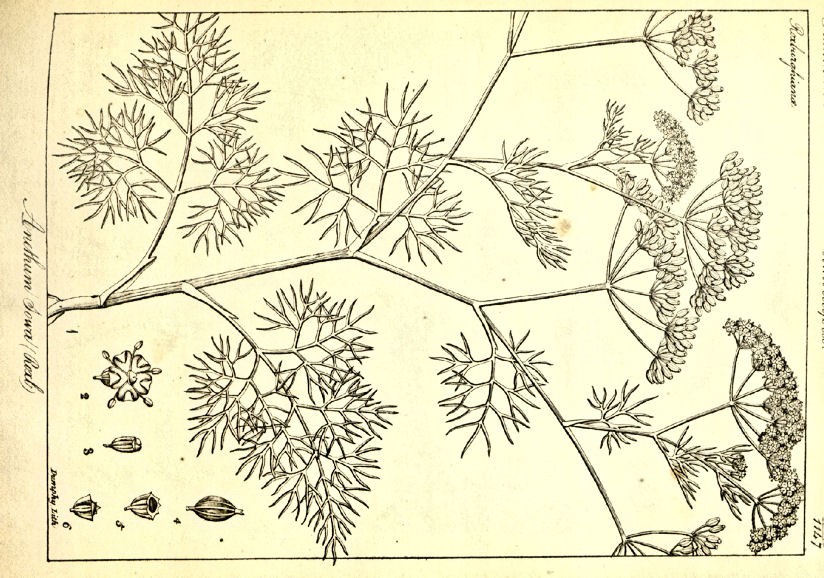
Abb.: Anethum graveolens L. 1753 - Dill
[Bildquelle: Wight Icones II, Tab. 572, 1843]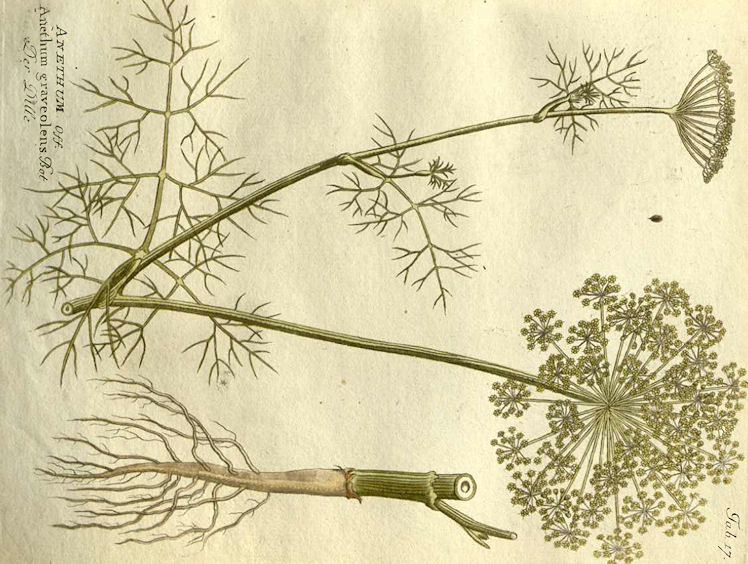
Abb.: अतिच्छत्रा
।
Anethum graveolens L. 1753 - Dill
[Bildquelle: Icones plantarum medico-oeconomico-technologicarum
cum earum fructus ususque descriptione =Abbildungen aller
medizinisch-ökonomisch-technologischen Gewächse mit der Beschreibung ihres
Gebrauches und Nutzens. -- Wien, 1800 - 1822. -- Bd. 1, Tab. 17]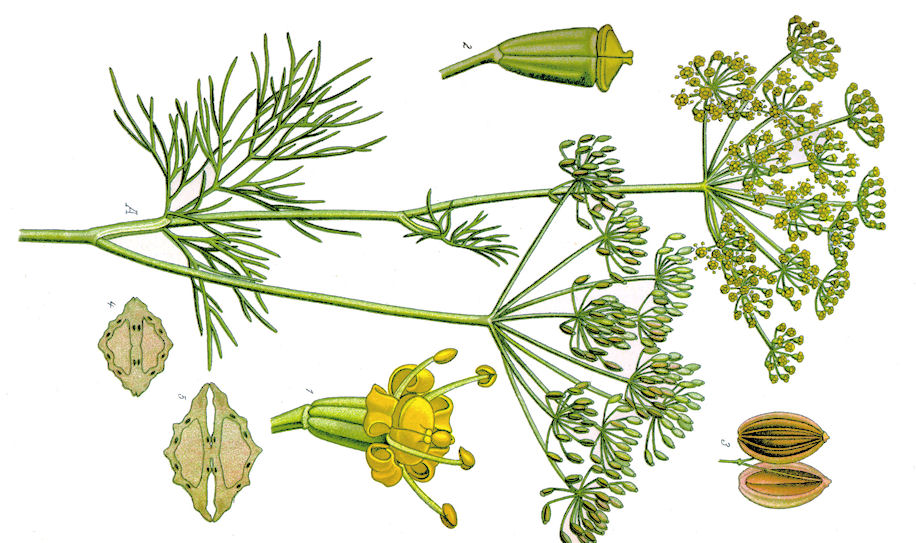
Abb.: शतपुष्पा
।
Anethum graveolens L. 1753 - Ackerdill - Dill
[Bildquelle: Thomé 1885 / Wikimedia. -- Public domain]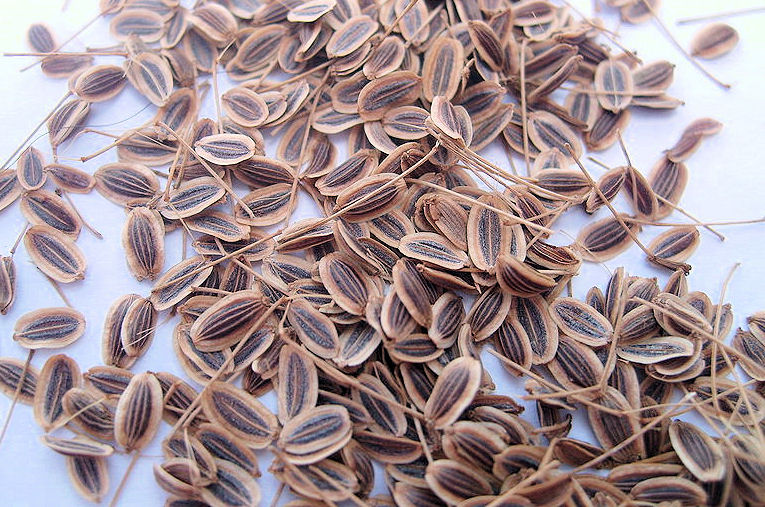
Abb.: Anethum graveolens L. 1753 - Ackerdill - Dill
[Bildquelle: Reaperman / Wikimedia. -- GNU FDLicense]
"Anethum Sowa (Roxb.) N. O. Apiaceae.
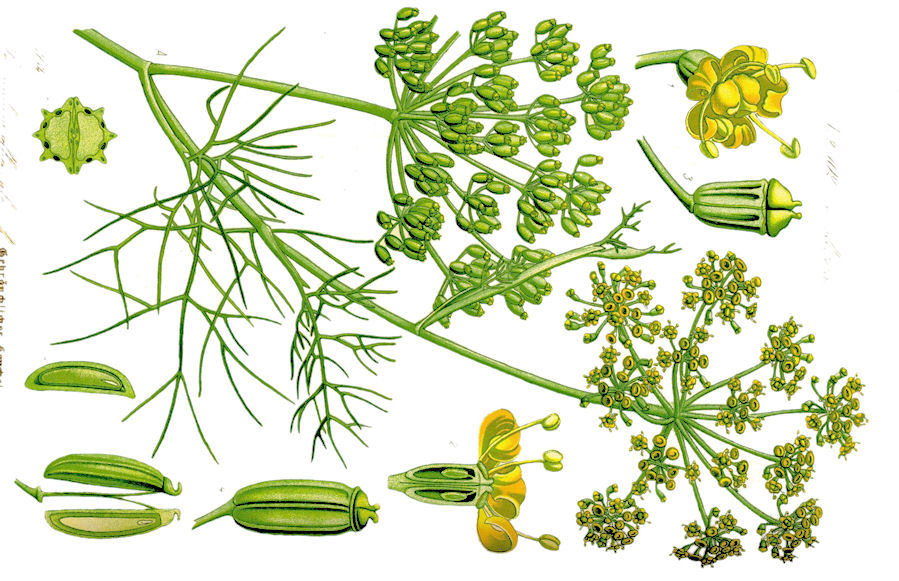
Abb.: शतपुष्पा
।
Foeniculum vulgare Mill. 1768 - Fenchel - Fennel
[Bildquelle: Thomé 1885 / Wikimedia. -- Public domain]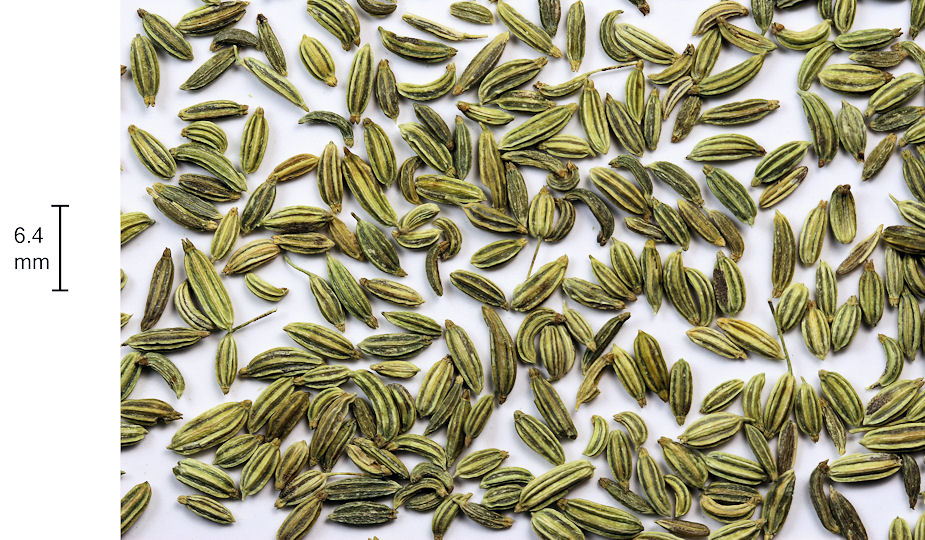
Abb.: Foeniculum vulgare Mill. 1768 - Fenchel - Fennel
[Bildquelle: Sanjay Acharya / Wikimedia. -- GNU FDLicense]
"FOENICULUM VULGARE, Gaertn.
Hac morsa, serpens oculos caligine purgat,
Indeque compertum est bumanis posse mederi
Illam luminibus, atque ezperiendo probatum—
Urinas purgat et menstrua sumpta resolvit,
Vel si trita super pecten haec herba ligetur—
Tradunt auctores ejus juvenescere gustu.
Serpentes, et ob hoc senibus prodesse putatur.
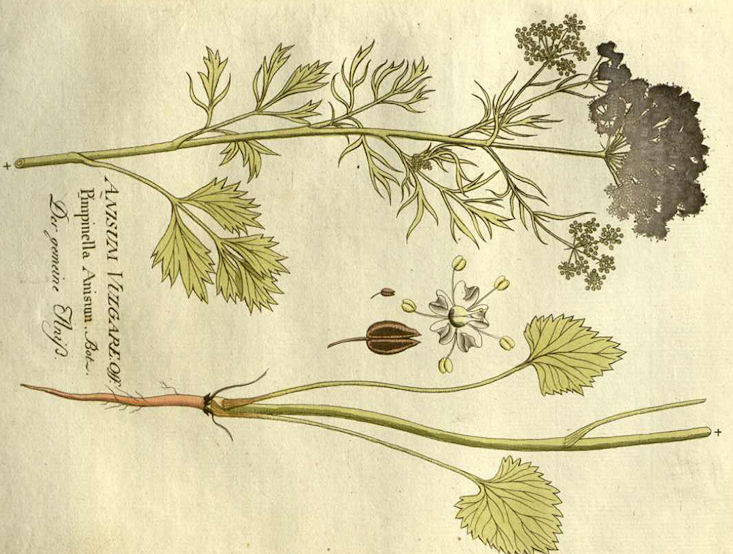
Abb.: Pimpinella anisum L. 1753 - Anis - Anise
[Bildquelle: Icones plantarum medico-oeconomico-technologicarum
cum earum fructus ususque descriptione =Abbildungen aller
medizinisch-ökonomisch-technologischen Gewächse mit der Beschreibung ihres
Gebrauches und Nutzens. -- Wien, 1800 - 1822. -- Bd. 1, Tab. 20]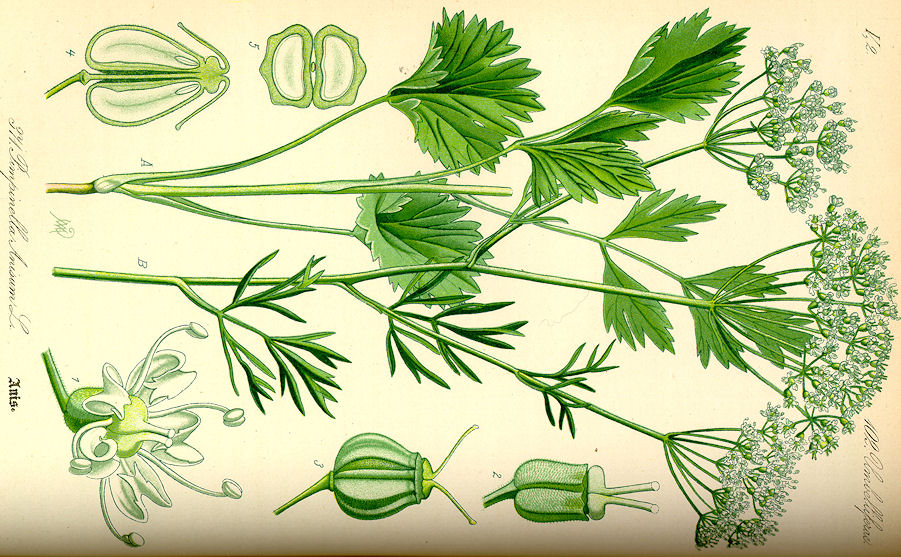
Abb.: सितच्छत्रा ।
Pimpinella anisum L. 1753 - Anis - Anise
[Bildquelle: Köhler, 1883-1914]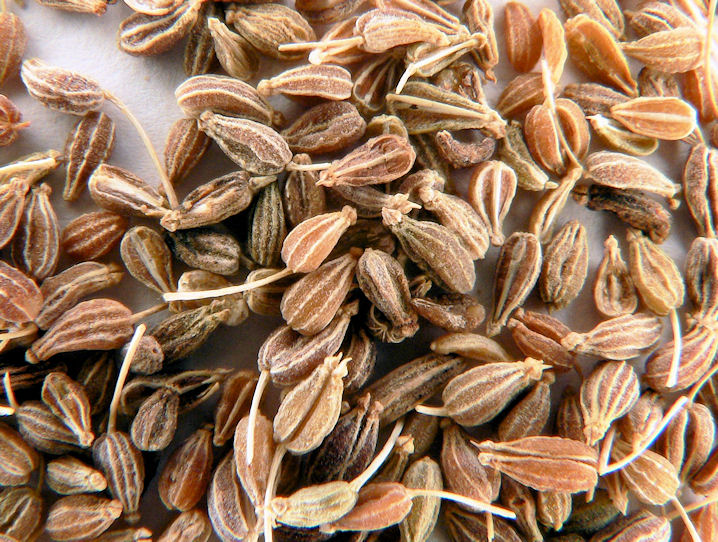
Abb.: Pimpinella anisum L. 1753 - Anis - Anise
[Bildquelle: David Monniaux / Wikimedia. -- GNU FDLicense]
2.8.37. Paederia foetida (Lour.) Merr. 1767 - Skunkvine
18.
avākpuṣpī kāravī ca
saraṇā tu prasāriṇī
tasyāṃ kaṭaṃbharā rājabalā bhadrabalety api
तस्यां कटंभरा राजबला भद्रबलेत्य् अपि ॥१८॥
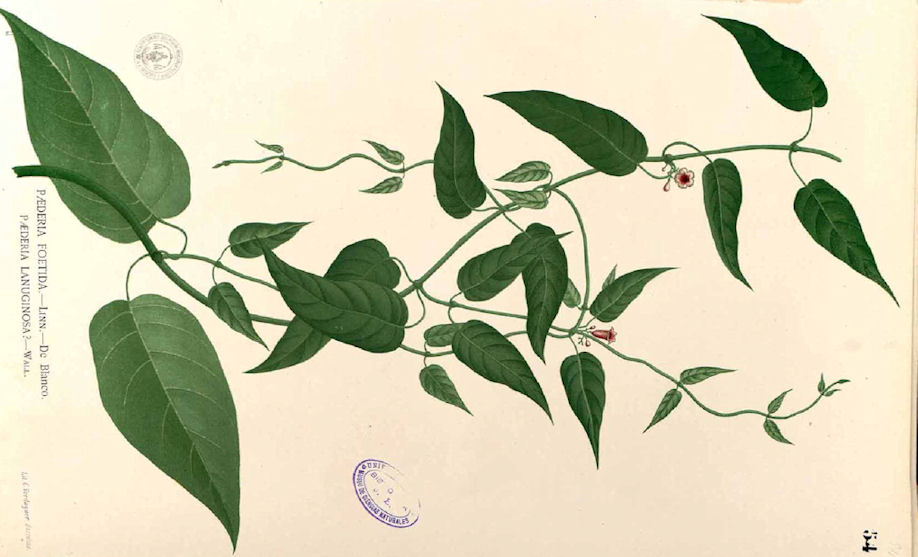
Abb.: प्रसारिणी ।
Paederia foetida (Lour.) Merr. 1767 - Skunkvine
[Bildquelle: Flora de Filipinas, 1880 / Wikipedia. -- Public domain]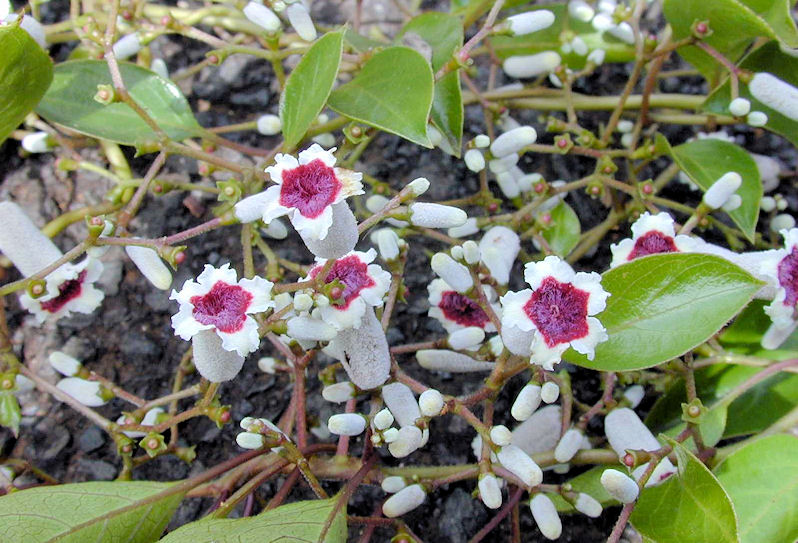
Abb.:
कटंभरा ।
Paederia foetida (Lour.) Merr. 1767 - Skunkvine, Hawaii
[Bildquelle: Forest Starr & Kim Starr. --
http://www.hear.org/starr/images/image/?q=001101-0045&o=plants. -- Zugriff
am 2010-10-22. --
Creative Commons Lizenz (Namensnennung)]
"Paederia foetida (Linn.) N. O.
Cinchonaceae.
"PAEDERIA FOETIDA, Linn.
Zu vanauṣadhivargaḥ V. Vers 19 - 35